











Dear Readers,
This issue of our magazine centres around the most significant event in the rail industry – InnoTrans, which will need no introduction!
As the world's largest trade fair for rail transport technology, InnoTrans provides a unique platform to witness groundbreaking innovations, forge critical partnerships and set the agenda for the future of rail transport.
We’ve included an event map to help you find your way. We also highlight several key suppliers whose contributions to the rail sector are particularly noteworthy this year.
For instance, KfW IPEX-Bank is leading the charge towards sustainable mobility. In our interview with Sebastian Blum, KfW’s Global Head of Mobility, he discusses the bank’s strategic focus on reducing carbon emissions across various transportation sectors. Blum provides insights into the challenges and opportunities of financing green projects in an industry that is still grappling with underinvestment and regulatory complexities.
TÜV SÜD, a global leader in testing and certification, brings to light the critical importance of safety and compliance in railway operations. Their latest efforts are focused on ensuring that rail operators meet stringent international standards, which are increasingly vital as the industry adopts new technologies and digital solutions.
Meanwhile, Frequentis is pushing the boundaries of operational efficiency and emergency response with its MissionX platform. This cutting-edge solution integrates legacy communication systems with advanced technologies like drones, enabling real-time data exchange and rapid response in critical situations. Their collaboration with Austrian Federal Railways (ÖBB) on drone-based infrastructure inspections is a prime example of how technology can enhance both safety and efficiency in railway operations.
These are just a few of the many stories featured in this issue.
If you would like to receive our news directly in your inbox, make sure you're subscribed here. For those interested in contributing or being featured in our next issue, email Andrew Lush or call +44 7432 725001.
We hope you enjoy this issue and find it both informative and inspiring.

Josephine Cordero Sapién, editor-in-chief
ANDREW LUSH Director al@a2bglobalmedia.com
JOSEPHINE CORDERO SAPIÉN Editor-in-chief jcs@a2bglobalmedia.com
NICOLA BROWN Head of Sales nb@a2bglobalmedia.com
ZOE GRIFFEY Head of Design zg@a2bglobalmedia.com
TIANA MAY Principal Journalist tm@a2bglobalmedia.com
a2b Global Media Ltd
The Generator Hub, The Gallery Kings Wharf The Quay, Exeter EX2 4AN
Office: +44 (0)1392 580002
Mobile: +44 (0)7432 725001
Email: info@railway-news.com Website: railway-news.com
To
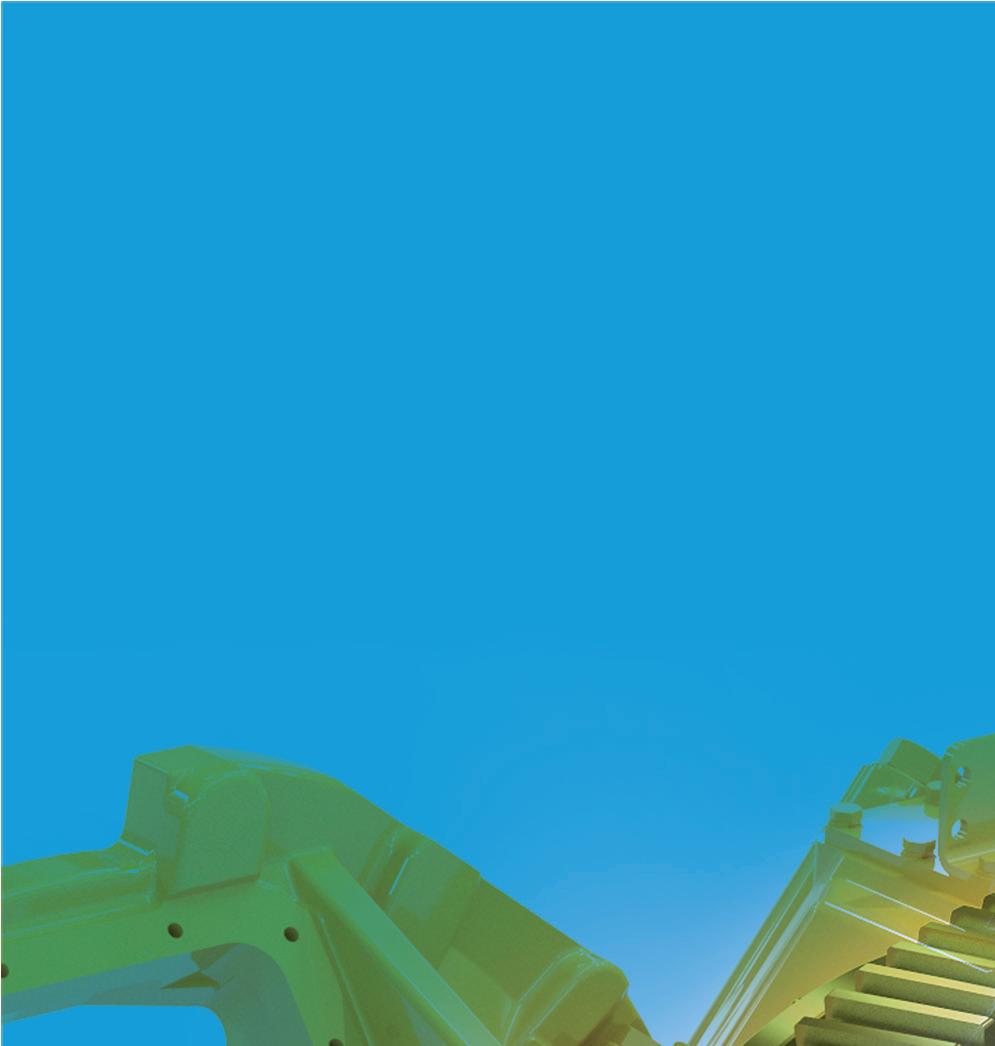
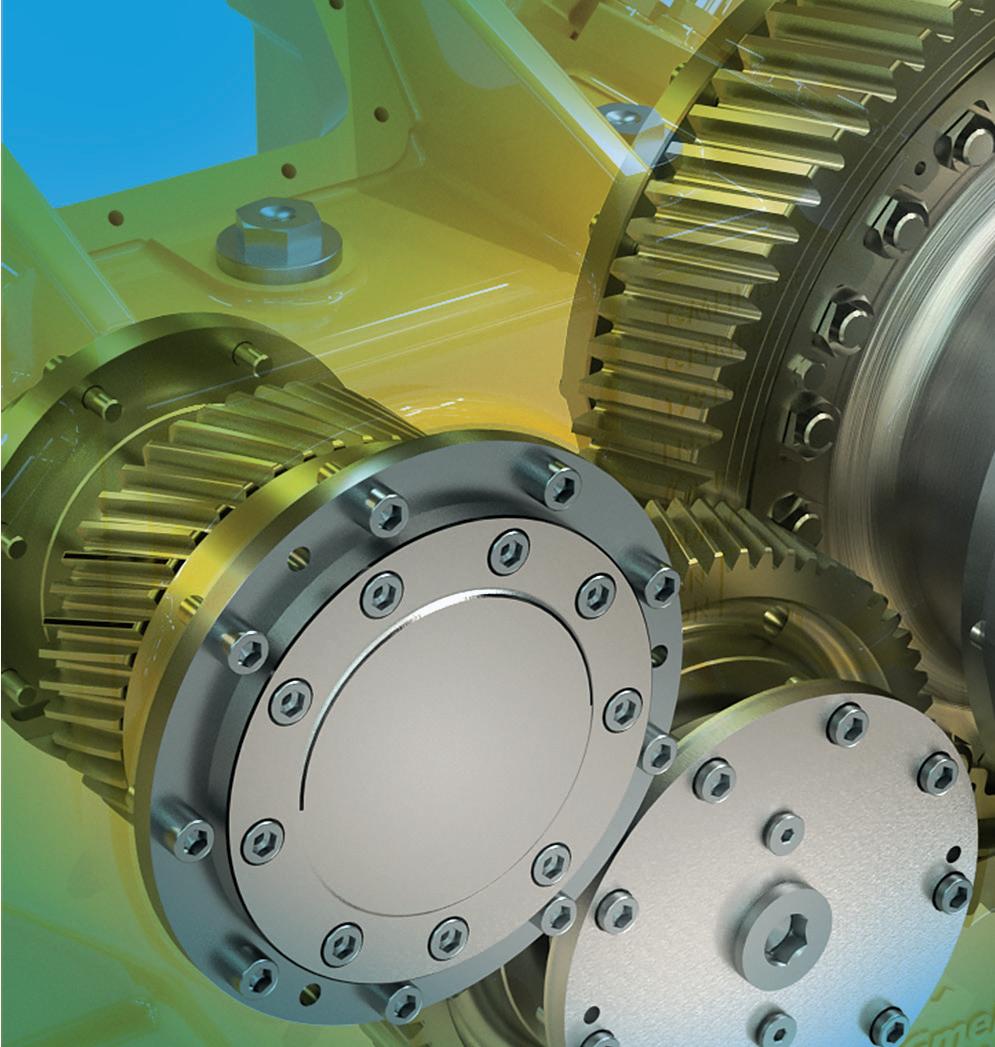





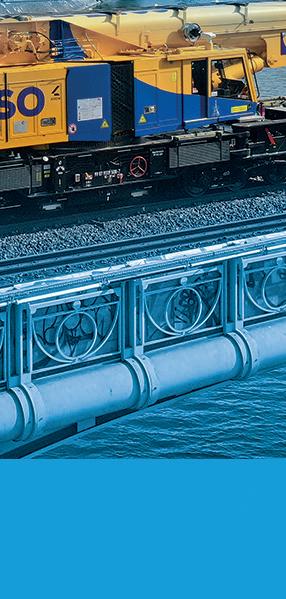


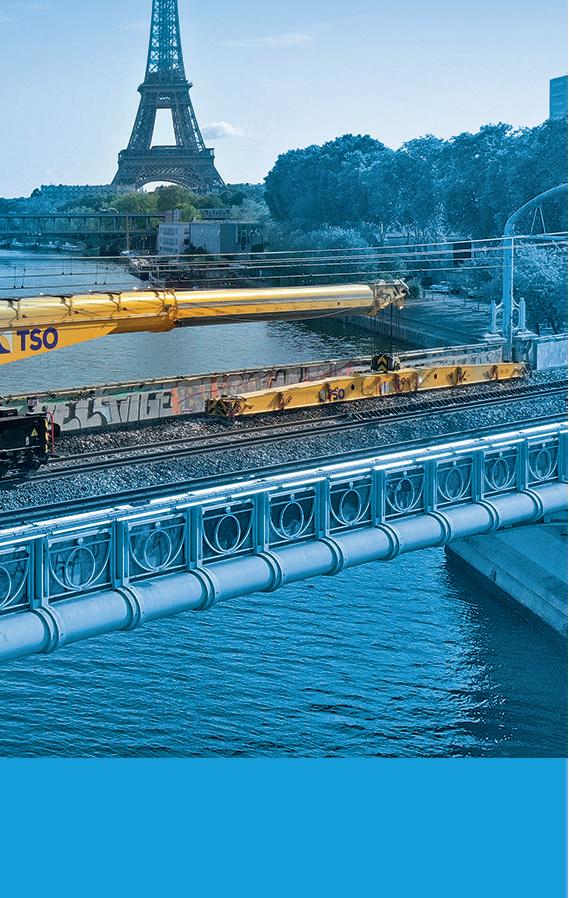
VISIT US! 24.– 27. September 2024 Stand No. 250, Hall 20

p.6
What’s in store for InnoTrans this year? Find out about the new AI Mobility Lab, what trains you’ll be able to see at the Outdoor Display and more.

p.8
A look at what key railway events are taking place between September and December 2024.
p.10
Directory
A directory of railway suppliers for rolling stock, services, data & monitoring and track & infrastructure. Read about all the latest innovations and product developments in the rail sector.
Rolling Stock– p.12
Services – p.95
Data & Monitoring – p.108
Track & Infrastructure – p.175
p.201
Our top picks for suppliers attending InnoTrans, arranged by hall, together with a handy event map so you can find everyone with ease.
When: 24-27 September 2024
Organiser: Messe Berlin
InnoTrans, known as the world’s leading international trade fair for transport technology, is again set to take place in Berlin this September. Held every two years, this major event showcases the latest advancements in the rail industry and brings together companies and professionals from around the globe.
Exhibition
InnoTrans will be divided into five key segments: Railway Technology, Railway Infrastructure, Public Transport, Interiors, and Tunnel Construction. The event will occupy all 42 halls at the Messe Berlin Exhibition Grounds.
Across these segments, the exhibition will feature approximately 220 ‘world innovations.’ These
showcased products will include AI-based timetable algorithms, MCX-enabled vehicle-to-ground communications, and solutions for barrier-free train access and graffiti-resistant windows, to name but a few.
In addition, a standout feature of InnoTrans is its extensive outdoor and track display area, where a wide range of vehicles—from tank wagons to high-speed trains—will be presented on 3,500 metres of track.
Several major rolling stock manufacturers have already announced details of their participation in the event. For example, among many highlights, Siemens Mobility will display its Velaro high-speed train, designed for Egypt’s new 2,000-kilometre high-speed rail network. Meanwhile, Stadler will premiere its RS

ZERO zero-emission regional train and Alstom will present its Coradia Max regional train. In total, over 110 passenger and goods vehicles will be showcased.
Vehicle manufacturers will also have the opportunity to present buses in a dedicated Bus Display area, complete with a Demonstration Course for live demonstrations.
Complementing the trade fair, the InnoTrans Convention aims to offer a high-level programme that will also be streamed live. This programme will provide attendees with valuable insights into the latest trends and challenges in transport technology.
Specifically, this year's edition will include a focus on electrification, digitalisation and automation to deliver a future with efficient and sustainable mobility.
With this in mind, the event’s Opening Ceremony will incorporate a panel discussion entitled, ‘From Hype to Reality – AI in the Mobility Sector’. To further emphasise this focus, the trade fair will also include a new AI Mobility Lab exhibition area, where over 30 exhibitors will present the latest AI technologies.
InnoTrans continues to set records as a major trade fair for the industry. In 2022, the event attracted 2,771 exhibitors from 56 countries, filling the Berlin Exhibition Grounds. What’s more, it welcomed 137,403 visitors from 137 countries, highlighting the global significance of the event.
In 2024, these figures are expected to rise further, with the event set to host over 2,900 exhibitors from 59 countries.
InnoTrans 2024 will be the fourteenth edition of the event. With the event drawing nearer, the next edition of InnoTrans has also been announced to take place from Tuesday 22 to Friday 25 September 2026.
To find out more visit www.innotrans.de/en.

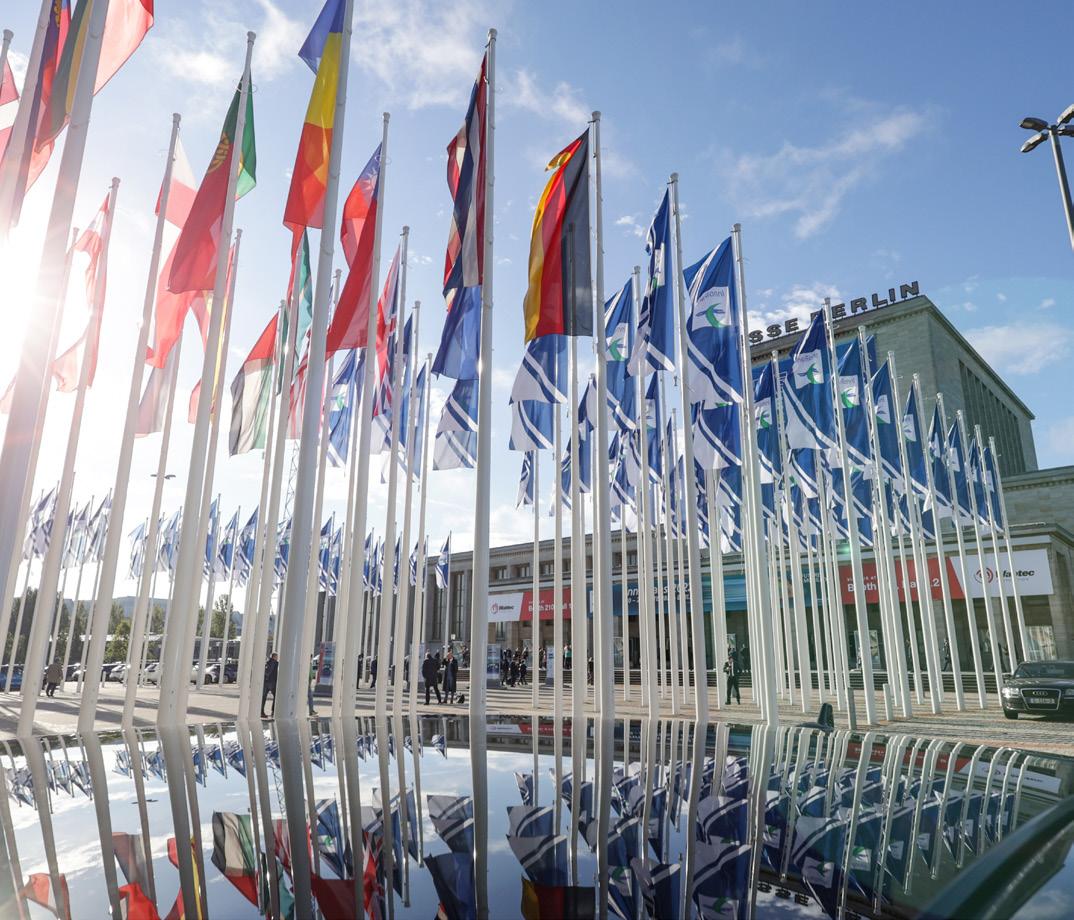


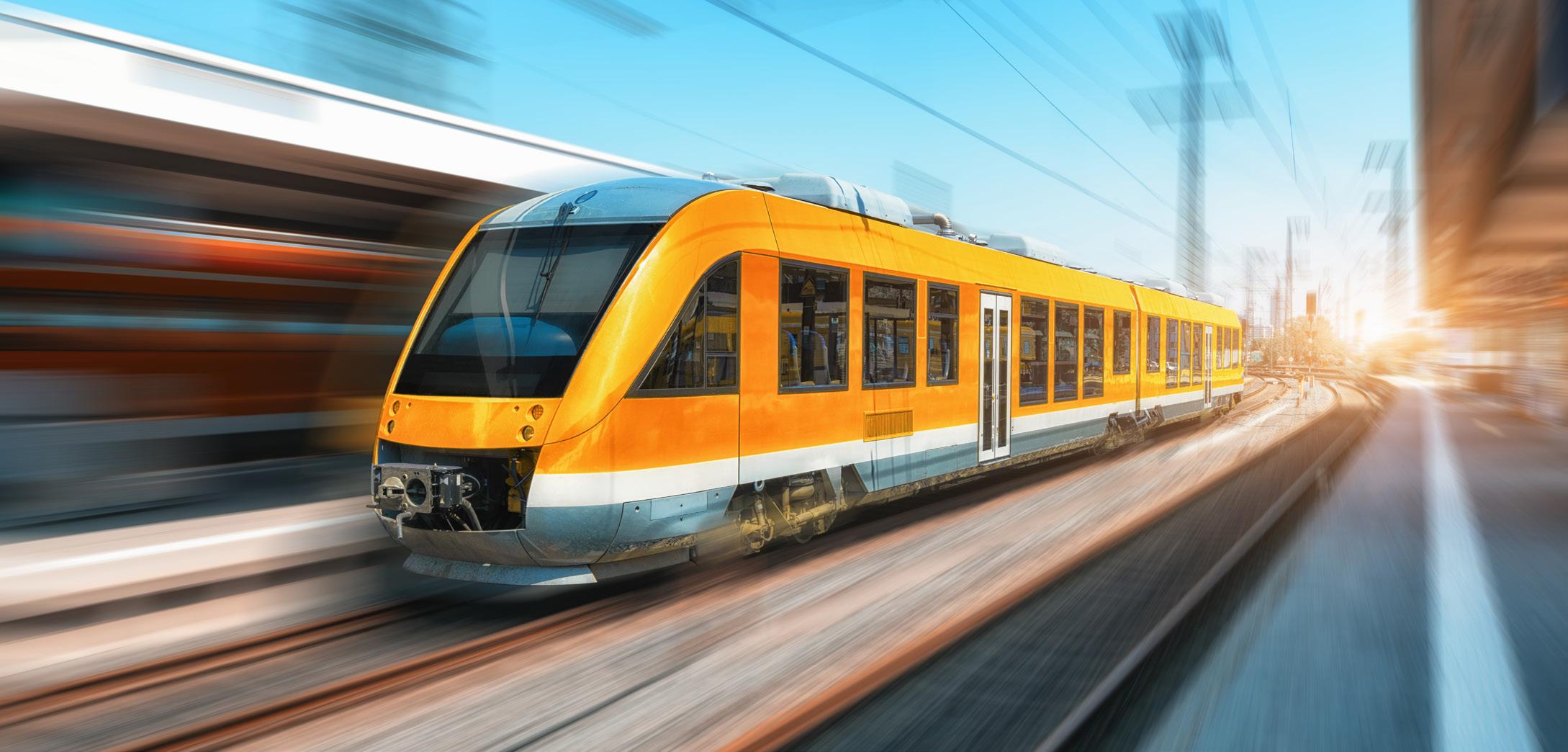



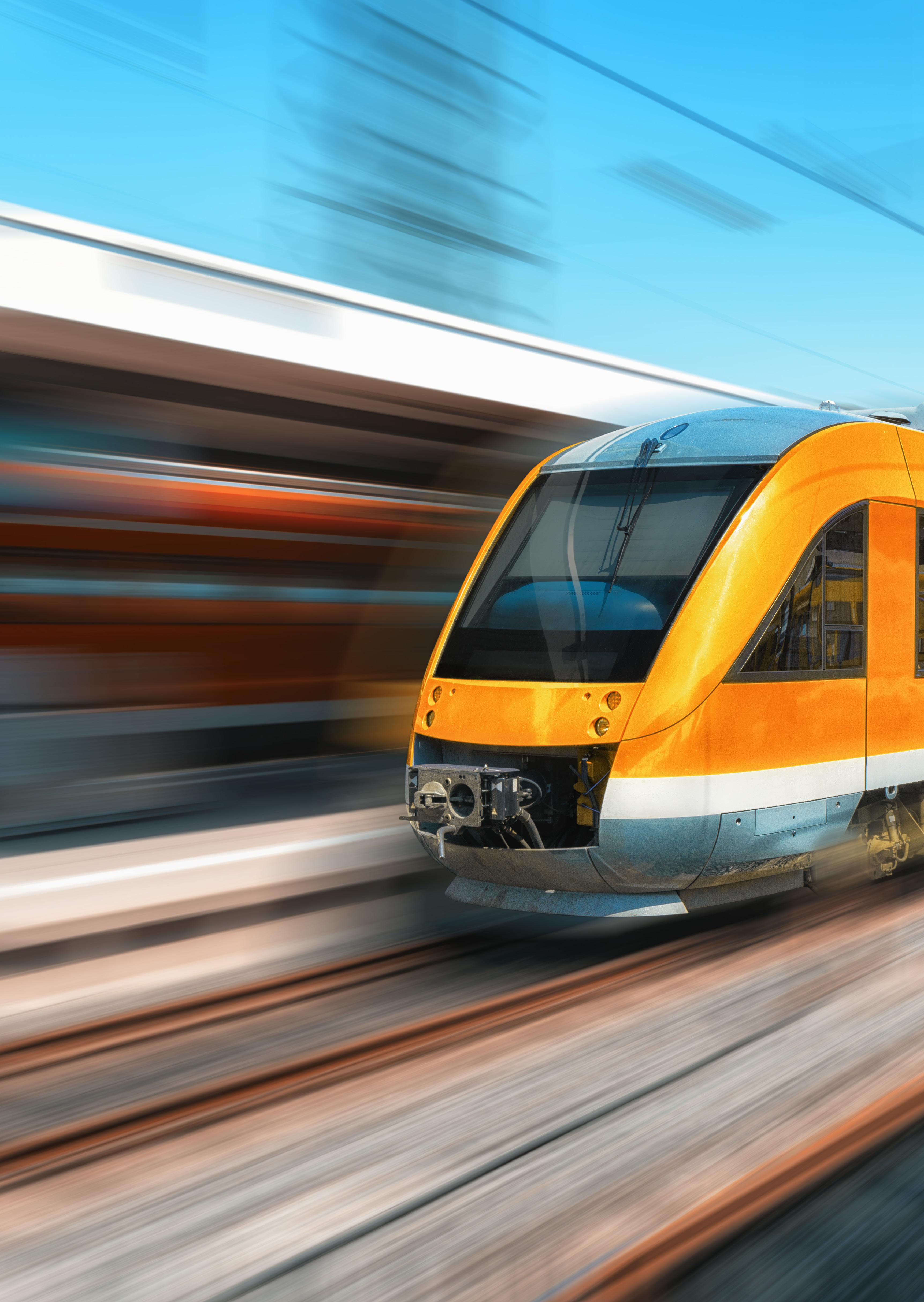
TÜV SÜD p.14
TÜV NORD p.16
Roxtec International AB p.19
Diab Group p.25
EAO Group p.28
TSL-ESCHA GmbH p.31
ZF Friedrichshafen AG p.34
Dellner Glass Solutions Ltd p.37
J. LANFRANCO & Cie p.40
Wikov p.41
BITZER Kühlmaschinenbau GmbH p.42
Premium Power Supplies p.45
Stäubli Electrical Connectors p.48
Capitol Industrial Batteries p.49

SKF p.50
FLENDER p.53
SŽ – VIT p.56
MAE. Maschinen-und Apparatebau Götzen GmbH p.59
Polarteknik Oy p.62
LA-CO Industries Europe p.64
Mechan p.65
Virtek Vision p.68
HEXAGON p.71
Roediger Vacuum p.74
Kiel Americas p.77
SEKISUI KYDEX, LLC p.79
Manifattura A. Testori Di G. Spa p.82
Rex-Royal AG p.84
SAFE-T-PUNCH p.87
OWI GmbH p.90
U-Lift p.91

Q: Dr Webhofer, thank you for joining us today. Could you start by giving us an overview of TÜV SÜD’s participation at InnoTrans 2024? What makes this event significant for TÜV SÜD?
Martin Webhofer: Thank you for having me. InnoTrans 2024 is a premier event for the railway industry and TÜV SÜD is proud to participate as a key player in this sector. This event provides an excellent platform for us to showcase our commitment for safety and security in railways.
Q: TÜV SÜD positions itself as the industry's partner for safety in an increasingly digitalised railway transport. Can you elaborate on how TÜV SÜD ensures safety amidst this digital transformation?
MW: Of course. At TÜV SÜD, we leverage our solid knowledge and experience to support suppliers and operators in delivering safe and secure railway transport solutions amid digital transformation and to support manufacturers entering new markets. TÜV SÜD has a robust foundation that is characterised by in-depth and broad knowledge as well as many years of experience. Precisely this stability and continuity provide an excellent basis to support our clients in integrating innovations without compromising safety. As an example, our anti-slide simulator exemplifies our commitment by demonstrating wheel slide protection testing and showcasing how advanced testing methods can make homologation more efficient. Another example is digital automatic coupling (DAC), which automates rail coupling to enhance speed, capacity and process flow at terminals and railway yards, supporting the use of heavier, longer and faster freight trains.
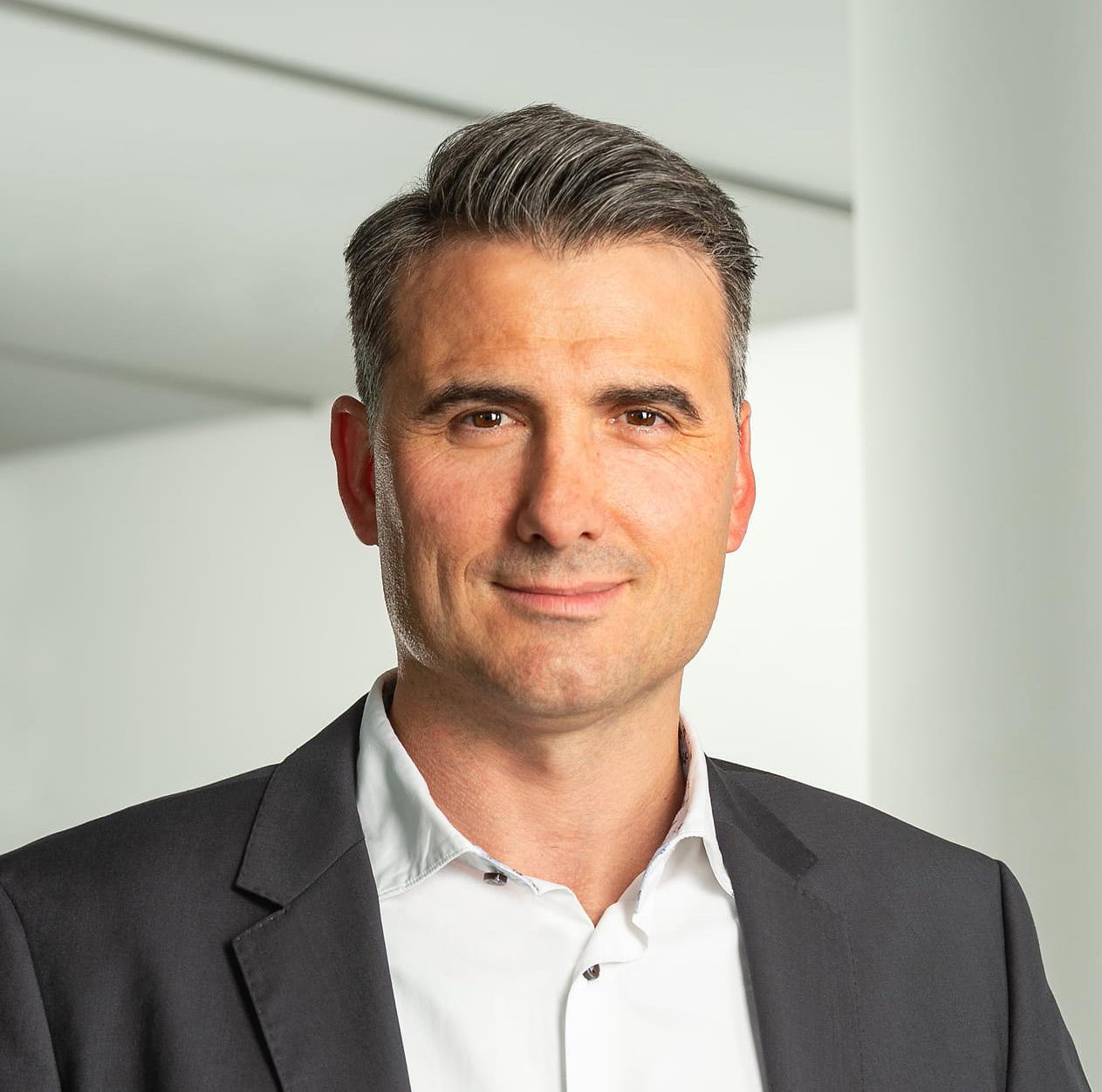
Dr Martin Webhofer CEO of TÜV SÜD Rail GmbH
Moreover, our rail cyber security services include comprehensive assessment, testing and certification, supporting in this way risk minimisation, effective risk communication and a better protection against cyber attacks.
Q: One of the core topics at the exhibition is sustainability. How does TÜV SÜD support sustainability in rail transport?
MW: TÜV SÜD Rail actively contributes to the sustainable transport transition with its services in the railway sector. We are one of the first TIC companies certifying hydrogen trains and batteries. And with our new concept ‘Green on Track’ we develop, together with our clients, a comprehensive assessment methodology for railway stakeholders to track their sustainability performance. Internally, we of course minimise the negative environmental impact of our
"At TÜV
SÜD,we
leverage our solid knowledge and experience to support suppliers and operators in delivering safe and secure railway transport solutions amid digital transformation and to support manufacturers entering new markets."
Dr Martin Webhofer, CEO OF TÜV SÜD Rail GmbH
We also focus on monorail systems, ensuring their safe and efficient operation. Monorails are increasingly popular in urban environments due to their ability to navigate tight spaces and their lower environmental impact compared to traditional rail systems.
Overall, TÜV SÜD’s involvement in urban rail reflects our commitment to advancing industry safety and efficiency through a broad range of services and innovations.
business activities. We are committed to creating long-lasting services with recognisable added value for companies and society and value long-term customer and employee loyalty, stable partnerships and efficient processes. In this context, innovation and entrepreneurship are encouraged, supported and lived by our employees, as they are the key to sustainable development.
Q: Urban rail is another key topic. Could you explain how TÜV SÜD is contributing to this area?
MW: In the urban rail sector, TÜV SÜD is committed to enhancing safety, efficiency and reliability through several key initiatives.
For communications-based train control (CBTC) metro systems, we provide comprehensive inspection and testing services essential for both new constructions and upgrades. CBTC systems use telecommunications between trains and track equipment for precise traffic management and infrastructure control, allowing for more accurate train positioning than traditional signalling. This results in safer and more efficient railway traffic management, enabling metros to reduce headways while improving safety. Our expertise ensures these systems meet stringent IEEE 1474 safety standards.
Additionally, our Training for Operations Managers (TOM) programme is designed for railway companies initiating or upgrading passenger operations. The program benefits both experienced participants and those from diverse career backgrounds, covering crucial aspects of railway system safety and efficiency. This ensures operations managers are effectively trained to enhance service quality and operational costeffectiveness.
Q: This year marks ‘20 years of TÜV SÜD Rail GmbH’ and 50 years of experience in the railway sector. How have these milestones influenced TÜV SÜD’s approach to safety and innovation?
MW: These milestones are a testament to our longstanding commitment to the railway industry. Over the years, we have built a rich legacy of safety and innovation expertise, which serves as a strong foundation for our future endeavours. We take pride in our history and use it to drive forward-looking solutions that meet the evolving needs of the industry.
Q: Looking ahead, what are TÜV SÜD’s goals and vision for the future of railway transport?
MW: Our mission is to enable manufacturers, operators and authorities to ensure safe, secure as well as reliable and efficient railway – based on in-depth technical understanding. We are the premium partner of the railway industry for rolling stock homologation, as we offer both physical testing in our own test tracks, as well as inspection and certification services from the component to the whole vehicle, for Germany as well as for international markets. For track infrastructure and signalling technology, we are able to support manufacturers and turnkey contractors both on subsystem and on integration level.
www.tuvsud.com


By Stefan Genz
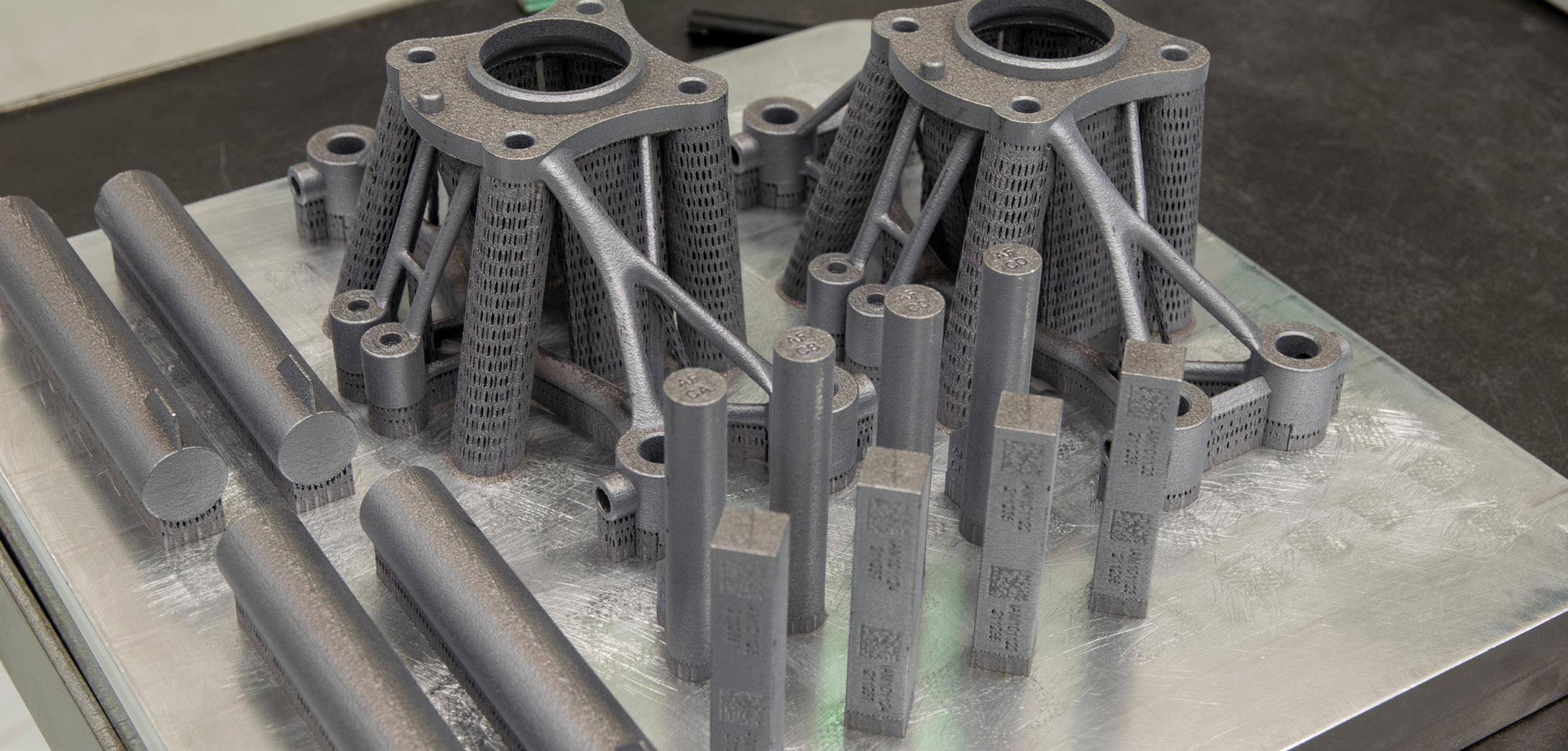
Additive manufacturing is playing an increasingly important role in various industries, especially in railway technology.
Conjuring up scarce and expensive spare parts at short notice for goods with a long service life is a major challenge. 3D printing offers a solution to the problem of how to efficiently replicate parts and, consequently, to improve the supply of spare parts. After all, the ability to produce small quantities quickly and costeffectively is often crucial. The mass printing of quality components is now set to be enabled through certification by TÜV NORD in accordance with the new DIN EN ISO/ASTM 52920:2023 standard.
“Additive manufacturing allows companies to ensure their vehicles are available because they can produce spare parts on-demand.This makes economic and ecological sense,because no transportation is involved,” says Dr Stefan Pöting, Director of the Business Field Rail. Reliable and repeatable processes in production preparation, additive printing itself and component post-processing are all critical. “The new DIN EN ISO/ASTM 52920:2023 test standard puts the industrial use of 3D printing on a secure footing in quality terms and is a real quantum leap for the industrial use of the technology,” says Jens Groffmann, Project Manager for Additive Manufacturing at TÜV NORD. During certification by TÜV NORD, all production steps are reviewed, from planning and the handling of
the starting materials through to actual production and post-processing. Also considered are the quality assurance measures taken throughout the entire process chain. Companies which are granted DIN EN ISO/ASTM 52920:2023 certification can demonstrate their successful transition from the single-part production of prototypes by skilled labour to efficient industrial manufacturing worldwide.
As one of the first companies in the world to issue certifications in accordance with ISO/ASTM 52920:2023, TÜV NORD has successfully certified Deutsche Bahn’s additive manufacturing facility in Neumünster. Other interested parties are currently also aiming for certification. To date, Deutsche Bahn has fitted around 100,000 3D-printed components – mainly wear or bottleneck components such as seat trims and lamp holders plus components for ventilation and air conditioning systems.
In the future, however, companies in the industry also aim to additively manufacture safety-relevant metal components and use them as replacements for components which require approval and verification. The use of additively manufactured components is currently limited to non-safety-critical components. The conditions which would allow safety-relevant components to be approved and certified as well are currently being investigated in the ‘DigiZug3D’ project, in which TÜV NORD is also involved. 3D-printed safetyrelevant metal components currently have to undergo a time-consuming individual acceptance process. As things stand, there is no binding calculation basis for component design and the provision of mathematical proof of component strength. The ‘DigiZug3D’ project, funded by the EU and the German Federal Ministry for Economic Affairs and Energy, is intended to remedy this lack while also simplifying and accelerating the approval procedure itself. The railway industry is very interested: Also involved along with DB are Hamburger Hochbahn, Hamburg’s biggest public transport provider, Austria’s largest railway company, Österreichische Bundesbahn, and the railway vehicle manufacturer Siemens. The project started in October 2023 and will run for three years.“This is currently all still in its infancy,but,in the best-case scenario,the process,once developed,will become a blueprint and open up the possibility for other industries to produce
safety-relevant components using 3D printing,” Mr Groffmann says.
The further development of additively manufactured components and their processes will be beneficial for many other industries. Sectors that operate expensive machines with long service lives or require complex components in small quantities at short notice will especially benefit. This applies to areas such as the pharmaceutical industry, the chemical industry, medical technology and aerospace. The possibility of producing spare parts promptly and in small quantities is also economically attractive for lorry manufacturers, bus builders and motorhome manufacturers, among others, as there are very many vehicle versions in these sectors. This will also pave the way to storage and transport cost savings for potentially unnecessary components, among other things. “DIN EN ISO/ ASTM 52920 also offers an enormous competitive advantage for suppliers of additively manufactured components.The independent verification of their production processes by TÜV NORD will enable certified manufacturing companies to supply high-quality components in the industrial series production context. This will give their customers security when it comes to awarding contracts and clearly set them apart from pure prototyping companies,” says Mr Groffmann.
Norms and standards for the implementation of a digital product passport are currently being developed to bring about even more transparency in the manufacturing process for additively manufactured components. The intention here is to improve the traceability and security of the information provided. “The standardisation of data formats and creation of interfaces is fundamental to ensuring interoperability between different systems,” says Dr Pöting. Visit TÜV NORD at InnoTrans Citycube A Booth 610 For
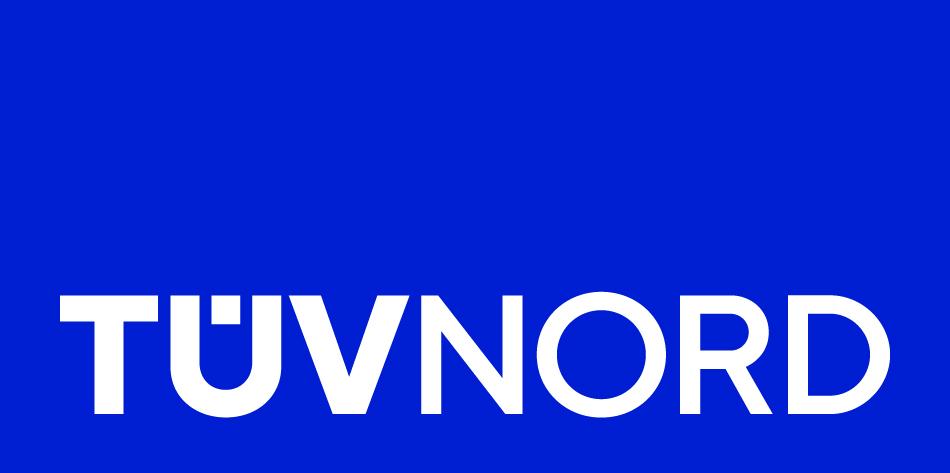
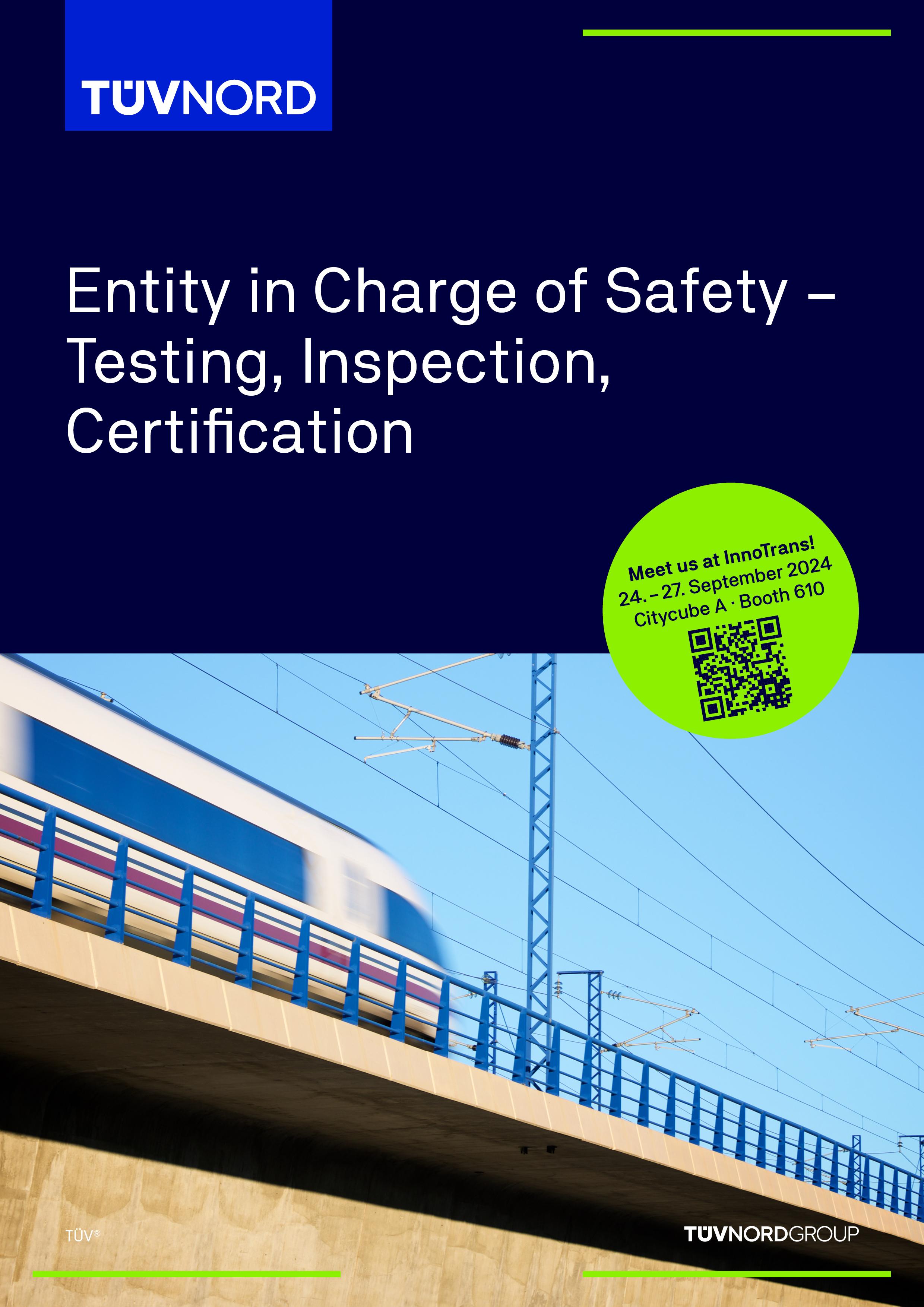
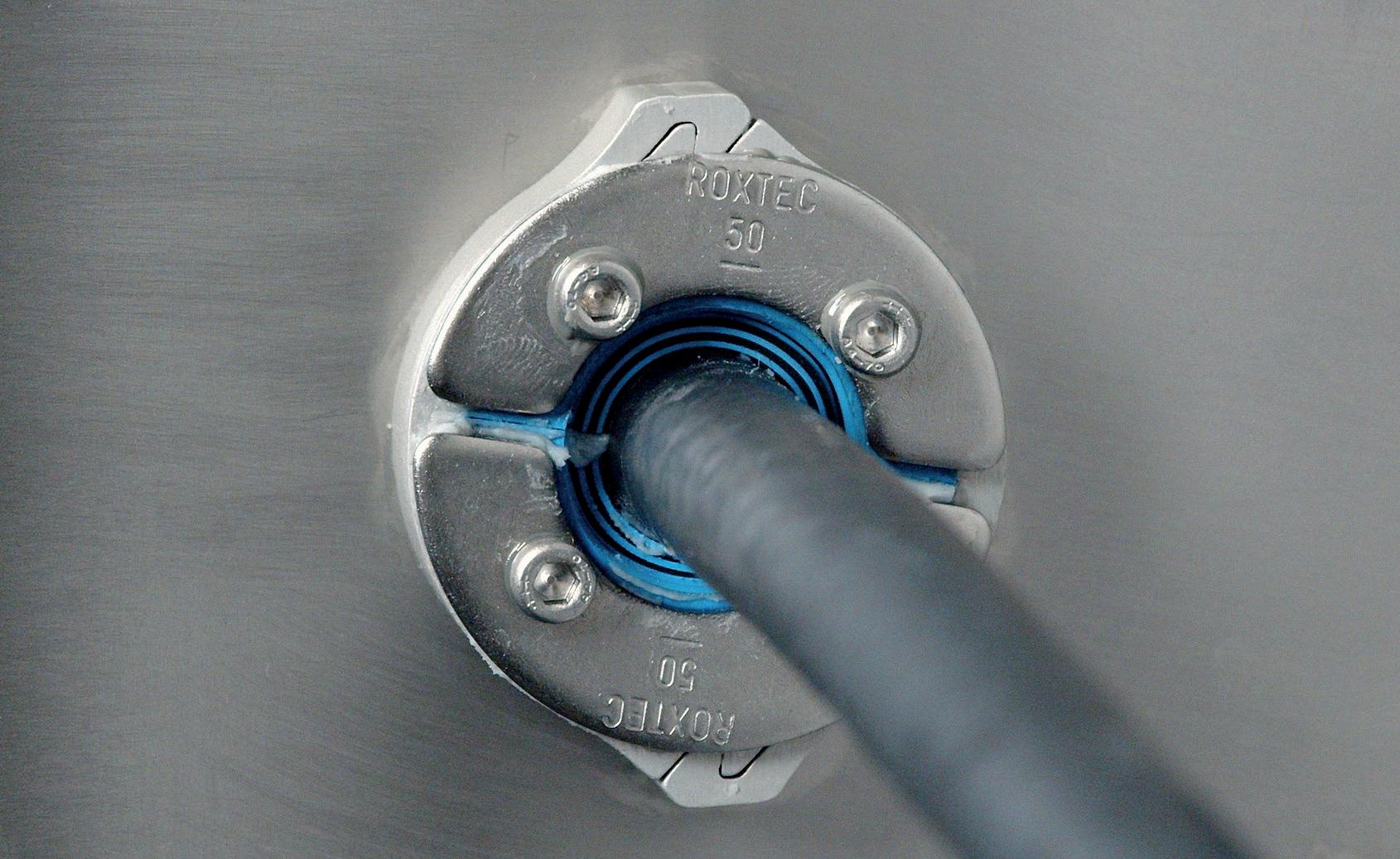

Roxtec has an impressive history when it comes to solving safety problems in the rolling stock industry. The company has developed penetration seals that fulfil the highest fire resistance requirements and cover the highest hazard levels to help avoid accidents and downtime.
Roxtec seals can be used as a standard solution for sealing around cables, hydraulic pipes and plastic conduits in fire rated barriers throughout the railroad vehicle structure. The seals withstand multiple hazards such as fire, smoke, water, air-shock and vibration, and provide excellent cable retention.
As a world-leading cable and pipe transit provider, Roxtec is focusing on continuous development and keeps on adding products to its portfolio. The new
series of compact and lightweight yet very strong transits are ideal for rolling stock.
The Roxtec C LW/K and the Roxtec C LH multi-cable and pipe transits have aluminium frames. The first one is attached to the structure by welding, the other one by bolting. The frames are used with sealing modules that adapt to cables and pipes of different sizes and that can be used to add spare capacity in the seal. The area-efficient seals provide ingress and fire protection as well as vibration-proof cable retention and are used in floor and wall applications.
There is also the Roxtec C RS SLO seal for single cable and pipe entries in cabinets, enclosures and equipment. It consists of an adaptable Roxtec C RS seal and a Roxtec C SLO sleeve. It is lightweight, reliable and perfectly suited for serial production, accommodating many cable and conduit sizes.
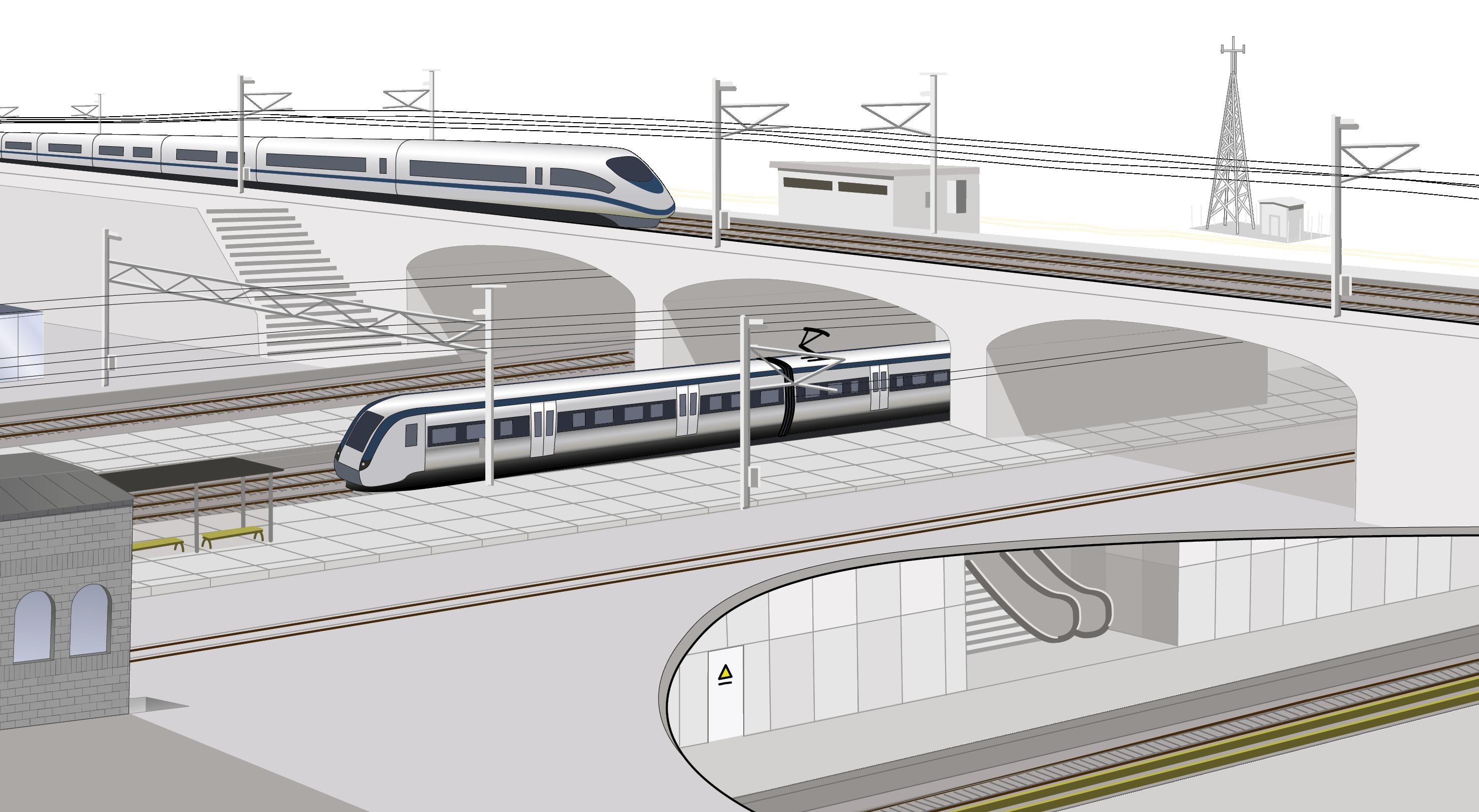
The versatile Roxtec CRF transit is another example. It can be used either with Roxtec CRF and CRF PPS modules for high-speed installations in serial production processes, with known cable and conduit sizes, or with compact Roxtec CM and CM PPS modules that adapt to cables and conduits of various sizes. The PPS versions of each module type contain intumescent material that expands to protect plastic conduit applications in case of fire. Regular-sized Roxtec RM PPS modules provide the same flexibility and fire protection for plastic conduits when used in Roxtec GH, S, SF or SK frames.
With a mindset concentrating on supporting rolling stock players in everything from design through to manufacturing, globally and locally, Roxtec has made sure to meet quality control and inspection standards. These standards can regulate production processes as well as documentation needs for the manufacturers. Therefore, the production and performance of Roxtec sealing solutions are certified according to a variety of standards, including the welding process standard EN 15085.
The sealing solutions from Roxtec enable standardisation since they fit a multitude of applications:
• Cable management – the sealing system is gentle to the cable sheath and excellent for keeping cables in place to avoid damage. It simplifies installation and maintenance work.
• Converters and inverters – the compact seals are lightweight and quick to install and they ensure peace of mind for years to come. The built-in spare capacity simplifies retrofits and upgrades.
• Floors – bolted and welded transits are the right choice for demanding floor applications. A wide range of Roxtec frames with varying packing space and frame depth makes design work easy.
• Junction boxes – Roxtec seals allow for high cable density, which enables designers to reduce the size and weight of junction boxes. The seals withstand harsh and high temperature environments.

• Partition walls – the seals are easy to install since each module is adaptable to cables, hydraulic pipes and plastic conduits of different sizes. It makes it easy to maintain the integrity of the fire barrier.
• Rooftops – the seals for rooftop-mounted equipment ensure long-term reliability of airconditioning systems and antennas. The modularbased concept makes retrofits and service a smooth task.
• Pipes – Roxtec round and compact sealing solutions can be used for the vehicle undercarriage to seal off around hydraulic pipes.
Would you like to know more about Roxtec sealing solutions or additional Roxtec services such as installation training for installers and supervisors? Are you interested in learning more about Roxtec transit design and management software, such as Roxtec Transit Designer™ which allows you to filter by application, certificate and sealing requirements to select the right sealing solution for optimised safety?
Feel free to visit Roxtec in Hall 15.1 Stand 255 and Hall 22 Stand 280 at InnoTrans 2024.
• Pantographs – Roxtec provides solutions for sealing and grounding of high-voltage power cables. There are round seals for area-efficient installations and high environmental protection.

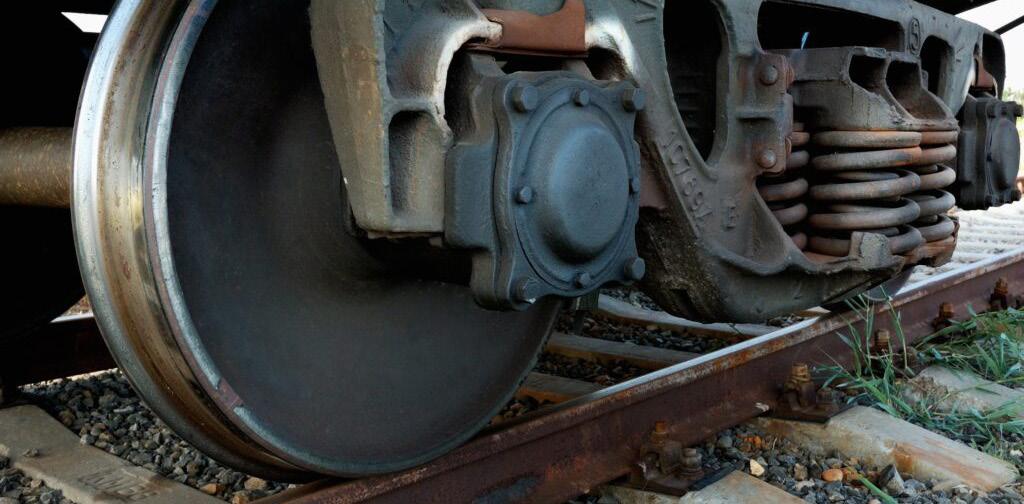
To ensure peace and quiet, our flameretardant sound deadening solution absorbs structure-borne noise in trains.
When we talk about travel comfort, it's not just about speed, comfortable seats and legroom, but also about the feeling of space in the train compartment or aircraft cabin. Passengers who want to work or rest undisturbed during their journey can choose quiet compartments on trains, where loud talking, mobile phone use and other noisy activities are prohibited. To reduce the structure-borne noise of the carriages themselves, and thus create the quietest-possible
environment inside, many rolling stock manufacturers use sound insulation. The sheet metal used in the interior construction of the carriages – for example for cladding – is coated with sound-absorbing materials to reduce the noise generated by the sheet metal. The paint and coating experts at griwecolor GmbH have two products in their portfolio that have been developed for this application: griwephon AN2-800 and griwephon light AN2-900.
The product range has now been extended by the new griwephon AN2-750/EU, which is classified as a non-flammable product, class A2, according to DIN EN 13501-1. The product has passed the toxicological test for use in rail vehicles with flying colours. All three ready-to-use one-component solutions have also been tested for fire behaviour in accordance with the EU rail vehicle standard EN 45545-2. Griwephon AN2-800 and
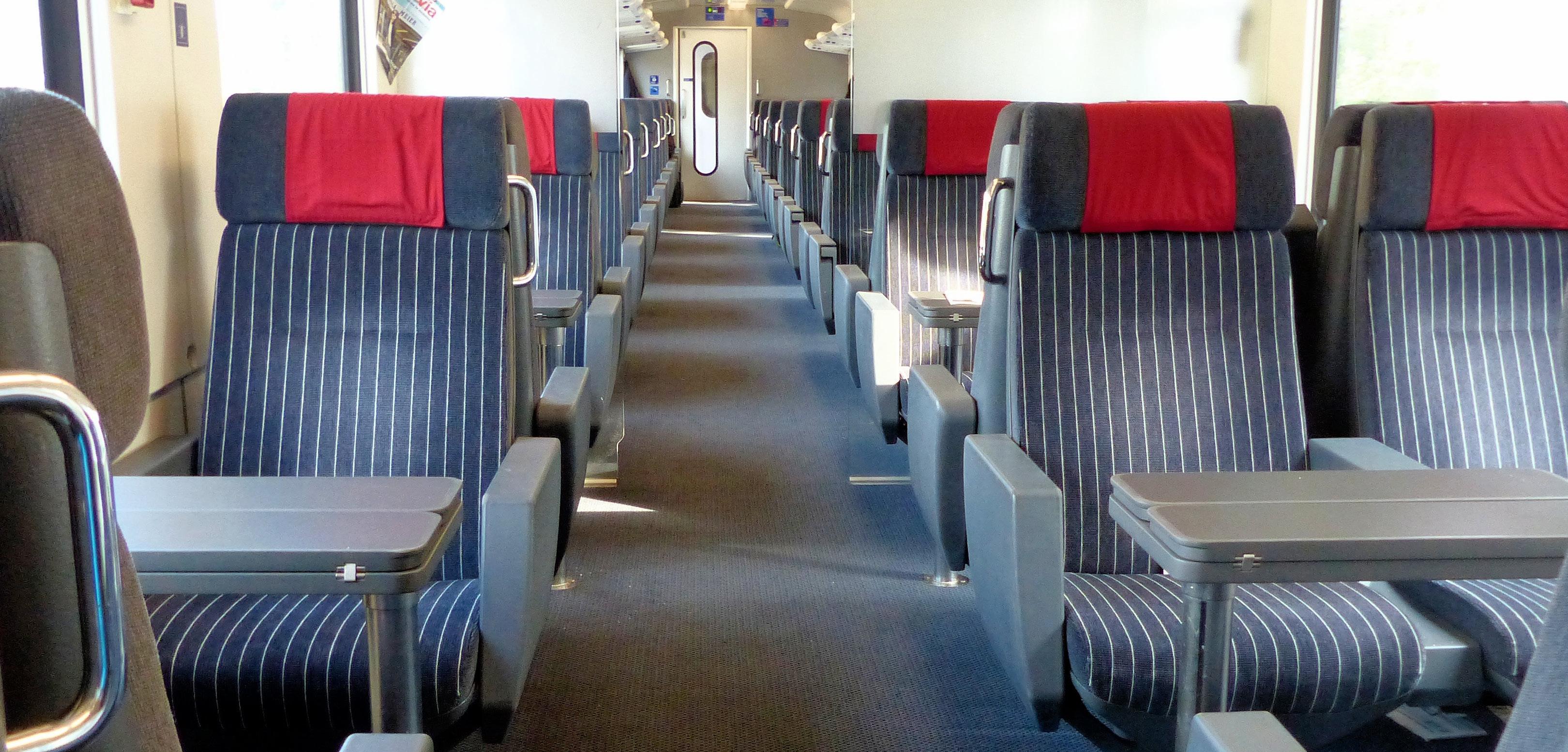
AN2-900 meet the requirement sets R1, R2, R3, R6, R7 and R17 at hazard levels HL1, HL2 and HL3. In addition, all three products have very high acoustic effectiveness according to DIN EN ISO 6721-3.
Some people find that the monotonous noise of train wheels on the tracks makes them drowsy, while others find it difficult to block out such external influences in order to sleep or work with concentration. Sound insulation and the reduction of structure-borne noise in rail vehicles to provide a more relaxing journey for passengers is therefore a major challenge for engineers. Although some components can be made from alternative materials, it is often not possible to avoid thin-walled sheet metal structures where significant vibration is unavoidable. This results in annoying background noise. “The development of our sound-absorbing griwephon AN2-750/EU is based on the extensive experience we have gained with AN2800 and AN2-900 as well as in the building materials sector,” says Jörg Grieshaber, Managing Director Technology and Development at griwecolor GmbH “With these products,we have accumulated decades of expertise in noise reduction for rail vehicles and façade elements or windows, which we have used in further development in terms of reduced smoke density and smoke gas toxicity as well as acoustic effectiveness and flame retardancy.”
AN2-750/EU has been classified as a Class A2 noncombustible product in accordance with DIN EN 13501-
1; it has also passed the toxicity and smoke density test to DB Systemtechnik specifications with flying colours. It therefore meets the R1 requirements for HL1, HL2 and HL3 for use in rail vehicles in terms of smoke development and toxicity. Like the two variants already on the market, the sound-deadening solution, based on an aqueous synthetic resin dispersion, is hydrophobic and solvent-free.
Large sheets of metal are often used in the manufacture of railway carriages. These vibrate as the train moves, producing noise. This structure-borne noise travels almost unhindered and without loss
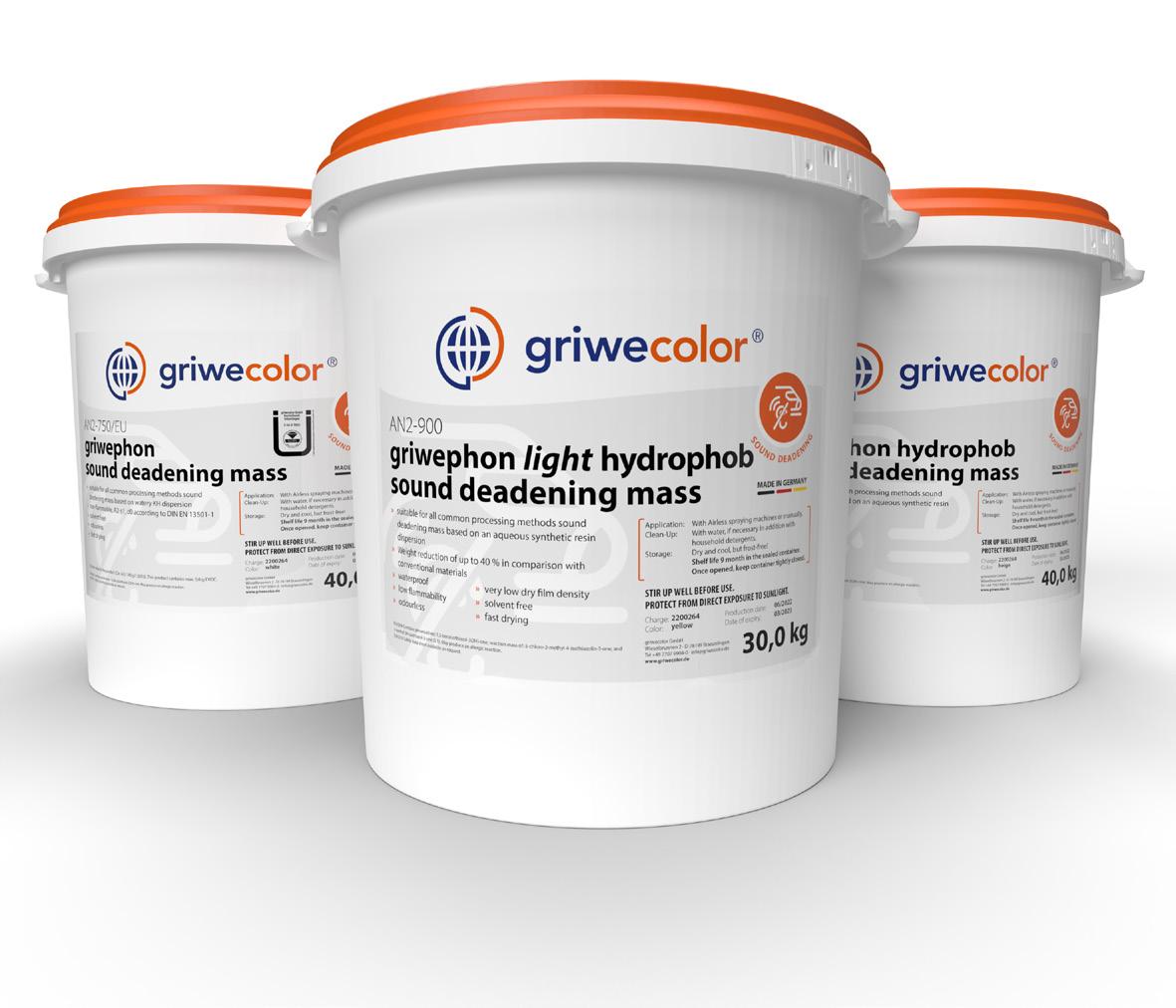
“The development of our sound-absorbing griwephon AN2-750/EU is based on the extensive experience we have gained with AN2-800 and AN2-900 as well as in the building materials sector,”
Jörg Grieshaber, Managing Director Technology and Development at griwecolor GmbH
through the metal components of the vehicle. These sound waves are then transmitted to the air, resulting in audible noise inside the carriage. To prevent this annoying noise, homogeneous layers are placed between the individual elements to provide internal damping. Thanks to its composition of inorganic components in combination with a low proportion of organic components, the griwecolor soundproofing solution achieves a very high acoustic damping effect. As the griwephon layer penetrates the material to which it is applied, it largely eliminates the material's vibrational energy by converting high-frequency vibrations into low-frequency vibrations. As a result, rail vehicle bodies emit less noise into the air inside the vehicle. “Thanks to the special composition of our sound insulation,we achieve a very good value in terms of internal damping,” explains Grieshaber. The loss factor according to DIN EN ISO 6271-3 is between 0.22 and 0.24, depending on the installation situation, layer thickness and material, so that a large proportion of the structure-borne sound energy is absorbed by the sound insulation. The use of a combination of mineral fillers, such as aluminium hydroxide, and the development of a special binder with high toughness, makes it possible to apply up to 5mm of double sheet thickness. The quality of the filler and the unusual layer thickness are jointly responsible for the high absorption rate. Another advantage of the mineral components is their low thermal conductivity.
“As with all our products,we've made sure that griwephon AN2-750/EU,AN2-800 and AN2-900 are environmentally friendly and easy to use,” explains Grieshaber. “Based on an aqueous synthetic resin dispersion,we do not use any solvents to achieve the lowest-possible VOC content.Intensive development work has enabled us to achieve a value of less than 0.6g/litre.Thanks to its composition,the soundproofing solution can be applied with airless equipment at a

An application thickness of up to 5mm is possible
minimum ratio of 60:1,as well as with reciprocating pump equipment using atomised air at a ratio of around 12:1,or with screw conveyors using atomised air at an inlet pressure of 3 to 4 bar.Manual application with a spatula or mortar trowel is also possible.The soundproofing solution has a high degree of stability when applied to vertical surfaces.When applied wet, a layer thickness of up to 5mm can be applied in one operation without the product slipping or cracking the surface.
After drying,the layer thickness is approximately 4 to 4.5mm.The application is therefore fast,safe,clean and poses no health risks due to the ingredients,” concludes Grieshaber. Even in the event of a fire, griwephon AN2750/EU does not release any toxic gases. The material has been tested to EN 45545-2 with very good results in terms of smoke density and smoke gas toxicity. Our griwephon sound insulation therefore combines fire protection with easy handling and efficient noise protection.
Further information visit www.griwecolor.

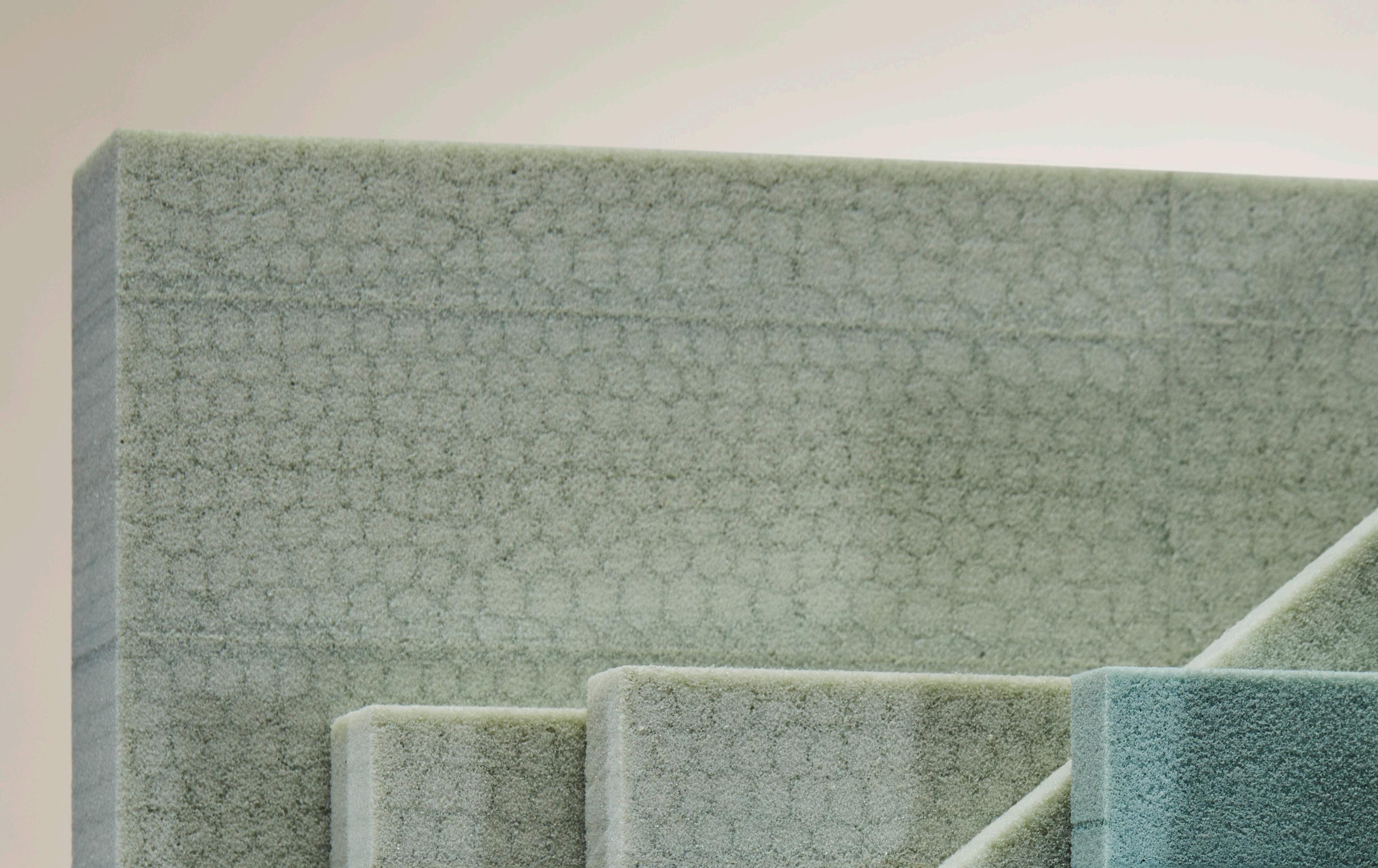

Discover the future of sustainable rail travel with Diab’s cutting-edge PET core materials. Engineered for lighter train designs, our full range of 100% recyclable Divinycell PR core material combined with our sandwich engineering reduces fuel and energy consumption, enhances payload capacity, and extends range.
Experience unparalleled insulation, fire resistance (EN45545-2 qualified), and minimal maintenance costs.
Visit us at InnoTrans 2024 in Berlin Hall 5.1, Stand 410
Elevate your rail applications with Diab. TABLES
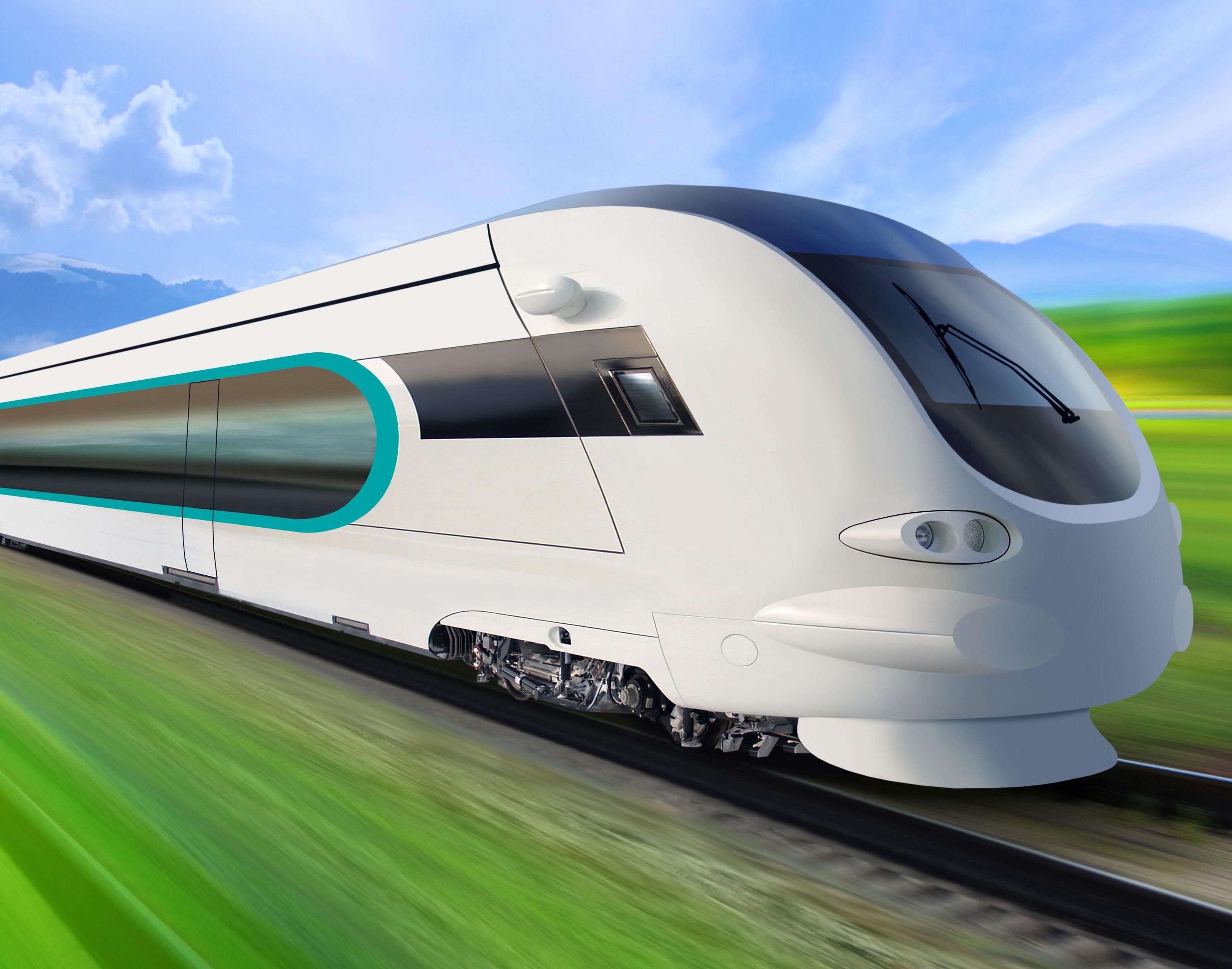

As the transportation industry evolves, the focus on sustainability and efficiency becomes increasingly critical.
For over 70 years, Diab has developed, improved and fine-tuned our cores and sandwich technology with a solid focus on sustainability, turning us into the market leader in many areas. We have also grown into a total solutions partner that provides complete end-to-end services, from technical and design support to creating kits ready for your production.
At InnoTrans 2024, we will showcase our innovative recyclable Divinycell PR sandwich core materials and all our services, highlighting advancements poised to significantly impact the rail industry.
Our Divinycell PR sandwich core materials are engineered to support the creation of lighter train structures. This reduction in weight can lead to notable decreases in fuel consumption and carbon emissions, which can contribute to lower operational costs and a reduced environmental footprint.
Key Benefits:
Lightweight Design: Divinycell PR is designed to provide the necessary strength without adding excessive weight, potentially enhancing payload capacity and range in rail applications.

Non-Organic Composition: The core’s non-organic nature eliminates the risk of rotting, which can be a concern in various environments.
Insulation Properties: Divinycell PR offers enhanced insulation capabilities, which can benefit train interiors by contributing to energy efficiency and passenger comfort.
Fire Safety: Compliance with EN45545-2 standards ensures that the Divinycell PR meets stringent fire safety requirements, which is crucial for rail applications. Several alternatives exist to achieve a lightweight, sustainable solution with aluminium, HPL or fibre-reinforced composite skins in combination with fire-retardant resins.
Full Recyclability: The 100% recyclable Divinycell PR reflects a commitment to sustainability and supports a circular economy.
Our PET core materials are designed to withstand rigorous structural demands while ensuring compliance with fire safety standards. Their versatility makes them suitable for various applications within the rail industry, from floors to interiors and exterior components.
Our core materials have been integrated into several rail projects, demonstrating their robustness and versatility. These real-world applications highlight the materials’ performance and safety, making them a viable option for train manufacturers.
In lightweight applications, reliable fastening is a must. Diab has investigated different fastening methods like screws and various types of inserts and can recommend verified techniques for fixating elements that carry load. Using extensive lab testing, Diab created design procedures that include real-life circumstances like pull

out, shear, ageing and fatigue. With Diab’s know-how, we can engineer fastening solutions that contribute to lighter and more sustainable composite applications.
We will be at InnoTrans 2024 in Berlin from September 24 to 27. Visit Hall 5.1, Stand 410, to learn about Diab’s innovative products and how they might contribute to sustainable solutions in the rail industry.
At Diab, we are committed to providing solutions to our clients and sharing our knowledge and extensive experience in sandwich structures. With industryleading competence, the broadest range of stronger, lighter, smarter core materials and a global presence, we continue to support advancements in various industries, including rail transportation.
To find out more about Diab Group visit www.diabgroup.com


During this year’s InnoTrans Exhibition, EAO will focus on the latest HMI developments and solutions that go beyond mere HMI components.
As an expert partner for human-machine interfaces, we can offer specialised HMI solutions for a variety of different railway applications. In addition to our wellknown high-quality products such as the Series 57 door opening pushbutton or the Series 04 products for driver’s cab, we can also develop your individual pre-wired HMI panel, integrating specific HMI functions you require. We take into account all functional and ergonomic requirements, including market- and country-specific standards. Thanks to our effective planning and customer-centric design, you benefit from precise implementation from concept to prototype production, to pilot series and series production. EAO can provide you a custom-tailored HMI solution that brings you optimum benefit for your application and
can easily be integrated into your existing systems and designs. Everything for the best interaction. And along the way, we support your project from initiation to implementation with comprehensive advice and technical expertise.
During InnoTrans we will showcase numerous examples of such HMI solutions and panels for driver’s cabs, passenger access systems, toilet applications and passenger convenience.
This new HMI Solution is based on a standardised platform, that offers maximum flexibility in terms of customer-specific design and system adaptations. Not only can it be easily and seamlessly integrated into the passenger information system but thanks to the
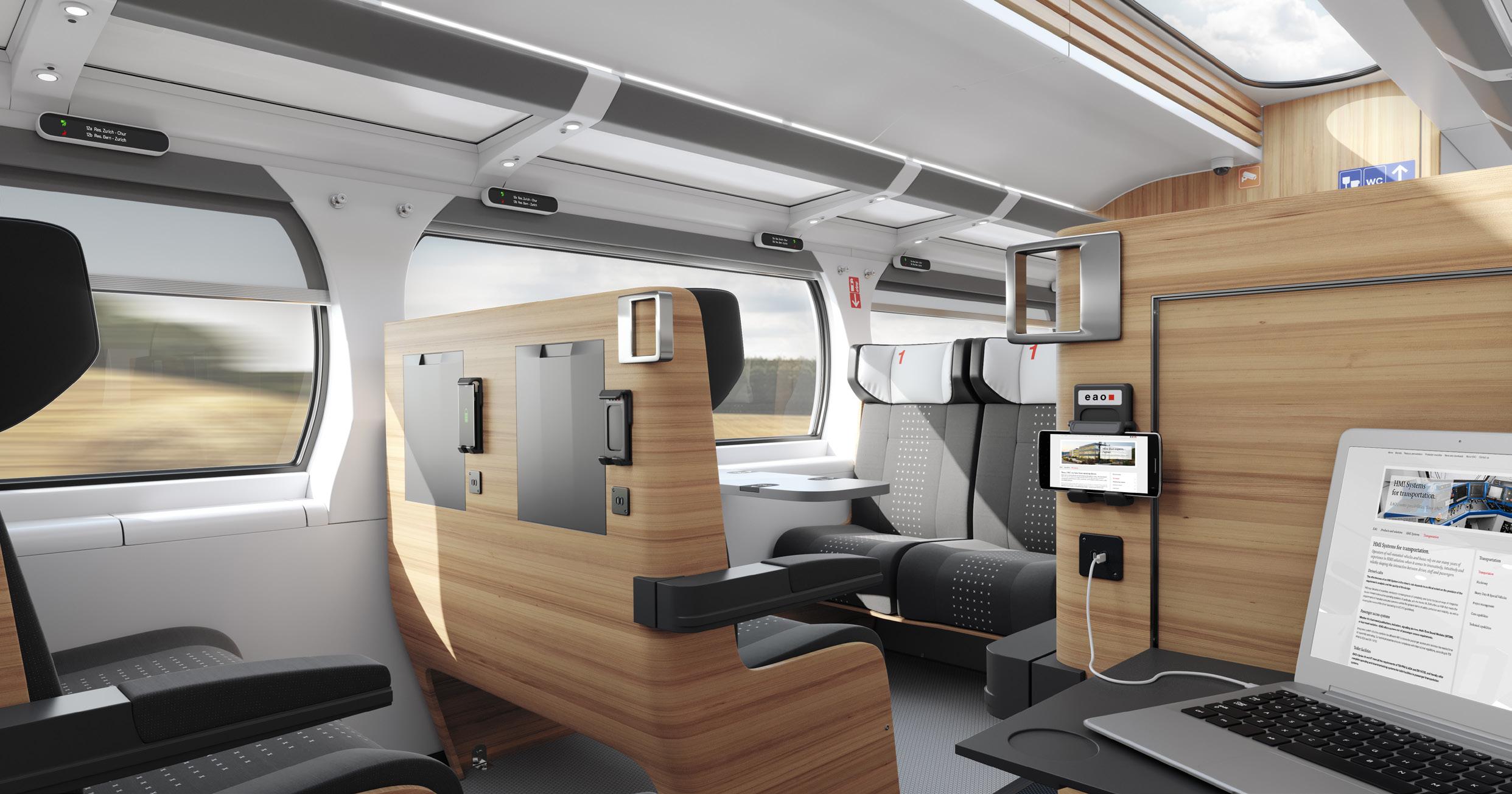
innovative display technology and bright, clear, seat status indicators, passengers can easily locate a free seat, or find their reserved seat.
Advantages
• Early recognition of seat reservations thanks to bright LED indicators
• Increased passenger flow efficiency
• Energy-efficient, cost-effective and high-contrast display technology
• One display solution for flexible installation situations
• Seamless integration thanks to versatile customisation options
Our energy-efficient display ensures high contrast for maximum readability and minimum power consumption. Text can be displayed in white on a black background or in black on a white background. If required, the backlighting can be activated depending on the lighting conditions, to ensure best readability. The number of seats to be displayed as well as general display content are shown on the full graphic display using customised software, which enables maximum flexibility. Thanks to the modern display technology, the display only requires energy when the display content is changed – a highlight in terms of cost and energy efficiency.
The housing of the display can be customised according to individual application requirements. This guarantees a seamless integration into any train design. The software specifications can also be tailored to individual requirements during the course of the project. Depending on the installation requirements, the display can be rotated by 180 degrees so that the cable can exit to the left or right and be individualised with specific insert strips which can be supplemented with various symbols – so not only can aisle or window seats be clearly identified, but so too can special areas, for example those for bicycles.
Overall, the EAO seat reservation system represents a comprehensive solution for the requirements of rail transport. From straightforward installation to flexible adaptation to different seating arrangements and design requirements and with a focus on efficiency, we are setting new standards for the future railway travel experience.
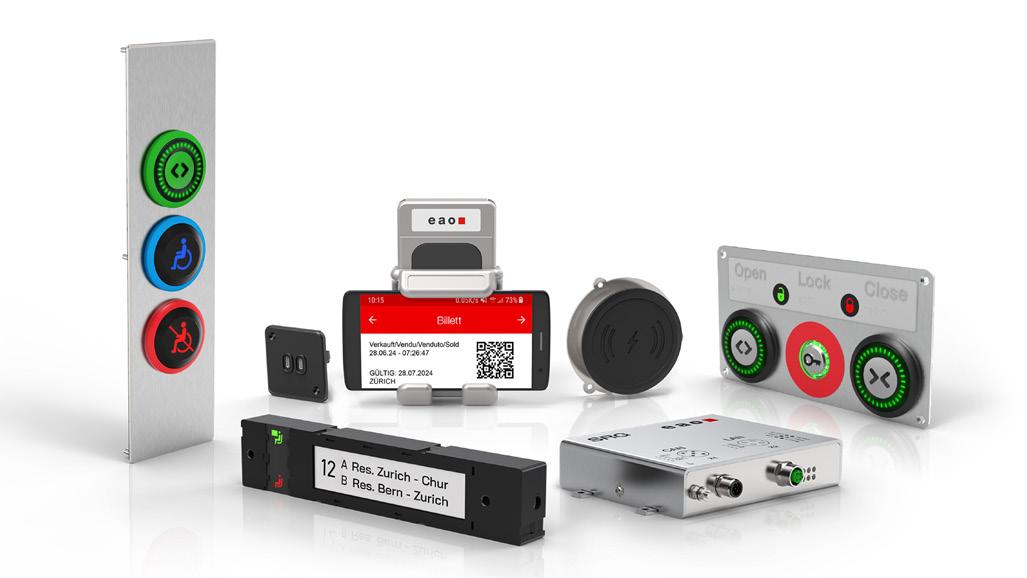
The range includes both wireless chargers and standard USB-A or USB-C sockets and can be installed in different areas across the train to avoid ‘low battery anxiety’ among the passengers. EAO chargers can be fitted to tables, seatbacks, walls and even grab poles to provide a phone charging service to nearly every passenger. With the new multi-voltage Power Delivery / PPS USB-C sockets, EAO can also provide laptop and fast charging for phones through one connection.
• Clear enhancement to the passenger experience and the operator’s image
• Can be retrofitted during refurbishment or as a separate upgrade
• Unique seatback mounted USB-C Power Delivery socket for phones and laptops
• Generate revenue from sponsorship with physical branding of logos or URLs on chargers
• Charge phone without the inconvenience of carrying plugs and cables
We invite all visitors to experience the great HMI products and immerse themselves in the fascinating mountain world of Switzerland – which is characterised above all by its accessibility by train. But we don't want to give too much away just yet – let us surprise you!
Visit us at our Booth 760 in Hall 27 during this year’s InnoTrans in Berlin.
Find out more or contact us now at www.eao.com/s/innotrans-2024


EAO develops and produces high-quality HMI Components and Systems for the public and private transport sectors. Whether it’s a driver’s cab, passenger access system, passenger convenience or any other application, we provide a solution tailored to your individual needs.
Our latest developments for railway applications
. New seat reservation system for an optimised passenger flow
. Charging solutions for integration in your train
. HMI Systems for all railway applications
Read more or contact us www.eao.com/s/innotrans-2024

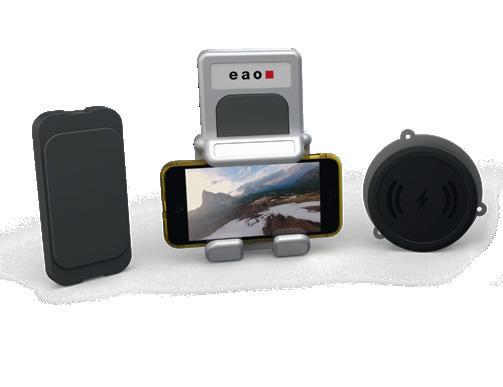





ML5-1/170 as front lighting for rail vehicles
CK Touchless push button with tactile and touchless activation
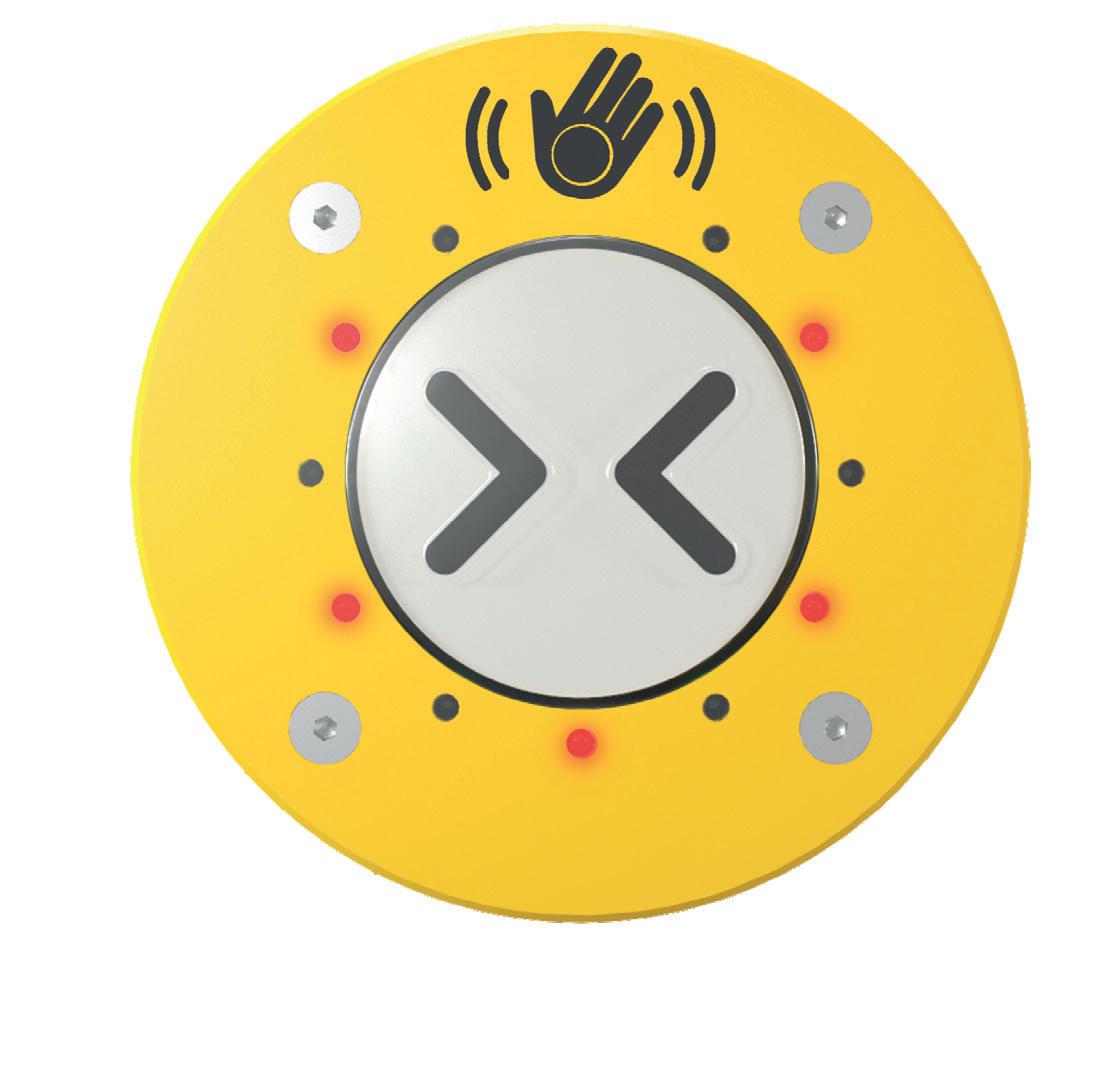




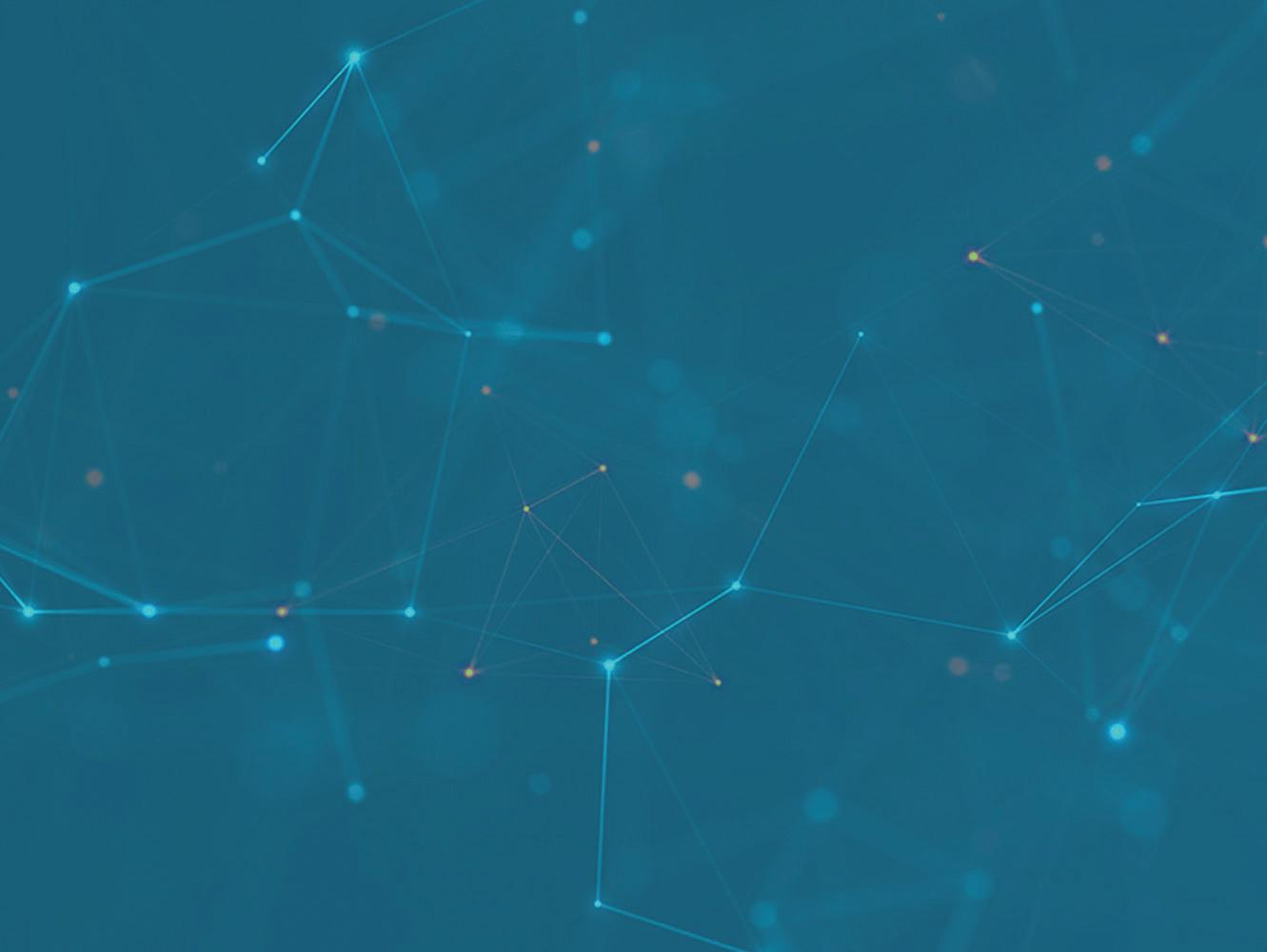

AtInnoTrans 2024, TSL-ESCHA and MAFELEC will jointly present a wide range of solutions from a single source to further improve passenger comfort.
TSL-ESCHA and MAFELEC are focusing on continuous development to further improve passenger comfort in public transportation, both locally and long-distance. At InnoTrans 2024, they will showcase innovative solutions from a single source that are being utilised in thousands of vehicles worldwide.
By combining TSL-ESCHA and MAFELEC, the range of innovative solutions for traffic technology for buses and trains is continuously expanded. The new products such as the handrail lights HL22 and HL18, the handrail button HSTIAV, and the sounder WSM87 set new standards in traffic technology.
The aesthetic design of train interiors and exteriors is becoming increasingly important today. With the M-Light product series, MAFELEC offers front lighting solutions for rail vehicles that can be customised to meet customer requirements. MAFELEC not only supports train manufacturers in the development, but also in the production of light modules and complete optical systems.
With the latest edition of the PK5x series, TSL-ESCHA and MAFELEC are focusing on proven quality and advanced functions. The PK55 can accommodate dual activation: tactile actuation for reliable and haptic feedback compliant with PRM requirements, and a

touchless activation option that provides hygienic benefits.
The distance and activation time of our touchless M-Safe technology can be adjusted to prevent unintended activation.
The integrated M8 plug connection on the back of the push button for 24VDC applications. M8 offers a high level of reliability for an easy connection (3 to 5 poles) and reduces the number of junctions in door profiles, simplifying installation and reducing maintenance. The extension of the proven PK5x push button series offers a high level of convenience, safety and efficiency to meet the needs of passengers. More features to come.
Leveraging their expertise in LED technology, TSLESCHA has introduced two versions of handrail lighting specifically designed for rail vehicles: the HL22 and HL18. The HL22 is another joint project between TSLESCHA and MAFELEC.
The lighting solutions are installed in handrails in the door area. They blend seamlessly into the vehicle's design, providing a modern appearance and enhancing the interior ambiance. Positioned strategically in the
door areas, the handrail lights function as orientation aids for passengers, improving transfer efficiency and ensuring safe and comfortable boarding and alighting.
TSL-ESCHA and MAFELEC offer a wide range of handrail buttons. These product families are very versatile, ranging from simple stop request buttons to backlit displays and touchless functions.
The HST series from TSL-ESCHA, which has been in production since 2004, has been further developed and now offers a variant with acoustic, visual and haptic feedback all in one. The HSTIAV (the ‘I’ stands for ‘illumination’, the ‘A’ for ‘acoustic’ and the ‘V’ for ‘vibration’) offers vibration and acoustic feedback in addition to the two-colour illumination option in red and green, which is activated for a short time when the button is pressed, so that the feedback can be seen, heard and felt. The goal is to provide passengers with an even greater sense of safety by offering a variety of feedback options when the handrail button is pressed.
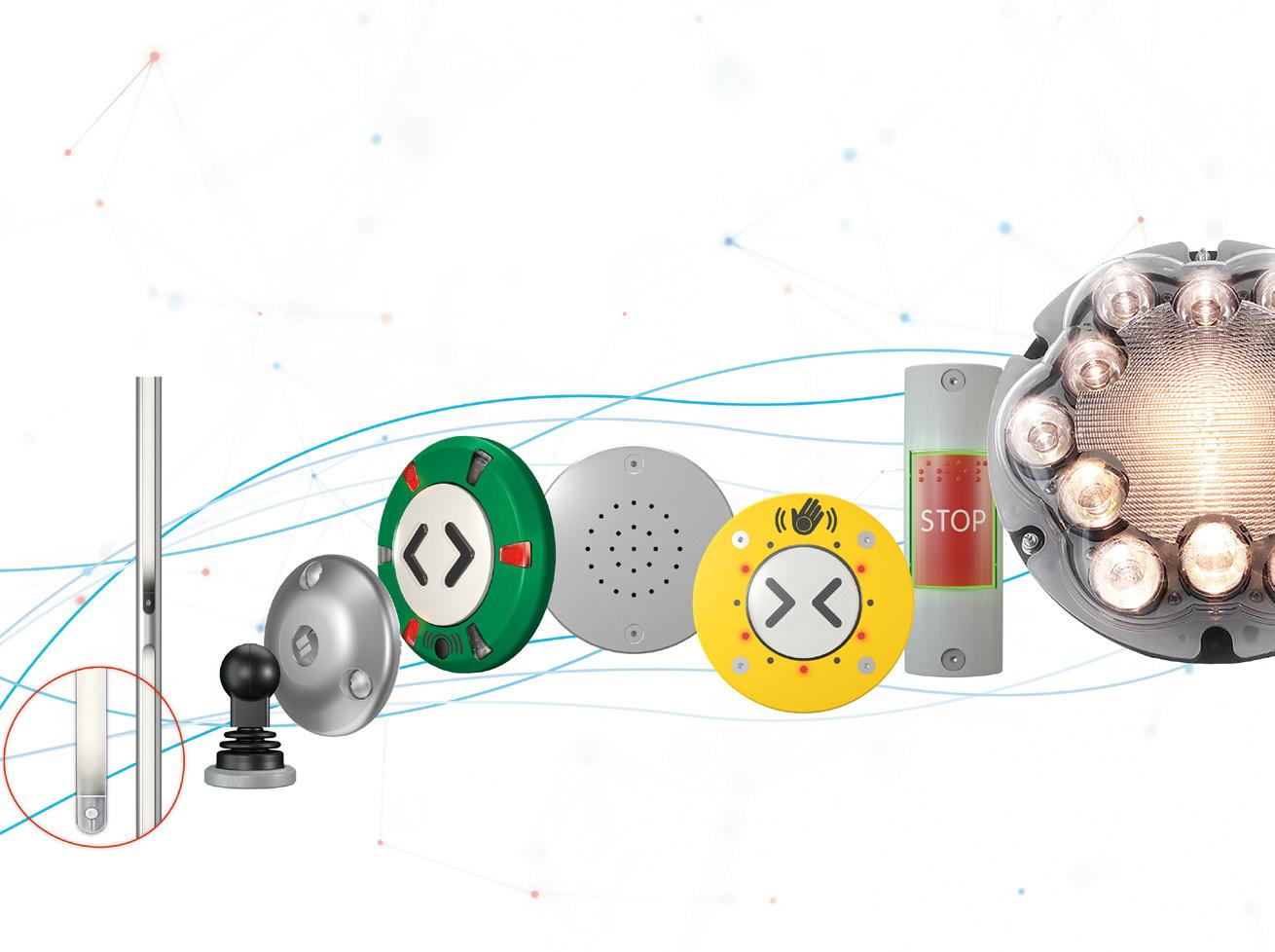
Varied product portfolio from MAFELEC and TSL-ESCHA
all types of rail vehicles, so that all common installation environments and the implementation of all marketspecific lighting functions can be realised. All M-Light products are adapted to the individual (lighting) technical requirements of the customer in order to provide an optimal lighting solution taking into account all operating conditions.
There is an M-Light solution for every new and refurbishment project.
Sounders in the door area of rail vehicles are extremely important. Passengers need to be warned in good time before a door opens or closes.
The WSM87 is a new development from TSL-ESCHA. The sounder has a flat design and can be easily installed in the door leaf, door cove or vehicle wall of rail vehicles. With up to 15 different melodies, the vehicle operator has many individual sound design options and can thus effectively draw attention to different situations in the vehicle.
With its modern design and advanced features, it sets a new standard in acoustic warning devices for side entry systems.
The MAFELEC M-Light range offers a suitable format for
Whether push buttons, LED lights and lighting for rail vehicles or sounders – the products from TSL-ESCHA and MAFELEC are always designed to meet individual customer requirements and offer passengers optimum comfort through innovation.
See the MAFELEC TEAM's products for yourself and visit the joint stand at this year's InnoTrans 2024 (Hall 27, Booth 480)
www.mafelec.com www.tsl-escha.com


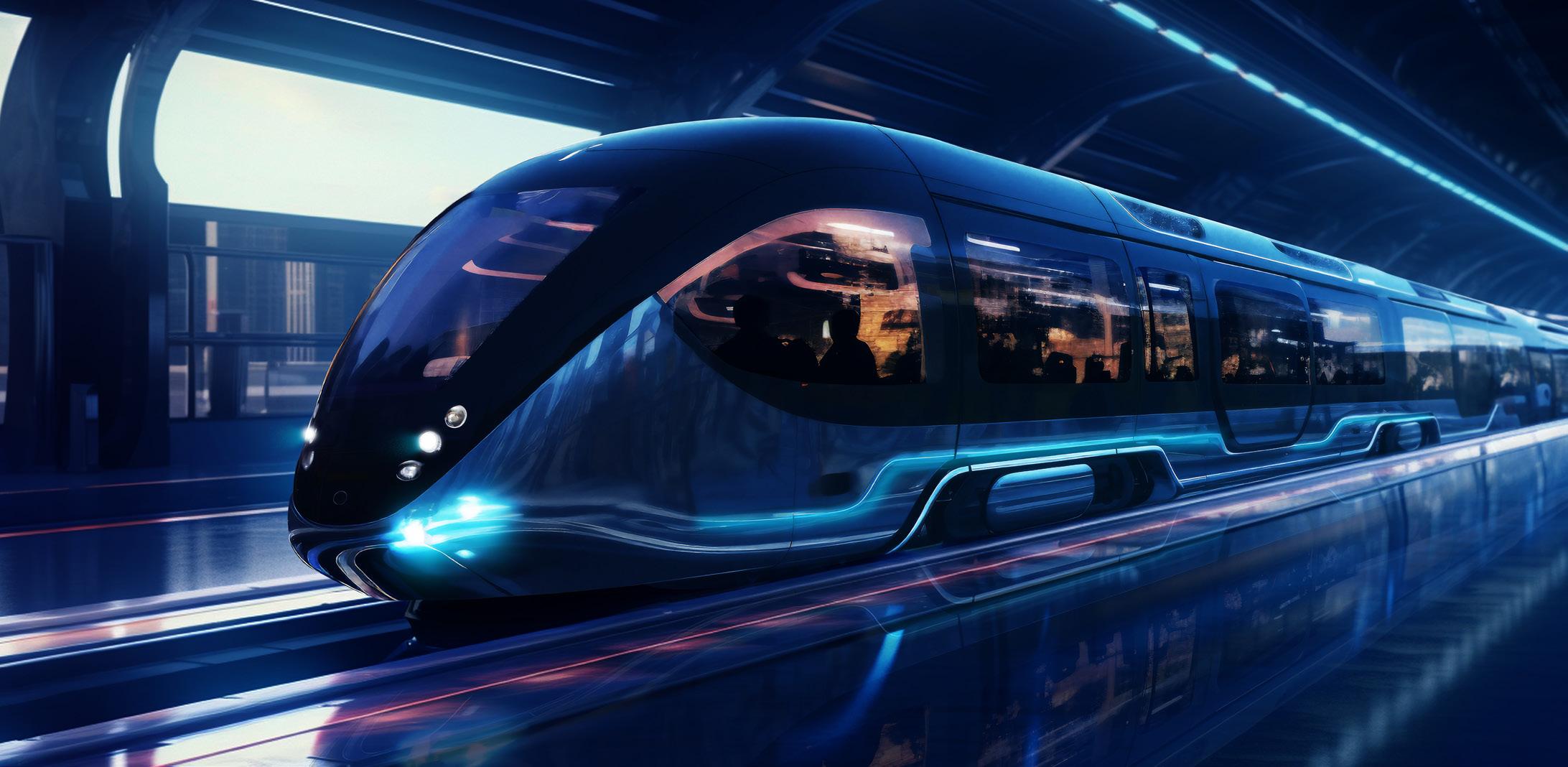
In the early summer of 2024, ZF celebrated its 100th anniversary in the rail vehicle market. From its ‘humble beginnings’ in 1924 – with a drive system for railcars adapted from a passenger car transmission – ZF has continuously expanded its portfolio of driveline, chassis and safety technology.
Today, the company is positioned as a leading supplier for the industry, with customers all around the world.
Comfort. Speed. Reliability. Efficiency. Ever since the invention of the locomotive, manufacturers and operators have striven to improve this vital mode of transportation. In 1924, a then-new German engineering company did just that. Because that year, as evidenced by a sketchbook entry, saw ZF enter the
railway business. The TS18.5 Soden transmission had been adapted by ZF engineers for rail vehicles, after already proving itself in its primary application in passenger cars.
100 years on track: ever since it entered the railway technology business in 1924, ZF has supported the industry in its trajectory towards the future – with better, safer and more reliable products.
This origin story also connects to a strength that still differentiates ZF from its competitors: The company’s ability to innovate through the smart transfer of technology within its different divisions. “We have always been able to capitalise on driveline and damper
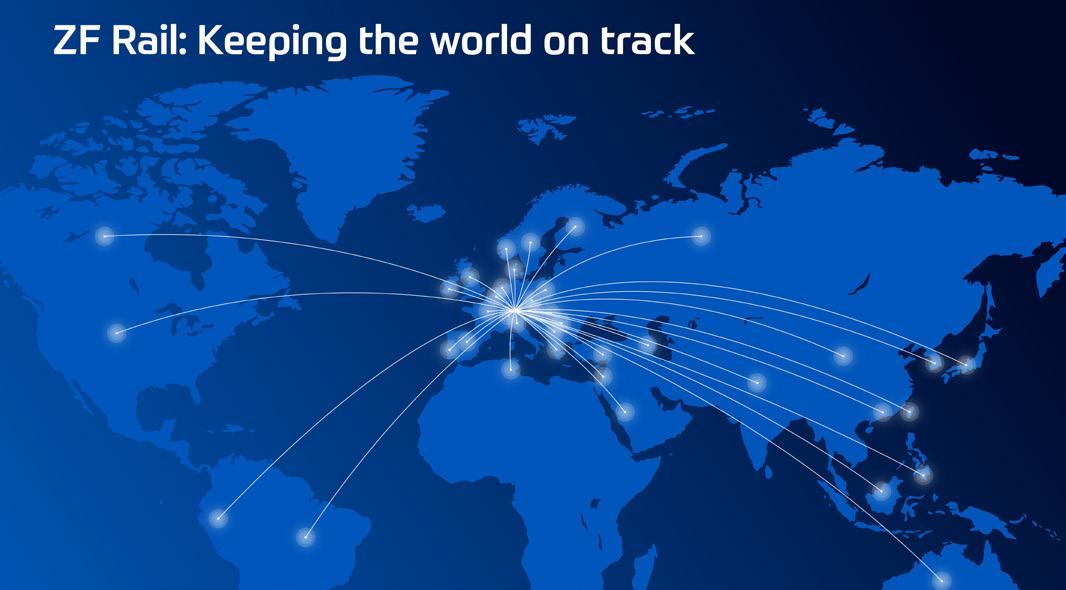
developments from other applications – especially commercial vehicles,” explains Markus Groß, Product Line Manager for railway technology at ZF. This means that from the very start, ZF was able to bring new technology to the market in ways that paid off – both for the company and its railway customers. In the same manner, ZF would later modify multi-ratio and automated CV transmissions for rail vehicles (like the Ecomat Rail or EcoLife Rail). But the Group also broke new ground, for instance by supplying mechanical drive components for electrified trains.
Additionally, over the course of the decades, ZF bolstered its portfolio by strategic acquisitions. As a result, the rail technology segment of the ZF Group grew into an overall supplier of driveline, chassis and safety technology for a wide range of rail vehicles. Whether you are looking at metros, trams, electric multiple units, high-speed trains, diesel multiple units, locomotives or special vehicles – chances are, if it’s running on tracks, it does so with the help of ZF components.
This kind of engineering trailblazing, as well as a reputation for reliability and efficiency, has led to ZF becoming a leading supplier and technology partner for vehicle manufacturers and transport associations in all corners of the world. Rapid transit trains in almost every major city – from Istanbul to Shanghai to Los Angeles to Lima – rely on ZF technology. ZF yaw dampers stabilise the swift and comfortable travel of high-speed trains operating in China or connecting mainland Europe with Great Britain via the Channel Tunnel.
Further strengthening this international presence is the ZF Aftermarket Division, which does not only provide fast spare parts, technical information and flexible service offerings around the globe. “Through our Aftermarket colleagues,we can also offer to repower rail vehicles,” explains Groß. Outfitting existing vehicles with new drive units helps to keep them reliable, stretch their service life and bring down total lifecycle costs. “This is a more sustainable and economical approach to keep trams,metros and trains on the track.Plus,it often means fewer interruptions to our customers’operations.That’s why this option is something we always keep in mind when developing new drive components.”
Another key part in the company’s strategy to support the rail industry? Digitalisation. Case in point? ZF’s condition monitoring system ‘connect@rail’. Through the smart use of sensor technology, telematics and cloud computing, connect@rail can identify potential faults on the vehicle’s wheels, and furthermore, the track itself. “We are also currently exploring ways to expand connect@rail to cover more of the driveline and the infrastructure,” says Groß. This helps to make the operation and maintenance work more predictable, to avoid failures and downtime and facilitate better planning for repairs. Because, as pointed out by Groß: "Sustainable mobility of the future requires reliable rail vehicles.And with our 100-year commitment to this segment,we are happy to provide the rail industry with the technology to achieve this vision.” Now, tomorrow and in the coming century as well.

ZF Friedrichshafen AG
Industrial Technology
Marine & Special Driveline Technology
Phone +49 7541 77-3610
rail@zf.com
zf.com/rail
Based on 100 years of experience in the rail industry, manufacturers and operators of rail vehicles can profit from innovative and sustainable ZF solutions for the mobility of today and tomorrow. Learn more about us and our products and visit ZF.com/rail
Visit ZF at InnoTrans Berlin, 24–27 Sept 2024, Booth 180, Hall 20

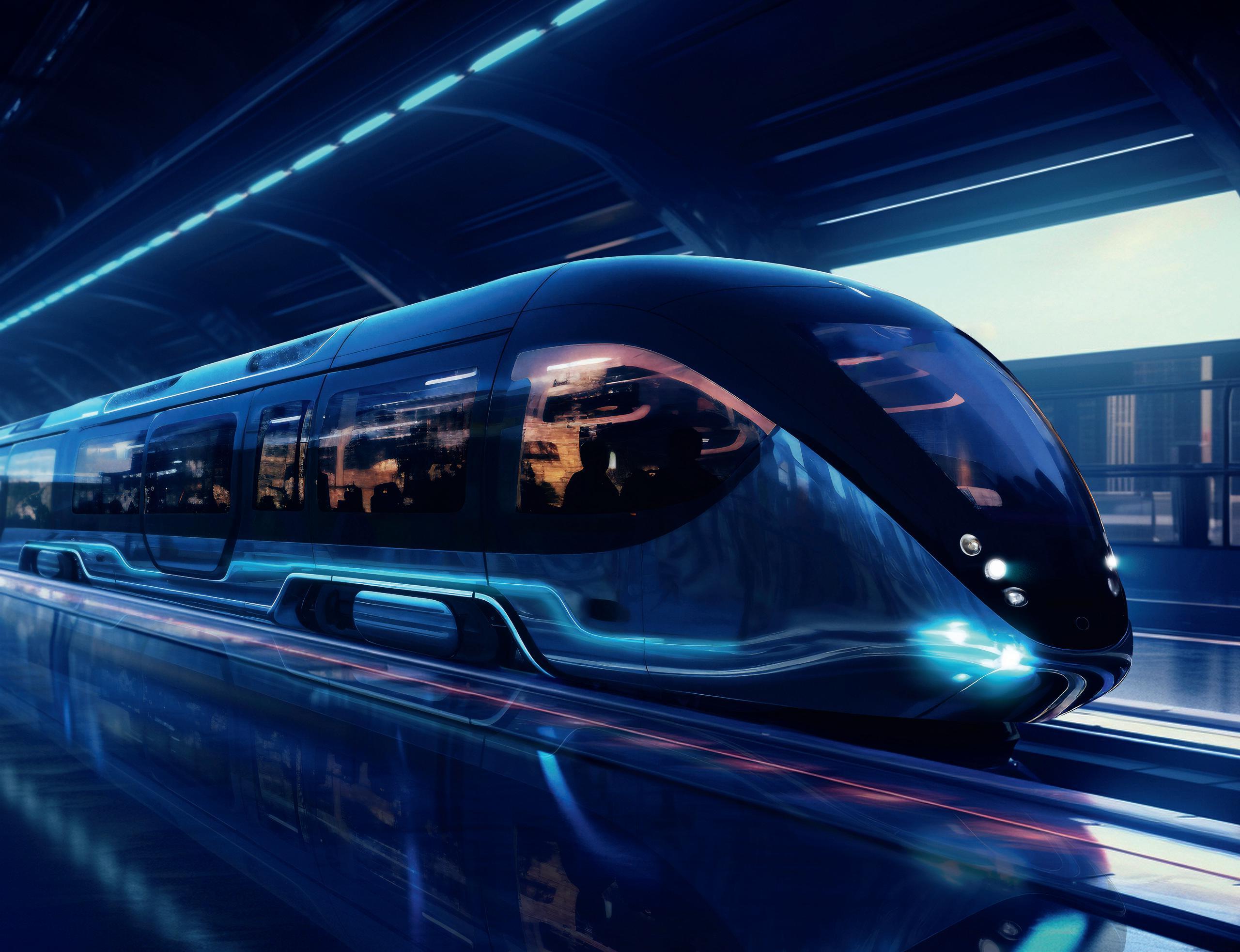


Dellner Glass Solutions is a part of the global Dellner Group, a worldleading, customer-oriented supplier of sustainable products and solutions across the transportation, material handling, wind, marine, oil and gas industries. Headquartered in Borlänge, Sweden, the Dellner Group boasts an annual turnover of more than EUR 200 million.
Our strategic approach focuses on designing, engineering, manufacturing, testing and supplying specialist glazing products, for example windscreens, cab-sides, body sides, headlights, framed aluminium windows, doors and fabrications for diverse markets, including transport, architectural, security, defence and domestic sectors. With state-of-the-art facilities in Consett, Luton and Tamworth, we are well-positioned to provide value-added solutions to our customers.
At Dellner Glass Solutions, sustainability is at the core of our operations. We are committed to minimising our environmental impact through innovative practices and sustainable manufacturing processes. Our manufacturing units underscore this commitment: the Tamworth site, dedicated to metal fabrication and assembly work, and the Consett site, which produces specialist glass products. Both sites are equipped to deliver complex, high-performance product assemblies for transport, architectural, security and military markets, all while adhering to sustainable practices.
The Tamworth manufacturing site features multiple CNC saws, CNC machining centres, forming machines, welding capabilities (EN 15085), sheet metal fabrication,
in-house wet and powder coating, a certified bonding area (DIN 6701-A1) and various assembly sections. These capabilities allow us to create a wide spectrum of products tailored to our customers' specifications, with sustainability integrated into every step.
Our Consett facility is equipped with toughening furnace, printing, lamination including clean rooms, multiple bending furnaces and autoclaves. We produce thousands of glazing systems annually, ranging from simple laminates to complex bends and curves, all while maintaining a focus on reducing our carbon footprint.
Our success relies not only on our comprehensive equipment and capabilities but also on the expertise and dedication of our employees. Many of them have devoted their careers to our business, bringing invaluable knowledge and passion to our mission. Together, we continually strive to be our customers' number one choice by delivering innovative, highquality and sustainable solutions.
www.dellnerglass.co.uk
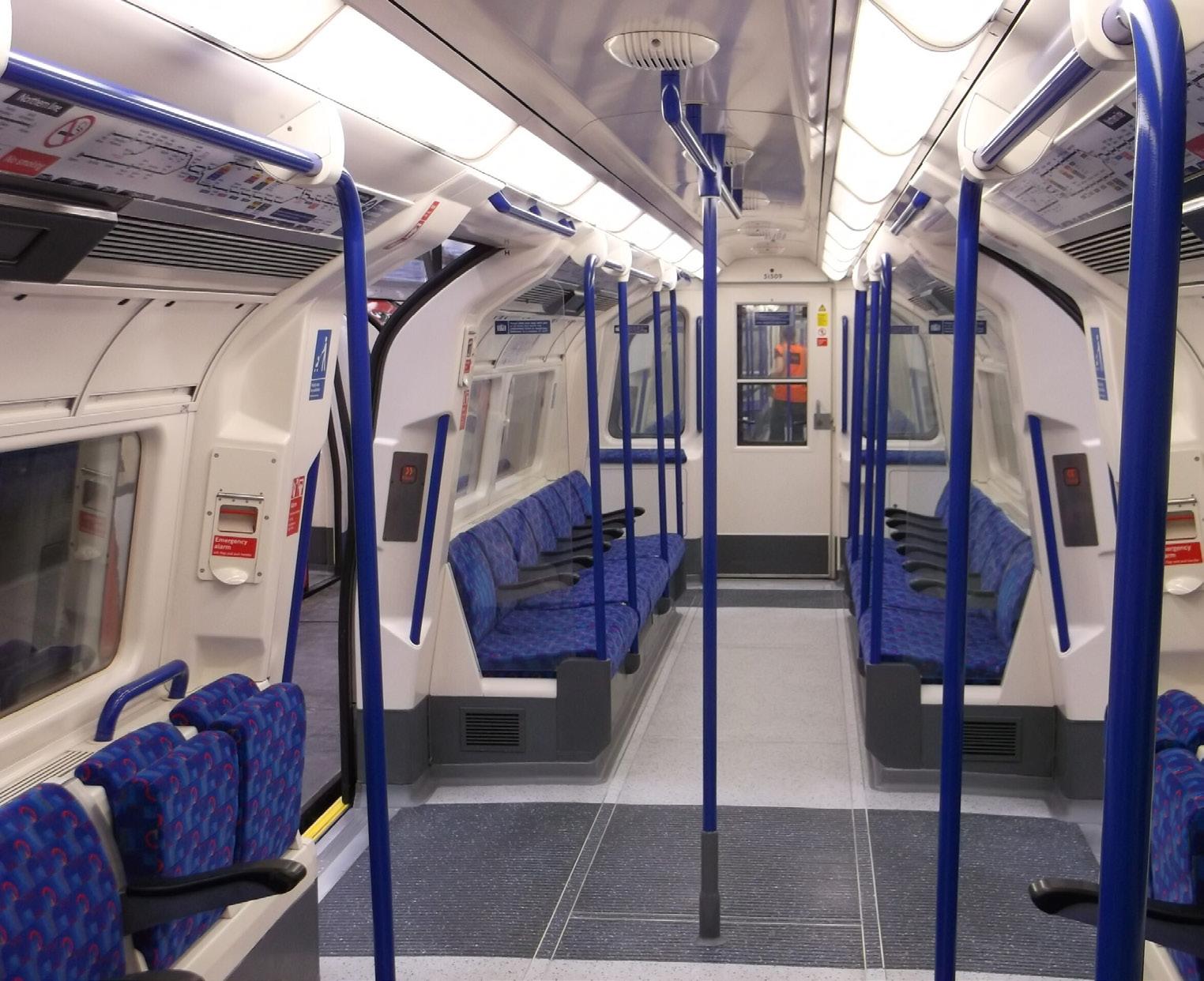

Dellner Glass Solutions is a glass and fabrication specialist for the added value to your product, project and processes with sustainable

High performance glass that goes the distance
Our offering for train exteriors includes:
Windscreens : with multiple heating and framing options, according to EN15152
Front and signal light glass : complex shapes with heating options
Cab side windows : complex shapes, coatings and multiple framing options
Body side windows : according to ISO 22752
Emergency doors and detrainment systems : customised according to customer requirements
Underframe components : Built to print manufacturing with EN15085 (CL2), DIN6701 (A1), powder and wet painting inhouse capabilities

E
T +44 (0) 1207 500000
www.dellnerglass.co.uk
the global transport, architectural and security markets. We create stainable industry leading engineering and manufacturing capabilities.

Our offering for train interiors includes:
Luggage racks : aluminium, glass with customised design
Grab poles : pre-assembled, with coating options (dip or powder coating)
Flooring systems: with heating and several material options
Partitions : glazed, aluminium, plywood, honeycomb core with several alternative surface materials and coatings
Structural and covering parts: Built to print manufacturing with EN15085 (CL2), DIN6701 (A1), powder and wet painting inhouse capabilities
Manual doors : doors for cabs, toilets, special areas (emergency exits, gangways)

Directory
Rolling Stock
J. LANFRANCO & Cie company offers a wide range of slotted self-locking nuts, ESL, ERM and THU, designed to meet the specific requirements of railway applications.
The ESL nut, J. LANFRANCO company’s flagship nut, allmetal and reusable, is present in a very large number of railway, passenger vehicle and track applications. The self-locking system is provided by the two overlapping slots, offset and opposite located on the upper part of the turret of the nut.
The THU is an all-metal, reusable hexagonal nut with two slots on the same plane in the turret. It is also available in low version (THM), offering flexibility of application according to specific constraints. Unlike other models, such as the ESL, which have slightly higher self-locking performance, the significant advantage of THU/THM is that it can be used without specific tools such as torque wrenches. This avoids dispersion due to human factors and ensures consistent performance even with used materials. The choice of nut depends on the specific constraints of each application.
The THU stands out for its ability to maintain its performance. It is particularly suitable for environments subject to extreme stresses, intense vibrations and variations in conditions as well as wear of equipment. This versatility is particularly advantageous for freight networks, where loads and speeds vary considerably in South America, North America and Australia.
The THU nut has proven its effectiveness in a variety of contexts, ranging from metro and TGV infrastructure to secondary freight networks around the world.
One of the main weaknesses of railway tracks is the joint bar, a key point where the robustness of the fasteners is crucial to ensure the safety and reliability of infrastructure. THU is a reliable solution for the most demanding track environments. Its design and ability to operate without torque accuracy make it an ideal choice for railway infrastructure and other applications under severe stress. We have chosen a constant evolution to meet the technical needs of our customers. We integrate normative updates, improve friction coefficients and select the nuts best suited to each assembly. By offering products that meet the expectations of our customers, while respecting the strictest standards, J. LANFRANCO & Cie continues to position itself as a leader in the railway industry of safety fasteners.

For more information visit our website www.lanfranco.fr/en or email commercial@lanfranco.fr
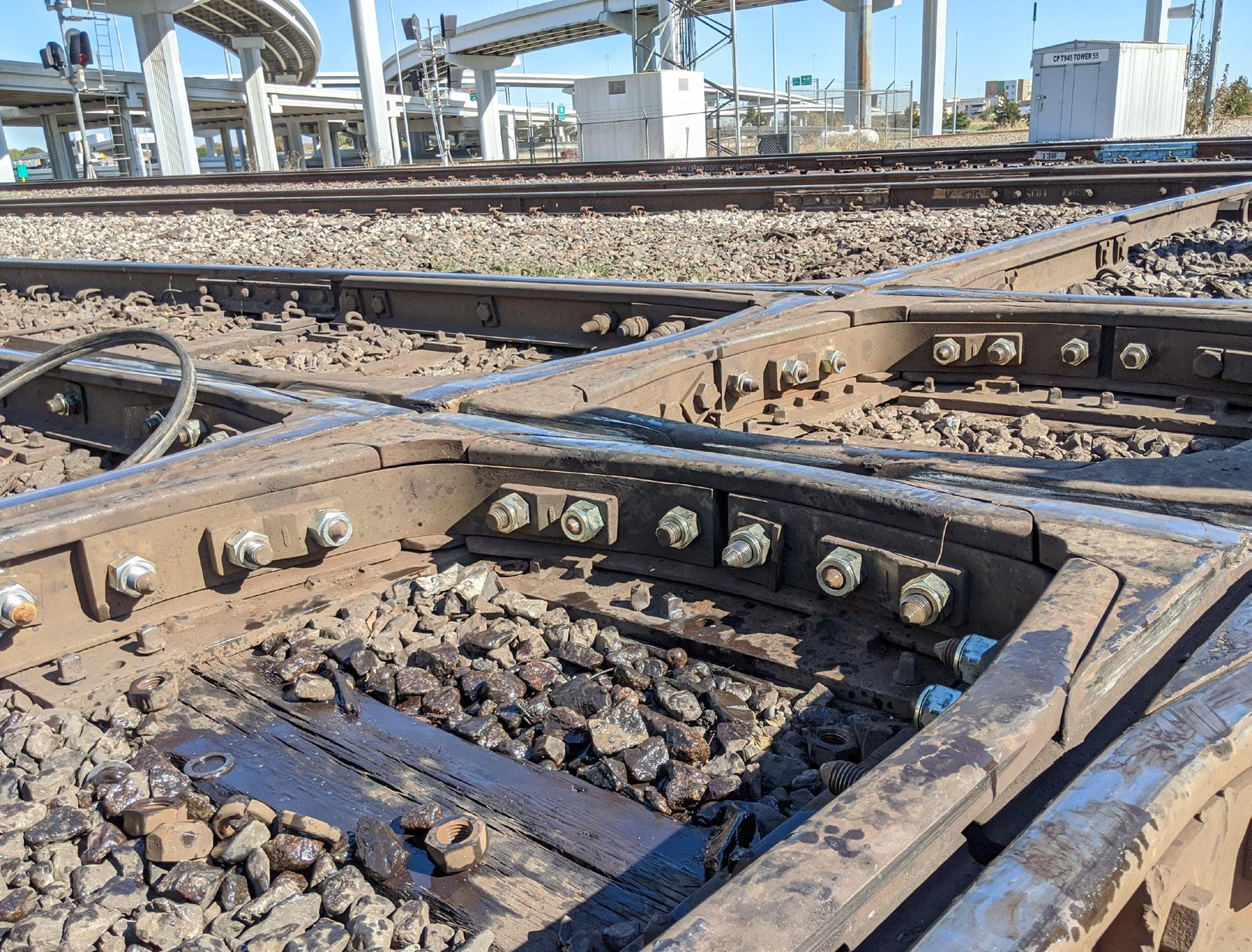

other mass transport vehicles
∙From one prototype to large series production
∙Gear manufacturing tradition since 1918
∙Complete drive train solution (gear units, couplings, traction motor, brakes)
∙Extensive test facility up to 1,4 MW and simulated dynamic load 300 m.s-2


Energy-efficient operation of rail vehicles reduces operating costs, which also applies to its components. BITZER, has always developed and optimised its products with a focus on energy efficiency. To further reduce energy costs, BITZER ECOLINE compressors can be equipped with mechanical capacity regulators, called VARISTEP, to improve the overall system efficiency. The VARISTEP capacity control is suitable for use with a variety of refrigerants, including HFC and HFO refrigerants and natural refrigerant such as R290 (propane) and R744 (CO2).
VARISTEP mechanical capacity control enables fine capacity adjustment for reciprocating compressors to effortlessly accommodate changing operating conditions. The extensive control range of around 25 to 100 per cent allows for outstanding full and part load efficiency and thus improves the efficiency of the entire air conditioning system. As a result, the annual operating costs associated with railway cooling and

air conditioning systems are much lower than with conventional systems featuring hot gas bypass control.
The following diagrams reveal significant seasonal energy savings, calculated on the basis of a typical air conditioning system in operation on a suburban train in Central Europe. The diagram compares two identical refrigerating circuits operated with R290 – one with VARISTEP and the other with hot gas bypass. Different cooling loads and operating hours were observed over a period of twelve months. Where part load operation is frequent, energy savings can be as high as 40 per cent for compressor operation alone.

Air conditioning components for rail vehicles for local and long-distance public transport must fulfil a unique set of demands. Space and weight constraints, efficiency and working life have a direct impact on investment and running costs as well as future compatibility. A decisive factor in this is also the choice of a futureproof refrigerant such as the hydrocarbon propane (R290). The new, ultra-light BITZER SPEEDLITE ELV52 scroll compressor is designed to address all these specific requirements, ensuring a high level of passenger comfort at all times.
As industrial countries worldwide are implementing ever stricter regulations on refrigerants with the EU F-Gas Regulation 2024/573 leading the way, substances with high global warming potential (GWP) are being phased down, becoming scarce and expensive. Furthermore, proposed restrictions on per- and polyfluoroalkyl substances (PFAS) are being drafted through the EU’s REACH chemical regulation. The specialist for refrigeration, air conditioning and heat pump technology BITZER has many years of experience in the field of natural refrigerants, offering a comprehensive portfolio of suitable components. Therefore, the compact, low-noise scroll compressor SPEEDLITE ELV52 for mobile applications was also developed for use with various refrigerants, including low-GWP refrigerants as well as the natural refrigerant propane (R290). As the world continues moving towards more sustainable solutions, the highly flammable hydrocarbon propane is proving to have a promising future in the railway sector. Increasingly more transport companies, for instance, already explicitly require the use of natural refrigerants for the vehicles in their urban areas. Propane is an attractive option due to its excellent thermodynamic properties and low environmental impact. Large temperature strokes are easily possible when compressing with this substance.
The BITZER SPEEDLITE ELV52 is a highly efficient compressor that offers an optimal cooling capacity to weight ratio. With its aluminium design, it weighs only 35kg, making it around 50% lighter than conventional compressors. This lightweight design reduces the roof

load and power consumption of vehicles, making it an excellent choice for air conditioning systems in railway vehicles. The SPEEDLITE ELV52 features a suction gascooled permanent magnet motor and offers a cooling capacity of 34kW (R290 @to 5°C; tc 50°C; Superheat 10K; Subcooling 0K).
Even under drastically changing operating conditions, the compressor demonstrates its efficiency due to its wide control range. Furthermore, a separate speed control adjusts its cooling capacity to the current cooling and heating load. This increases not only the efficiency of the SPEEDLITE ELV52, but also of the whole system, ensuring a stable temperature regulation inside the train – for maximum passenger comfort. Moreover, an integrated Economiser technology expands the application limits of the compressor significantly. The increase in efficiency thanks to the Economiser technology is particularly advantageous in heat pump operation, which is also possible with the SPEEDLITE ELV52. Compared to electric heating systems, heat pumps achieve much higher efficiency, further reduce operating costs and help to meet the requirements of global environmental regulations. Therefore, they will also be at home in the modern rail vehicles of the future.
For more information visit www.bitzer.de/gb/en
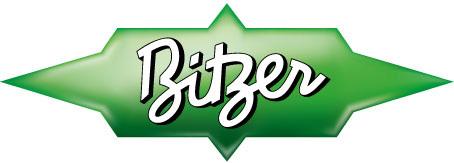
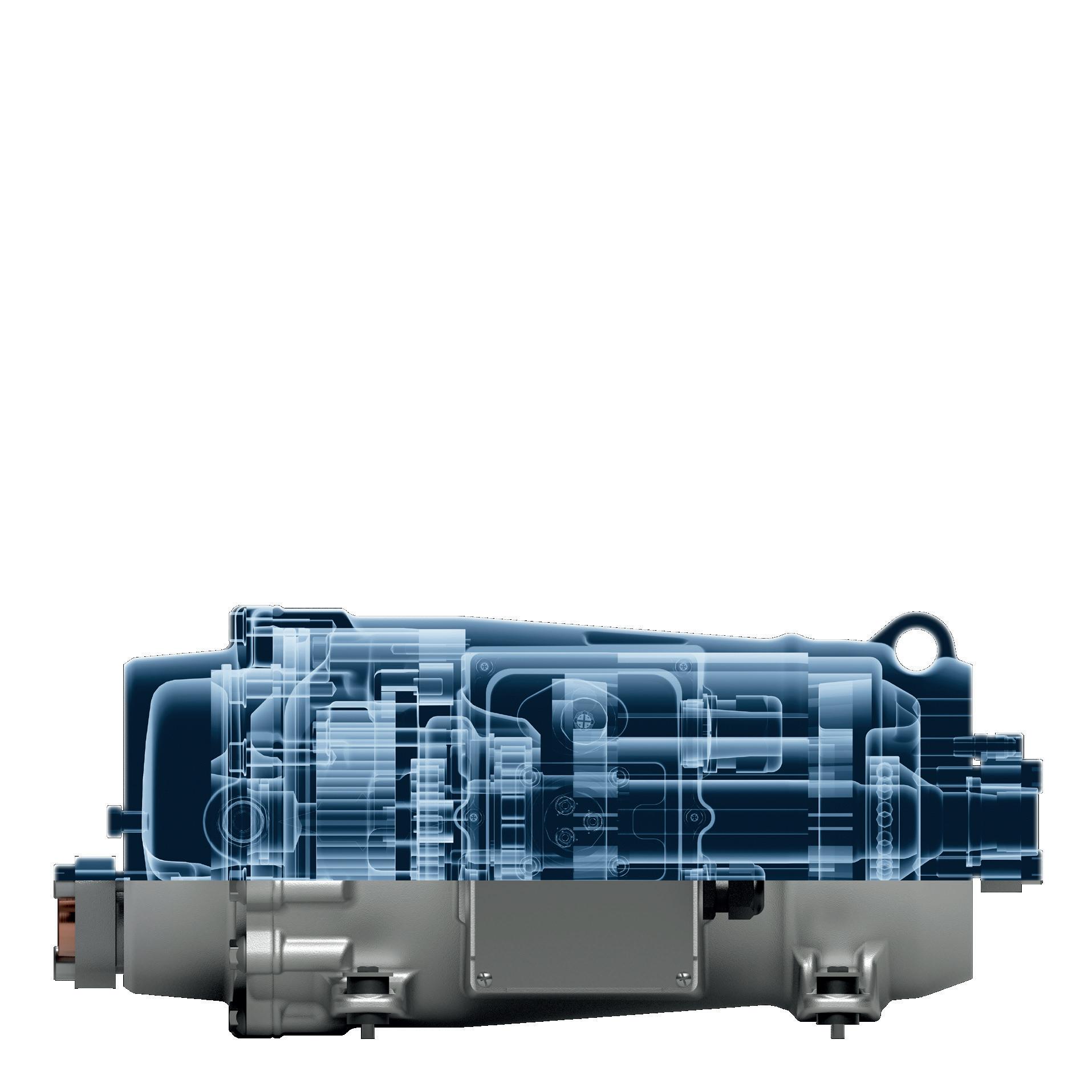



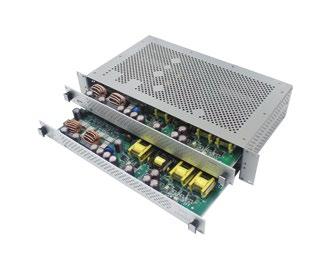


The evolution of power electronics in the railway industry has seen remarkable progress from its early days when power systems were primarily focused on basic traction lighting and signalling using 110VDC from onboard batteries.
Today, the integration of advanced power electronics is crucial for ensuring efficient and reliable railway operations, meeting the increasing demands for better passenger experiences, and maintaining high standards of safety and performance.
Initially, power systems in rolling stock applications were rudimentary, with onboard batteries providing power for traction lighting and basic signalling. These systems lacked reliability, requiring equipment to endure complete dropouts and surges. This inconsistency in operation posed significant challenges for railway operators.
The modern railway industry has transformed, with data monitoring and connectivity playing pivotal roles in detecting potential faults and resolving issues remotely. Rail vehicles now incorporate sophisticated electronics for communication and passenger amenities, necessitating efficient power conversion to ensure the smooth operation of all onboard devices.
Premium PSU, with over 40 years of experience in the railway sector, has been at the forefront of developing innovative high-power solutions designed for various railway applications, including trams, light rail, highspeed trains, subways, locomotives and onboard
equipment. Their commitment to flexibility and meeting stringent standards has made them a trusted name in the industry.
The big reveal of the newest power conversion systems from Premium PSU is set for the Innotrans exhibition (Hall 17 – Booth 425). Among the new products are:
• TDX-3300 & TDS-3300: These models feature a step-up converter stage ensuring exceptional stability in power output even amidst input voltage fluctuations. The TDX-3300 is ideal for powering electric motors and essential equipment, while the TDS-3300 provides stable voltage to passenger car sockets and locomotives.
• VDX-10K: A powerful and cost-effective solution for diesel-electric trains, the VDX-10K efficiently powers components like cooling fans for diesel engines without requiring a step-up converter.
• 40kW Three-Phase DC/AC Inverter: Designed for HVAC systems, this inverter includes a catenary filter and two independent output three-phase lines with VVF control and CAN Open communication, housed in a device weighing less than 60kg.
• Unmatched Output Stability: Ensuring reliability of onboard electronics and systems
• Enhanced Safety: Maintaining operational equipment during power disturbances
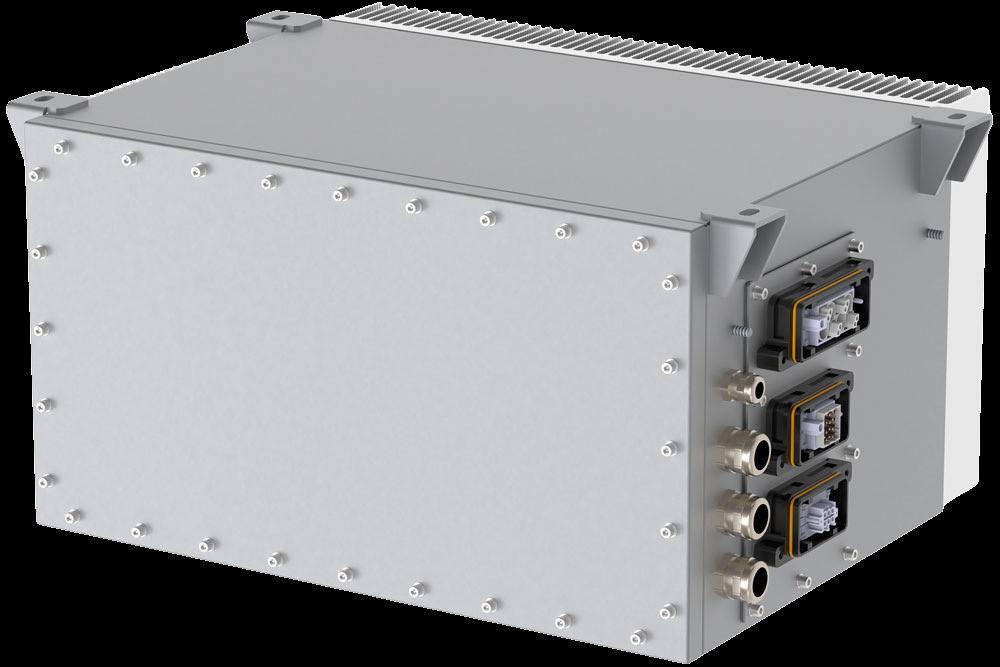
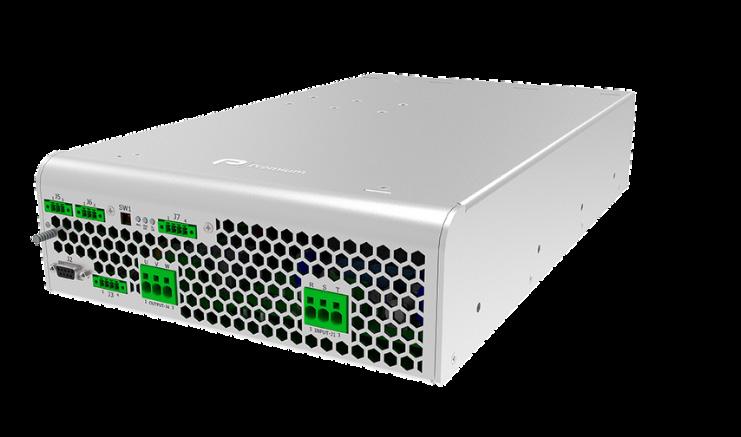
• Versatile Application: Suitable for a wide range of railway applications
• Operational Efficiency: Reducing wear and tear on motors, extending the lifespan of critical components
Premium PSU is proud to introduce a new AC/ DC battery charger with an IP65 protection rating, specifically designed to cover all three-phase nominal supply voltages on the market, i.e. 400VAC, 440VAC, and 480VAC, with a single product. Key features of this new battery charger include:
• Input Range: 360 to 528VAC
• Output Range: 16.8 to 30V and 250A, tailored for 24VDC NiCd batteries, specifically the NiCd 20 cells 220Ah SAFT SRX 220 FR or NiCd 20 cells 160Ah SAFT MRX 120
• Durability: IP65 protection rating, ensuring robust performance in harsh environments
In addition, Premium PSU plans to expand this range with a 10kW model for 110Vdc batteries soon.
The Spark Series includes solutions designed to draw
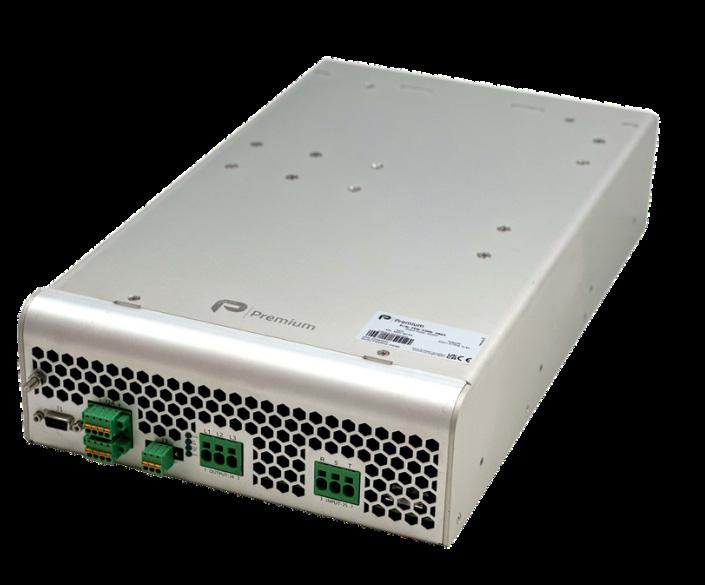
power directly from the catenary line. Key products in this series are:
• OVX-6400: A 6400VA three-phase sine wave DC/ AC inverter meeting EN612587-1 and EN50155 standards
• CVS-280 DC/DC Converter: Draws power directly from the line contact to start the vehicle
Premium PSU's commitment to innovation and engineering excellence continues to drive the evolution of power electronics in the railway industry. Their latest products highlight their dedication to providing efficient, reliable and cost-effective power solutions that meet the highest standards of safety and performance. As the railway industry evolves, Premium PSU's advanced power solutions play a crucial role in shaping the future of railway power management, ensuring smoother, safer and more efficient operations for railway operators worldwide.
For more information visit premiumpsu.com

RAILWAY MODULAR CONNECTORS
EvoTrak family
Simplifying and unifying your traction chain connections
Experience seamless connectivity across your entire traction chain with the EvoTrak family. Stäubli's compact and flexible modular solutions ensure a consistent connection philosophy.
Whether your application requires 1 to 4 poles, straight or angled design components or receptacles, EvoTrak is specifically configurable to meet your specific needs. In addition, EvoTrak not only meets all relevant standards but also undergoes rigorous testing beyond railway requirements, ensuring sustainable reliability.
Visit us at InnoTrans from September 24-27, 2024
Electrical Connectors | Hall 12, Booth 350
Fluid Connectors | Hall 10.2, Booth 200
www.staubli.com
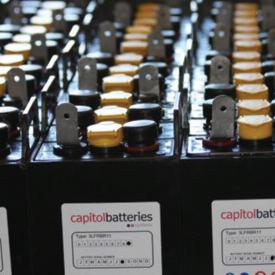
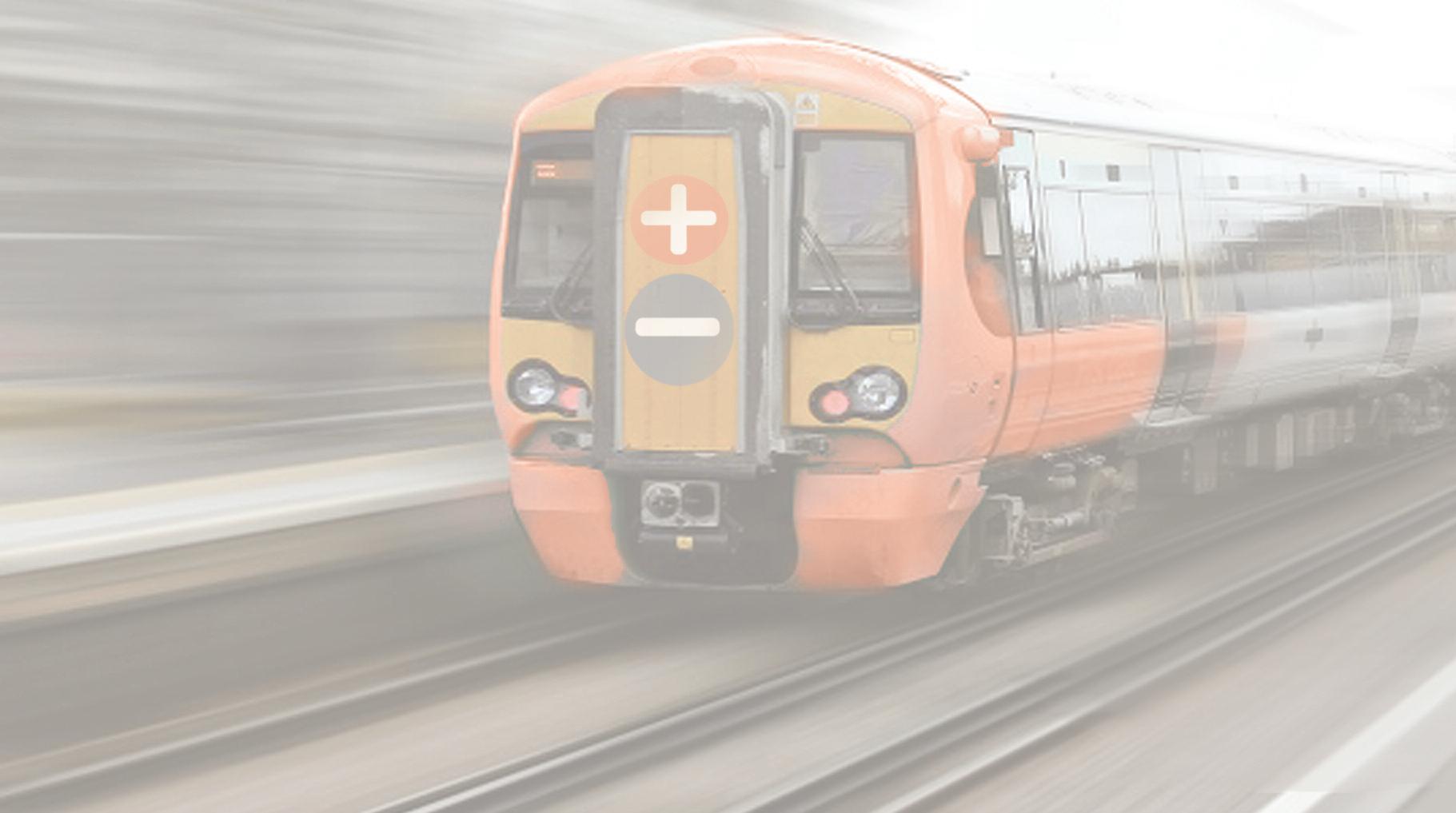
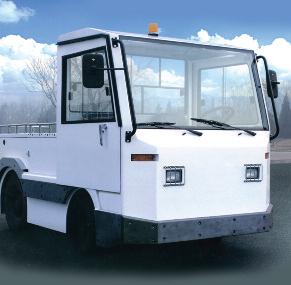

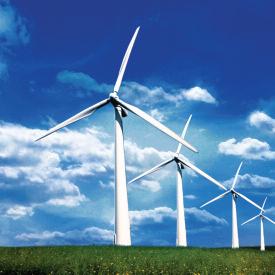

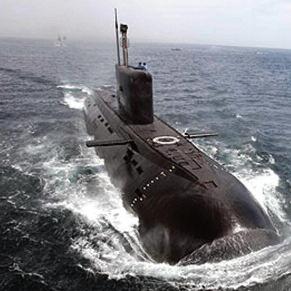
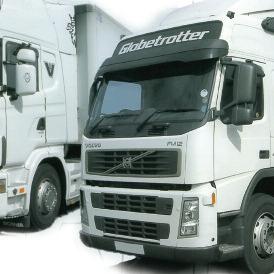

Whether you require batteries repaired, overhauled or replaced, Capitol are trusted and relied upon by a wide range of UK rail industry companies, who have come to know that we deliver on our promises to provide exacting standards of product, service, ongoing technical support and commitment in all aspects of our business dealings
An independent manufacturer with enough strength and flexibility to be able to support mainline customers requirements through stock availability and technical experience, we have consistently delivered on a wide variety of projects ranging from single battery orders, to fleet change out programmes set against customer schedules and agreed service levels
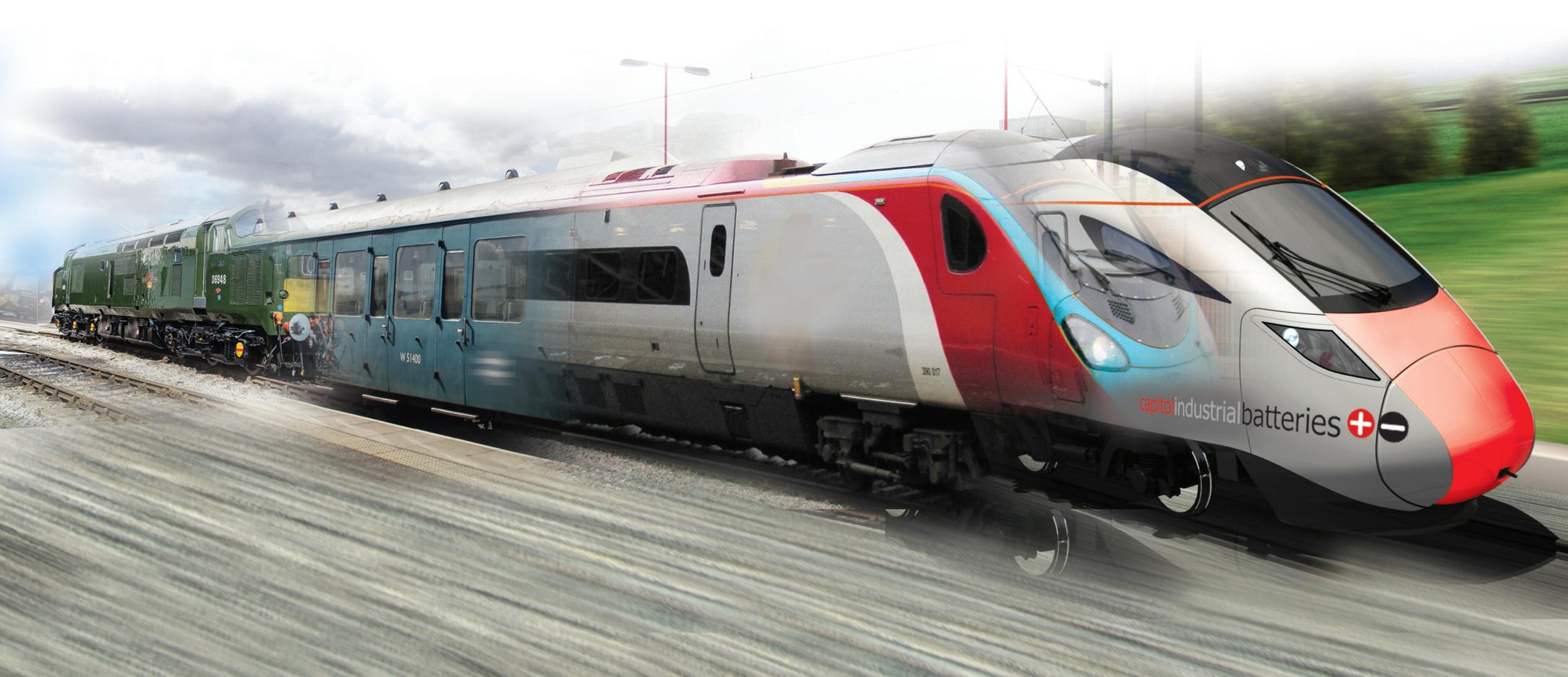

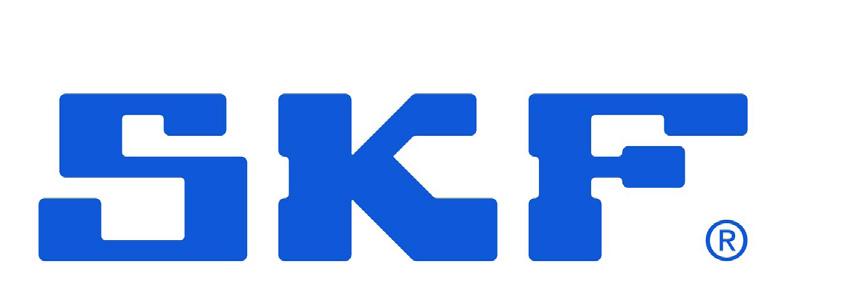
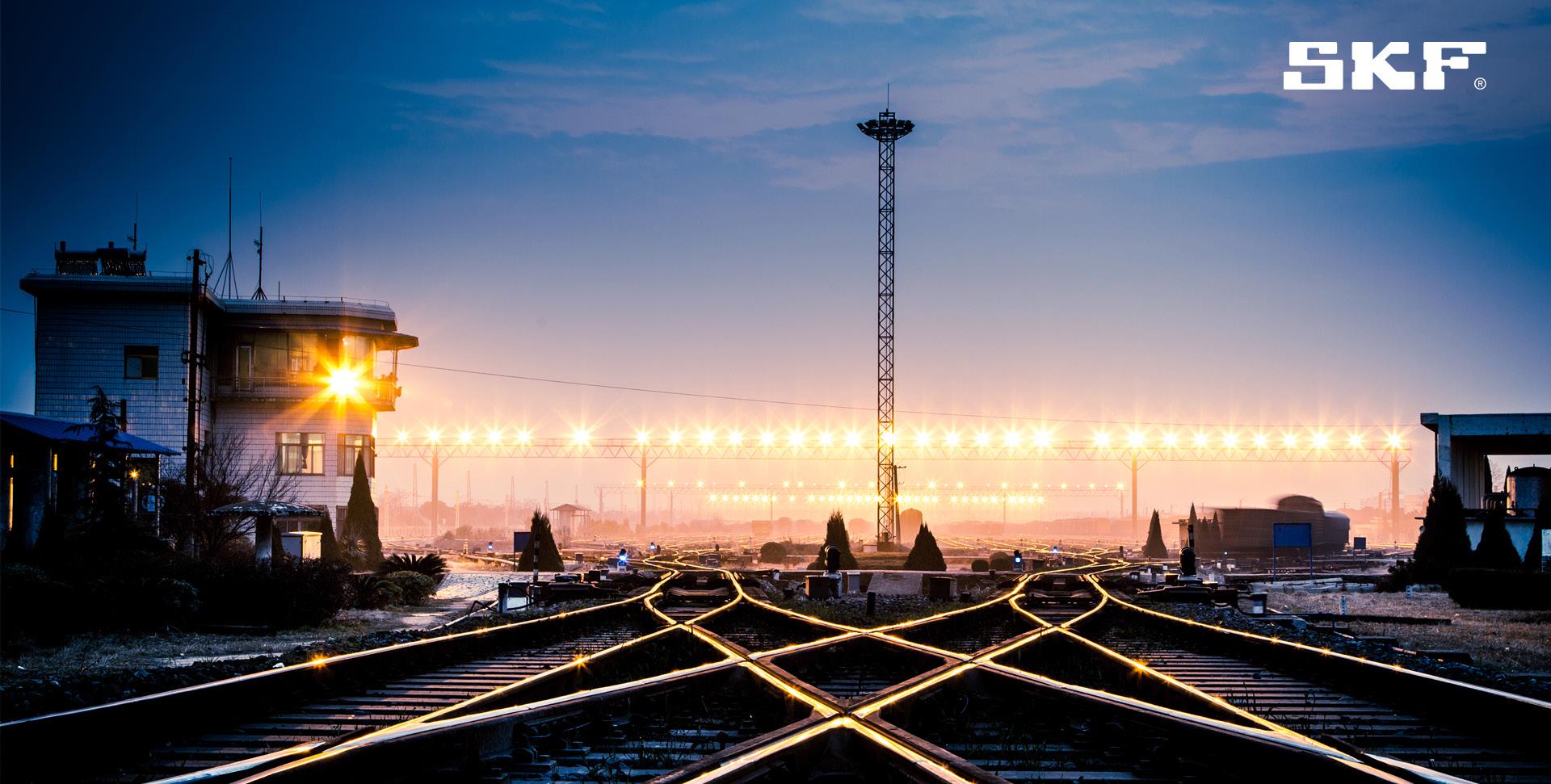
The railway industry has reached a junction in its journey to remain the most secure and sustainable mode of passenger and freight transportation.
To maintain its position, rail infrastructure must continually evolve, prioritising reliability, minimal maintenance and cost-efficiency. Here we reveal why engineering innovation, in particular, is crucial for enhancing the performance and durability of rail systems.
The global push for sustainability is reshaping industries worldwide, and railways are no exception. The UN Sustainable Development Goal 9 emphasises the importance of building resilient infrastructure, promoting inclusive and sustainable industrialisation
and fostering innovation. In the context of railways, this means updating outdated components to reduce environmental impact while increasing performance. SKF’s commitment to these goals – and the wider industry – is evident in the solutions developed through close collaboration with industry partners.
Recent statistics highlight a decline in train reliability, affecting both operators and passengers. According to Railway Technology, data from the Office of Rail and Road (ORR) showed that train reliability in the UK fell to
its lowest level in six years in the 12 months leading up to March 2023. When trains are delayed or cancelled, it’s not only a logistical issue. It can disrupt people’s lives and freight schedules. Passengers have to wait longer, make alternate plans, and deal with the frustration of unreliable service while freight operators face delays and increased costs. Enhancing train reliability is crucial for maintaining operational efficiency and passenger satisfaction. Solutions developed through close collaboration with customers are essential to address these challenges effectively.
Traditional bearing systems often require frequent maintenance, leading to operational downtime and increased costs. However, the introduction of advanced tapered roller bearings (TRBs) and cylindrical roller bearing units (CRUs) – to provide just two examples – is changing the landscape. These innovations are developed in response to customer feedback and the need for more efficient solutions.
For instance, the CRU for freight offers an extended maintenance interval of up to 12 million kilometres or 11–12 years. This significant improvement not only reduces maintenance frequency but also enhances the overall reliability of freight operations.
“Our partnership with freight operators has led to the development of bearing units that not only extend maintenance intervals but also significantly improve reliability.This has a direct impact on reducing downtime and operational costs.”
Enhanced performance with patented Xbite heat treatment and optimised raceway/roller contact geometry
even seen it, thanks to the piercing squeal that often accompanies it. Noise pollution remains a significant challenge for urban rail systems. Efforts to combat this issue are ongoing, with a leading operator claiming its “noise abatement infrastructure will grow by an average of 125 km a year, 25% more than in the past.”

SKF’s solutions portfolio for rail includes advanced noise monitoring and diagnostics that continuously track and manage noise levels, as well as onboard and wayside lubrication systems. These help operators to:
• Identify and manage potential issues before they escalate
• Reduce noise and vibration, improving the urban environment
• Support maintenance teams in planning and executing essential tasks, such as track regrinding
SKF range of tapered roller bearings are engineered to provide robustness and exceptional performance in rail applications. These bearings are highly customisable, allowing them to match specific speed, load, contamination, temperature or vibration conditions.
But it’s not only outdated bearings that can prevent operators from achieving optimal fleet performance. Improper lubrication, as well as infrastructural issues like rails that need regrinding or replacing, can affect trains as they glide (or in some cases scrape) along the tracks.
We’ve all heard an incoming tram or train before we’ve
Joining forces with our customers, SKF is committed to leading a charge towards a greener rail industry and works with customers and stakeholders to stay at the forefront of this transformation. We are prepared to achieve net-zero scope 1 and 2 emissions by 2030 and aim for scope 3 upstream emissions by 2050. Green steel will play a key role in this journey, and we recognize the significant work ahead.
For those interested in exploring these innovations further, SKF experts will be present at InnoTrans 2024, Hall 22 | 650, to discuss how these advanced solutions can enhance your railway operations. Click here to access a wealth of content created by industry experts.
For more information, contact skf@railways.com
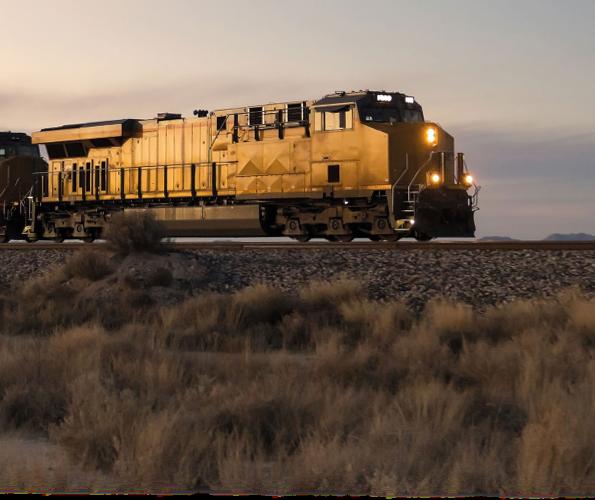
I n n o v a t i o n t h r i v e s
t h r o u g h c o l l a b o r a t i o n
Discover advanced rail solutions at InnoTrans 2024
At SKF, our longstanding expertise in the railway industry empowers us to anticipate and address your needs with precision. Through customerdriven innovation and expert partnerships, we deliver solutions that are safe, sustainable, robust, and now –driven by data
From our wide range of industrys
Meet the team at InnoTrans to explore
form your railway operations and

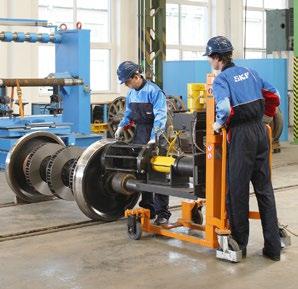
Visit Stand 650 in Hall 22 to learn more. For additional information, scan the QR code.


Focused on reliability and safety during both design and production, the Flender range of rail couplings ensures smooth travel for all rail vehicles.

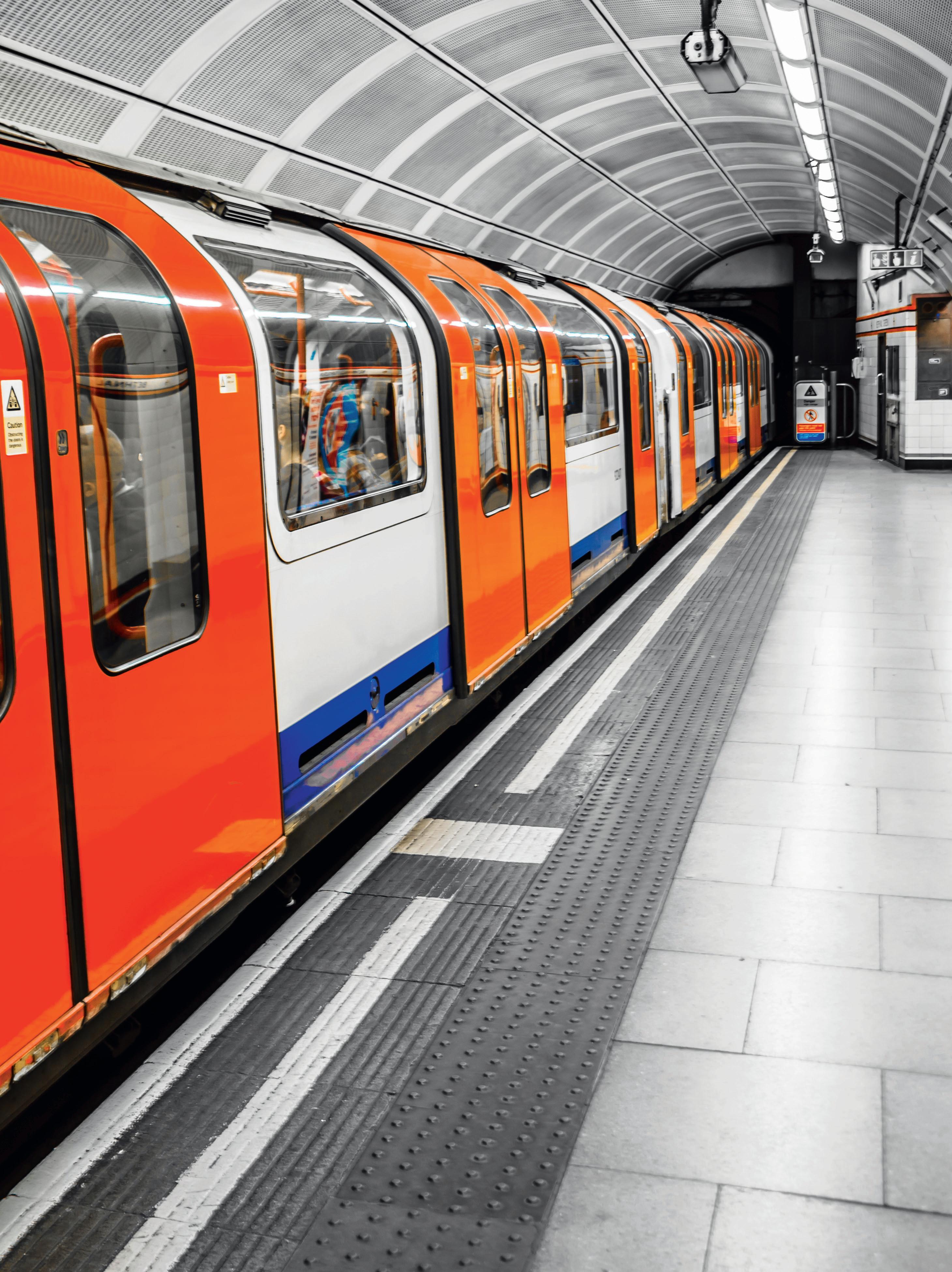

Operators of trams and low-floor trains frequently encounter a significant issue: bearing damage caused by stray currents.
These unwanted electrical passages within the gearbox are increasingly prevalent in metro and locomotive applications, leading to rapid wear of the gearbox bearings. A common component in these rail vehicles is the membrane coupling, which is deployed between the motor and the gearbox.
When electric current flows from one ring to another through the rolling elements of a bearing, substantial damage occurs. This process is comparable to arc welding, where high current density flows over a small contact area. The material heats up to extremely high temperatures, similar to tempering, hardening or even melting. This results in discoloured areas of varying sizes and eventually leads to the formation of craters where the material of the rolling element has melted and broken off due to rotation. The excess material on the rolling element wears down, causing craters in the raceways and rolling bodies.
Initially, the surfaces exhibit shallow craters that are closely spaced and have a small diameter, even at low current intensity. Over time, this can develop into a washboard pattern, visible on both the raceways and the ball bearings. The balls typically become dull and light to dark grey across their entire surface. The extent of the damage depends on several factors, including
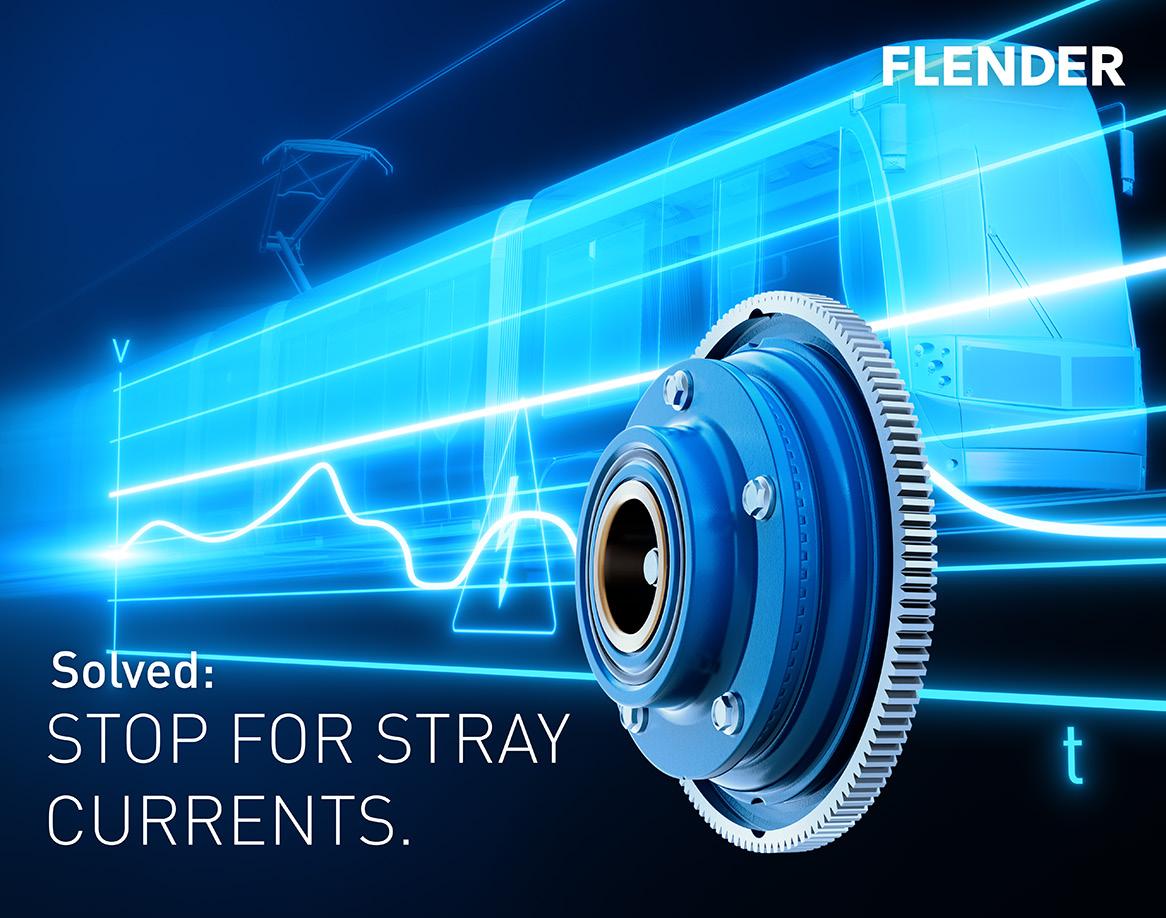
current strength, duration, bearing load, rotational speed and lubricant.
In cylindrical roller bearings, damage from stray currents eventually occurs as well, leading to a washboard surface on the raceways and rollers. The grease in the cage pockets gradually carbonises, loses its lubricating capability and results in surface fatigue, spalling and ultimately sudden seizing.
Flender offers an effective solution to this problem with its insulated couplings, particularly the membrane coupling series MBG. These steel membrane couplings consist of two coupling halves connected by an

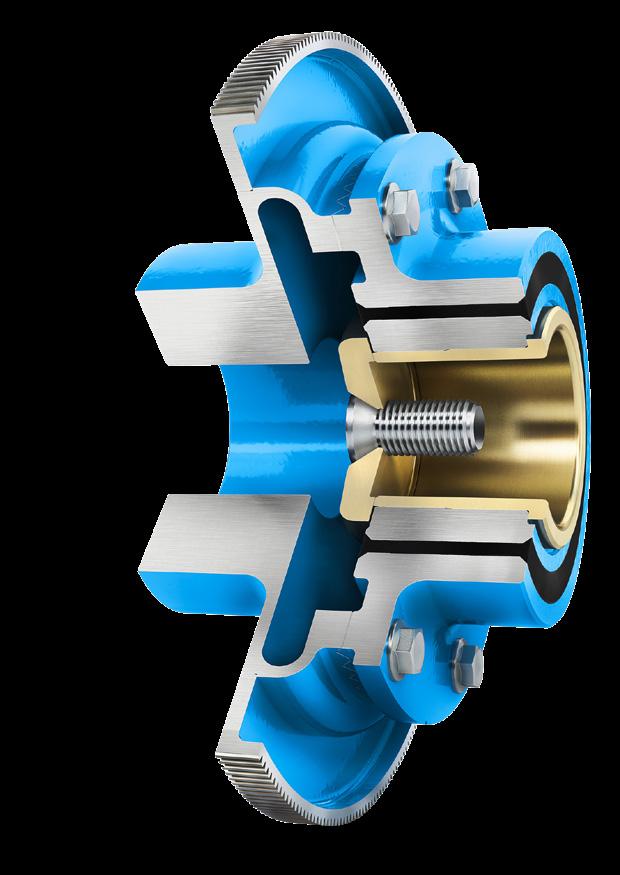
optimised, self-centering face gear. The torque is transmitted via the face gear. Thanks to optimised manufacturing, the membrane couplings provide very high concentricity, which is maintained even after reassembly. Typically, the couplings are balanced together with the rotor of the motor to minimise additional assembly influences.
Electrical decoupling is achieved by integrating insulation within the gearbox-side coupling half, without the need for additional components. The installation of the insulated MBG on the drive is similar to standard membrane couplings and retrofitting existing drives with an electrically insulating coupling

is also possible. Additionally, options such as a slip hub and a speed sensor are available.
In metros with semi-suspended drives, Flender's gear couplings of the ZBG series are utilised. The reason: the high offset between motor and gearbox, rapid acceleration, short braking distances and minute-byminute stops subject tunnel trains to extreme stresses. Upon request, Flender also supplies the ZBG gear coupling with electrical insulation. This insulation is directly integrated into the coupling, eliminating the need for additional components or interfaces. This removes the need for extra alignment work, simplifying installation and maintenance.
The well-known advantages of the Flender ZBG couplings are fully preserved in efficient rail operations. The ZBG couplings are characterised by their high performance and reliability, making them ideal for demanding metro applications. They ensure reliable torque transmission and contribute to extending the lifespan of gearbox bearings by effectively solving the problem of stray currents.
With Flender's innovative coupling solution, operators of trams, low-floor trains and metros can ensure their vehicles operate smoothly and efficiently at all times. The insulating MBG and ZBG couplings provide a sustainable solution to prevent bearing damage caused by stray currents, thus significantly reducing maintenance efforts and operating costs and improving fleet availability.

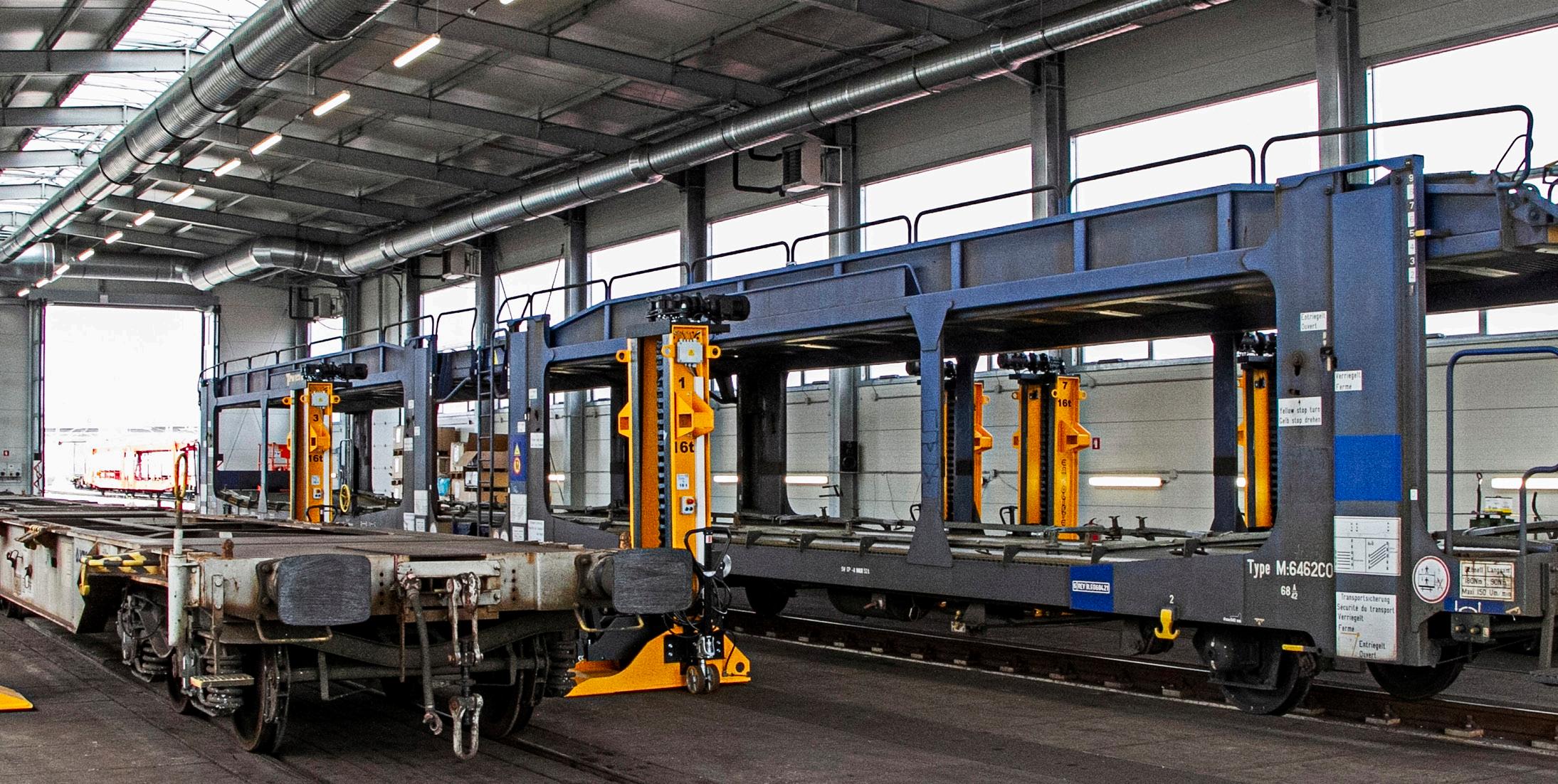
After liberalisation of the rail market in Europe, competition has been growing steadily with train operating companies, rolling stock owners and logistics businesses entering the market for rail freight and fleet maintenance services.
A number of new rail freight carriers and fleet owners, who rent out rolling stock to transport businesses without a fleet or with limited fleet capacity, have entered the rail market in Slovenia, also.
For cargo to reach its destination on time, every unit making up the train must be in good condition. To keep your stock fit to run, a combination of preventive maintenance, heavy repairs at our workshops and onsite light repairs is needed. At VIT, we recognise the
need for technical assistance in freight wagon servicing and locomotive maintenance. Having more than 170 years’ experience with Slovenske železnice's fleet, we offer complete repair services – from inspections to heavy repairs.
Our services are supplied from a number of locations on the network, focusing on the busiest sections. Freight wagons are serviced at our workshops in Koper, Divača, Zalog, Dobova, Ptuj and Tezno, while the engine shops at Divača, Maribor and Ljubljana are specialised in the maintenance of diesel and electrical locomotives. Light repairs to restore a wagon’s fitness to run can be done on-site without the need to break up the train, while heavy repairs and overhauls are carried out at our depot in Dobova, and in Ljubljana and Maribor for electrical and diesel locomotives, respectively. We also have a specialist team of technicians for wheelset

maintenance, which is delivered at our depot in Ptuj. Our workshops are fully ECM certified, with the Ptuj and Dobova depots also certified to VPI.
Services supplied at depots vary by wagon type, service life, designated loads and type of unloading and shunting. We offer everything from brake system repairs and brake block replacements to repairs of damaged axles and other components such as footsteps, side walls, tank wagon valves and body cracks. Each case is handled individually, with repairs assessed together with the client after inspecting the vehicle. We have experience working with a wide range of different wagon series and types, including tank wagons (except gas cars), and have an in-house accredited inspection body for pressurised equipment, which conducts pressure tests on tank wagons according to RID regulations.
Next to inspections and repairs, rolling stock also requires regular overhauls to stay in running order. Our depot in Dobova specialises in overhauls according to the VPI or other maintenance rules provided by the client. We work for established rolling stock owners and know that trust is vital in our line of business. To demonstrate the quality of our services, our shops hold up-to-date certifications in welding, non-destructive testing, inspections of pressurised equipment and ECM.
Our specialist team of technicians performs maintenance on a range of different locomotives, in particular on Siemens, Alstom, General Motors, Macosa,
Đuro Đaković, Vossloh and CZ Loko. New generations of electrical locomotives we handle the most are Siemens Taurus and Vectron, which are typically used in Europe. We offer complete maintenance for Taurus locs, ranging from inspections and repairs to overhauls, while mostly focusing on inspections when it comes to the newest Vectron multisystem electrical locomotives.
After modernising our equipment and gaining enough experience, we were able to add overhauls of ES 64 F4 to our services. In diesel traction, we do inspections of Siemens Hercules (ER20), Vossloh G6 and CZ Loko EffiShunter shunters. Locomotives aside, we also provide checks of cab radios and fire extinguishers and wheelset reprofiling without dismounting.
We continuously build on our existing knowledge and design new solutions to best respond to market demand. Our wheelset maintenance shop at Ptuj does monobloc wheel replacements on powered wheelsets for ES 64 U4, which are inspected to replace any lifeexpired or damaged components and shrink fit new monobloc wheels. There are also plans to offer this service for other types of electrical locomotives.
Because many locomotive operators prefer to refurbish existing units, we go the extra mile when it comes to older rolling stock – especially diesel units – and offer retrofit programmes purposely designed to extend the serviceable life of components. Locomotives can be modernised or completely refurbished and supplied with new technology diesel engines.
Internationally we are best known for our wheelset maintenance and production, which is supplied across Europe. Our depot in Ptuj specialises in assembly and off-vehicle reprofiling of wheelsets, be it for freight wagons or the latest series of electrical locomotives. While most wheelsets are machined according to VPI (IL, IS0, IS1, IS2 and IS3), there has been a growing demand to produce new wheelsets in line with TSI (BA 303, BA 314, ULT23 and ULT25). We also do maintenance on tyred wheelsets.







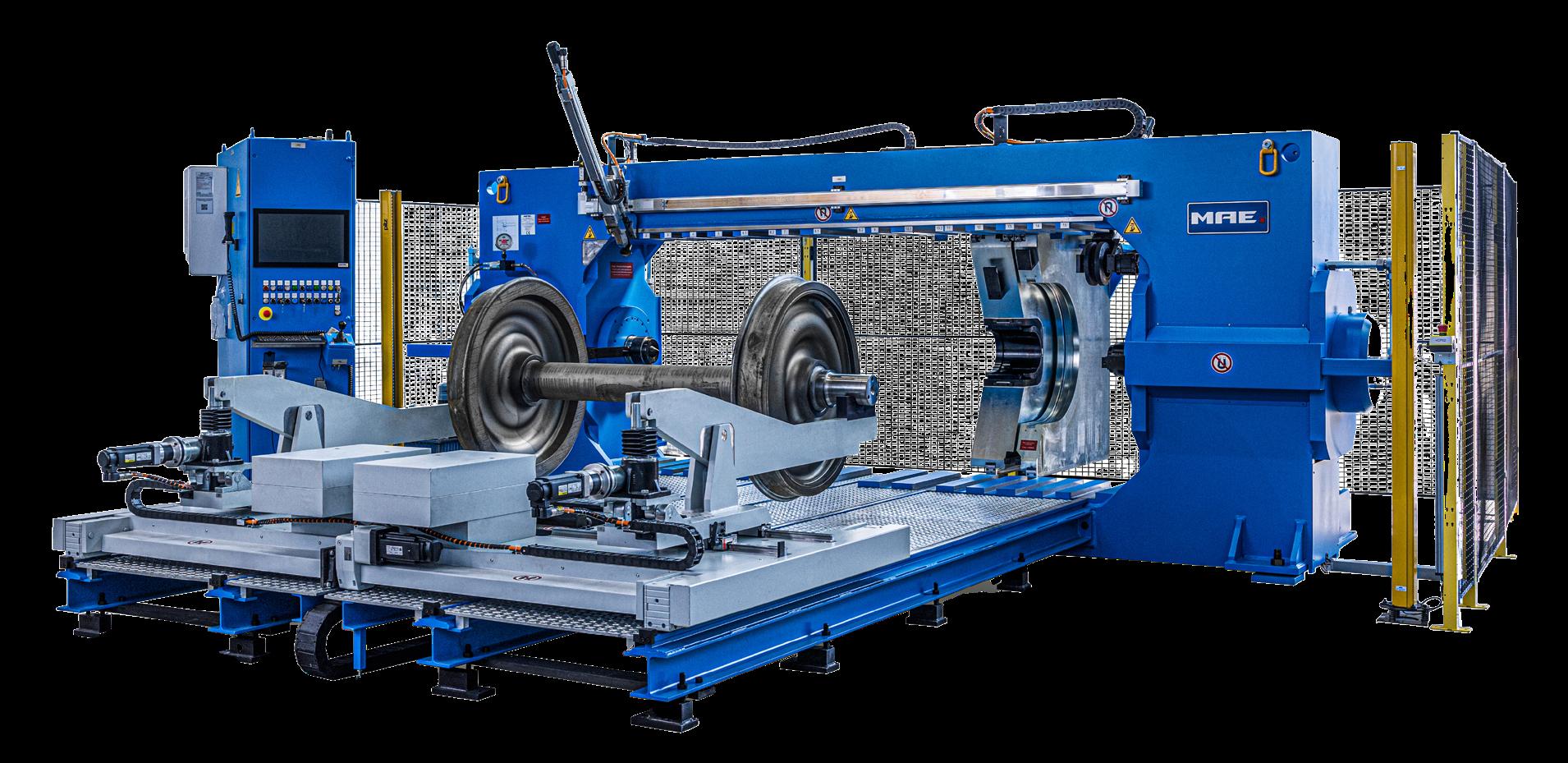
The world of rail transport faces enormous challenges and opportunities. Particularly in high-speed and urban rail transport, the demands for reliability, efficiency and sustainability have significantly increased. A crucial factor in this area is the maintenance and servicing of wheelsets.
This is where MAE. Group's innovative double-cylinder wheelset press comes into play, setting new standards with its patented hydraulic concept.
Wheelsets are the heart of every rail vehicle, whether it is a high-speed train or a subway. They not only carry the entire weight of the vehicle but are also exposed
to extreme stresses. Precise and safe pressing of the wheelsets is therefore essential to ensure smooth and safe operation.
In high-speed rail transport, where trains travel at speeds exceeding 300km/h, wheelsets must be manufactured and maintained with the utmost precision. Any irregularity can lead to significant safety risks. Similarly, in urban rail transport, where trains frequently stop and accelerate, the wheelsets are subject to enormous stresses. Regular maintenance and servicing are crucial here to avoid failures and extend the lifespan of the vehicles.
MAE. Group has developed a solution with its double-cylinder wheelset press that offers numerous
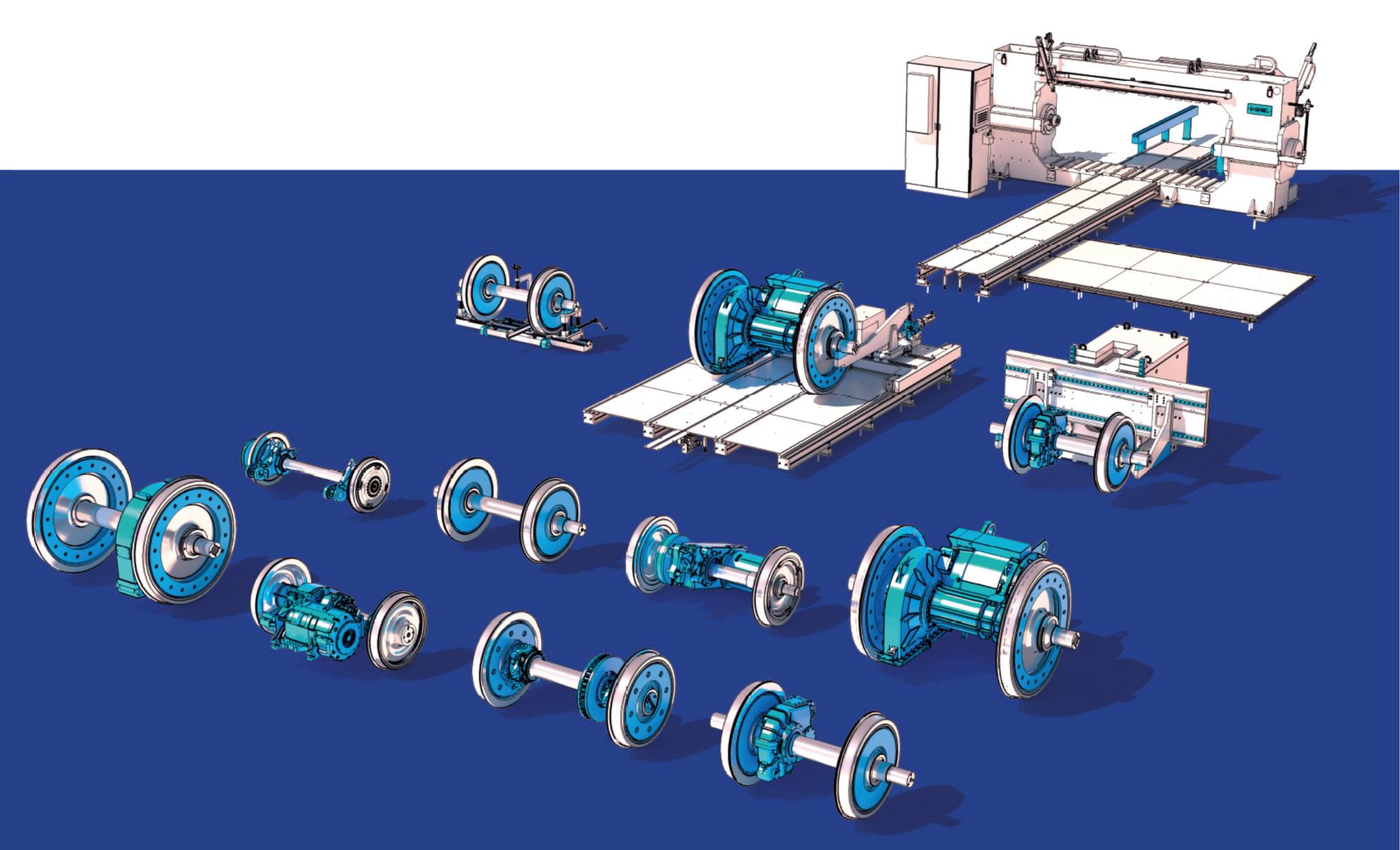
advantages for users, particularly transport companies and maintenance businesses. Here are some of the outstanding benefits in detail:
MAE. Group's wheelset presses are particularly energyefficient due to their unique hydraulic concept, which only consumes energy when the cylinders of the press are moving. The patented system significantly reduces energy consumption and needs less oil – the oil tank’s size is only one third compared to similar machines and the oil lifetime is up to three times longer, which not only lowers operating costs but also makes a substantial contribution to sustainability. One single pressing operation requires less energy than boiling water for a cup of tea. As a result, transport companies can better achieve their environmental goals and improve their carbon footprint.
Thanks to the double-cylinder technology, the wheelsets can be pressed with the highest precision in a single clamping without having the need to turn the wheelset as it is needed when using single-cylinder
presses. This ensures an optimal fit and minimises the risk of malfunctions. For all trains, this means increased safety, higher reliability and reduced downtime.
The precise processing of the wheelsets leads to a longer lifespan of the components. This means less frequent maintenance intervals and thus reduced maintenance costs, which is further supported by the press’s ability to completely measure the assembled wheelset after pressing. The investment in a doublecylinder wheelset press from MAE. Group quickly pays off through savings in servicing as well as through savings for no longer needed external measuring machines. Further savings can be materialised by the fact that MAE. wheelset presses do not require a separate foundation as they can simply be placed on the floor.
MAE. Group places great emphasis on operator safety. The double-cylinder wheelset press is equipped with numerous safety features that minimise the risk of accidents. Fully automated processes and ergonomic design features significantly improve workplace safety.
The wheelset presses are versatile and can be adapted to different types and sizes of wheelsets. This makes them particularly attractive for transport companies with a wide variety of vehicle types in their fleet. The flexibility of the machine allows for quick responses to different requirements, making operations more efficient.
The advanced design of the double-cylinder wheelset press allows for faster cycle times and higher throughput. This means that more wheelsets can be processed in a shorter amount of time, increasing the overall operational efficiency of maintenance facilities. This efficiency gain translates into better resource utilisation and higher productivity.
The MAE. Group’s wheelset presses are equipped with state-of-the-art control systems that are user-friendly and intuitive. This reduces the learning curve for operators and ensures that the press can be operated with minimal training. The advanced controls also provide real-time monitoring and diagnostics, further enhancing the maintenance and troubleshooting processes.
MAE. Group is committed to making rail transport not only more efficient but also more sustainable. The patented hydraulic concept of the double-cylinder
wheelset press plays a central role in this. By reducing energy consumption and extending the lifespan of the wheelsets, resource consumption is minimised. This is an important step towards reducing the environmental impact of rail transport and contributing to climate protection.
MAE. Group's double-cylinder wheelset presses are a prime example of how innovative technology can make rail transport more efficient and sustainable. They offer numerous advantages for transport companies, from energy efficiency and high precision to reduced maintenance costs and improved workplace safety. By optimising maintenance and extending the lifespan of wheelsets, they make a crucial contribution to making rail transport future-proof. At a time when sustainability and efficiency are more important than ever, MAE. Group's solutions are a vital building block for the mobility of tomorrow.
If you would like to learn more about MAE.’s wheelset presses and their advantageous technology you will have the opportunity to meet the team of MAE. Group at this year’s InnoTrans in Berlin, from 24–27 September 2024. Stop by and visit the MAE booth in Hall 23, Number 750.
For more information visit www.mae-group.com/en/
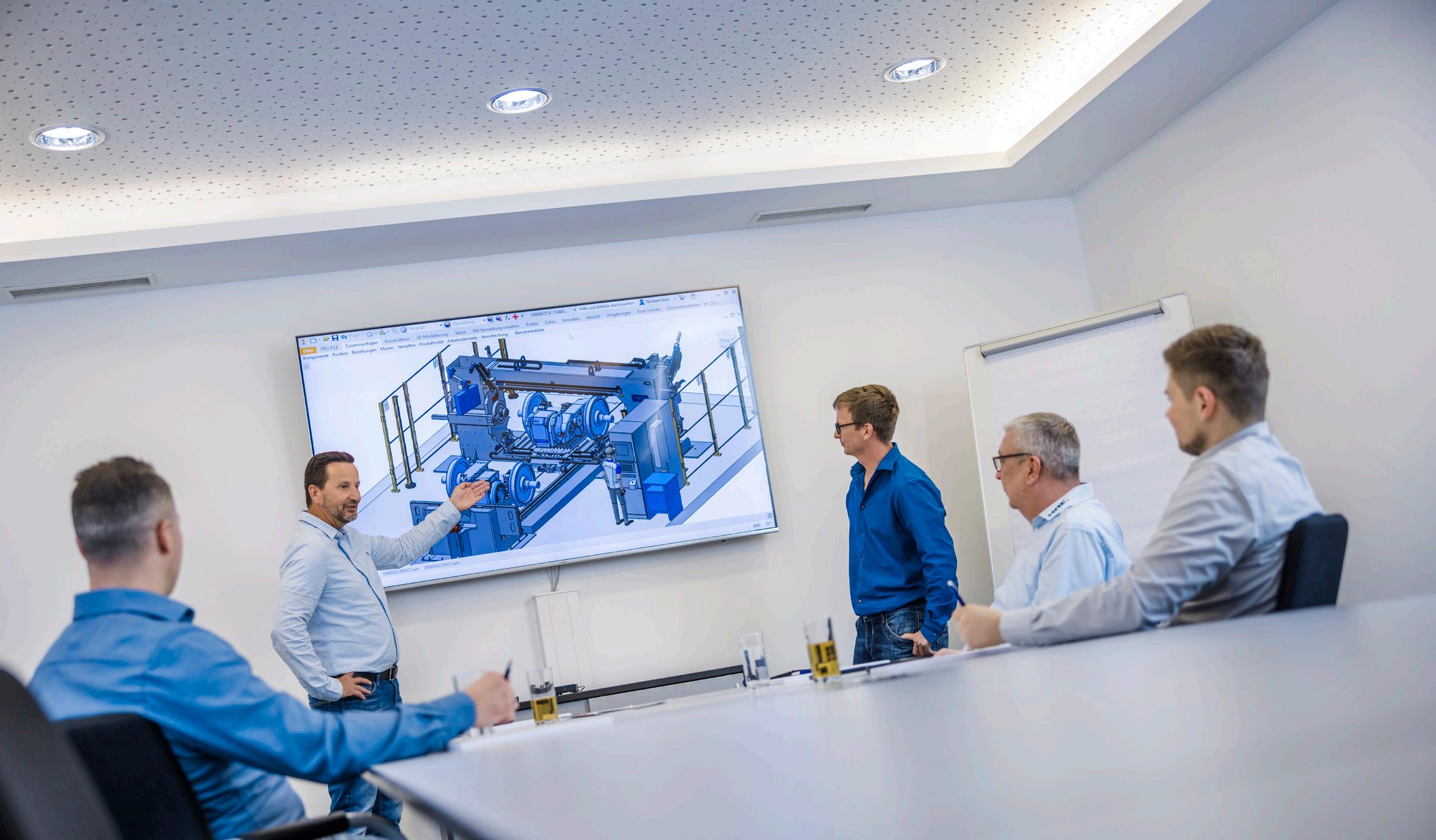

Directory Rolling Stock

1. Enhanced Passenger Confidence:
When passengers know that their safety is a top priority, they gain confidence in using tram, metro and commuter trains. Our Fire Curtain system fosters trust, encouraging ridership and improving public perception.
2. Rapid Fire Containment:
In the event of a fire, every second counts. Our Fire Curtain system deploys rapidly, instantly isolating the affected area, preventing the spread of flames, smoke* and toxic gases*, and allowing passengers to evacuate safely.
3. Life-Saving Efficiency:
With our Fire Curtain in place, evacuation procedures become more organised and efficient. Passengers and crew can evacuate calmly and swiftly, reducing the risk of panic and injury.
4. Compliance with Regulations:
Our Fire Curtain solutions are designed to meet and exceed stringent safety regulations, ensuring that your metro or commuter trains are fully compliant with industry standards.
5. Cost-Efficient Solution:
Investing in Fire Curtains is a cost-effective way to enhance safety. They require minimal maintenance and can be integrated seamlessly into existing train systems, new build or refurbishment.
* subject to surrounding train body structures
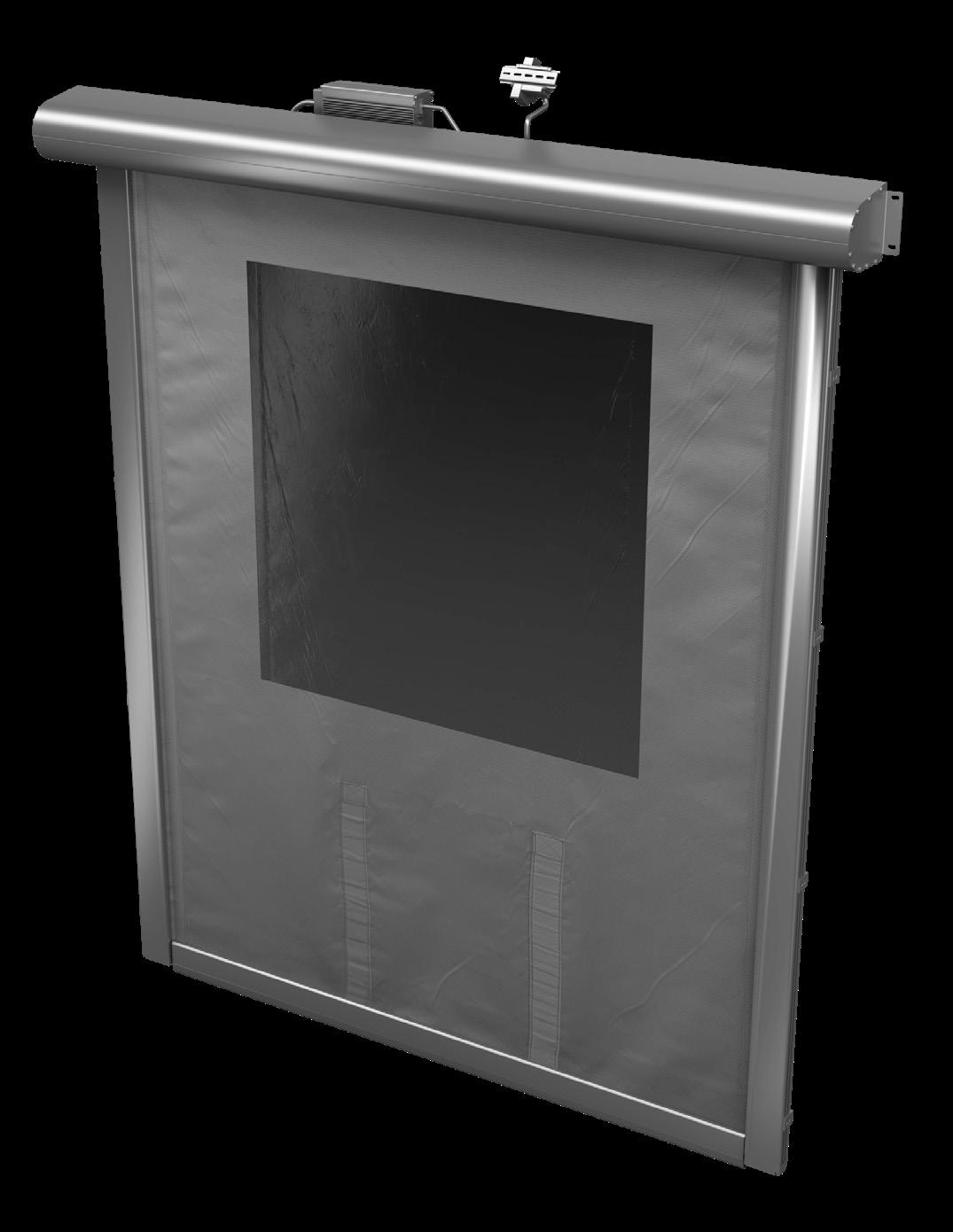
6. Versatile Applications:
Our Fire Curtains can be customised to fit various train configurations and layouts, making them suitable for a wide range of tram, metro and commuter train designs.
7. Minimal Disruption:
The Fire Curtain takes up minimal space, ensuring that emergency exits remain unobstructed. This allows for smoother evacuations and quicker response times for emergency personnel.
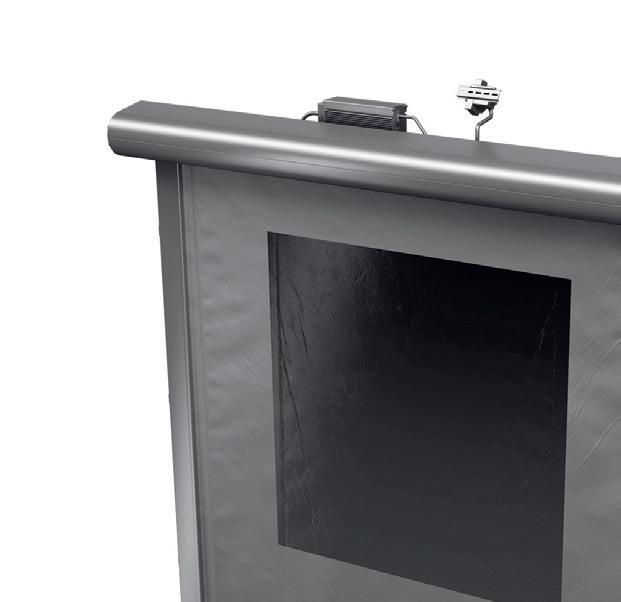
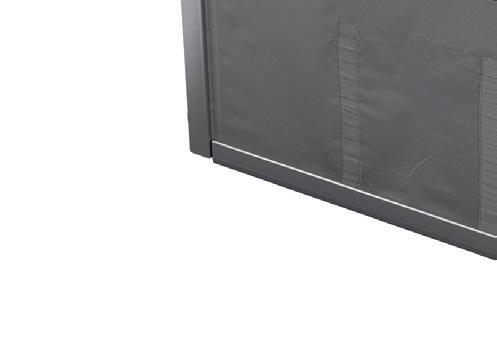
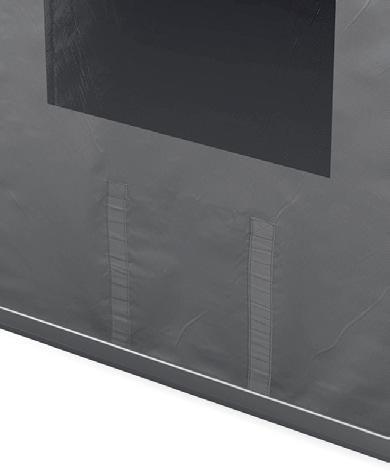

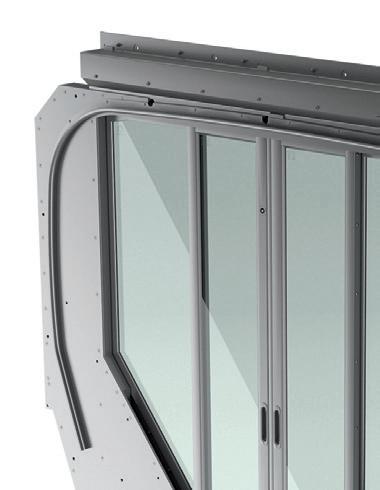
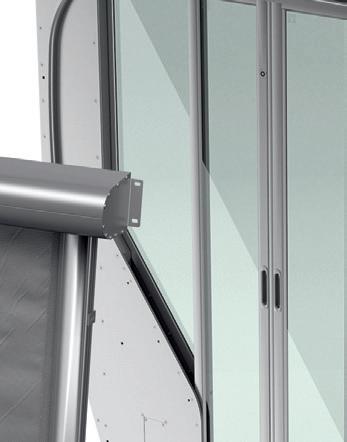
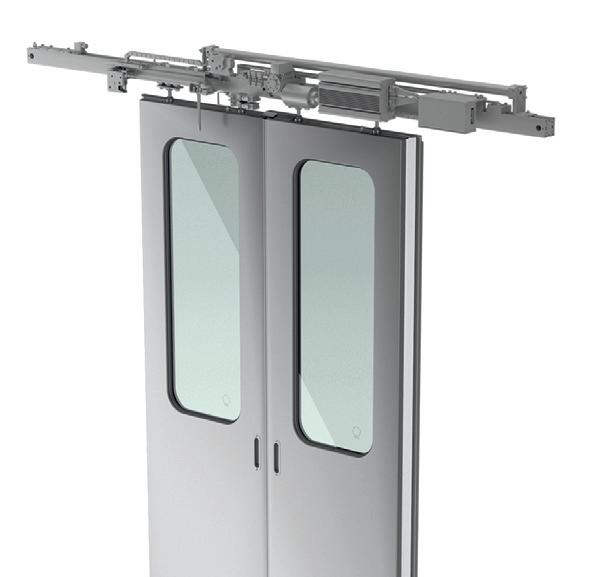

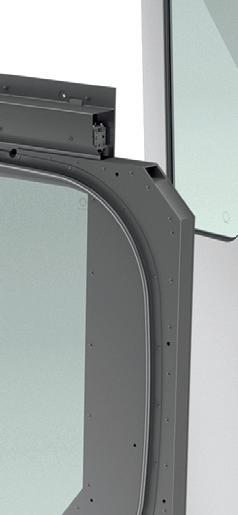






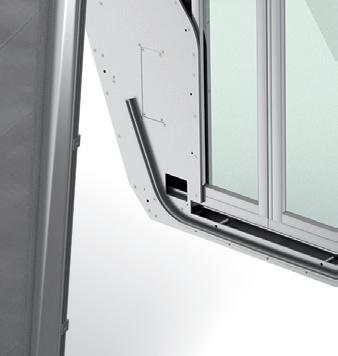

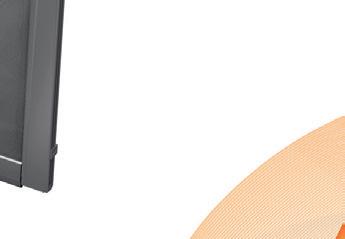
“We are IRIS,Ecovadis,Cyber and ISO14001 compliant.”


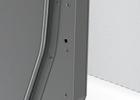

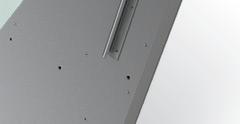

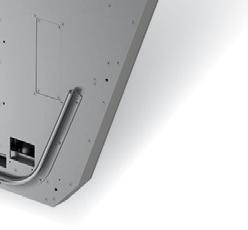
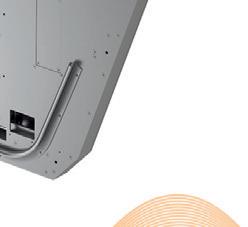

We deliver reliable, sustainable and efficiently produced interior door systems for the world’s leading train manufacturers.
Our business blends efficient basic production and forward-looking innovation.
All our solutions come with:
• Wide-Ranging understanding of our customers and industry
• In-depth expertise of the product area
• Long-term commitment to our customers
Polarteknik Finland has a very large number of different products that we have made for customer railway projects for over 30 years. Polarteknik is in full control of the design, manufacturing, testing and validation of the products.
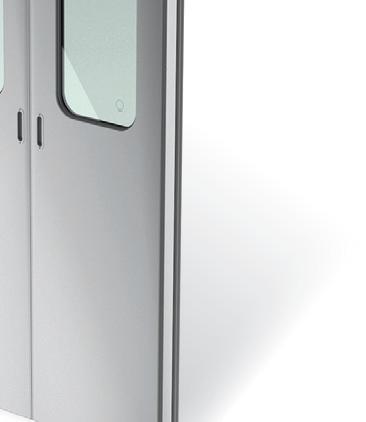







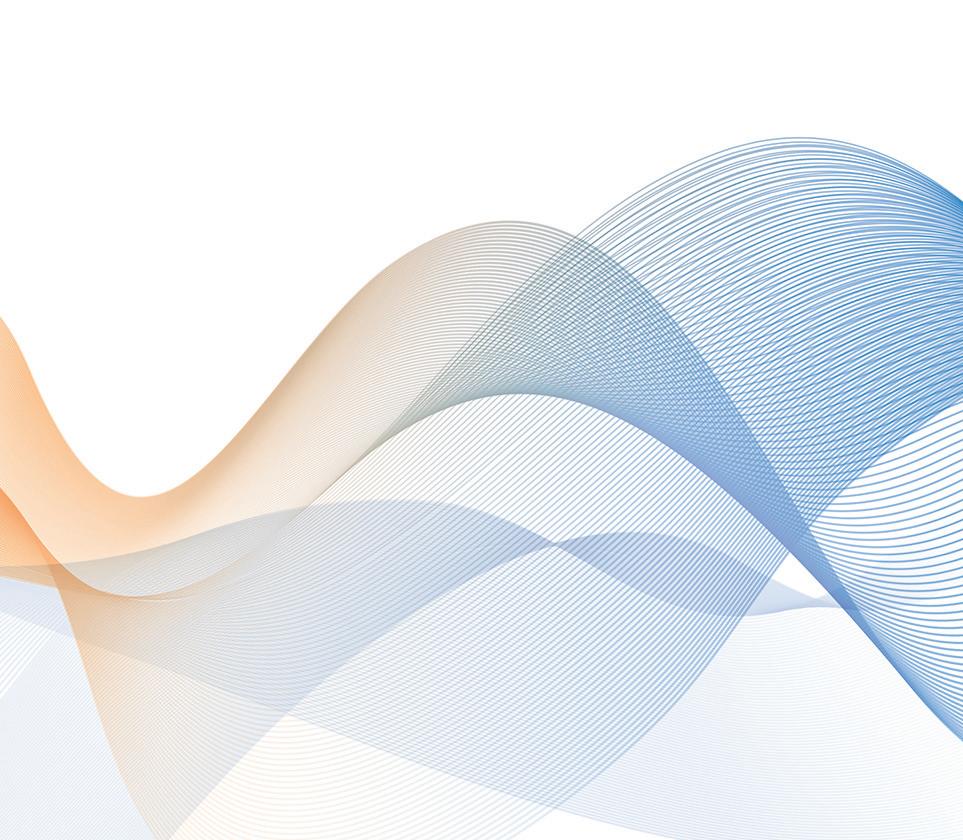

In addition to supplying what has been Polarteknik core competence, the door systems, the company is now one of the leading suppliers of partition walls and body end walls for rolling stock. Whether it is a highly complex motor car partition with high level of fire integrity and sound insulation requirements or a delicately designed saloon partition with open-feel full-glass surfaces Polarteknik can provide the solution from design to manufactured, easy to install product that is fully tailored to customers’ requirements and quality controlled according to IRIS certified quality system.
Formerly known as Train Door Solutions, now Polarteknik UK is a specialist company for pneumatic and electrical passenger door system manufacture, service, maintenance, refurbishment and beyond. Our comprehensive offering in the UK covers installation and commissioning, post-mounting inspections and testing, maintenance and overhauls, training services as well as retrofits, customer support and other aftersales services.
Visit Polarteknik at InnoTrans 2024 Hall 3.1 Stand 730 www.polarteknik.fi

In the bustling world of railway maintenance, loose fasteners pose a significant threat to safety and operational efficiency. Vibration, expansion, and contraction can cause these crucial components to loosen over time, potentially leading to failures with severe consequences. Regular inspections and retightening are essential, and visually identifying loose fasteners is an efficient method to detect any movement.
Introducing the Markal Security Check Paint Marker - a revolutionary xylene-free solution that transforms loose fastener detection into a simple, visual process. This innovative marker uses high-visibility paint that, when applied to bolted connections, hardens into a continuous 3D tamper-evident seal. This seal remains visible even if dirt or grease builds up on its surface. If the fastener loosens, the seal breaks, alerting inspectors during routine checks and preventing potential accidents and costly downtime.

Here’s how the Security Check Paint Marker safeguards bolted connection integrity:
1. Simple Application: Easily apply a thick, continuous paint mark to bolted connections.
2. Tamper-evident Seal: The paint hardens into a 3D brittle seal, revealing any tam pering or loosening.
3. Visual Inspection: During routine checks, broken seals indicate loose fasteners.






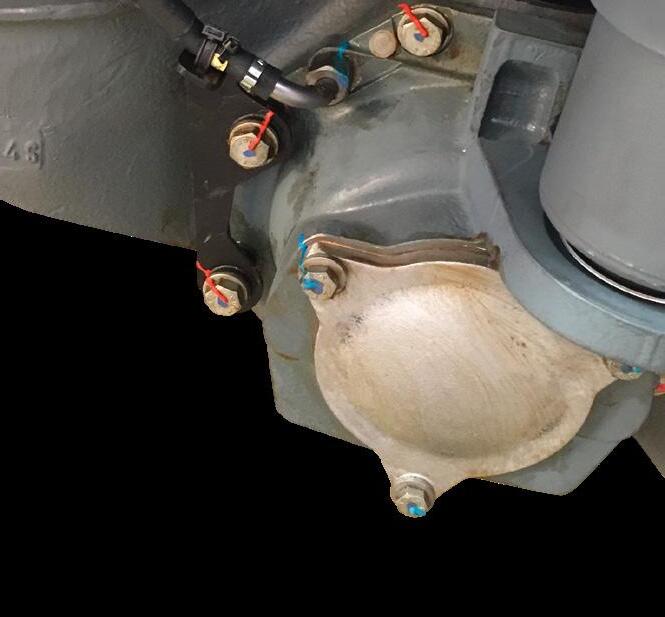
NOZZLE : Practical with its 3 levels, the nozzle can be easily cut to the desired length to meet the desired paint thickness.


Direct visual examination of vibratory loosening on brakes or any component exposed to high temperatures up to 1000°C DETECTION

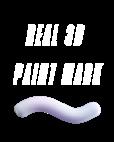





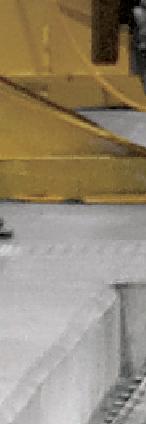




• RAILCAR LIFTING JACKS
• BOGIE/EQUIPMENT DROPS
• TRAVERSERS
• TURNTABLES
• BOGIE WORKSHOP MACHINES
• UNDER CAR EQUIPMENT HANDLING

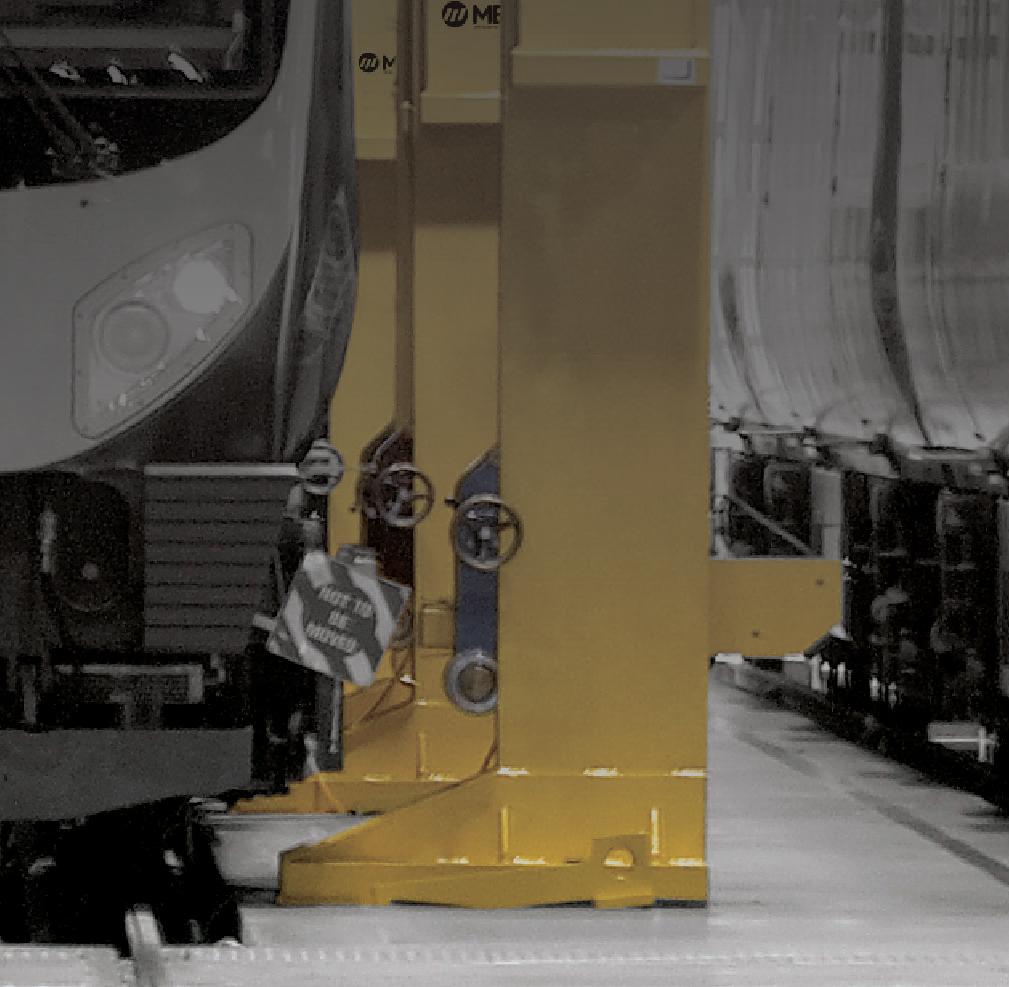
• LASER MEASURING
• SANDBOX FILLING
• SHUNTERS
• EXHAUST EXTRACTION
• UNDER FLOOR WHEEL LATHES



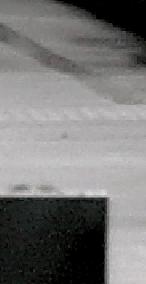


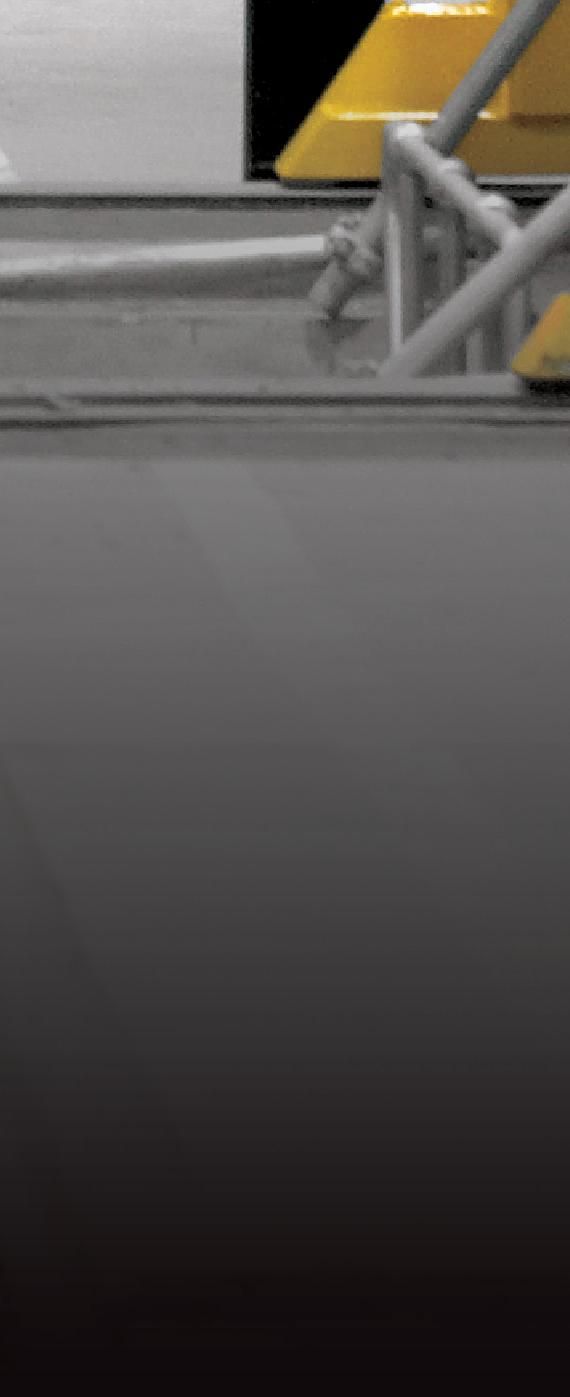
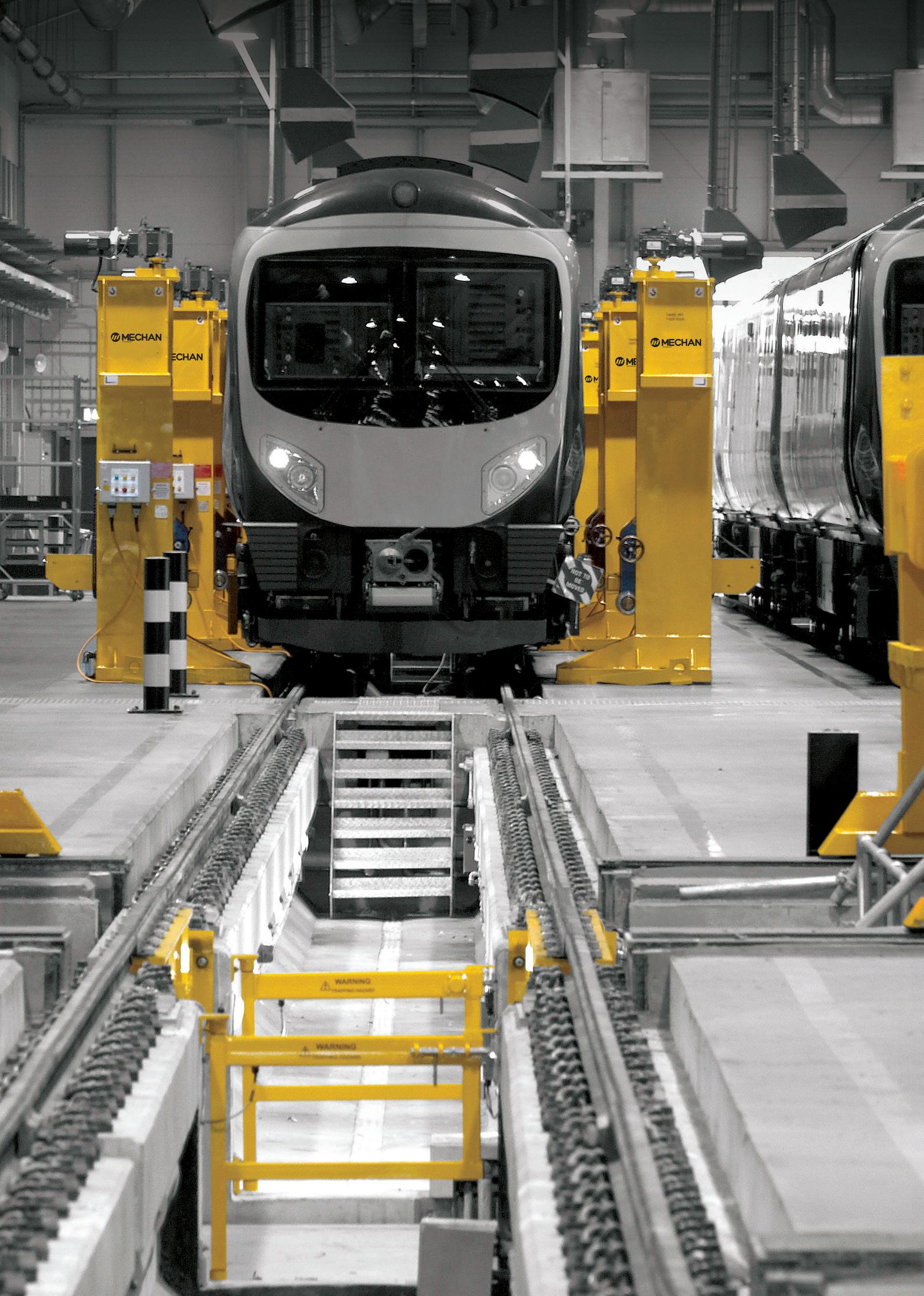

Rail depot equipment specialists, Mechan, will be returning to this year’s InnoTrans exhibition.
Situated in a new home this year, the British manufacturers will be joining forces with their parent and sister companies in Hall 4.2 Stand 110
The Sheffield-based railway equipment experts will be exhibiting in Berlin, from 24–27 September, showcasing the group’s capabilities.
Lindsey Mills, Mechan’s Sales Director, said: “We are excited to be mixing things up a bit this year.Joining our parent and sister companies on our ultimate parent company – John Cockerill’s – stand gives us the opportunity to promote all businesses within the group together for the first time.We are regularly combining resources within our group,working together on large construction projects,therefore it will be a great opportunity to show our customers how we can do this for them.Make sure you head to our new location for this year, Hall 4.2 Stand 110.”


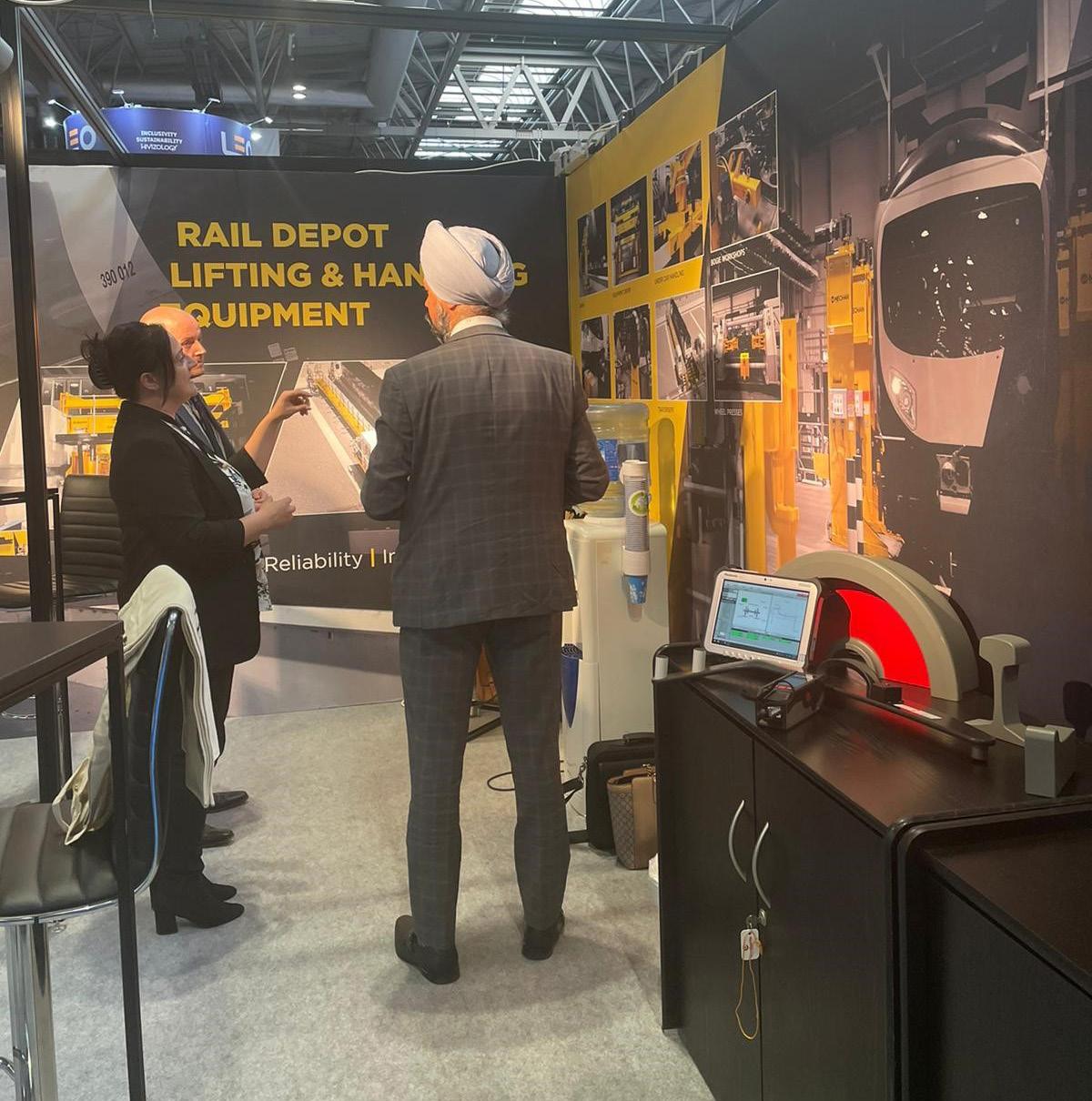
Founded in 1817 by the innovative entrepreneur John Cockerill, Mechan’s ultimate parent company John Cockerill Group develops large-scale technological solutions – facilitating access to low carbon energies, enabling sustainable industrial production, preserving natural resources, contributing to greener mobility, enhancing security and installing critical infrastructures.
Joining forces with the internationally renowned CIM


Group in 2017 pushed Mechan to the next level. Helping to reach untouched markets spread across different continents, CIM’s reputation lived up to expectations, and more. Structured around three core business lines within the railway industry, Mechan and CIM have been the perfect fit.
Complimentary sister companies SEG (Sogema Engineering Group), and LAF (Les Appareils Ferroviares) boosts Mechan’s product range. Specialising in wheel lathes, wheel presses and automatic couplers, their commitment to quality aligns with Mechan’s focus on quality and reliability.

For those who visited us at InnoTrans back in 2018, you may have had the opportunity to experience Transurb’s nano simulator. The tailor-made portable simulator is the ideal solution for theory and procedural learning. Continuously evolving as technology develops, Transurb provides their advanced simulation solutions worldwide.
Mechan’s team, including Lindsey, will be happy to discuss the group’s range directly with customers throughout the exhibition. Lindsey will be joined by Mechan’s export manager, Matthew StClair Smallwood, who is working to build and develop relationships with global clients to strengthen Mechan’s overseas reach. Other members of the Mechan team will also be on hand to provide information on the company’s range of rail depot lifting and handling equipment including lifting jacks, bogie drops, undercar handling, turntables, traversers and bogie handling equipment.
Mechan looks forward to meeting with you at the exhibition. To make an appointment, give the office a call on (0114) 257 0563, send the team an email or visit the website for more information.


The rail industry demands the highest standards of precision, efficiency and quality in its assembly processes.
Enter Virtek IRIS™ 3D with process monitoring feature, the next-generation solutions designed to elevate your operations with state-of-the-art AI and laser-based vision systems. Discover how these innovations can revolutionise your assembly processes, reduce costs and improve overall quality.
Virtek Iris 3D takes assembly to a new level by integrating a laser-guided vision system that guides operators through part assembly with unmatched accuracy and efficiency. Here’s how:
• Eliminate manual measuring, marking and fitting: Traditional manual methods are time-consuming and prone to errors. Virtek’s laser system projects the exact part positions directly from CAD data on to the workpiece, ensuring precise as-designed placement every time.
• Reduce templates & storage: Physical templates are costly and can cause production delays. By eliminating the need for templates, the IRIS software significantly reduces production expenses and streamlines your workflow.
• Minimise human error & enable rapid design changes: Direct CAD integration ensures that assemblers are always working with the most current designs, eliminating discrepancies

between ‘as-built’ and ‘as-designed’. This allows for quick adaptation to design changes without compromising quality.
The Virtek IRIS 3D process monitoring & AI camera system introduces a transformative shift in quality assurance and process visibility:
• Real-time QA integration: Our latest software upgrade includes the process monitoring feature, paired with the NEW AI-enabled camera system. This integration provides real-time feedback and quality assurance during the assembly process.
• Persistent quality records: Automate the generation of detailed quality records for every part. This includes high-resolution images, serial numbers, time stamps and adherence to quality standards, ensuring comprehensive documentation.
• Visual documentation: Seamlessly capture highVirtek Vision Positioning System (VPS) Watch our video to find out more
resolution images at critical production stages, creating a detailed visual record of each assembly step.
• Full traceability: Assign unique serial numbers to every part or component, linking them to captured images for complete traceability. Easily track the production history of any unit, enhancing transparency and accountability.
• Data-driven process analytics: Utilise real-time digital data to gain valuable insights into your assembly line efficiency. Identify bottlenecks, optimise processes and make informed decisions based on concrete data.
• Automated image capture: Predefine stages for image capture to eliminate manual intervention, enhancing the efficiency and accuracy of your assembly line.
• Time-stamped action logging & reporting: Every action within the work order is time-stamped, producing detailed quality records. Comprehensive reporting provides insights into the timing of each step, helping to identify areas for improvement.
Are you ready to revolutionise your rail industry assembly processes? Embrace the future of precision and efficiency with Virtek’s Machine Vision Solutions.
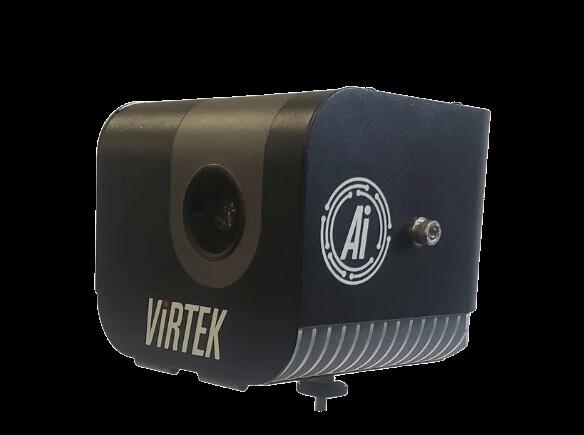
AI-enabled solutions are designed to provide unparalleled accuracy, reduce costs, and enhance overall quality.
Take the first step towards transforming your operations and elevate your assembly process. Contact us today to schedule a demo and unlock the potential of AI and laser-guided precision for your rail industry projects.
www.virtekvision.com

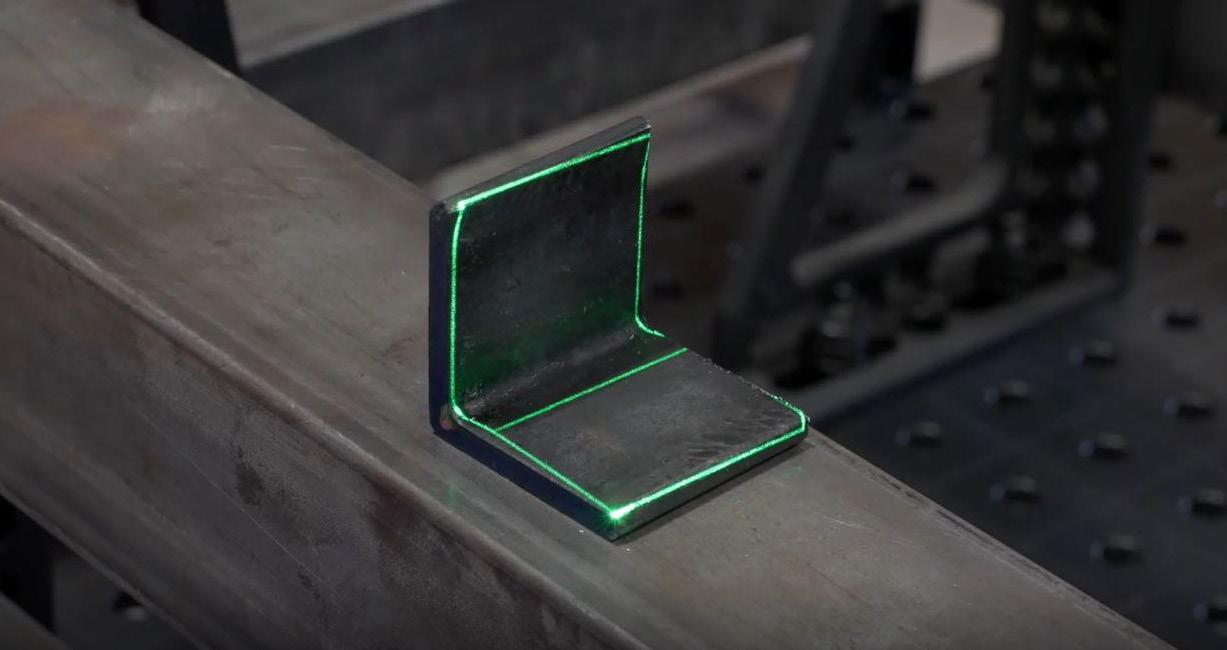
Engineering
Simplicity.
Machine Vision Solutions for Welded Assembly
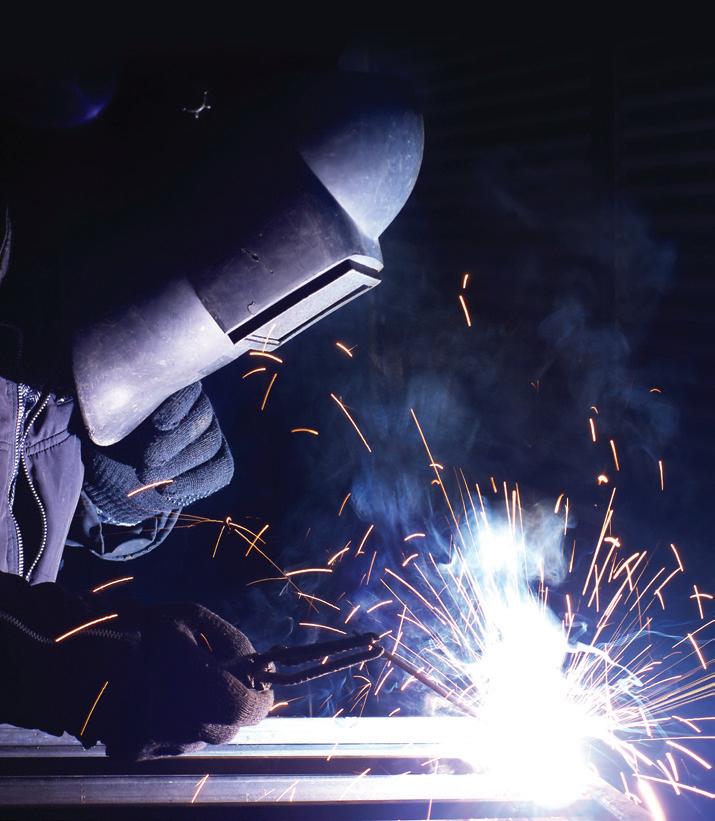




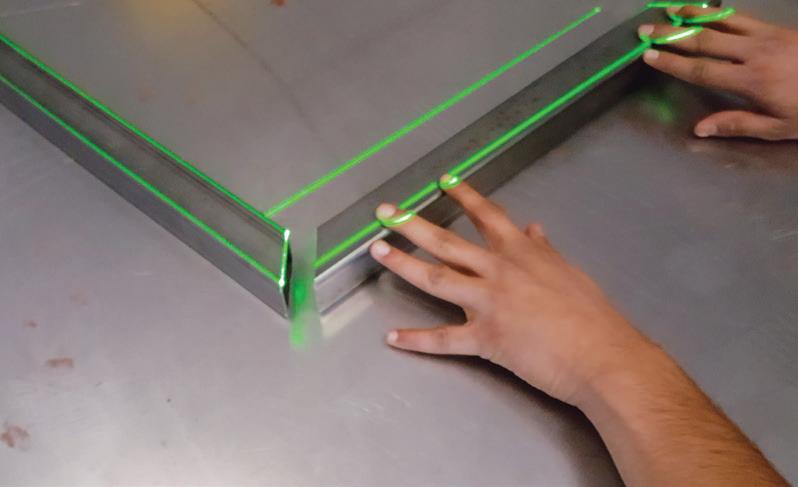
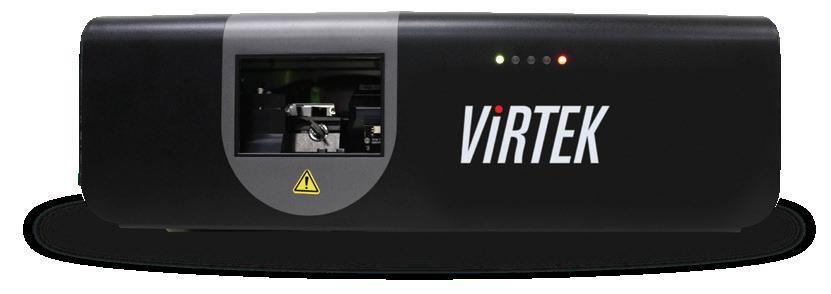
Virtek Iris™ 3D with Process and Monitoring and Ai-enabled Camera System: Create a permanent quality record, by capturing images, visually documenting every step in the assembly process. Includes detailed reporting for quality assurance.
Virtek Iris™ 3D with Vision Positioning System (VPS): Simplify fitting and accelerate the assembly process by eliminating manual measurement, marking and templates using NEW features CAD Visualization and Pick n Project (PnP).
Virtek LTG™ with Laser Projection System (LPS10): Streamline the layout process in seconds, ideal for “one-of-a-kind” rail industry projects. Designed to optimize the assembly of steel and miscellaneous metals.


NEXTSENSE, part of Hexagon AB, continues to lead the way in handheld rail measurement devices with the latest model in its CALIPRI C4X series, the CALIPRI C42
This multifunction measurement tool has been developed specifically for the railway industry, meeting all national and international standards across Europe.
Designed to measure all common train wheels, brakes, rails and switches across high-speed, regional and
freight stock, the CALIPRI C42 enables the combination of multiple inspection tasks in one measurement device, providing precise measurements quickly and contact-free.
For example, in the case of a train wheelset the C42 is capable of measuring the wheel profile, wheel diameter, wheel clearance and brake disk, enabling users to evaluate a complete wheelset with one device, including comparing measurements to predefined limit values. With the C42, users are able to immediately check whether the component’s measurement is within a set tolerance through colour coded results shown on the device.
“The system can be configured according to each customer’s requirements,” explains Philipp Sandheigl,
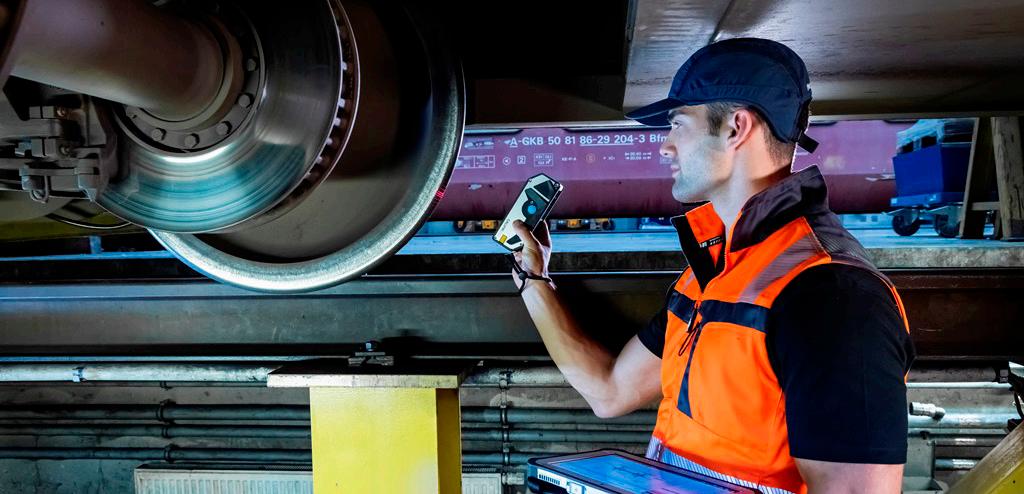
NEXTSENSE’s Team Leader Railway Applications. “There are a wide variety of measurement modules to choose from.These set the measurement parameters for the sensor,which can then be guided around the wheel to gather the necessary data.
“It’s so simple to use,and our customers love that they only need one piece of equipment for almost all their measurement tasks,” he continues. “It’s also really easy to upgrade the system as and when you wish to introduce other measurement parameters.Simply purchase a new module and this will be activated on your system ready for you to start measuring.”
Non-contact measurement is a key benefit of the CALIPRI series. Previously, the only available measurement tools were mechanical gauges and complicated-to-use laboratory measurement equipment. These required more human interaction, therefore giving more opportunities for errors to occur.
The CALPRI series doesn’t just stop at measurement either – it provides the entire workflow – removing the need for manual reporting, another step in the process where human errors can transpire.
“Before,you might have one guy using a mechanical gauge,manually configuring the settings and writing the values down on a piece of paper.He’d then perhaps head to the office,open Microsoft Excel or type his
parameters into a database,” says Sandheigl.
“This is a very convoluted procedure,which provides many opportunities for error.Perhaps the wrong value was typed in,or written down incorrectly…As our system is user-independent,we remove any risk of human error affecting our results.You could repeat them 100 or 1000 times, and the measurements will always be the same.”
As well as being used to complete inspection tasks, data gathered by the CALIPRI C42 can also support a customer’s predictive wheelset maintenance via the use of the CALIPRI Predictor analysis tool, which has been developed to work hand in hand with the C42.
“We could see that customers wanted to be able to do more with the data they gathered,and so we developed a piece of software that enables them to do life-cycle analysis and predict wheel life etc,” Sandheigl notes.“This is hugely important to our customers in terms of sustainability and cost,because if you can use predictive maintenance to extend the life of your wheels,you can save a lot of money.”
Today the CALIPRI series of rail measurement tools can be found in all European national railways’ maintenance facilities.
“In Europe all the national railways are using CALIPRI for their wheelset maintenance,” Sandheigl notes proudly. “Deutsche Bahn has around 250 units, SNCF has approximately 200 units,as does Trenitalia.
“Our first markets were Austria,of course,along with Germany and Switzerland,and we’ve grown from there.It’s been wonderful to see the companies across Europe move forward with us too – upgrading to the next generation model,the C42,as it came out. They’ve chosen to stay with us,which means they are benefiting well from our solutions.”
NEXTSENSE’s engineers aren’t ones to rest on their laurels, and while Sandheigl and his team are visiting potential customers and highlighting the benefits of the C42, the experts behind the scenes are already researching the next generation of the C4X series.
“It’s early days for sure,but they’re already working on a new generation device,” says Sandheigl. “This is to ensure that our customers always have the latest technological advancements available to them.”
To find out more about the CALIPRI 42, the C4X series, the CALIPRI Predictor or NEXTSENSE in general, please visit our website or email us.
The company – and the idea for the CALIPRI measurement device – was created by four members of the Joanneum Research Institute in Austria back in 2006.
Whilst working on a project around laser light technology, the team was approached by the Austrian Federal Railway (ÖBB).
“They asked if this technology would be able to be used to evaluate railway vehicle wheel wear,in order to remove error-prone physical contact from the process.At that time, the most common measurement tools were mechanical gauges,” says Philipp Sandheigl, NEXTSENSE’s Team Leader Railway Applications.
“Working closely with ÖBB,the researchers developed a prototype designed specifically for railway maintenance workshops,and the principles behind this prototype can still be seen in our measurement products and solutions today.”



Directory Rolling Stock
High-tech sensors, wireless messaging and signal processing are improving the quality and reliability of train toilet systems.
Whether you're on a short commute or a long journey, the condition of train toilets can make or break your travel experience. If the wastewater tanks in train toilets are not emptied, or if defects are discovered too late, the toilets can become unusable. In the worst case, if several tanks are not properly maintained, the entire train may have to be taken out of service temporarily. Now, a solution is available.
Vacuum toilets on trains dispose of their wastewater in on-board tanks that need to be emptied regularly. Trains call at service stations almost every day, fresh water is refilled and wastewater tanks are emptied. However, if a train misses its scheduled service or the pumping process is interrupted, the tanks can fill up during a long journey. In this case, the toilets are out of service during the journey and are shut down. This is an annoying experience for passengers who expect a fully functional toilet service. In Germany, this problem is significant enough that even members of parliament have called for better solutions.
Why is it so difficult to ensure that train waste tanks are reliably emptied? First, it is difficult to ensure that each tank is properly serviced. The train may arrive late at the service station, or staff may not be available at the right time. Another issue is that the wastewater extraction process is difficult to monitor.
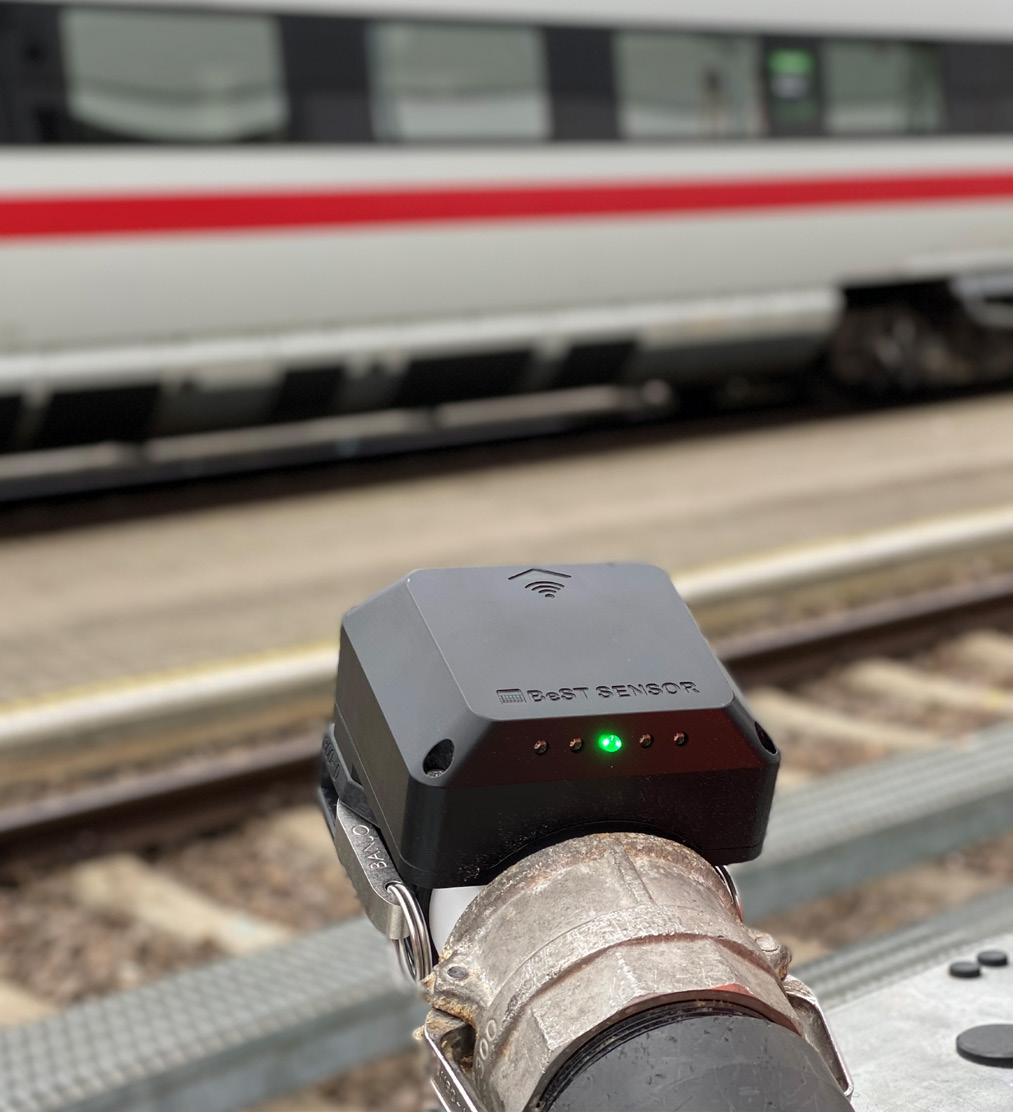
Unlike conventional liquids such as fresh water or fuel, wastewater also contains solids and gases. This leads to an uneven extraction process and it does not help that some passengers lose items like glasses, pocket knives or children’s shoes in the toilet. Such items end up in the tank and the toilet unit or wastewater tank may need to be repaired in the maintenance depot.
Often the maintenance process in depots is not monitored and recorded at all. If it is, it is done manually with pen and paper or manually entered into an app. Hard-working personnel lifting heavy, wet pipes with gloves have to stop what they are doing to use a piece of paper or a touch screen. Clearly, this process is unsatisfactory, slow and error-prone.
To find a better solution, Deutsche Bahn selected BeST Berliner Sensortechnik GmbH to design an autonomously working sensor system that monitors and evaluates the emptying process of wastewater tanks.
In 2021, Deutsche Bahn started a pilot project with BeST. The pilot project involved the development of a complete sensor system that monitors and evaluates every pumping process over a period of several minutes. The wagon and tank are automatically identified by an electronic NFC tag, similar to the touch-to-pay process used with modern bank cards and smartphones. The tank ID is combined with a short report of each pumping operation, which is then sent wirelessly to the train operator within seconds.
After over two years of continuous operation, the pilot project with BeST technology has shown that the wastewater extraction process can be reliably monitored. Tens of thousands of data records have been processed and stored in a database. Any issues during tank maintenance are identified and reported immediately.
Roediger Vacuum GmbH is an established supplier of vacuum drainage and sanitation systems to the railway industry. The company is known in the industry for its patented Roediger valves and extraction pistols. Roediger supplies sophisticated vacuum systems that transport wastewater around a train service and maintenance depots as required. This requires in-depth knowledge of pressure, water flow and mechanical design.
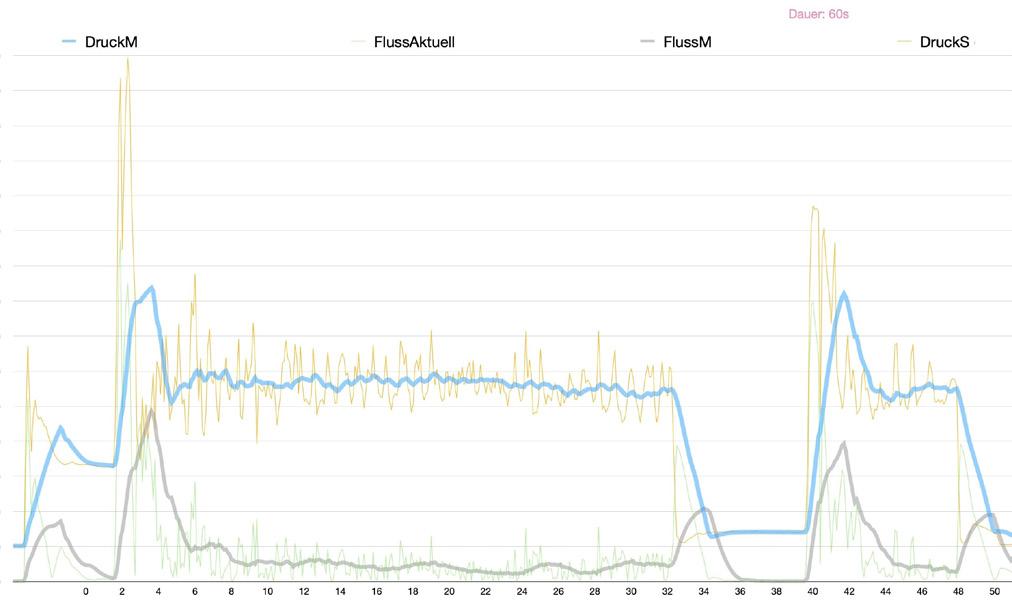
Recording the parameters of the disposal process using new sensor technology

With the development of a new generation of extraction fittings in which the sensor technology is already integrated, Roediger is able to supply a wastewater system that combines a state-of-the-art vacuum disposal system with IoT (Internet of Things) sensors and signal processing.
Each wastewater extraction operation is evaluated according to the customer’s requirements and quality standards. Train and tank numbers are automatically identified by RFID and the results are delivered wirelessly to the customer’s software system.
This ensures that each individual tank is emptied and that each waste water extraction operation is satisfactory, with any problems identified and reported. The whole system is fully transparent and automatic.
With the introduction of this system, trains that are taken out of service due to non-serviced or blocked toilet facilities should be a thing of the past and railway operators can take another big step towards predictive maintenance.
For more information contact
Andreas Bayerlein, Roediger Vacuum GmbH andreas.bayerlein@roediger-vacuum.com
Oliver Völckers, BeST Berliner Sensortechnik GmbH ov@bestsensor.de








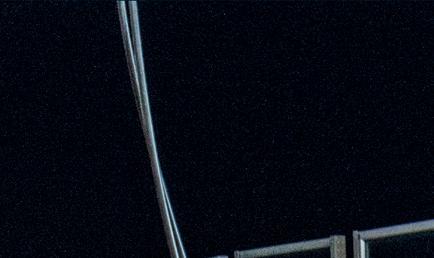

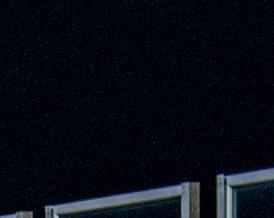

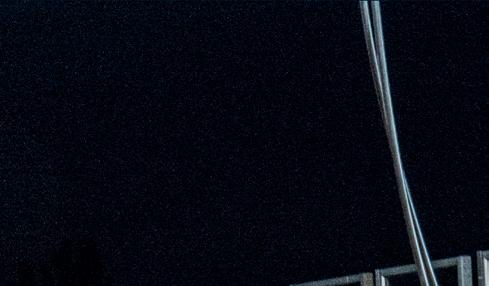

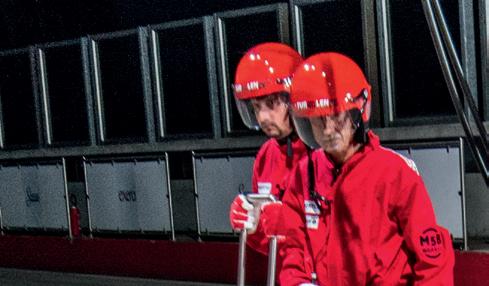





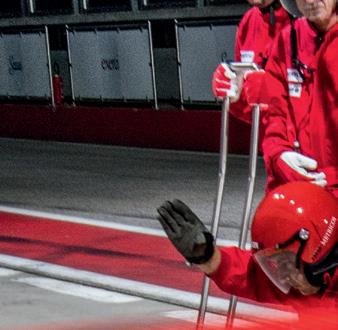
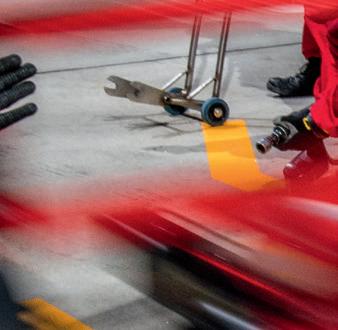

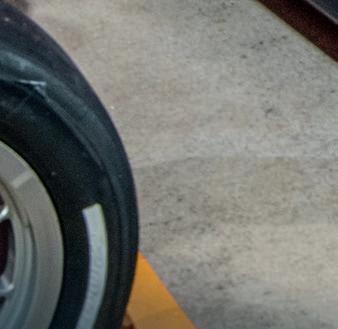




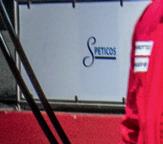



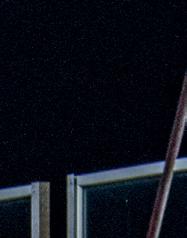





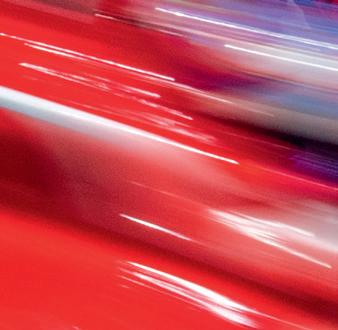
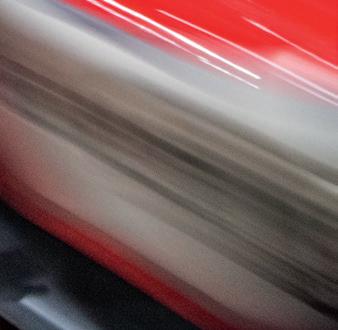

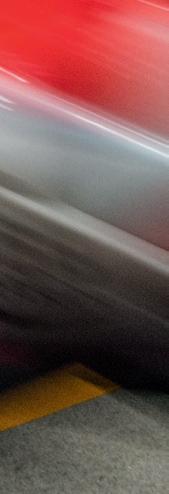




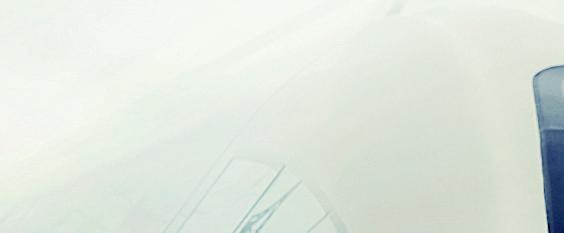






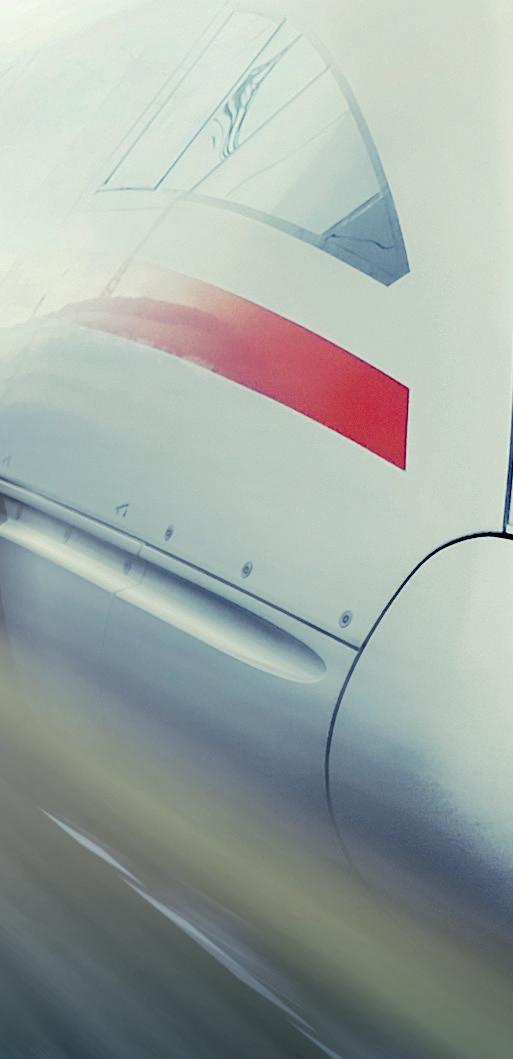


Freshwater and wastewater management with incredibly short downtimes: This is what we are already providing with the latest vacuum technology for large and demanding train operators worldwide. You too can rely on the perfect combination of service quality and high speed:
• Preparation and supply of flushing water


• Potable / freshwater treatment and supply
• Service stations for indoor and outdoor areas
• Cleaning service cabinets for interior cleaning of trains
Roediger® Vacuum Supply & Disposal System. Ultra fast. Outstandingly efficient. Extremely reliable.





Kiel Americas, as a part of the Kiel Group, has been providing seating solutions for the North American mass transportation industry since 2009.
Besides the design and production of new seating systems for local, regional and intercity rail, we also offer a wide array of services for repair, refurbishment and the replacement of parts to extend the life of
your seats, ensuring that your passengers remain as comfortable as possible throughout the life of your vehicle.
Safety is our top priority. We meticulously inspect each component for any structural damage or defect. From loose bolts to weakened supports, we repair it all. Our refurbishment process ensures that every seat meets the highest safety standards, providing peace of mind for both you and your passengers.
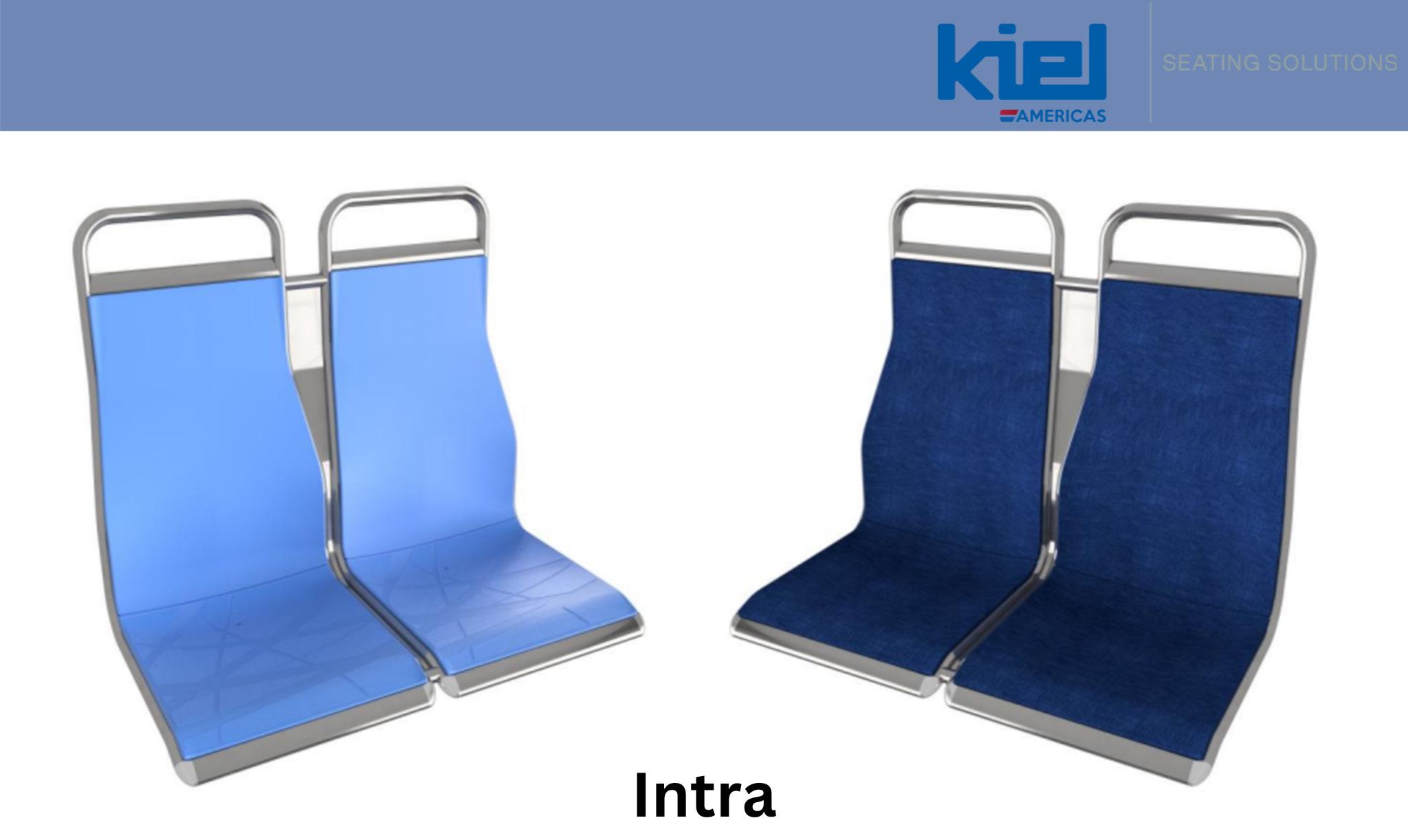

We also know that a fresh, clean look can make all the difference in passenger satisfaction. When reupholstering, we offer a wide range of fabric choices and colours to match your car’s interior, giving it a fresh, modern look.
An important part of our design philosophy at Kiel Americas is modular, recyclable construction systems. Our seats are composed with a modularity that allows for the easy replacement of specific parts as needed, without the need to scrap the entire seat and purchase a new one. Not only does this translate to substantial financial savings for the operator or transit authority, but it also means that our environmental impact is significantly reduced. Renovating a seat after 10 years of use is often as simple as replacing the fabric and foam, which allows most of the components to remain in use without leading to any unnecessary waste.
We stand by the quality of our work. Our team of skilled technicians brings years of experience to ensure every seat is refurbished to the highest standards. We guarantee you’ll be satisfied with the results.
Ready to transform your train seating? Contact Kiel Americas today to learn more about our repair and refurbishment services. Let’s work together to create a comfortable, safe and pleasing environment for your passengers. It’s up to you.®
For more information visit www.kiel-seating.com, email rkomm@kielamericas.com or call us +1 (708) 547 – 7000.

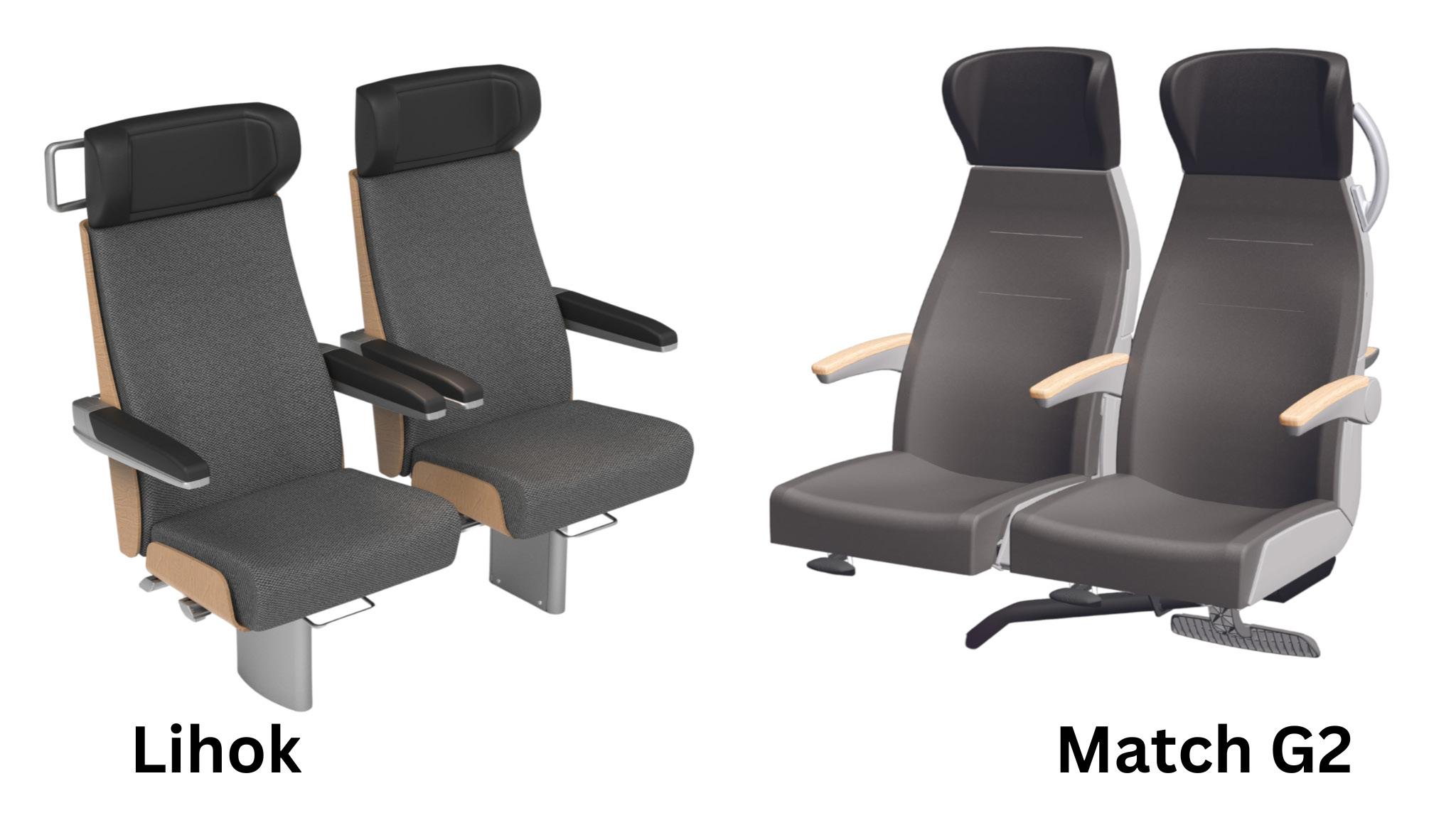






Sustainable rail travel is becoming increasingly vital as the world’s expectations shift towards environmental responsibility.
Designers, original equipment manufacturers (OEMs) and material manufacturers are coming together to help guide the industry with real-world collaborative applications like the Nordstern seating concept.
Shortly after the April 2023 RedCabin Railway Interiors Innovation Summit, Grammer AG, N+P Innovation Design, Lantal Textiles AG and SEKISUI KYDEX began collaborating on the groundbreaking Nordstern seating system, which won the RedCabin Rail Interiors Award in the ‘Design Innovation of the Year’ category.
Sustainability was a crucial component in the material selection process, with both suppliers bringing sustainable solutions to N+P’s innovative design.
"Partner selection was a large part of creating a holistic solution.We believed the right partners could make a significant difference in bringing the design to life,” stated Christiane Bausback, Managing Director for N+P Innovation Design. The Nordstern seating concept incorporates Lantal seating fabrics and KYDEX® Thermoplastics.
Lantal's 100% polyester MESH seat covers promote sustainability with easy recyclability and low maintenance, while enhancing passenger comfort. According to Stefan Wilhelm, Lantal's Head of Markets Ground, "The fibre composition of Lantal's new MESH seat covers provide excellent moisture absorption and breathability to enhance the passenger experience while offering the highest possible durability.With significant weight savings and a 100% recyclable material,the MESH seat covers contribute to the sustainable development requirement from Grammer and N+P." Lantal's MESH seat covers provide the design freedom required and deliver the comfort the passenger deserves.

The overall passenger experience is enhanced through technology with Nordstern's real-time personalised trip connectivity, offering a cutting-edge interface with a customer-centric experience. The system enables passengers to check in, adjust seats, select entertainment options and receive travel updates – all from the comfort of their seat. In addition, Grammer seamlessly integrated inductive charging by using 100% recyclable KYDEX® with Infused Imaging™ technology. A woodgrain pattern is featured on the tiered tray tables and the console design – complete with a wireless charging symbol.
Timo Bauer, Grammer's Vice President of PMS Rail & Road, stated, "When we step onto a high-speed train, we all hope for a warm and inviting atmosphere.The Nordstern interior experience,based on Grammer's modular magnesium seat structure and our partnership with N+P,Lantal and SEKISUI KYDEX,offers a range of seat configurations,delivering increased comfort,privacy and safety – all within the same space as traditional cabins.These seats are designed to make public transportation more appealing,offering a unique and adaptable journey."
Within six months, the four partners developed and unveiled the design prototype, showcasing its sustainably minded and customer-centric design at the November 2023 RedCabin Railway Interiors Innovation Summit in Vienna. Ruben Bake, Mass Transit Business Manager for SEKISUI KYDEX, noted, "Sustainable design is sometimes challenging for organisations to understand,so we were delighted to engage our designLab® and appLab™ Innovation Centers with an environmentally responsible project."
Nordstern’s adaptable seating concept transforms train interiors into welcoming, modern and environmentally friendly spaces while setting the standard for sustainable rail interior design. Yet, to design with sustainability in mind, it is essential to consider the quality of a product as well as the environmental impact of the development process, which can ultimately overshadow a product's benefits.
SEKISUI KYDEX and their KYDEX® and ALLEN® Thermoplastics portfolios, including the Infused Imaging™ technology, contribute to sustainable material selection through their energy-saving potential, intrinsic recyclability and energy recovery options. Working towards a closed-loop supply chain that maximises the amount of end-of-life material
received from customers, their in-house recycling facility is recycling over 15 million pounds (about 6,803,880kg) of thermoplastic annually. While their products are recyclable, the infrastructure to collect, sort and manage their recyclability is still new and in development within the rail industry. SEKISUI KYDEX is focused on developing new partnerships and collaborations within and beyond the rail community to find solutions.
In 2023, SEKISUI KYDEX began a multi-phased approach to better understand their environmental impact by conducting a life-cycle assessment (LCA) of its Bloomsburg, PA, KYDEX® Thermoplastics manufacturing facilities. This standard quantifies the effects associated with all stages of a product's life cycle, allowing new analysis of the product’s environmental impact, beginning with raw materials entering the manufacturing facilities until the product leaves the facility, also known as cradle-to-gate.
The collaboration between Grammer, N+P, Lantal and SEKISUI KYDEX is a testament to the industry's commitment to decarbonisation. In this vision of modern train travel, passengers can enjoy an unparalleled combination of comfort, technology and sustainability without compromising design. Organisations that align with this mission can offer an eco-friendly product design and foster sustainable innovations. However, achieving substantial change requires an industry-wide initiative. The rail interiors sector faces unique challenges due to regulations, a lack of expertise and limited collaboration within the supply chain.
With early collaboration and sharing of information, knowledge and best practices, everyone can contribute to a circular and sustainable rail industry, aligning with the growing demand for environmentally responsible travel.
Click here to watch our video.
For more information visit www.kydex.com



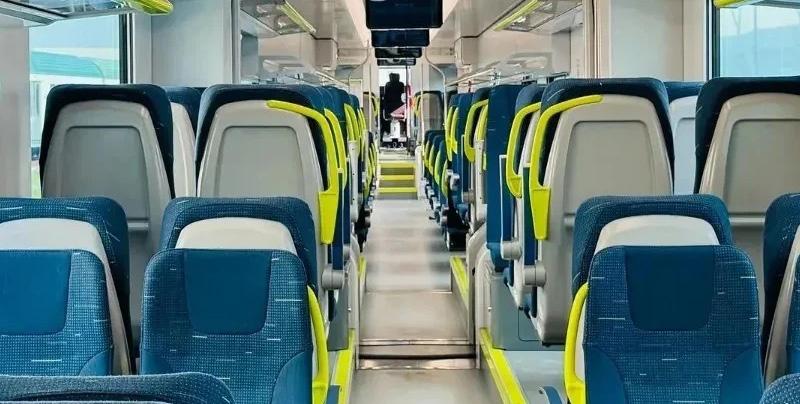
Founded in 1904 near Milan, Manifattura
Testori has brought to life many ambitious and important projects, taking Italian taste and craftsmanship around the world right from the beginning of the 20th century.
In the historical site of Novate Milanese, still today the operating headquarters of the company, in the first decades of the past century, production concentrated on fabrics for interior furnishings and, later, on those for railways such as the ones for the Orient Express, and for cruise ships, such as the ones for the Andrea Doria.
Then, between the 1950s and 1960s, Testori began working also with the aviation sector, firstly with Air France and Alitalia and later with the other world leading airlines.
Our Numbers
• 50% export quota
• Presence in 51 countries
• 330,000 metres of fabric capacity per year
• 100% made in Italy
• >9,000 articles
• 0–7 lead time weeks
Manifattura Testori is committed to developing sustainable product characteristics, production and work environment.
Product Characteristics
• Traditional focus on durability of our textile collections
• REACH-compliant raw materials and finishing
• Oekotex and GRS-certified raw materials
• Curtain and seat fabrics with recycled fibres that are also recyclable at their end of life
Production
• 100% production selvedges recycling
• Energy consumption reduction and water management
• Recycled product packaging
Work Environment
• 57% women employees
• High worker retention
Obtained from post-consumer recycled PET bottles with optimal performance for a variety of applications
• Third part processing
• Processing
Our yarns reduce the environmental impact, here below follows the numbers
• 90% energy savings
• 45% lower CO2 emissions
• 60% water savings
The process allows us to give new life to fibres and create new yarns from pre and post-consumer textile waste.
Our yarns reduce the environmental impact, here below follow the numbers:
• 47% lower CO2 emissions
• 61% water savings
• 47% energy savings
Manifattura Testori cooperates with the supply chain aiming to build an ‘Industry Partnership’ following the principles of eco design:
• Use of 100% recycled FR polyester fibres and sustainable dying
• 100% recycled FR polyester textiles become 100%

recyclable products if the finished products sewing is made/designed using the same raw materials (mono-material)
• 100% recycled material packaging and low-impact transport
• Low-impact in installation and maintenance
• Recycling of ready-made items (curtains and/or dress covers) converted into FR polyester padding
Manifattura Testori has developed new materials (fibres and fabrics) with the aim of being more sustainable and reducing the environmental impact.
We introduced 30% of bio-based material into the composition of our FR polyester products with the aim of reducing our carbon footprint with the switch to renewable sources.
We are developing new seating, curtain and vertical surfaces fabrics using natural fibres with the same performances of FR polyester.
To find out more about visit www.testori-manifattura.it
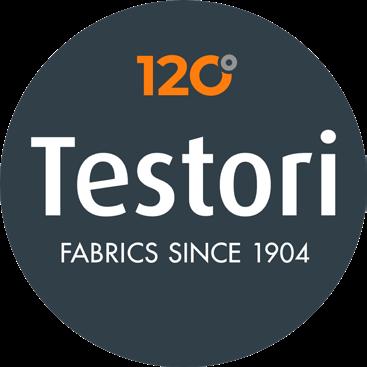

Directory Rolling Stock
We are delighted to introduce the 2024 model of the proven S2 Railway Coffee Machine, which we will showcase at InnoTrans 2024.
This version includes various innovative updates and enhancements aimed at improving performance and user experience, and will be available from summer 2024. Meet us in Berlin from 24 to 27 September 2024 in Hall 1.1 Stand 570.
Discover the future of coffee grinding with our precision grinders, now 40% faster for swift and efficient coffee preparation. We've upgraded the main control unit to include MDB, ensuring precise control and monitoring for consistently perfect results.
Our brewing unit features significant enhancements, such as optimised piston movements, powerful new motors and an increased capacity of up to 18 grams, allowing for a richer, more robust coffee experience.
With these advancements, the S2 Railway achieves a 10% higher product output. Enjoy faster service and superior quality, transforming your coffee experience with our cutting-edge technology.
Experience the ultimate in temperature-controlled milk
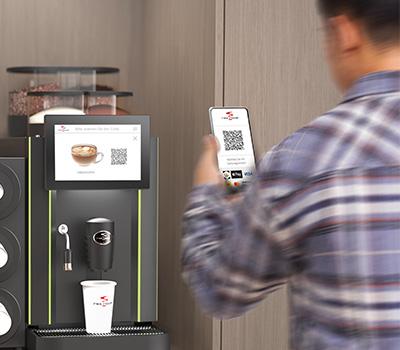
foaming with our advanced steam wand, perfect for both dairy and alternative milk products.
With new variable milk foam consistencies, you can achieve the perfect texture for any beverage. Whether you prefer a dense, creamy foam for your cappuccino or a light, airy foam for your latte, our steam wand delivers consistent perfection.
For railway passengers, this means a first-class, baristaquality coffee experience on board. Our advanced technology enhances their journey with exceptional taste and quality, bringing the luxury of high-end coffee shops to their travel experience.
Achieve optimal tea quality with T-TempControl, the
ultimate solution for tea enthusiasts and connoisseurs. This advanced system is designed to provide variable monitored temperatures, perfectly suited to enhance the unique characteristics of different tea blends.
Featuring an integrated hot water flowmeter, T-TempControl ensures consistent and accurate water dosage for every brew. The precise temperature monitoring during the brewing process guarantees that every type of tea reaches its full potential, offering a superior taste profile and an exceptional drinking experience.
Touchless IQ allows for seamless, touch-free product selection, revolutionising the way railway passengers interact with Rex-Royal coffee machines. Whether selecting a beverage, making a payment or navigating through menu options, Touchless IQ offers a highly convenient and hygienic solution.
By eliminating the need for direct touch, this technology enhances user convenience and promotes better health and safety, particularly in the bustling environment of a train station or on board a train.
With Touchless IQ integrated into Rex-Royal coffee machines, travellers can enjoy a futuristic, clean and efficient way to get their favourite beverages. This sets a new standard for customer service and operational

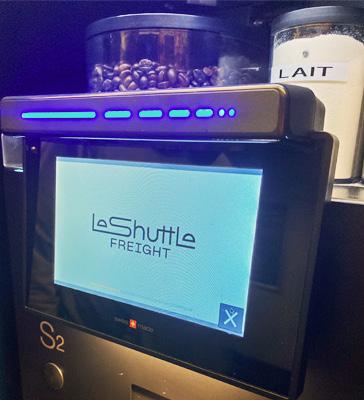
efficiency in the railway industry, ensuring a smooth and enjoyable journey for every passenger.
Experience seamless payments with Rex-Royal QRpay, the cutting-edge solution for modern transactions. Simply scan the QR code directly on your mobile phone for quick and efficient payments, eliminating the need for additional housing or equipment. This innovative system is not only cost-effective but also incredibly user-friendly, making transactions smoother than ever.
Rex-Royal QRpay combines ease of use with toptier security standards, ensuring your payments are safe and reliable. Whether on the go or in a busy environment, your passengers can trust QRpay to handle their transactions with the utmost security and convenience.
The S2 Railway has undergone rigorous testing to meet railway standards, demonstrating its quality and reliability.
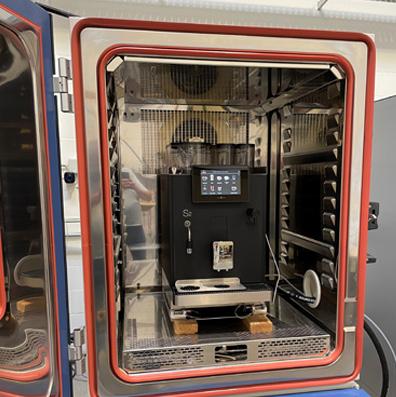
In the Damp Heat, Cyclical test, conducted according to EN 60068-2-30, the S2 Railway was exposed to extreme humidity levels (90–100% relative humidity). This ensured its durability and performance under harsh conditions.
In the Cold/Heat Constant test, the device was subjected to temperatures ranging from -40°C to 85°C, following the guidelines of EN 60068-2-1 for cold and EN 60068-2-2 for heat. This rigorous testing confirmed that the S2 Railway operates flawlessly at both the lower and upper temperature extremes, ensuring it remains undamaged even during transportation.
The S2 Railway therefore fully complies with the EN 50155-3-2 standard, whereby the EN 60068-2-1 standard specifically emphasises the function of the coffee machine's frost protection.
Introducing our new model, featuring standard ambiance lighting for enhanced visual appeal. The sleek BlackSatin-Finish casing offers a high-quality design that seamlessly integrates into any modern railway setting.
This device not only performs exceptionally but also enhances the aesthetic of its surroundings. Its
contemporary design and premium materials make it a perfect addition to modern environments, providing both functionality and style. Experience elegance and sophistication with our meticulously crafted device, designed to impress and elevate any space.
Experience enhanced efficiency and ease with our new machine maintenance menu. Designed with a clear, intuitive structure, it provides a comprehensive overview, making navigation simpler and more straightforward.
Our menu is optimised for remote service instructions, allowing for seamless maintenance and troubleshooting from any location. This remote capability reduces downtime and ensures that your machines are always operating at peak performance.
Designed to significantly improve the backend user experience, the new maintenance menu streamlines processes, saving you time and effort.
Existing projects will not be affected by these updates and will be produced and delivered as agreed. The S2 Railway 2024 will be the standard for all new projects. Please note that a moderate price adjustment will take effect on 1 July 2024.
For a personalised consultation, we would be delighted to help you. Thank you for your ongoing partnership and support.
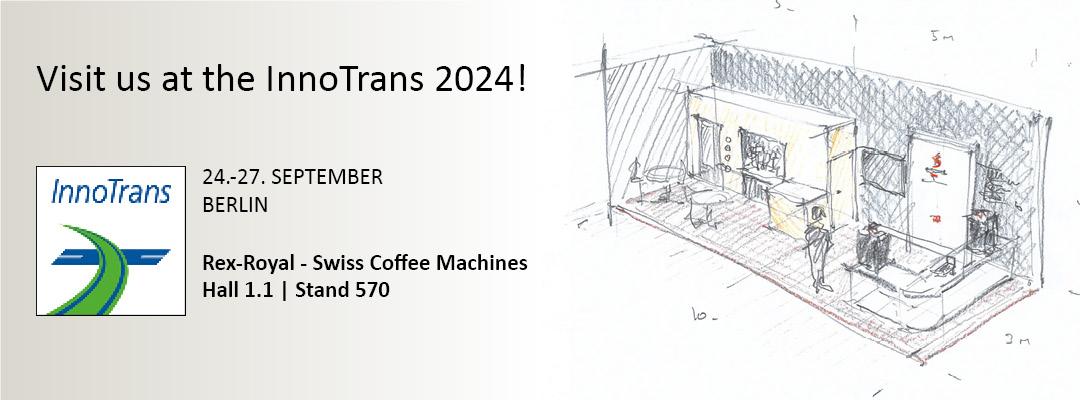
For more information visit www.rex-royal.com
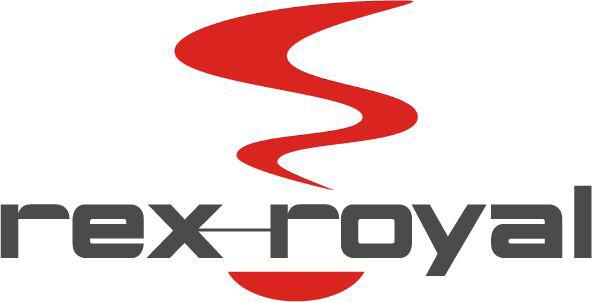

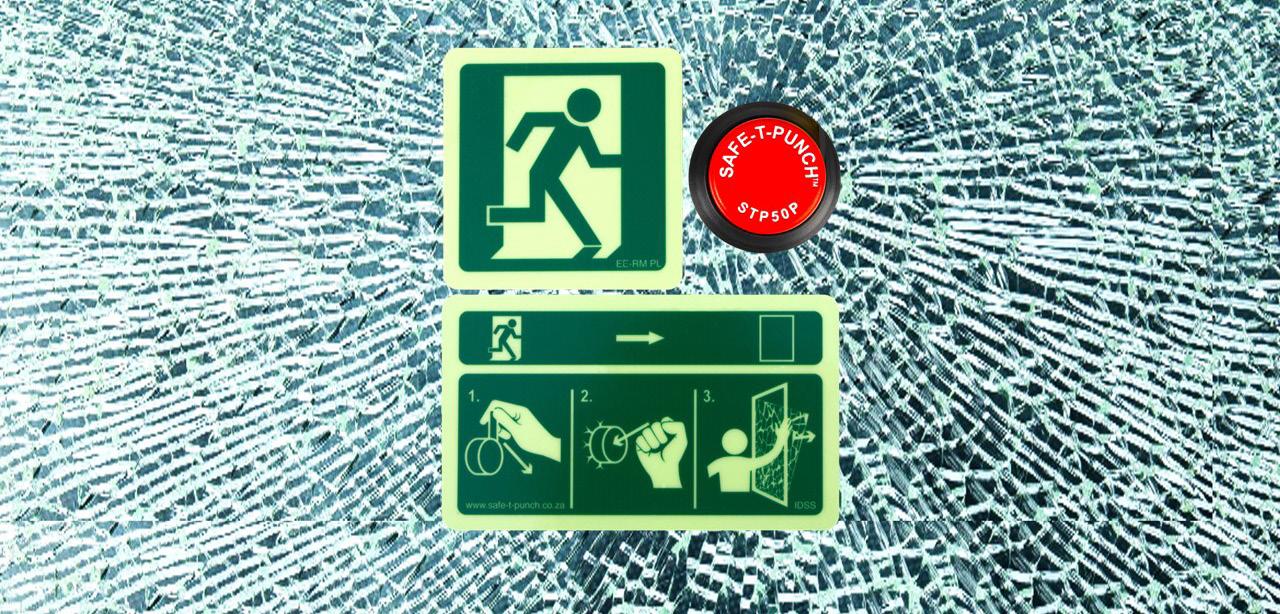
Passenger transport is a critical component of any modern society. While boarding a train is controlled – ‘Mind the gap!’ – there are times when an unscheduled disembarking is of life-saving importance. For this, we have a service door and emergency exits.
The need for emergency exits is classified as a risk of low probability with high consequences. SAFE-TPUNCH™ is designed to decrease this risk for the rail passenger and operator. It is a tried-and-true, homologated technology that is ready to use off the shelf.
Generally, innovation can be stifled within the rail industry due to the inhibitive costs of in-house R&D
with comparatively small opportunities for returns on investment.
Innovation in the electronic monitoring industry is inevitable. Its widespread uses will cross over to many industries as AI and the Internet of Things progress. However, it is experimental and carries many concealed risks inherent in its complexity. Although brilliant, helpful and even necessary, total reliance on such systems, which are often autonomous, is challenging when needing to guarantee the safety of people with certainty.
Prudence dictates that experimental development and passenger safety be maintained separately and not co-dependent.
Concise scientific and repeatable safety takes precedence through occupational health and safety. It

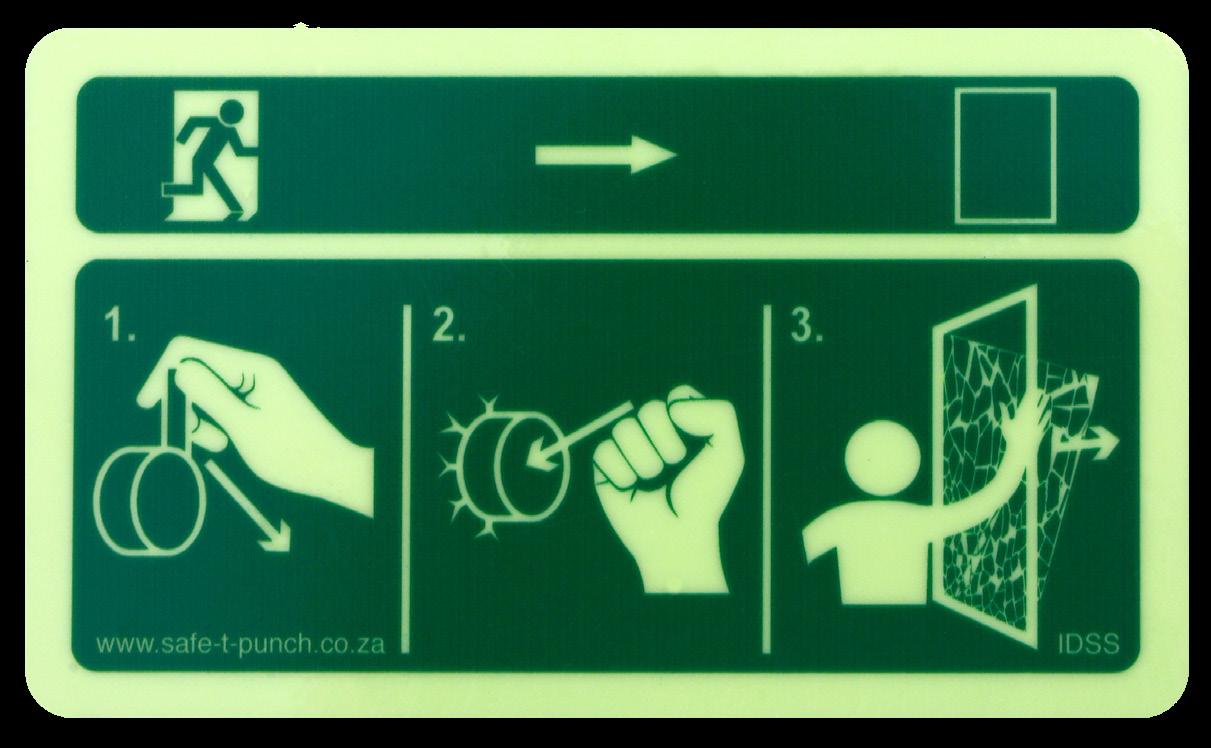
is not uncommon that the absence of standards often causes inaction by its conscripts. Self-regulation can turn into no regulation.
Proven technology that ensures functionality is the minimum requirement to decrease known risks.
Accepted preferential practice is for emergency equipment to be analogue closed mechanical systems or devices. They should ideally contain no batteries, explosives or springs and should be simple, sophisticated and free from complexity when used.
Unattended public service is essential to the emergency window’s success. It must be free from training requirements and robust to withstand curiosity and tampering.
A delicate and detailed understanding of an emergency exit operating environment ensures correct design instruction, resulting in an intended and successful predetermined outcome. This is SAFE-T-PUNCH™.
The reliable and repeatable yardstick is science for guidance in generating such a device. It must be reduced to numbers and test methodologies that are unbiased, transparent, peer-reviewed and repeatable.
The quality of such equipment is only reliably repeatable when strict independent audited certification is applied to its conformity of production. ISO9001:2015 is the industry methodology by which conformity in output is controlled and ensured to the satisfaction of the competent authority.
Guidance can be obtained from the bus industry, which has been regulated for many years and has successfully deployed its requirements in the public arena.
Toughened safety glass train windows will remain with us for many years. They are made from a standardunderstood material. Glass science and test methods are confidently transferrable to many other industries. Their use as breakable emergency windows is homologated when fitted with a tested glass-breaking device with known capabilities.
True safety innovation considers all of the factors above and is not subject to arbitrary distractions, conveniences or economics. Its objective remains singular: to achieve a desired outcome that serves people's best interests in an emergency. It must provide them with an ensured emergency exit using an approved scientific device to break the standardised toughened safety glass window pane of appropriate size and location and advertised using accepted standards as a life-saving emergency exit.
Because trains qualify as passenger transport, they must include the standard safety requirements of competing industries. Rail regulations lack clarity concerning the sustainable safety of passenger emergency escape provisions from trains.
It is proven that any portable item in a train cabin will have a high chance of being removed, misplaced or stolen. Portable tools such as hammers are not only subject to these risks but can directly endanger the safety of others. They are considered harmful
items that should not be left unattended in the public domain. Escape hammers are threatening and can inflict serious injury to others during a criminal act of mugging, assault or robbery.
There are shortcomings when using tools when the application calls for a device. Under these circumstances, tools do not conform to the requirement to be failsafe as it depends on operator training, skill and talent and can be interpreted as discriminatory towards women, the young and the old, or the capabilities of any person in an emergency. When contemplating the requirements of an emergency window, it is clear that these safety structures found in the public domain must be treated with respect and diligence.
SAFE-T-PUNCH™ is equipped and capable of taking responsibility by providing branded, state-of-the-art scientific devices that satisfy a maze of regulations. PLR Distribution Pty Ltd. maintains audited and certified ISO9001:2015 quality and consistency to the satisfaction of international competent authorities.
Its product, SAFE-T-PUNCH™, is homologated and certified as suitable, adequate and effective. It ensures compliance with the requirements for an emergency window glass-breaking device.
Safe-T-Punch™ serves all equally and provides safety by being permanently installed in its place of operation. Installing is as easy as peeling and sticking. It is secured
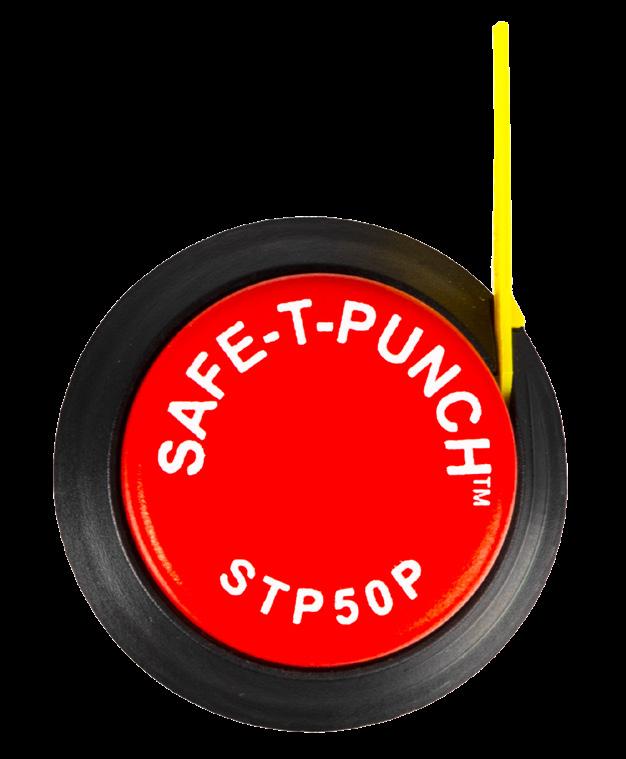
against accidental activation with simple 3-step photoluminescent operating instructions. With a low profile and exceptional adhesive strength, removal by bare hands is impossible.
Innovative, modern monitoring of passenger cabin spaces is vital to prevent train vandalism and ensure passengers' safety and well-being. This further benefits the use of SAFE-T-PUNCH™ glass-breaking emergency window devices, which are externally monitored by CCTV systems as an additional deterrent to vandalism.
SAFE-T-PUNCH™ is the regulations personified. Continual improvement over many years has culminated in an elegant and sophisticated life-saving device.
www.safe-t-punch.co.za


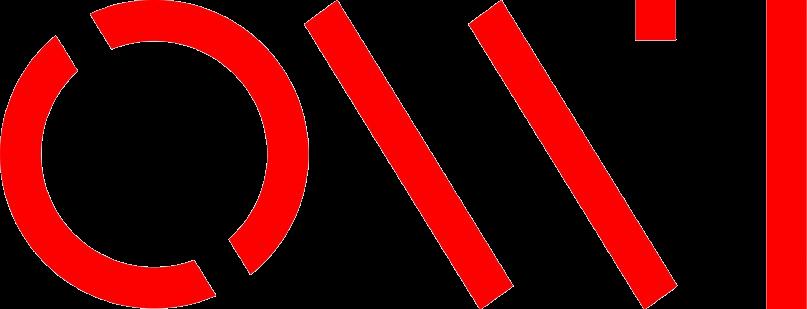
OWI manufactures seating components from moulded plywood and plastic.
Since 2023, OWI has been certified for the production of plywood mouldings with fire protection requirements for railway applications in accordance with EN 45545-2. With OWI FireProtect® we supply you with flame-retardant mouldings for applications with increased fire protection requirements such as seats for trains and buses as well as airports.
www.owi-lohr.de


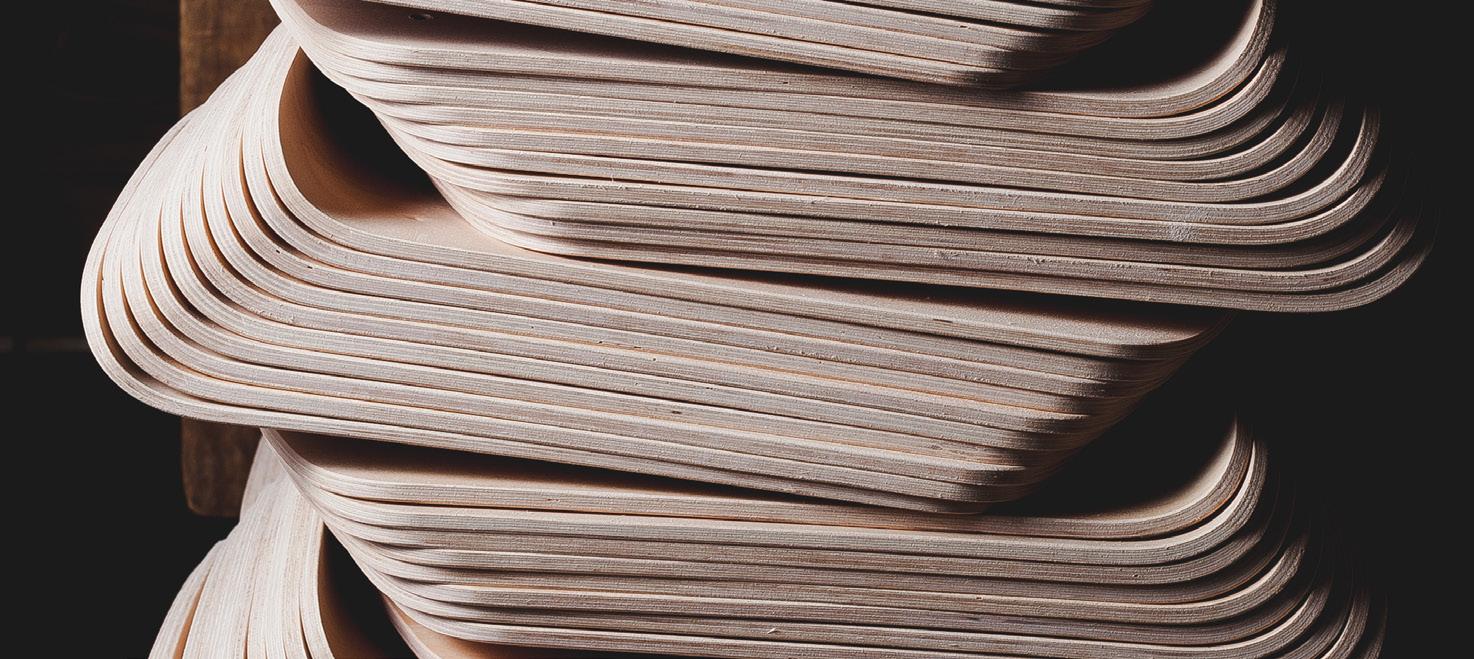
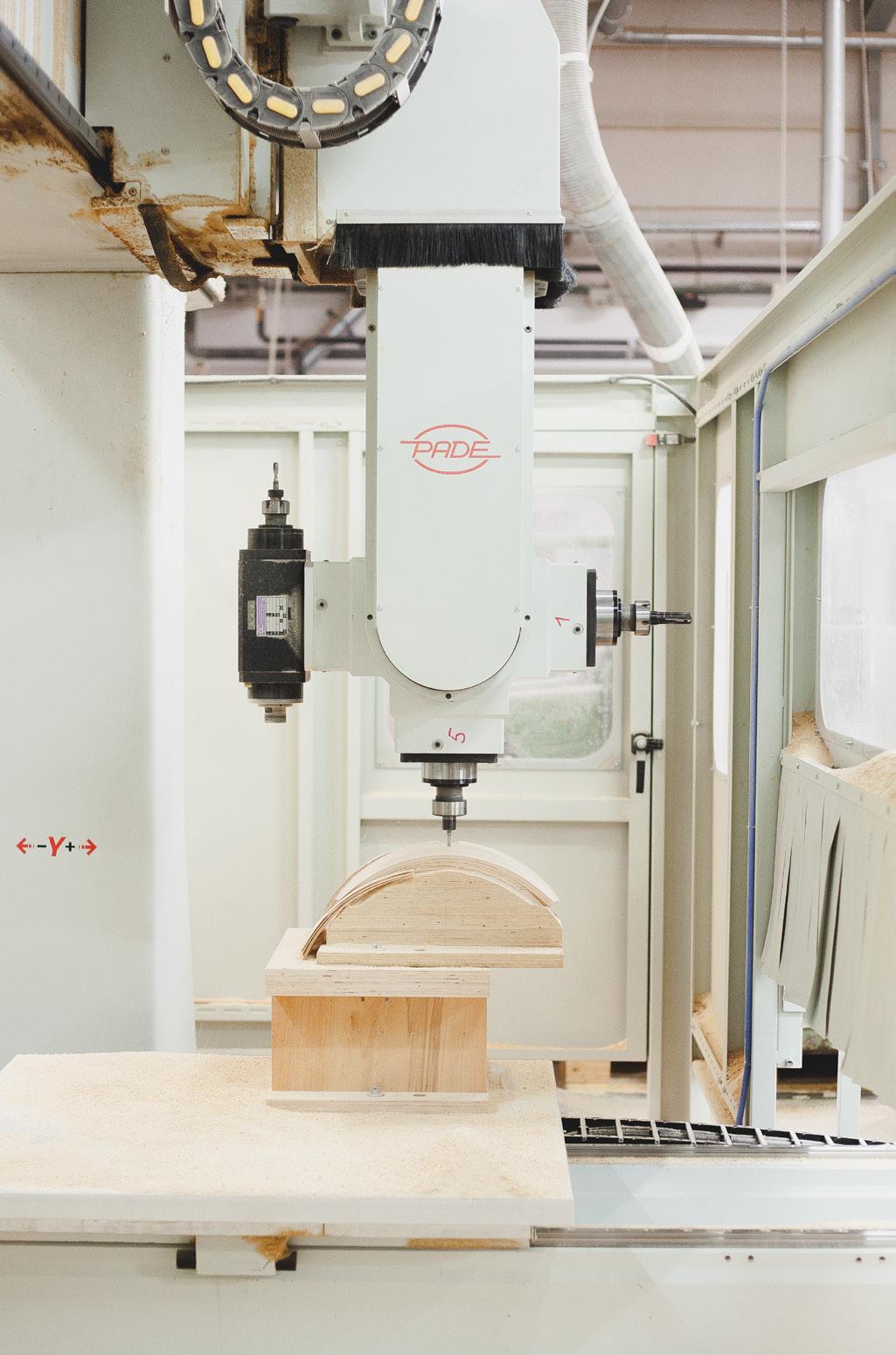



Directory
Rolling Stock


U-Lift in Backaryd, with its 20 employees, is the small company that has made itself known as a world player in the global market.
With its quality-assured lifts, ramps and air suspensions for freight and passenger transport, the company is now an established global supplier. With a clear goal of continued growth, U-Lift is not slowing down.
U-Lift in Backaryd is a well-established company that started as early as 1957, then focusing on luminaires and later furnishing of buses and trains. Nowadays, the focus is entirely on lifts, ramps and air suspensions for
various types of freight and passenger transport, and then mainly passenger vehicles and trains.
The production of electro-hydraulic lifts started in the 1970s and U-Lift has over the years grown as a recognised and stable supplier. The company is certified according to the standards and directives that apply to the industry and there are also industry-unique standards.
“We are a leader in the industry with exports to mainly the European countries but also globally from Brazil to China,” says Stephane Thomsen, Sales and Marketing Manager at U-Lift in Backaryd.
U-Lift is established with offices, production facilities and warehouses in Backaryd, Sweden. The planned investments include, among other things, expanded production areas and warehouse space, in order to meet the steadily increasing order backlog. The investments also apply to the personnel side, where U-Lift will continue to recruit new employees.
“We started at the turn of the year with recruitment and we need to strengthen further to match the order intake,” says Stephane Thomsen. He describes the company as being in a positive phase with “growing pains” right now.
"U-Lift has a goal to grow 15% a year,which is a goal that we follow and exceed.Our production has increased production capacity through efficiency and workflow," says Stephane Thomsen.
The car-side is a more cyclical sector, but even here U-Lift has secured orders and sees a clear increase.
Customers include several significant manufacturers, such as Siemens, Skoda, Stadler and Ural Locomotives. Other manufacturers for which U-Lift is a long-term
supplier are Ultimate Europe, Koncar, Alstom, Newag Group and Pesa." --- can content check that it's okay to remove Bombardier as they're now part of Alstom
“U-Lift has a customer portfolio with several large and world-leading manufacturers in the automotive and transport sector.This is far ahead of the competitors in the market,” says Stephane Thomsen.
U-Lift’s policy states the local anchorage as an important element. This also applies to the choice of partners.
“Our principle is to first and foremost ensure we work with sustainable local partners where possible.It is also a requirement from our customers,” says Stephane Thomsen.
U-Lift is highlighted as an attractive employer, where short decision paths, participation, responsiveness and commitment characterise the business.
“Our ambition is to attach valuable expertise to us in all areas within the company’s business areas.U-Lift has a will to be at the forefront and take on challenges with curiosity and great commitment to continue to create growth in line with our goal description,” says Stephane Thomsen.
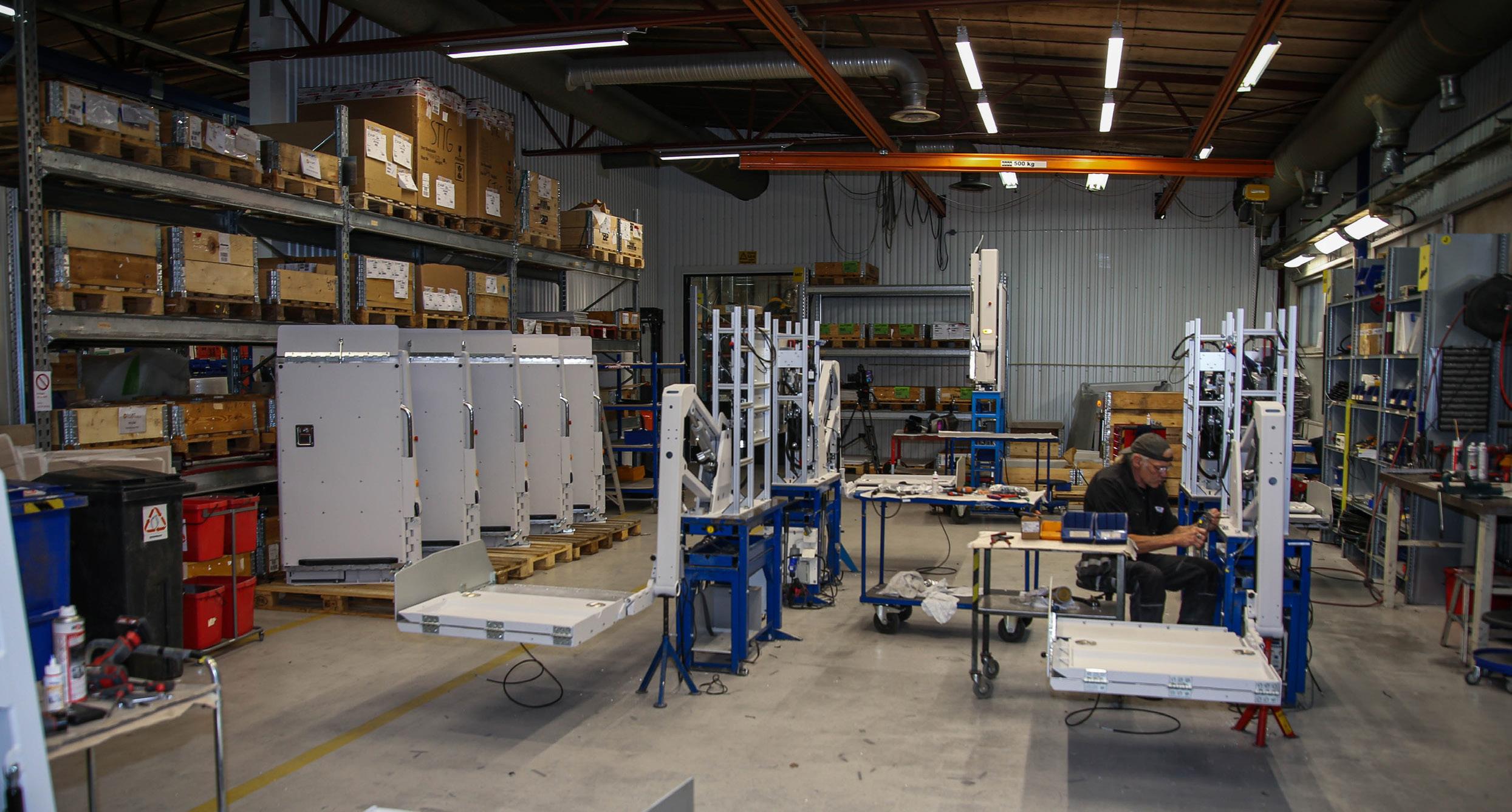

U-Lift designs and delivers the following products for passenger vehicles:
• U-SWING air suspension
• Wheelchair lifts INV300, which are compact and customisable to limit the space used in trains and to adapt to the requirements of each customer
• Ramps Trifold and UL small gaps ramp
• Load lift VTB-500 LOS
• Ramps (TriFold and EcoBoard)
… And for trains:
• Wheelchair lifts (INV-300 and UPL-300)
• Ramps (TriFold and EcoBoard)
For more information contact Mattias Olsson, CEO, U-Lift AB +46 457-45 06 54 www.u-lift.se
Vi underlättar tillgängligheten för personer med nedsatt rörlighet
We improve the accessibility for persons with reduced mobility (PRM) Wir erleichtern die Zugänglichkeit für Personen mit eingeschränkter Mobilität
U-Lift AB med huvudkontor i södra Sverige tillverkar och säljer rullstolslyftar och ramper för järnvägsapplikationer, samt minibussar, låggolvsstadsbussar och lätta lastbilar. U-lift är ett ledande företag inom fordonskomponenter med produkter för resenärer med nedsatt rörlighet.
U-Lift AB based in South-Sweden develops and markets wheelchair lifts and ramps for railway applications, as well as for minibuses, low-floor city buses and load lifts for light commercial vehicles. U-Lift is a leading company in the automotive market with products for people with reduced mobility.
U-Lift AB mit Sitz in Süd Schweden entwickelt und vermarktet Rollstuhllifte und Rampen für Bahnanwendungen, sowie für Kleinbusse, Niederflur -Stadtbusse und Lastaufzüge für leichte Nutzfahrzeuge. U-Lift ist ein führendes Unternehmen im Automotive mit Produkten für Reisende mit eingeschränkter Mobilität.

”U-Lift is a leading company in the automotive market with products for people with reduced mobility.”
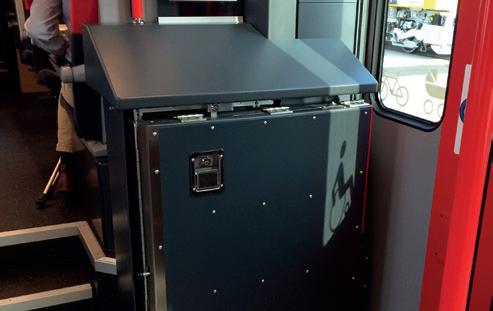
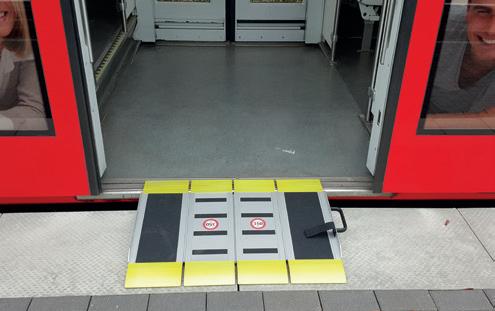
und
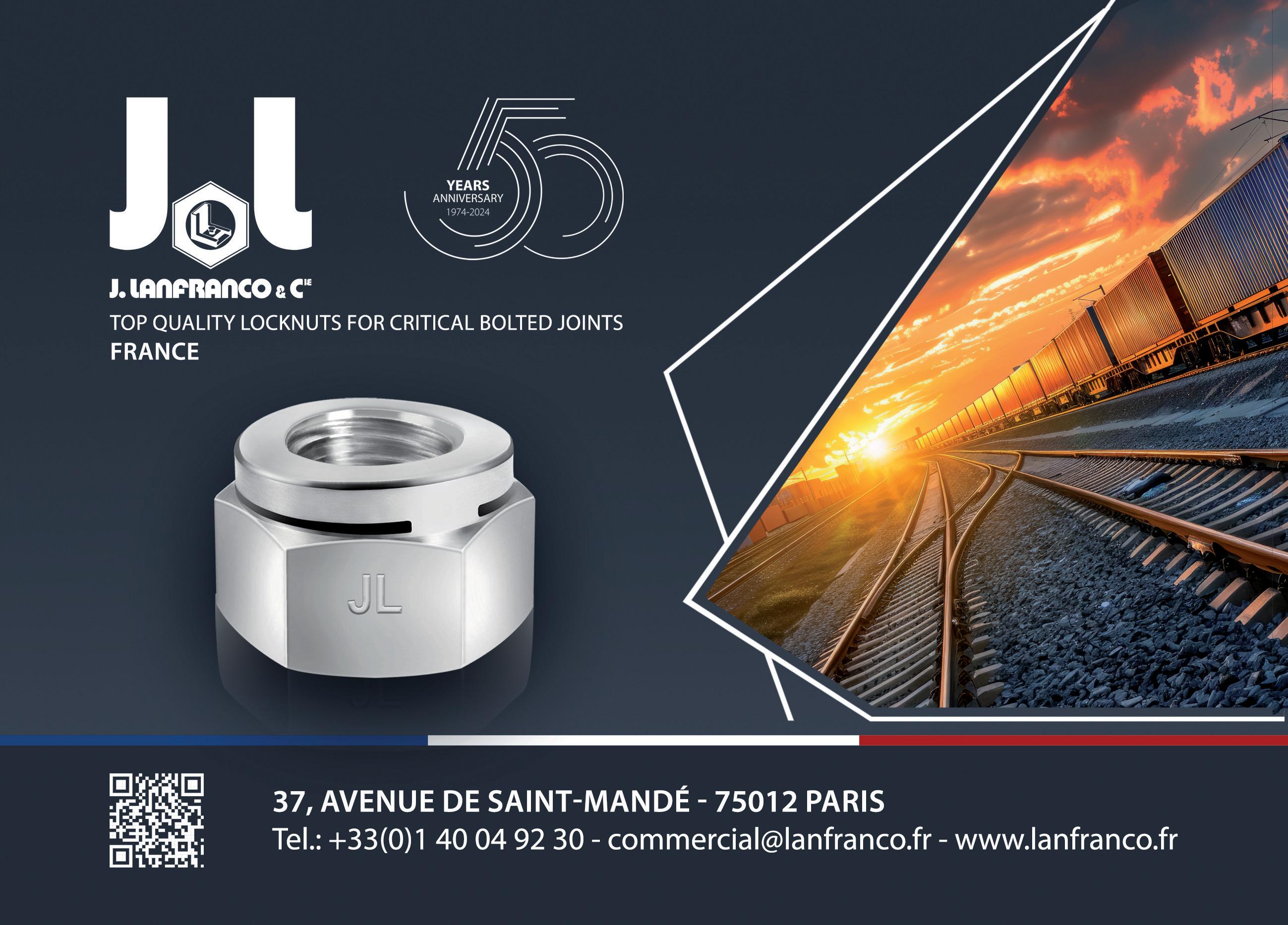


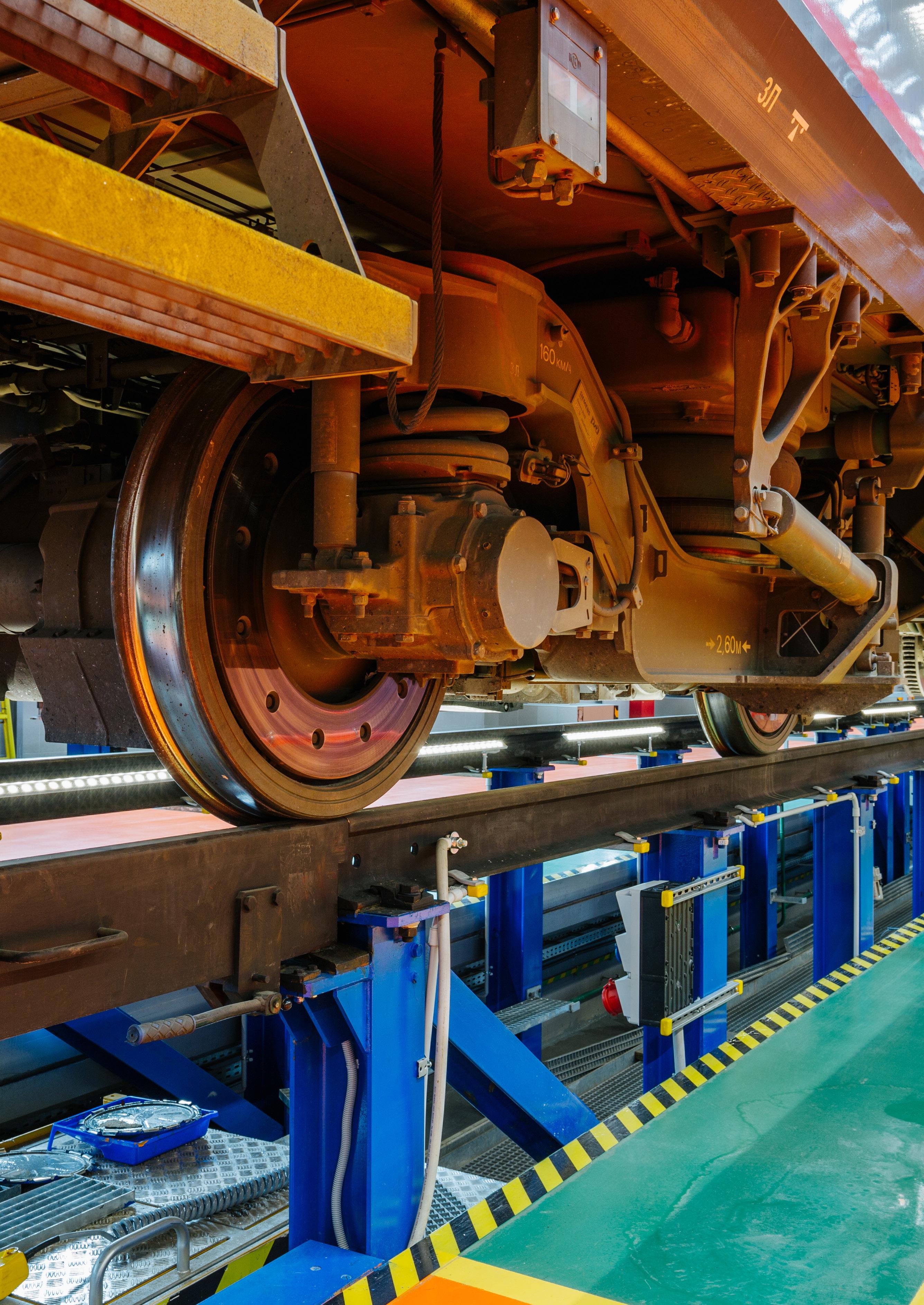

Financial Services
KfW IPEX-Bank p.96
Simulation & Testing Services
netwiss p.99
Staff Training & Recruitment
Stahl Recruiting p.102
Quality Managment
TRIGO p.105

An Interview with Sebastian Blum, Global Head of Mobility at KfW IPEX-Bank
In an insightful conversation with RailwayNews, Sebastian Blum, the newly appointed Global Head of Mobility at KfW IPEXBank, highlights the bank’s commitment to facilitating the transition towards sustainable transport.
He sheds light on the challenges and opportunities within the rail industry, the current infrastructure landscape in Germany, and the synergies being created across various transport sectors to achieve a greener future.
Railway-News: First of all, congratulations on your new position as Global Head, Sebastian. What impact will this have on the business orientation of KfW IPEX-Bank?
KfW IPEX-Bank: Many thanks.
KfW IPEX-Bank merged 7 sector departments into 4 at the beginning of 2023 – one of them is Mobility which comprises Maritime, Cruise, Aviation as well Landbased Transportation. We see advantages to bringing all asset-based sectors under one roof and to gain respective synergies. Within our strategy, Mobility plays a key role as the department supports the transition of the transportation sector – identifying ways to reduce carbon emissions in the shipping industry, actively following the developments in the field of sustainable aviation fuels or supporting projects on the land-based side aimed at improving public transportation and increasing the modal split of rail freight.
I’m happy to lead the department as a global head and to
speed up this transition together with our clients and all my colleagues.
RN: As a specialist financier in the field of transport and infrastructure and with a focus on responsible banking, you have deep insight into the current state of affairs with regard to moving away from more polluting transport modes. What are some of the challenges here? Rail has long been hailed as one of the greenest powered forms of transport for both passengers and goods. Are there challenges specific to the rail industry that other modes of transport are not experiencing in the same way?
KfW IPEX-Bank: I agree. Rail is widely considered to be green. But obviously not all tracks are electrified –neither on main lines and even less in respect of last mile connectivity. Thus, hybrid solutions including batteries or charging stations will play a significant role in order to bridge the gap. The dependency on infrastructure is an essential element when we are looking at the rail sector.
Another aspect to mention here is regulation. The EU taxonomy tries to create a framework in order to focus on particularly eligible transactions. But when reviewing the details, you may see that the current rules are quite complex in respect of rail. My favourite example is that a fully EU taxonomy-compliant financing of a stretch of an electrified rail work track requires control over the transported goods as well.
In case this track is used e.g. for the transportation of fossil fuels, the financing would be not compliant any more. But do financiers and borrowers always have such control?

I’m confident that further discussion may lead to further improvements. Together with other banks we have prepared a working paper within our membership in the Allianz pro Schiene, describing the restrictions of the current regulation in more detail.
RN: You finance projects on an international level, but you are a German company. What is the current situation in Germany? I hear stories of underinvestment in infrastructure – rail infrastructure as well as other transport assets such as roads, bridges, tunnels and so on. Would you say there is a lack of political will or is the current geopolitical climate particularly difficult?
KfW IPEX-Bank: Well, there is a political will and I’m quite optimistic that we will see certain infrastructure improvements even in the near future. Investments in infrastructure are costly and take some time. The planned modernisation of the most important corridors will improve the reliability of the entire German network materially – but until then, we will see further delays and congestion due to the construction activities.
RN: You don’t just finance rail projects of course, you’re involved in financing for other land-based modes of transport as well as aviation and the maritime industry. For our readers who will be more familiar with what you do in the rail sector, could you give an overview of some of the projects you are financing in these other areas and what made them a good fit for you?
KfW IPEX-Bank: We are also financing e-buses and we are happy that we executed two transactions with international operators – Kinetic and Kelsian – this year.
"Rail is widely considered to be green.But obviously not all tracks are electrified – neither on main lines and even less in respect of last mile connectivity.Thus,hybrid solutions including batteries or charging stations will play a significant role in order to bridge the gap."
Sebastian Blum, Global Head of Mobility at KfW IPEX-Bank
As Global Head of Mobility, I’m also responsible for aviation and maritime industries where we finance a large variety of assets such as cargo vessels, ferries, cruise ships as well as the wind offshore supply chain. We support our clients in reducing the carbon footprint of their respective fleets by financing very efficient newbuilds which are futureproof due to their flexibility on alternative fuels or by financing retrofits of their existing assets.
RN: I asked you earlier if there were any challenges in the mobility transition that were affecting the rail industry in particular, but what are the similarities you see in the different sectors you are involved in and are there underlying factors here that made you choose to be involved in specifically these sectors?
KfW IPEX-Bank: In order to align with the 1.5 degrees target of the Paris Agreement, a major transition is taking place in the whole mobility sector. This transition is necessary but it won’t happen overnight. It

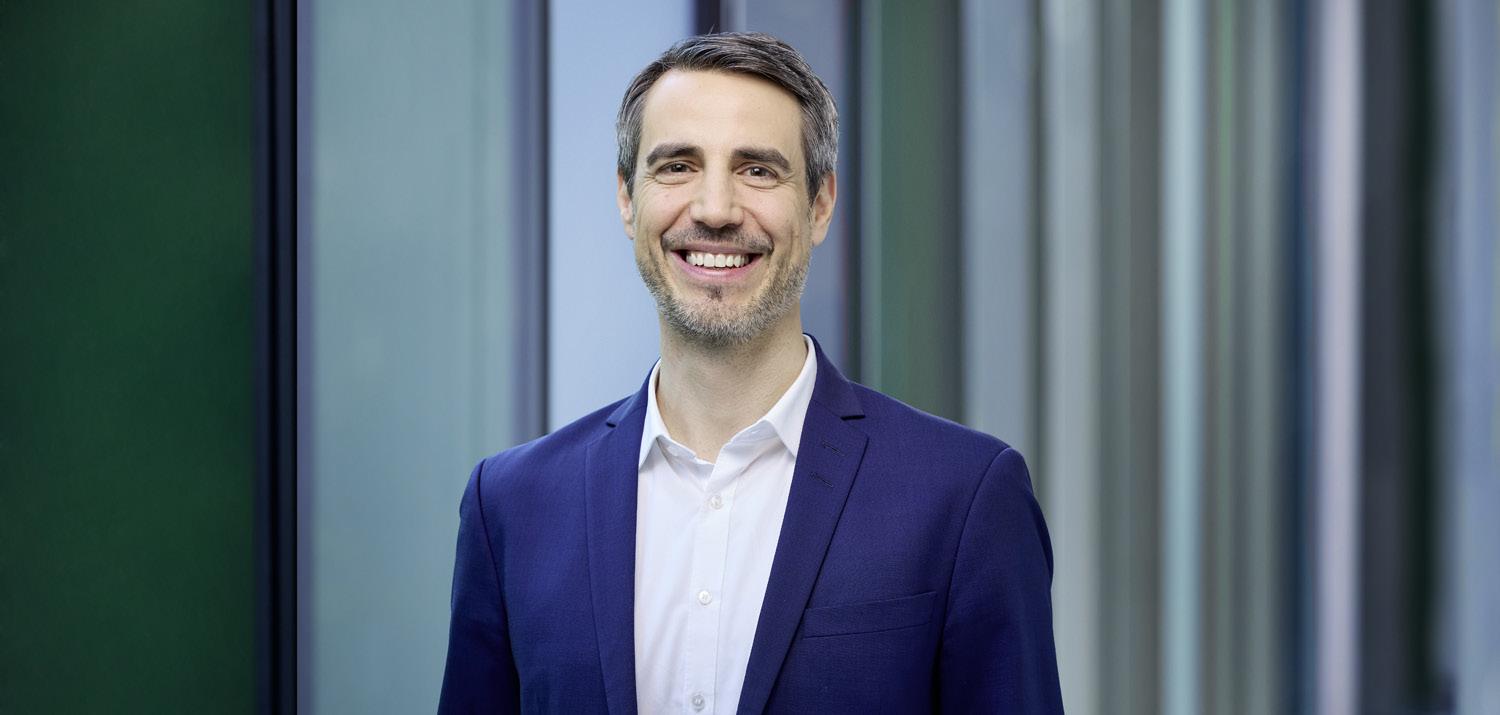
requires huge investments, and the pace is also mainly dependent on the available technologies, alternative fuels and existing infrastructure. From a banking perspective, we have to access all projects that have an acceptable technology risk and with which we can demonstrate, based on our portfolio, that we support the transition. Sometimes, interim steps are also fine and important in my opinion – e.g. financing assets with modern fossil drives which replace extremely old and inefficient ones.
RN: Are there any positive developments that you see between the different sectors? For example, one major source of revenue for airports is parking, but at the same time they are trying to be carbon neutral so enabling passengers to travel to and from the airport in more sustainable ways is desirable. What are some success stories where different sectors have collaborated well?
KfW IPEX-Bank: There is a development towards more and more fully integrated logistic companies –originally being just a shipping line or a port operator, and now offering the full logistic chain for the client from door to door – which quite often sees the combination of sea and rail transport including ports and cargo-handling infrastructure. This means that new players are entering the market and opening fully integrated services which increase the possibilities for the client to opt for a sustainable mode of transport. For me, it’s an interesting development and a good example of the collaboration among industries.
RN: Are there any projects you are currently involved in that you are particularly proud of that you would like to mention?
KfW IPEX-Bank: With regard to green financing, we have strengthened our capacities to offer green loans or sustainability-linked loans, including the respective advisory services. In this respect, we supported MFD Rail not only in their initial start-up phase by providing a first financing for the first intermodal railcars but provided additional advisory services which enabled the client to set up its entire green finance framework including second party opinion. It makes us really proud to enable projects that drive the transition towards a sustainable economy.
RN: Thank you so much for taking the time to talk to us today!
For more information contact
Sebastian Blum
Managing Director – Global Head of Mobility KfW IPEX-Bank, Frankfurt am Main, Germany (Headquarters)
sebastian.blum@kfw.de
Inter-City Trains
Night trains
High-Speed Trains
Local Trains
Light Trains
Metros
Busses
With TrainOptimizer® you can very easily and quickly check any vehicle layout with regard to its efficiency and thus achieve significantly shorter dwell time and higher seat occupancy with increased passenger satisfaction at the same time through targeted optimization measures.



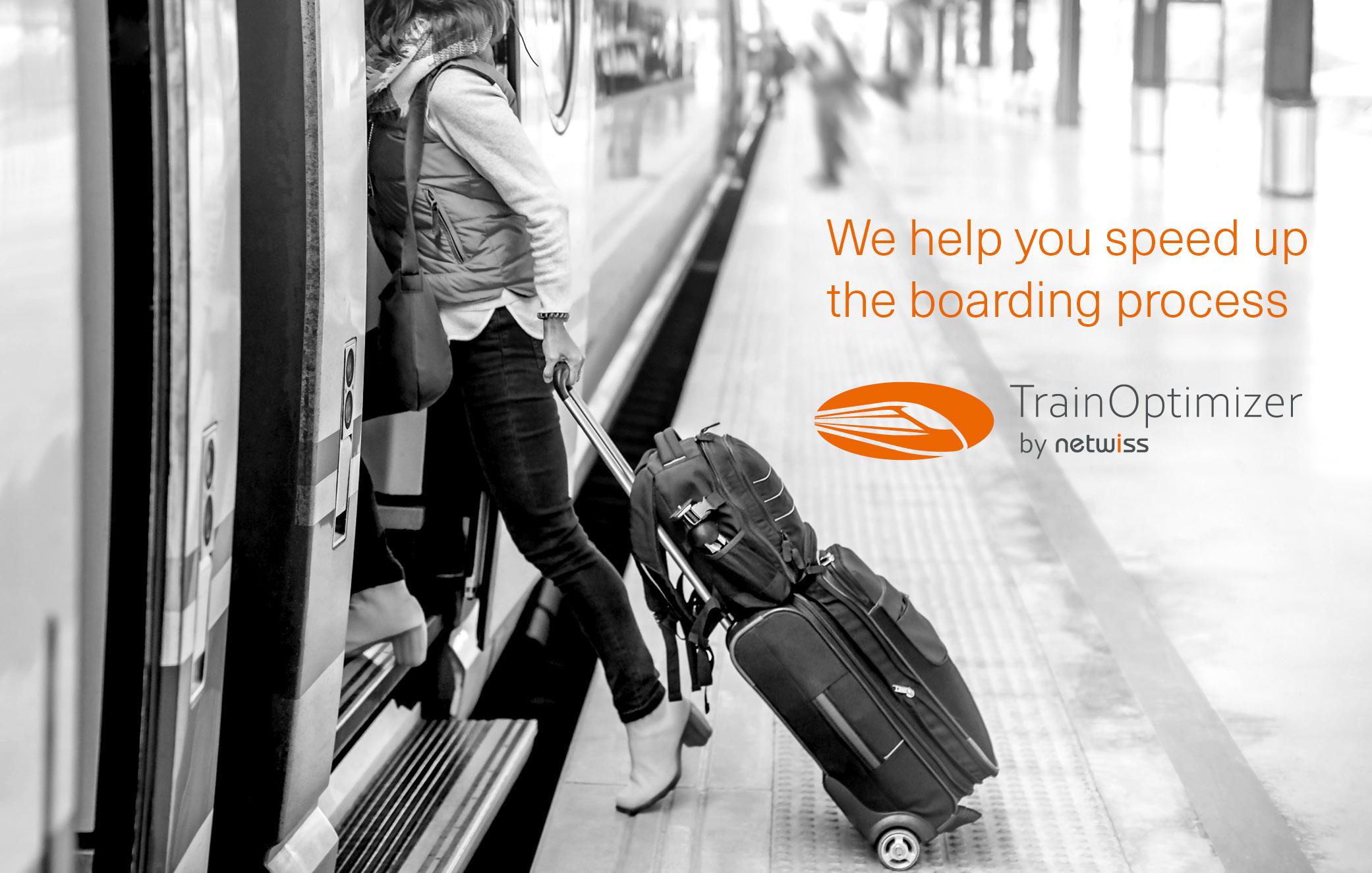
The focus on high passenger utilisation increases costs and energy consumption, while well-designed layouts save money and energy!
It is important for operators to transport as many passengers as possible in order to fulfil the requirements of transport policy and at the same time to improve their own profitability. A common
approach is to increase the number of seats on the train. However, this ignores important principles that ultimately lead to the following:
1. The potential number of people to be transported decreases!
2. Energy consumption rises!
3. The costs rise!
4. Punctuality falls!
5. Customer satisfaction falls!
Why? Incorrectly designed layouts mean that the luggage racks on one side are incorrect and undersized. As a result, only part of the luggage can be stowed and the remaining pieces of luggage obstruct seats and aisle areas. This leads to a decrease in available seats and to major problems when changing passengers, which means that this takes longer and punctuality decreases or a lot of energy has to be invested in making up for delays by travelling at higher speeds.
When the following points are taken into account when planning the vehicle:
1. Good choice of door arrangement
2. Sufficient and customised dimensions of the luggage racks
3. Good distribution of luggage racks in the carriage
... then the following is achieved:
1. Reduce passenger changeover times by up to 70%!
2. Increase seat utilisation by up to 20%!
3. Reduced energy consumption on the track by up to 20%!
In addition, there will be a significant improvement in punctuality, comfort and passenger satisfaction.
With our TrainOptimiser® service, we are setting new standards in advising rail operators, the vehicle industry and anyone involved in the procurement and ordering of vehicles. Using simple measures, we show you how you can improve your layouts and significantly increase the efficiency and cost-effectiveness of your vehicles. Over 20 years of scientific research into passenger behaviour and the analysis of hundreds of thousands of passengers during rail journeys from our knowledge base, on which companies such as DB, SBB, ÖBB, Siemens, Alstom and many more have long
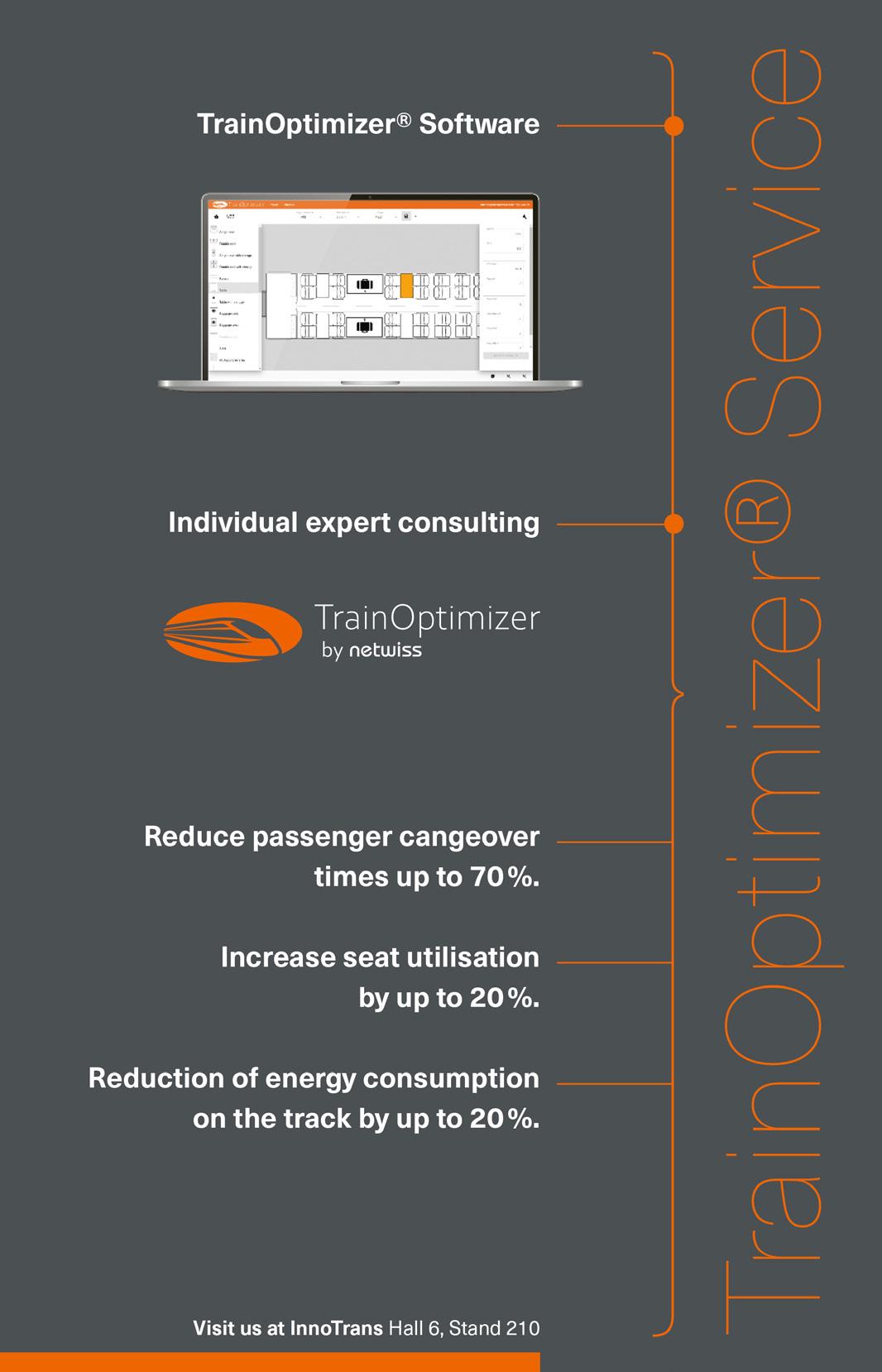
relied. We have been able to significantly increase the efficiency of projects such as ICE3 neo, ICE4, ICE-L, Railjet, Railjet 2, Nigthjet and many more!
We offer TrainOptimizer® software to anyone who wants to check and optimise layouts independently. This makes it very easy to create layouts and improve them in terms of passenger changeover time, luggage storage and seat usability.
Curious? Visit us at InnoTrans in Hall 6.1 at Stand 210 or watch our videos at www.TrainOptimizer.com. You are also welcome to use a trial version at any time!


Stahl Recruiting is not just an executive search firm; it's a connector, fostering meaningful partnerships between talented individuals and industry-leading organisations within the North American rail transportation and infrastructure sector.
Founded by Andrew Stahl, a passionate and experienced leader, Stahl Recruiting understands the unique needs and challenges faced by this dynamic industry. This deep understanding translates into a laser focus on cultural fit, ensuring a perfect blend of skills and values for both clients and candidates.
Beyond simply matching resumes to job descriptions, Stahl Recruiting takes a holistic approach. They delve into the DNA of both sides, exploring their values, work ethic and cultural preferences. By understanding an organisation's history, team dynamics and strategic goals, Stahl Recruiting identifies individuals who
not only possess the required skills but also share a fundamental alignment with the company's vision and culture. This commitment ensures long-term compatibility, setting the stage for a synergistic relationship that transcends technical qualifications and lays the foundation for sustainable success.

“Our approach is more relationship-driven than transactional,which helps us stay updated with the changing layouts of the macroeconomy,” says Andrew Stahl, Founder and President of Stahl Recruiting.
Stahl Recruiting recognises the importance of staying ahead of the curve. They actively engage in industry events hosted by industry associations, such as Railroad Day on the Hill, fostering relationships with key players and staying abreast of emerging trends. Their commitment is further demonstrated by Anabelle Cormier, the Director of Operations who serves as a membership committee chair for the Texas Short Line and Regional Railroad Association. This active
“Our approach is more relationship-driven than transactional,which helps us stay updated with the changing layouts of the macroeconomy.”
Stahl, Founder and President of Stahl Recruiting
participation grants them valuable insights into industry challenges and opportunities, allowing them to provide strategic guidance to clients and futureproof career advice to candidates.
Stahl Recruiting's dedication extends beyond service. They actively contribute to industry publications, participate in advocacy efforts and even act as a bridge between clients and potential partners for joint ventures including mergers and acquisitions within the rail space. This commitment strengthens their position as a trusted partner within the North American rail community.
Stahl Recruiting's focus on building meaningful connections goes beyond words. They have consistently proven their commitment by facilitating successful collaborations and navigating complex situations. One example involved a European rail construction firm expanding into North America. Stahl Recruiting leveraged its industry connections to guide them through unfamiliar territory, facilitating strategic acquisitions and introducing them to local M&A specialists. This collaborative approach ensured the client's smooth and successful integration into the North American market.
By upholding the values of honesty, integrity and ethics, Stahl Recruiting has earned its reputation as a reliable partner for building a sustainable future in the rail industry. Their dedication to fostering connections and understanding the intricacies of the sector has propelled their remarkable growth, solidifying their position as a true industry insider.
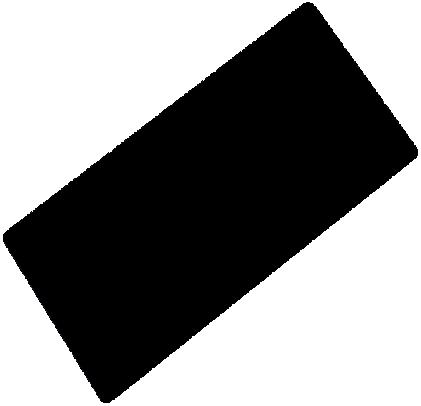










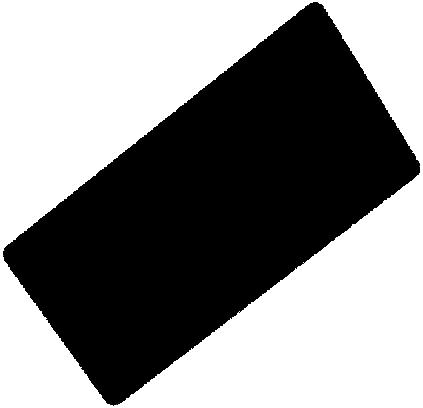
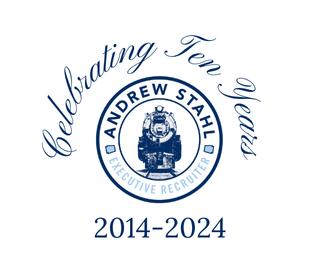





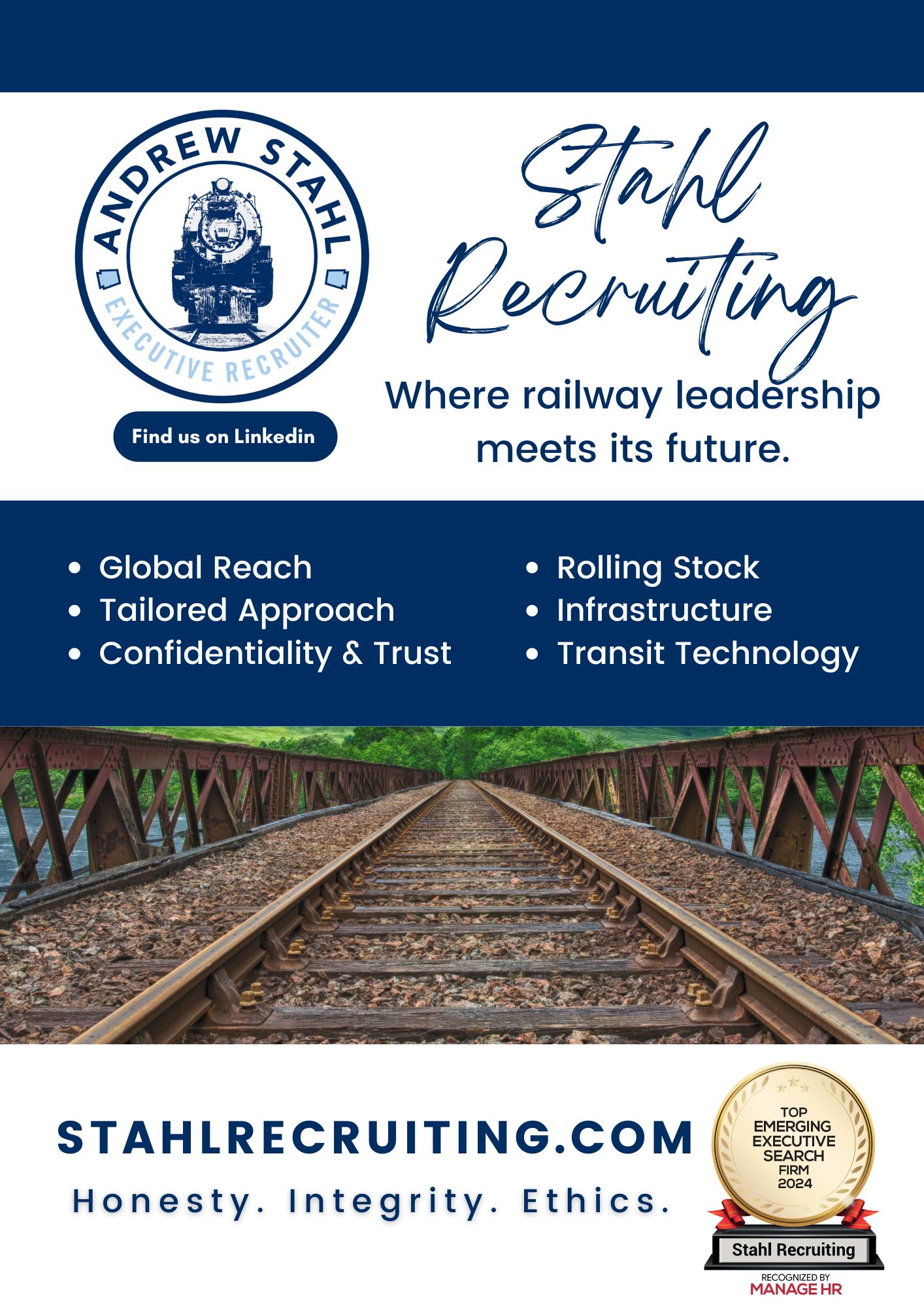
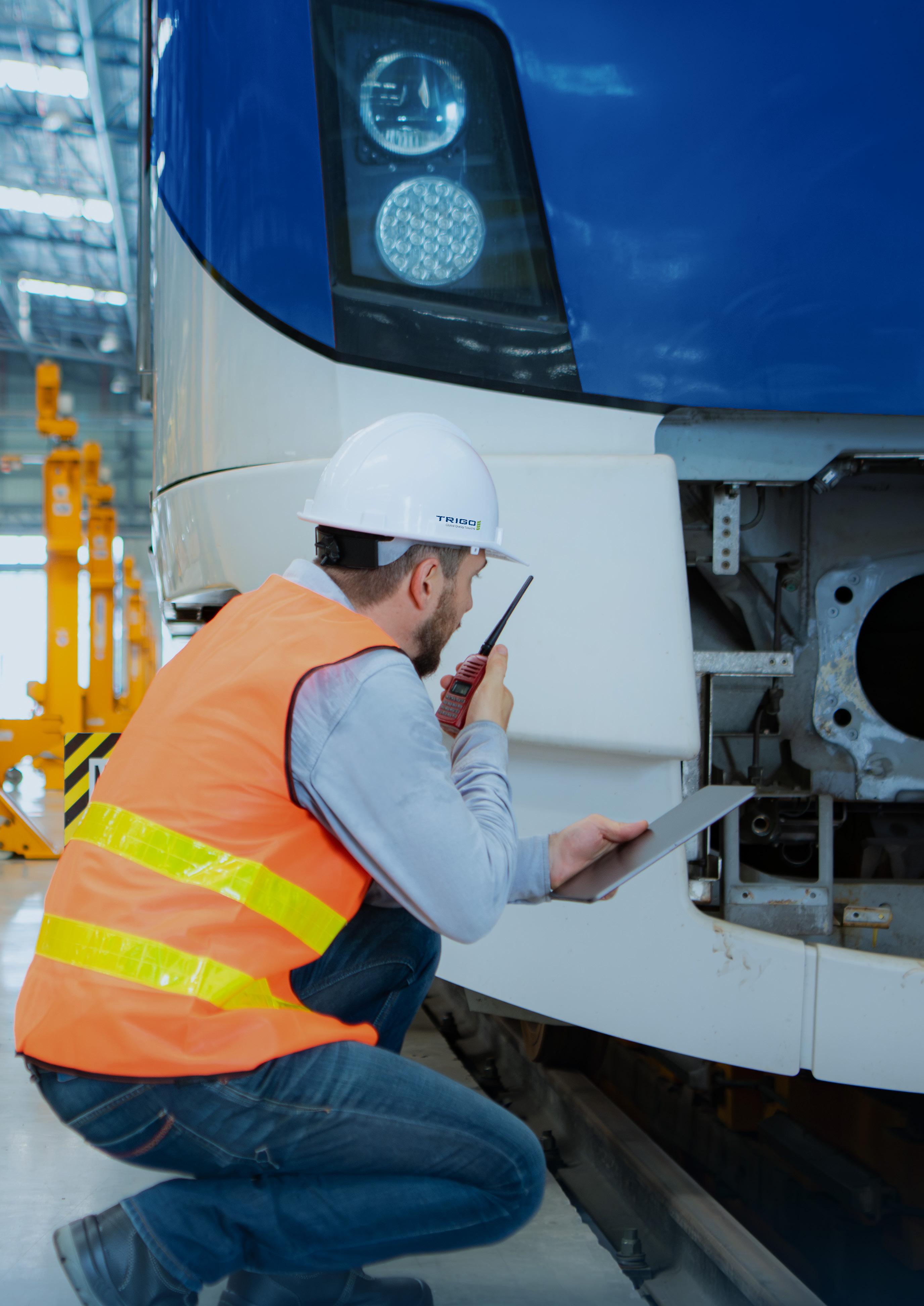

Interview with Jean Baptiste Pomar, International Business Manager, TRIGO Group
TRIGO is known as the leader in quality management services within the transportation industry worldwide. Could you elaborate on the type of services you provide to your clients in the rail industry?
TRIGO has been a pioneer in quality management services for over 25 years, particularly in the aerospace and automotive sectors. Our mission is to deliver comprehensive quality solutions that enhance the efficiency of industrial supply chains. With €500 million in revenue, TRIGO is present in 28 countries.
Our mission in the rail industry is to optimise performance and quality throughout the supply chain, mirroring our approach in other sectors. Since 2010, we have focused on quality control and rework services for Alstom in France, with incoming inspection remaining a key foundation of our services.
Over the years, we have significantly broadened our scope. Today, our expertise includes:
• Non-conformities management solutions: We address quality and delivery issues through 8D or QRQC methodologies, ensuring swift resolution and prevention of future occurrences
• Supplier development services: This includes resident engineering, audits, capacity assessments, first article inspections and training on essential quality tools
• Manufacturing support: Our services extend to mechanical and electrical maintenance operations, non-destructive testing (NDT) and rework of parts to ensure they meet the highest standards
In 2024, our teams have been working directly in over 20 rolling stock manufacturing sites and over 100 key suppliers in the rail industry worldwide. We have performed a +30% growth since 2023.
TRIGO's key strengths lie in both our strategic positioning and at the same time a comprehensive and operational expertise.
The fact that we are embedded within manufacturing sites, maintaining dedicated quality control areas gives us a close proximity which enables us to respond swiftly and effectively to any arising issues.
Our mobile experts can intervene within 48 hours to address quality or supply chain issues globally. Our international project managers, who serve as singleentry points, efficiently coordinate this rapid response.

Besides our responsiveness, our team leaders, site managers and operational directors take a strategic view, implementing the best solutions for our customers, ensuring well-considered and effective interventions.
Finally, both our reactive HR and innovative data management and reporting tools underpin our operational excellence.
Since 2022, TRIGO has developed a significant expertise in special processes, including welding, glueing, wiring, torque tightening and painting. Our consultants are frequently called upon to deploy technical requirements, audit process reliability and train operators in these specialised areas.
You operate in 28 countries worldwide. How does this extensive geographical presence benefit your clients in the rail industry?
Our extensive geographical presence offers numerous benefits to our clients. Our deep understanding of cultural differences minimises communication errors that can lead to quality issues and production disruptions. For instance, managing a maintenance quality team for the monorail metro in Bangkok requires a different approach than managing an incoming inspection team for regional trains in Berlin. The best practices are not only implemented but also adapted to fit local requirements and conditions.
With delivery sites in every strategic market, we are positioned to think globally and act locally. This strategic presence allows us to provide tailored solutions that meet the specific needs of each market whilst maintaining a global standard of quality. We also support our clients’ expansion into new regions by offering the same high level of service and expertise wherever they go.
The rail industry is facing specific challenges. What pain points are you able to address, and could you share some examples?
The rail industry is indeed experiencing a period of significant growth and transformation. Massive government investments in countries like the USA, India and Canada are stimulating the rail industry. Additionally, sustainable development initiatives are driving the rise of green mobility. These initiatives are

creating demand for rolling stock that offers higher seat capacity and better passenger experience whilst simultaneously reducing energy consumption and maintenance costs.
TRIGO addresses these industry challenges through specialized expertise and taskforces. To help our clients meet On Time and On Quality Delivery (OQD and OTD) KPIs, we offer the following a range of targeted services:
• Battery Manufacturing Expertise, crucial for energy storage in rail (we ensure quality and efficiency at a battery manufacturing site),
• Quality Wall Resources (bottlenecks in welding processes are solved, minimizing production delays and quality issues),
• Enhanced Project Management (APQP gate reviews to proactively address potential issues early in the project lifecycle),
• Supplier Support (key suppliers are able to scale operations without compromising quality).
Our approach combines technical expertise, strategic project management, and on-the-ground support to help clients meet their goals. Visit us at InnoTrans to discuss your challenges and explore how TRIGO can support your projects!
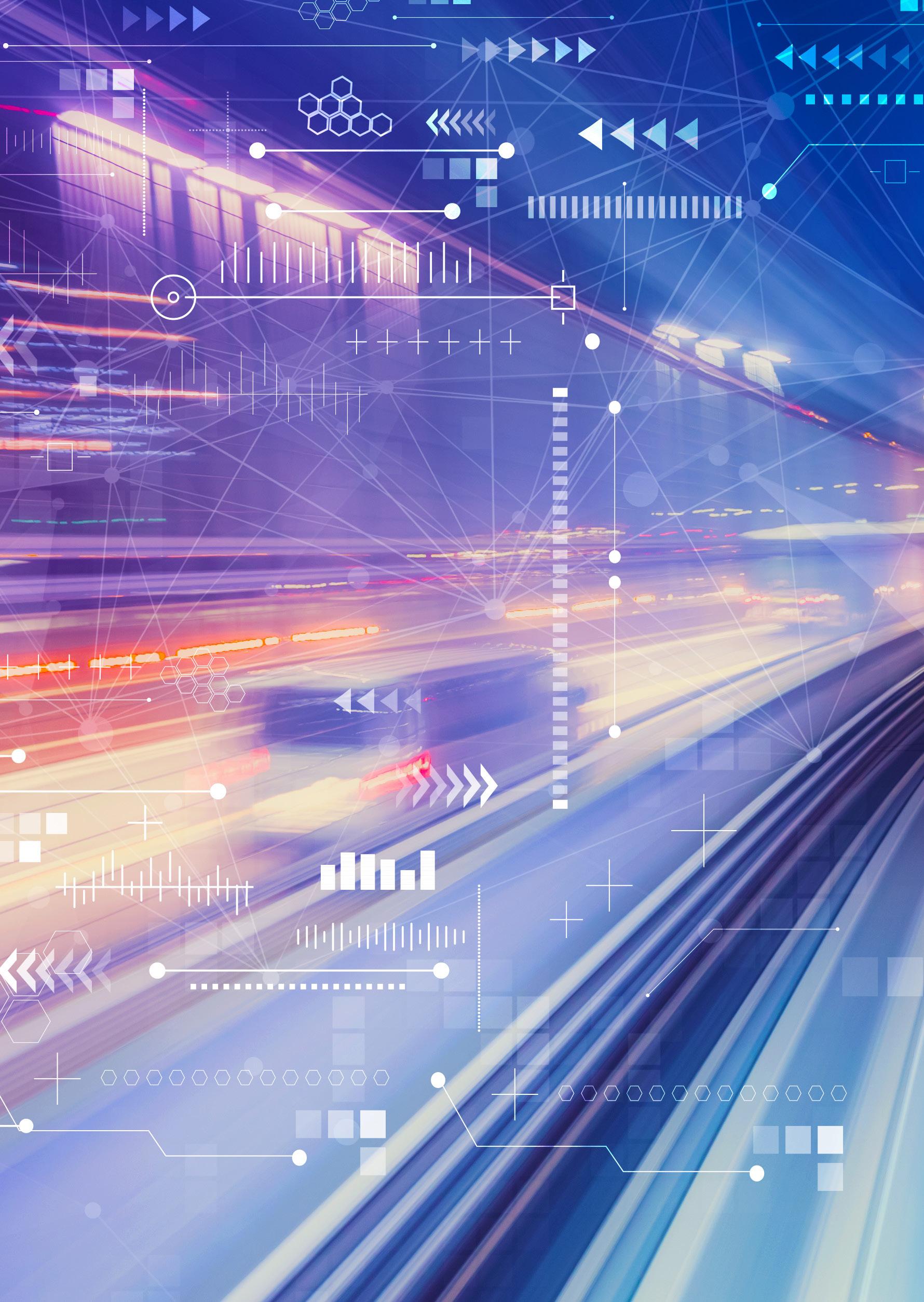
VIAVI Solutions p.110
p.113
Holmberg GmbH & Co. KG p.116
Nomad Digital p.118
Frequentis p.121
Computers, Sensors, Big Data ADLINK Technology p.124
Vision Ltd p.126 ImpactSentinel by INGLAS p.128
Senceive p.130 SENSIT s.r.o. p.133
Edge Computing NEXCOM International Co., Ltd. p.134
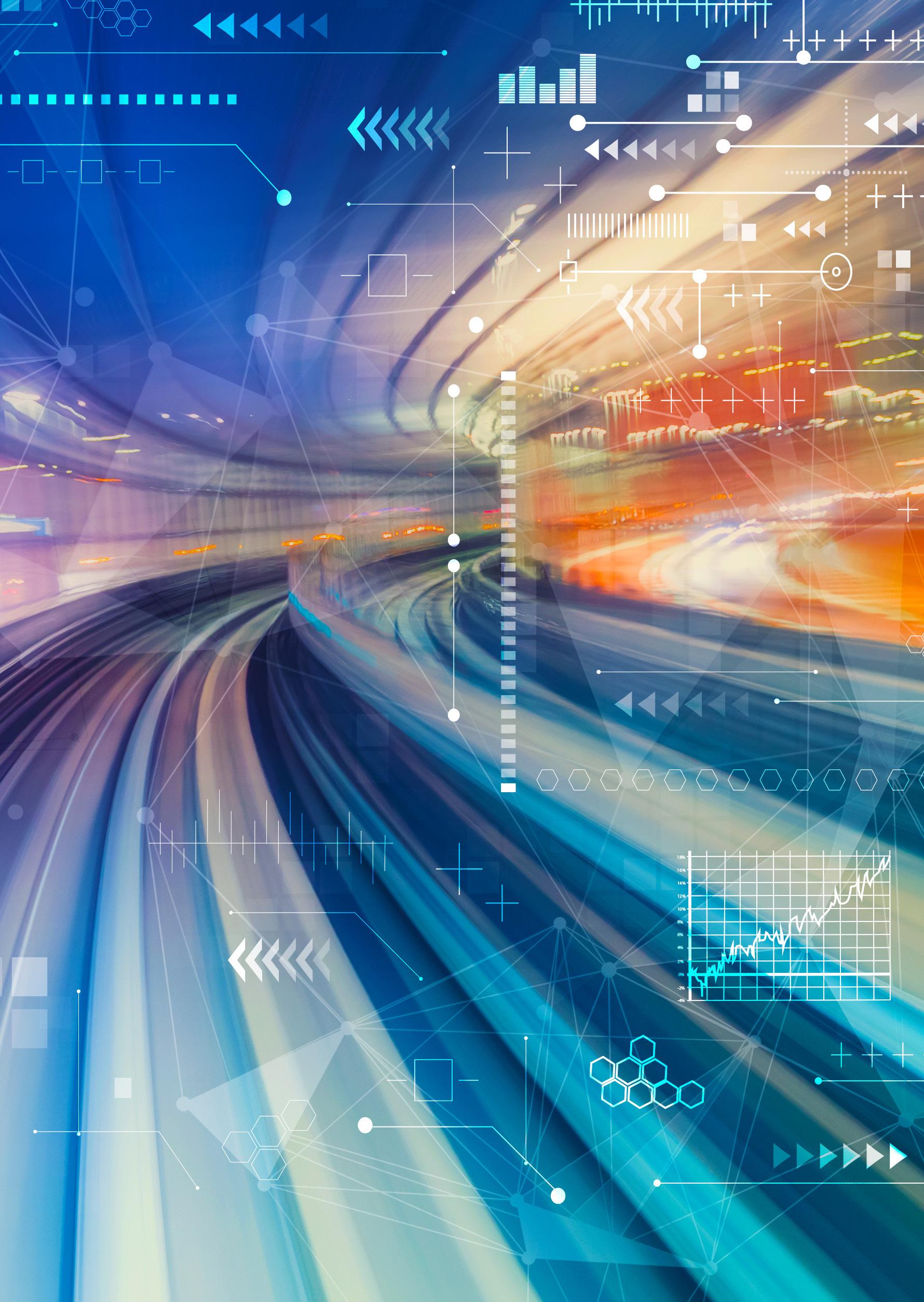
Esri p.137
Viper Innovations p.140
Frauscher Sensor Technology p.143
Digital Solutions
Cohesive p.146
Transmission Dynamics p.148
Duos Technologies, Inc. p.151
Astronics p.154
Trimble p.157
Passenger Infotainment
Televic GSP p.160
Daktronics p.163
CN-Consult p.166
ASC Sensors p.169
Planning & Management Software
Ab Ovo p.172

By Max Beccuti, Railway Product Line Manager, VIAVI Solutions
The transition from GSM-R to the new Future Radio Mobile Communication System, FRMCS, is set to digitally transform the railway industry.
As GSM-R is due to become obsolete in Europe in 2035, FRMCS offers a future-proofed solution, with greater efficiency and safety advantages, thanks to more modern technology.
Several European operators have already started work on this huge undertaking and many more plan to do so, very soon, as the first national FRMCS tests are scheduled for 2026.
Drawing on over 20 years’ experience in GSM-R and practical expertise in mission critical networks running over 4G and 5G, these tips will be useful for anyone working on the journey to FRMCS.
GSM-R obsolescence may still be a decade away but as we know, that’s not long in railway lifecycle management.
The closer we get to the deadline, the harder it may be to find replacement parts and retain skills in GSM-R technology. These will be vital given the 5-year transition period, where both GSM-R and FRMCS will need to operate simultaneously.
Max Beccuti, Railway Product Line Manager,VIAVI Solutions

Therefore, it’s worth taking stock now of both physical and human assets and developing a plan for how these can be assured until the deadline is met and handover successfully done. For example, we are working with local higher education centres to ensure that GSM-R remains on the railway engineering syllabus, to continue to feed our talent pool.
Railway telecoms networks are an essential backbone of ERTMS operations. Emergency calls, voice calls and group calls for example, are all vital for safety; if the GSM-R fails, data calls cannot be made and the train cannot start or proceed.
Many rail operators use drive test tools to validate the telecoms network and check it periodically. Monitoring solutions via probes are also used to ensure that service assurance KPIs are met, ideally triggering alarms if levels fall below agreed standards.
As the train’s dependence on the network applies to GSM-R and FRMCS (especially in the 5-year handover period), it makes sense to use solutions that can monitor and troubleshoot both networks.
Using different solutions to test and monitor the GSM-R and FRMCS frequency domains may prove challenging, requiring internal calibration between the two, likely discrepancies between features and outputs, and duplication on training time.
However, using a single solution that can ‘switch’ between domains that utilises the same testing and monitoring equipment. This provides a more consistent user experience, makes it much easier to compare KPIs, identifies interference challenges and shows handover effectiveness. It should also prove more cost effective with regards to licences and upskilling.

hardware need to ensure their solutions remain fit for purpose today and for the many years to come.
The introduction of NIS2 and the Cyber Resilience Act and impending embodiment into national laws means that almost every system needs to be considered for vulnerabilities.
The same applies to railway networks, not just IT (ticketing etc), but also the OT, such as interlocking infrastructure, signalling and telecoms, as well as the RAN and core networks, and mission critical (MCx) application layers.
There are several solutions available but again, if you can choose a reputable one that’s integrated with existing tools and services, this will no doubt save you time and money, both in the short and long-term.
A newer start-up may have all the talk and impressive outputs, but as we have discussed, the railway has long lifecycles, so solutions with proven technology and services, may be a better overall proposition.
This brings us to my penultimate tip, a long-term maintenance agreement. Over the next 15 years or so, as GSM-R technology transitions to FRMCS, hardware may become increasingly hard to source or repair, and engineering expertise in the field will become scarcer.
After all, who wants to learn about technology that’s already over 20 years old, when digitalisation offers so many more exciting opportunities?
Tools providers using monitoring probes and drive test
A long-term GSM-R maintenance agreement is a useful way of ensuring that the monitoring and troubleshooting provider is committed to providing their services throughout this transition period.
A commitment such as this ensures the operator will have access to hardware and software technology that remains up to date, as well as that the necessary engineering expertise and skills will be available.
Finally, for my last tip, please remember that you are not alone! Many engineers, managers and executives are already working hard planning how to make the move from GSM-R to FRMCS.
There are lots of conferences and user groups where this is regularly covered, so please sign up and join in. Fees are often reduced for national operators, making it gentler on the budget.
And for those who can’t travel, please do use LinkedIn groups to raise issues and join any webinars you can! We are all in this together and for a long time to come!
Join us on Hall 6.1 Booth 215 at InnoTrans 2024.
Click here to sign up for our webinar Thursday 19 September 9.30 BST/ 10.30 CET: Introduction to MCPTT Drive Tests for Mission Critical Communications

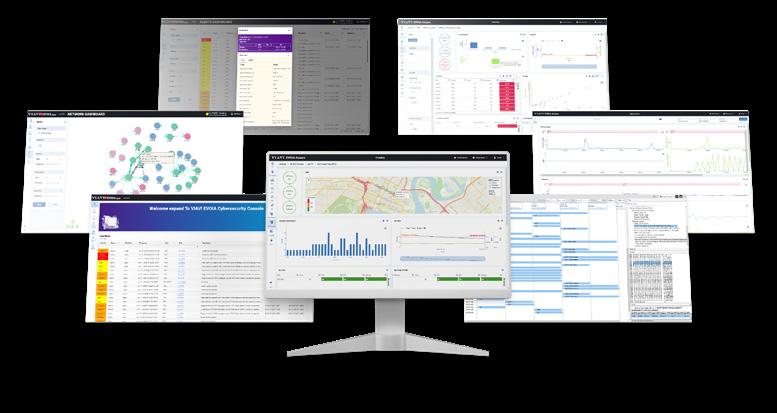
VIAVI Solutions offers market-leading tools for railway and other mission-critical operators. Our products support network technologies from 2G to 5G, ERTMS (GSM-R & ETCS), and the upcoming FRMCS networks. We prioritize safety with advanced railway cybersecurity solutions, ensuring protection against cyber threats and maintaining communication integrity.
Our sophisticated drive testing capabilities, whether onboard, mobile, fully autonomous, or designed to support radio engineers, enable thorough assessment and optimization of network performance across extensive railway routes. This ensures reliable connectivity and seamless communication, crucial for resilient railway networks.
Discover our solutions and meet our team of experts at InnoTrans 2024, Hall 6.1, Booth #215.
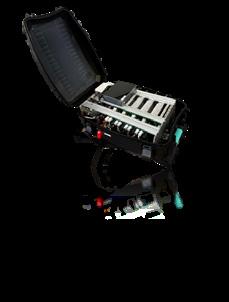
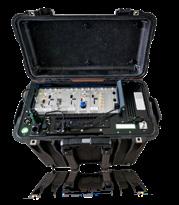
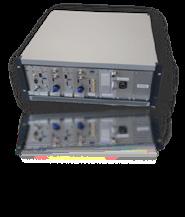

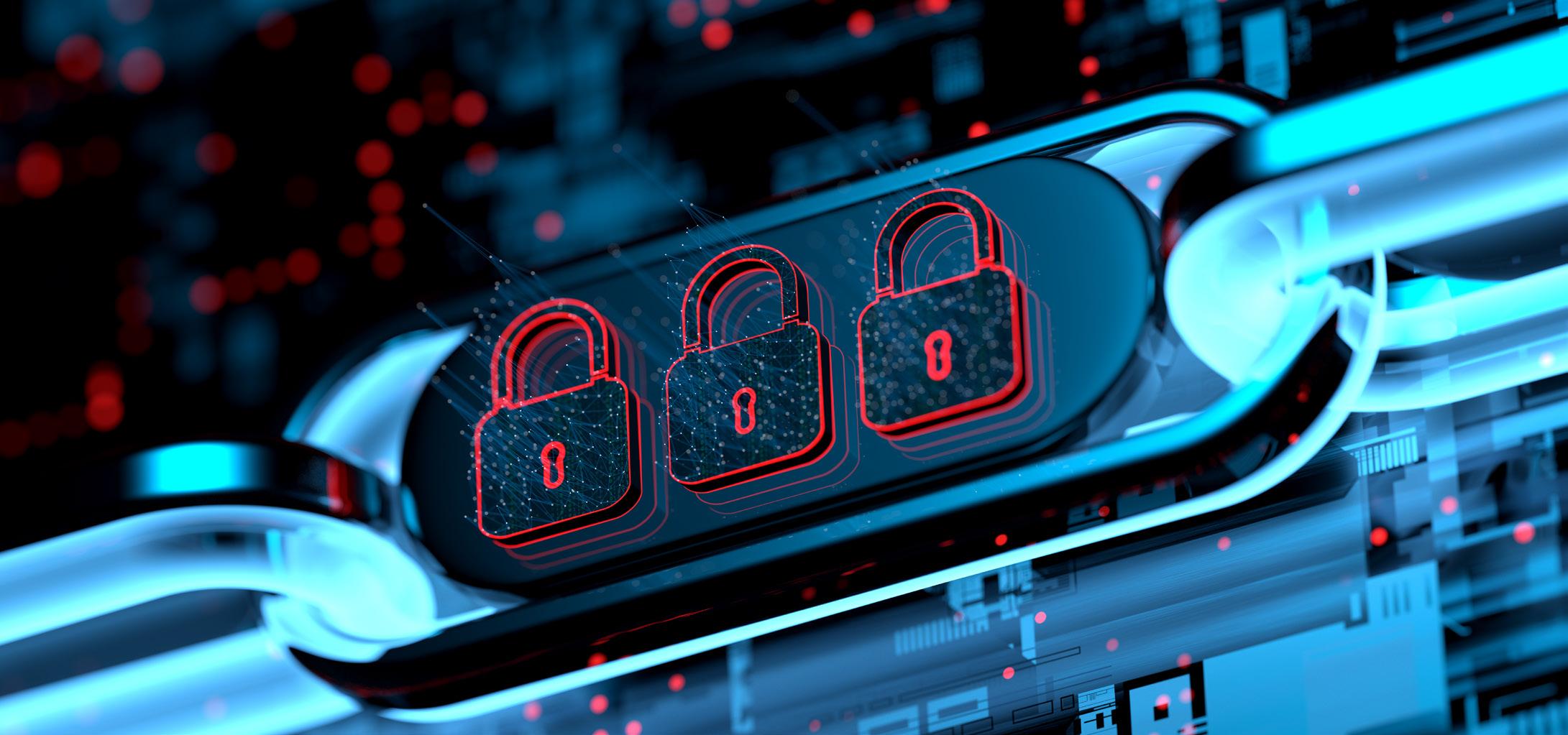
Digital technologies, like automation, Internet of Things, digital twins and newer initiatives in artificial intelligence, continue to bring crucial benefits to railway operators and their customers.
But with railways being prime public targets and digital systems becoming more widespread, they face escalating cyber threats — including the emerging risks with advances in quantum computing. With that in mind, what’s the best way for railway operators to protect their assets and their communities, now and in the future?
The first step is to gain a thorough understanding of some of the current and emerging risks, so you can maintain a comprehensive security framework to minimise dangers.
The digitalisation of railway operations creates more complexity and inter-dependencies between systems, and that offers hackers more ways to intrude. The most vulnerable links are often found in communications systems, as noted in a March 2023 report by the European Union Agency for Cybersecurity (ENISA). But the report also predicted that groups would soon target operational technology (OT) systems, which proved to be true within six months.
For example, in September 2023, the electrical infrastructure of Israel’s railroad network was attacked by state-sponsored hackers using a phishing campaign. And one month earlier, the integrity of the Polish national railway network’s radio signalling system was compromised by another group of state-sponsored hackers who issued a false command that stopped 20 trains.
Hackers are developing new twists on three standard types of attack.
• Eavesdropping is common in IT-based intrusions, where sensitive data is collected, such as login information, operating commands and system control messages. This data isn’t always acted on immediately. Hostile groups can simply use it to learn more about how the systems work for devastating attacks later. Or, in the quantum era, it can be part of a ‘harvest-now-decrypt-later’ exploit. That means encrypted data is held until hackers possess quantum computing powers that can decrypt what they’ve collected.
• Man-in-the-middle attacks take eavesdropping to the next level. That is, they not only monitor communications, they also modify them. The attack on the Polish rail system reported by ENISA would have worked this way, by modifying system commands to stop 20 trains. Anything is possible if the signalling system is compromised, which includes sending conflicting interlocking (IXL) signals to cause a head-on collision.
Denial of service (DoS) attacks compromise the
legitimate senders. The sheer volume of traffic overwhelms the systems, leaving them unable to execute essential tasks. For example, a DoS attack could overwhelm a railway’s traffic management system in a control centre, so that it’s unable to effectively control train movements across the network.
As hackers probe for weaknesses in complex and interdependent systems, encryption offers a fundamental tool for protecting data integrity. In the simplest terms, it scrambles messages when they’re sent and unscrambles them when they’re received. If hackers capture this data ‘in flight’, they will find it meaningless, without the decoding scheme.
The security level of these schemes (or algorithms) depends solely on the intense computational efforts required to decode them. The goal is to make the effort and money required to break the code so great that it outweighs the potential reward of having the data. Unfortunately, however, the speed of quantum computing may render many of today’s most popular public key encryption algorithms ineffective, including Diffie-Hellman and Rivest-Shamir-Adleman (RSA).
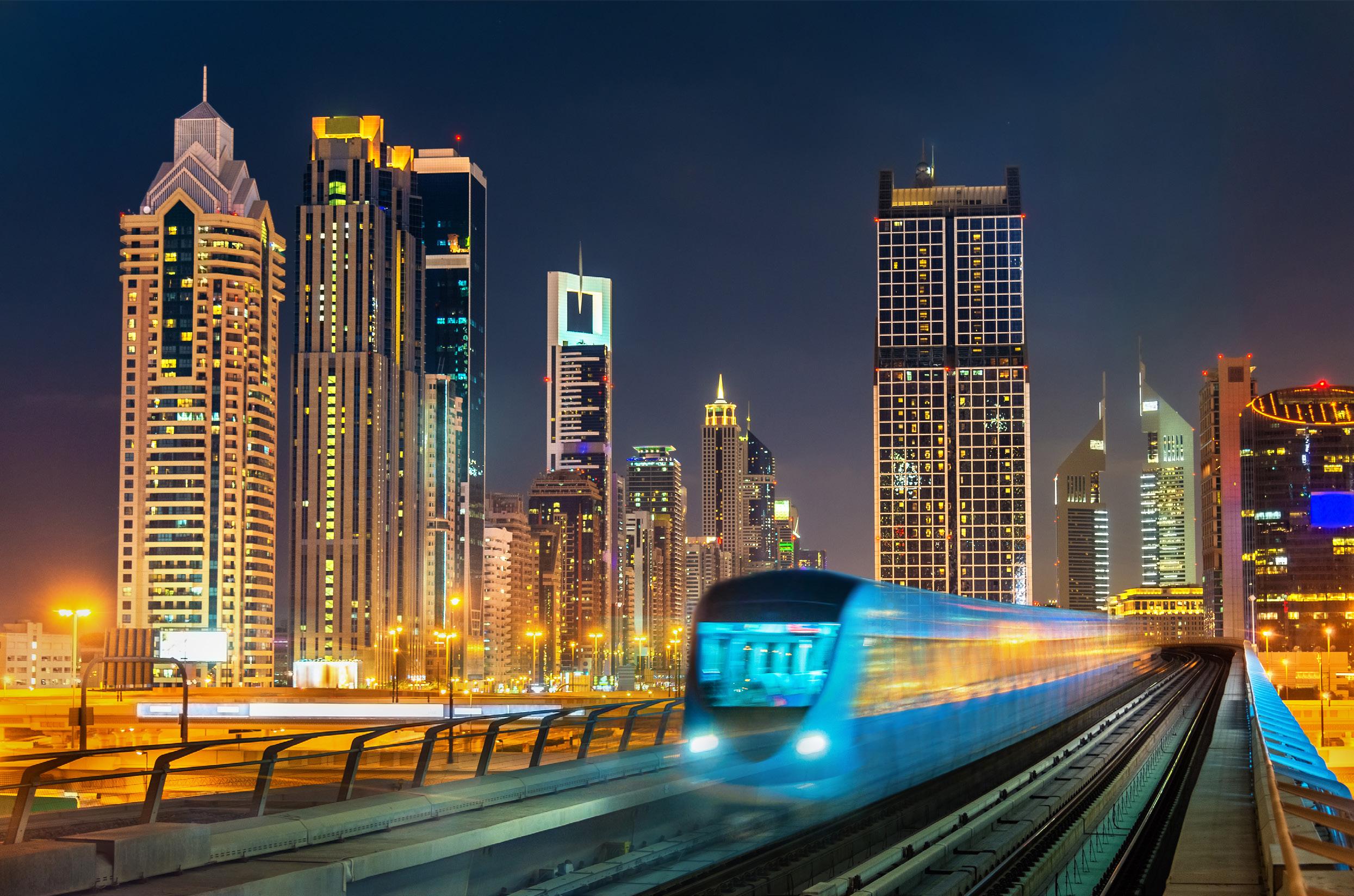
Securing tomorrow: quantum-safe networks for railways
While cyber security for individual network elements is essential, comprehensive in-depth security needs to be considered just as carefully. That’s because many of the most vulnerable points of a railway system are in the interstices and communications between subsystems. Therefore, a holistic defence-in-depth security framework is required.
To secure data transport, rail operators must meet wellestablished standards already set out by regulators — as OT data flows through the various dense wavelength-division multiplexing (DWDM) switches, Ethernet switches and Internet Protocol (IP) and Internet Protocol Multi-Protocol Label Switching (IP/ MPLS) routers.
In addition, traffic encryption must be strengthened, using a robust key distribution server and symmetric key encryption. For example, advanced encryption standard (AES) with a session key length of at least 256
bits currently offers robust initial protection against quantum attacks at the network transport layers.
Post-quantum cryptography algorithms designed to scale easily at the application layer will come later, providing further protection for network users. To establish a quantum-safe communications network, defence-in-depth requires implementation of multiple protection mechanisms.
While digitalisation brings many rewards, security is a pressing concern. By taking a holistic and conservative approach, rail operators can help ensure the safety of our transport by protecting sensitive data, maintaining the integrity of operations and safeguarding against potential disruptions.
www.nokia.com
For more detailed information on how to boost railway security in the quantum era, download our white paper, Strengthening railway communications network security.


Be successful in competitive markets: our high-quality communication solutions enable you to meet any challenges, from rescheduling to ensuring punctual transportation.
Rail and freight transport are the backbone of the global economy: energy efficiency, cost-effectiveness and reliability are essential in modern transportation. Both clients and suppliers need to be able to quickly react and reschedule at short notice to remain competitive. Meeting such challenges requires a flexible organisation as well as reliable communication. Thanks to our high-quality products, you can rest assured that your goods will arrive at their destination safely and on time.
Holmberg was founded in 1919 and has been familyowned since 1951. In the heart of Berlin, Holmberg develops and produces electroacoustic equipment for professional use. Our products are known worldwide under the brand name HOLMCO for their excellent speech intelligibility and reliability.
At Holmberg, we manufacture dynamic transducers, microphones, headsets, handsets and control stations according to the highest quality standards. Our products are used in many fields such as aviation, railroads, police and fire brigades, control centres, logistics as well as maritime industry.
Holmberg believes that every customer is unique and develops individual solutions tailored to their specific needs. As a third-generation, owner-managed family

business we stand for openness, trust, reliability, loyalty, fairness and cultural diversity. Our commitment to quality is underlined by the EN 9100 certification.
Since 1957, Holmberg has established its products in the aviation space and is an officially approved and licensed manufacturer. Approved by EASA, product development is carried out according to ETSO standards. Additionally, Holmberg's management system is certified according to the environmental standard DIN EN ISO 14001 and has been awarded the EcoVadis Bronze Medal.
Our goal is to build long-term partnerships with customers. We strive to be a trustworthy partner that always communicates transparently and openly.

Our handsets from the Funk 75 series are wellestablished in the driver cabs and passenger areas of trains, providing reliable high-quality communication. We also provide handheld (MH-50) and gooseneck (MG-50) microphones which are ideally suited for use in mobile as well as stationary environments.
Our microphone, with its timeless design, is characterized by its robustness against mechanical influences such as impacts and also guarantees high flame resistance. The smooth surface is easy to clean and ensures a very comfortable haptic.

Offering a choice between dynamic and electret transducers, the microphones provide first-class audio quality in the near (approx. 5 cm) and far (30 cm to 100 cm) ranges. For mobile use, we offer solutions with coiled cables with lengths of up to several meters. For stationary applications, the microphone heads can be mounted on various goosenecks with lengths varying from 100 to 900 mm. We continuously iterate on our technologies to guarantee effective suppression of structure-borne sound and environmental noise.
Thanks to the selection of robust materials, our products are exceptionally reliable and long lasting. Their excellent design makes them also very simple to maintain: all components are easily accessible and replaceable.
Additionally, HOLMCO microphones as well as handsets can be adapted to many situations. We offer a choice of in-house developed transducers, which allows adjusting recording angles, resulting in improved signal-tonoise performance. Recording from all directions is referred to as omnidirectional and can be optimized by design to a supercardioid polar pattern, which enables effective noise suppression.
We can provide various standard and customized interfaces, e.g. the assignment of the up to three buttons according to your specification.
Customers benefit from our experience - ideal for clear and reliable communication in very demanding environments.
Click here to watch our video and find out more about Holmberg GmbH & Co. KG.
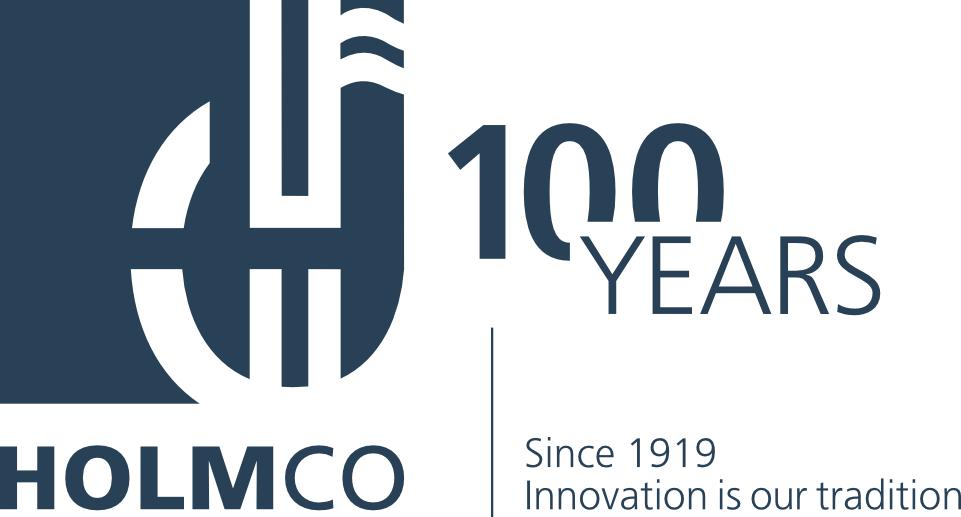
Contact us
Website: https://holmberg.de/en
Phone number: +493061780221
Email: rail@holmco.de
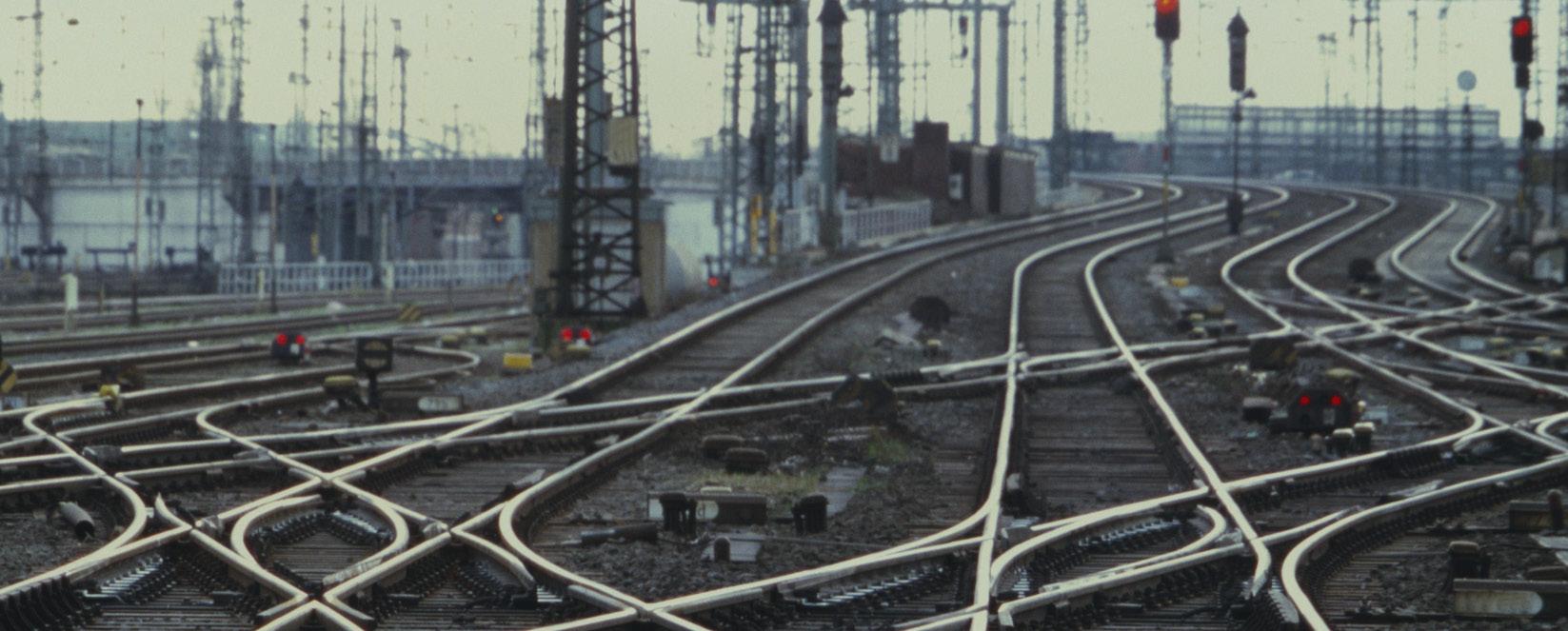


technology for a connected journey
team of experts
InnoTrans 2024
Stand 260 WORLD









Nomad Digital develops and delivers innovative solutions to support operators in understanding train loading and passenger behaviour.
On some fleets, passenger counting sensors mounted above doors provide a way to derive an overall passenger count on a train. However, these sensors are not present on all active fleets, and another solution is required to obtain this data. Nomad Digital can utilise multiple data sources to deliver a solution without sensors or enhance an existing passenger counting solution already installed.
By leveraging our expertise in delivering Wi-Fi solutions, our innovative technology can now track the number of devices in each car that is Wi-Fi enabled, even if they are not connected to the onboard Wi-Fi system or in use. Of course, counting Wi-Fi devices is not the same as counting people, as some may have more than one device, and some may have none or have Wi-Fi disabled. Our AI-driven analytics enhance this data to ensure the relative load is reported more accurately across a train. It can also track movement between coaches to identify issues with passengers finding a seat.
Our onboard solutions provide significant computing resources on board a train. Recent advances in the efficiency of AI-driven image processing systems allow us to use onboard CCTV to derive a highly accurate, real-time view of the loading of each coach. Our solution processes data locally. It does not use facial recognition and does not need to store CCTV or forward it off the train, respecting passengers’ privacy. This solution also offers the opportunity to go way beyond simple passenger counting. The toolset can also
identify other objects, such as bicycles and luggage, helping to identify potential blockages in aisles and vestibules.
Using CCTV image analysis in combination with other measurements offers the opportunity to build detailed insights into passenger behaviour. Nomad’s edge computing, working in parallel with advanced analytics in our cloud-based solutions, cost-effectively turns a vast amount of data into valuable and actionable information. Nomad’s passenger counting solutions provide train operators with insights into passenger behaviour that they can use to improve their efficiency and passenger service.
If you want to move beyond just counting your passengers and start to understand their behaviour onboard to deliver a better travel experience, speak to Nomad Digital’s team of experts.
For more information visit www.nomad-digital.com.

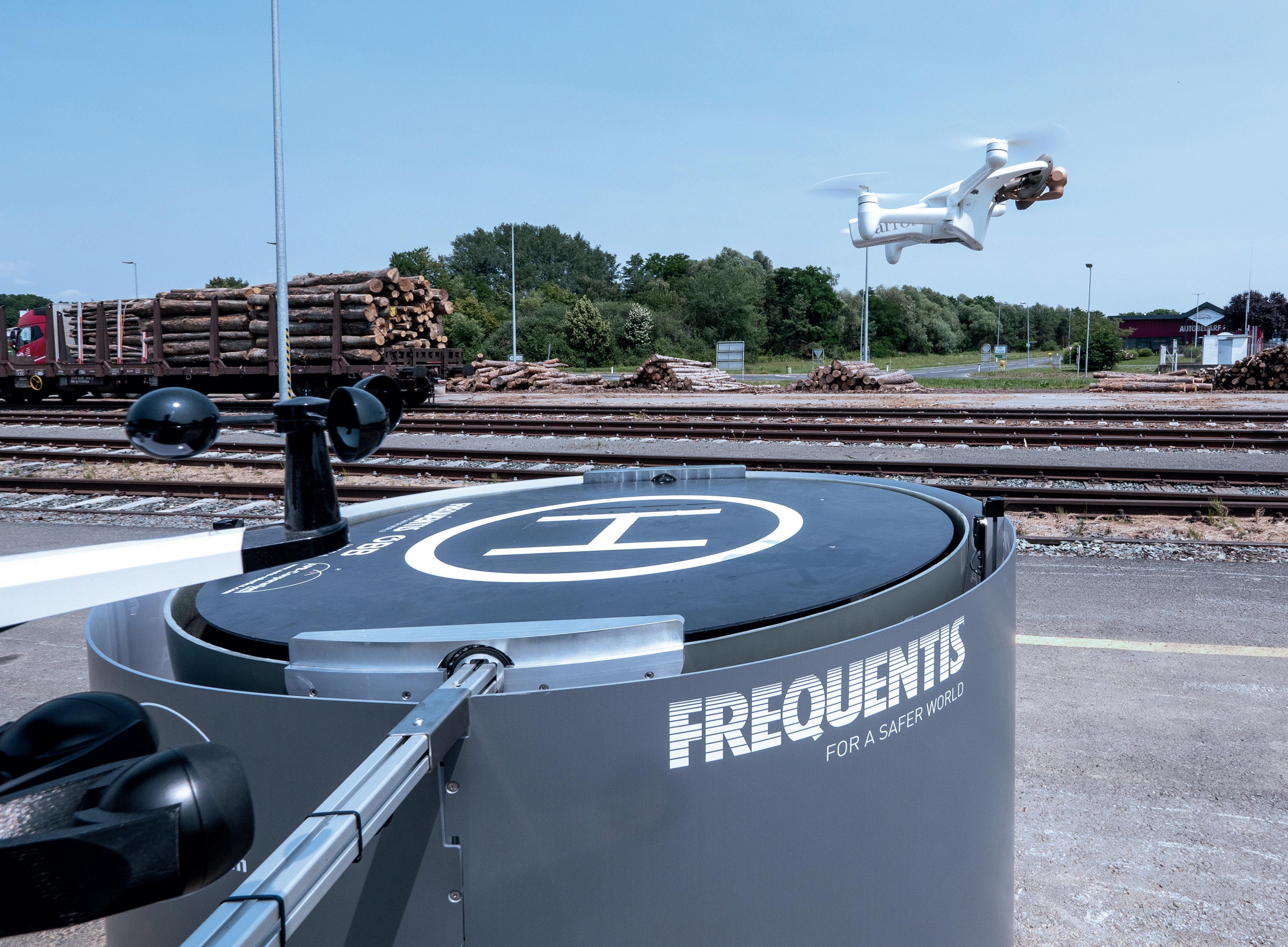
us at Innotrans 24 – 27 September
For seamless communication and safer and more efficient journeys, meet MissionX, the cutting-edge solution transforming railway operations. This innovative platform bridges the gap between old and new communication technologies, supporting everything from GSM-R and TETRA to 4G/5G, satellite, and WiFi. MissionX guarantees reliable, mission-critical communication across various networks, making it perfect for today‘s digital railway era.
MissionX goes beyond voice, enabling data and video transmission to provide detailed insights for quicker resolutions. Moreover, it opens doors to the use of further multimedia, like drones, to get video transmission from hard-to-reach locations. Its advanced features allow operators to work smarter, reduce complexity, cut costs, and enhance network management.
MissionX will transform railway operations.
www.frequentis.com

Data & Monitoring

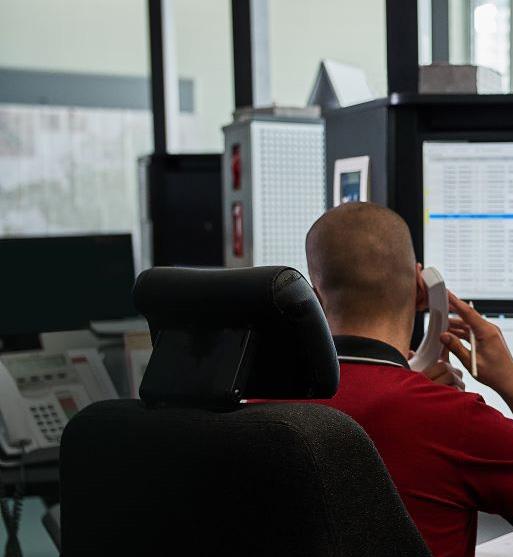

MissionX platform, can lead to predictive maintenance strategies, reducing downtime and enhancing the overall reliability of railway services.
One example of this would be within public transport, and in particular, railways. Frequentis is working with the Austrian Federal Railways (ÖBB) to develop a hangar-based drone operation system, which will be used to inspect and maintain rail infrastructure, such as bridges, tunnels and tracks. The ÖBB rail network consists of around 10,000km of track and 1,000 stations – so the rapid deployment of drones to hazardous or inaccessible areas will enable the remote inspection of tracks whilst avoiding placing staff into dangerous environments.
The hangar-based system will include a fully automated drone charging station and control centre, which is key to facilitating remote drone operations. Having been designed to optimise drone utilisation, it will allow multiple drones to be managed from a single location, therefore reducing the need for manual drone maintenance and management.
In emergency situations, every second counts. Drones can be dispatched as first responders to assess the scene, providing critical information to the control
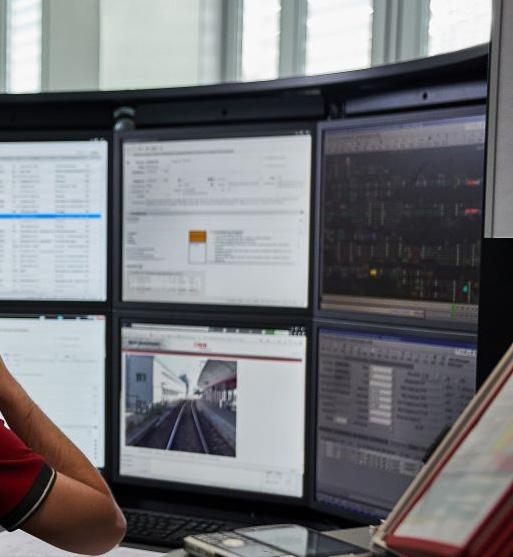
centre via MissionX. Whether it’s a derailment, a natural disaster or a security threat, drones can offer a bird’s-eye view of the incident, helping to coordinate rescue efforts and ensure the safety of passengers and personnel. Additionally, drones can deliver emergency supplies or establish temporary communication links in areas where the network may be compromised. Despite the promising potential of drones in public transport, regulatory hurdles pose challenges. Stringent rules in most countries address airspace, privacy and safety concerns. Frequentis collaborates with entities including European Airspace Safety Agency EASA to shape drone regulations, aiding in navigating these challenges for drones in public transport.
The synergy between MissionX and drone technology heralds a new era for the railway industry. By harnessing the power of these technologies, railway operators can achieve unprecedented levels of safety, efficiency and responsiveness. As the industry continues to evolve, the integration of MissionX and drones will undoubtedly play a pivotal role in shaping the future of railway operations, ensuring that the railways remain a vital and reliable mode of transportation for generations to come.
Find out more about Frequentis by visiting www.frequentis.com


From optimising operations to enhancing passenger experiences, AI has emerged as a game-changer, revolutionising every facet of rail transportation.
As a leader in providing AI-enabled computing platforms, ADLINK empowers rail operators with cutting-edge solutions tailored to the unique demands of the industry. ADLINK's robust computing platforms serve as the backbone for critical applications such as communications-based train control (CBTC), train control and monitoring systems (TCMS), autonomous train operations (ATO), data communication systems (DCS) and on-board passenger information system (OBIS).
ADLINK has developed new CompactPCI Serial processor boards, representing valuable additions
to our extensive, industry-leading portfolio and demonstrating our commitment to the standard.
The cPCI-A3535 flagship is a rugged 3U Intel Xeon blade designed to perform in the demanding conditions faced by railway operators. Engineered for EN50155 compliance, this processor blade ensures reliable operation in harsh environments. The cPCI-A3535 offers extensive connectivity, graphics, and storage options, providing system integrators with the flexibility to choose the right blade for their specific applications.

The ADLINK AVA Series encompasses a comprehensive set of EN50155 compliant solutions that bring AI and the IoT (AIoT) to the railway industry. The AVA Series is expertly designed for high compute density with I/O flexibility to meet the growing demands of railways developments and provide the essential systems for harnessing AI benefits across their edge infrastructure.
Rail system integrators can deploy AI-driven AVA systems to enhance onboard and wayside functions including:
• Railroad obstacle detection: expedite emergency response capabilities
• Rail inspection: real-time diagnostics to automate equipment fault detection
• Surveillance: AI-powered CCTV analysis analysis to heighten train terminal security
When installed in a specialised inspection railcar, AVA-7200 models can process images of vital wayside equipment, identify faulty equipment, and disseminate maintenance alerts while travelling at high speeds.
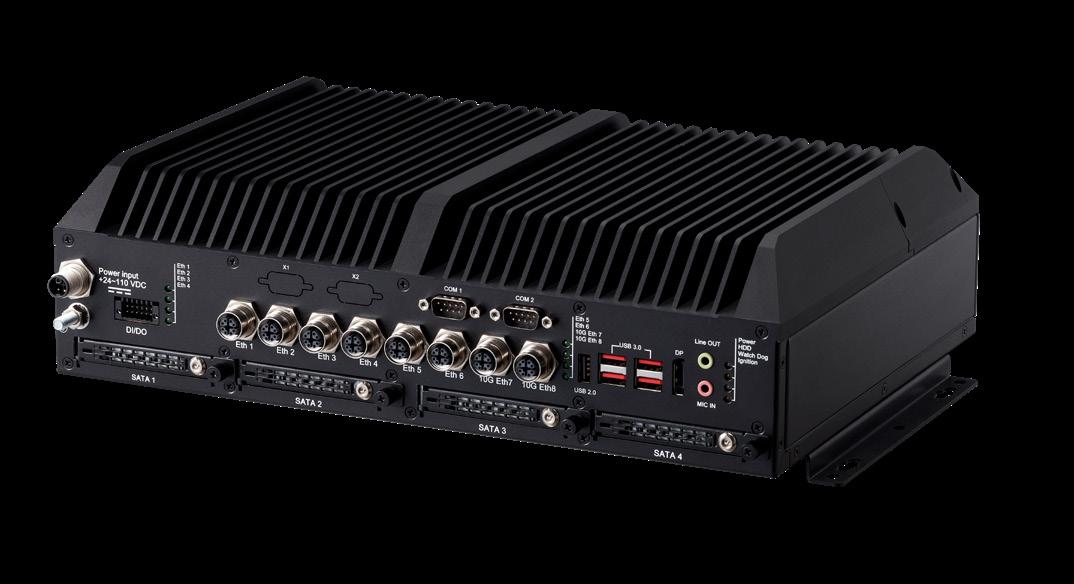
AVA-1000, Train to Ground Communication Gateway
On the other hand, ADLINK's AVA-1000 offers a seamless bridge between moving trains and ground networks, ensuring that passengers remain connected, informed and productive regardless of their physical location. The AVA-1000 is EN50155 certified with a fanless design and durability in extended temperature ranges (OT4, ST1), which ensures its reliability and performance in demanding environments.
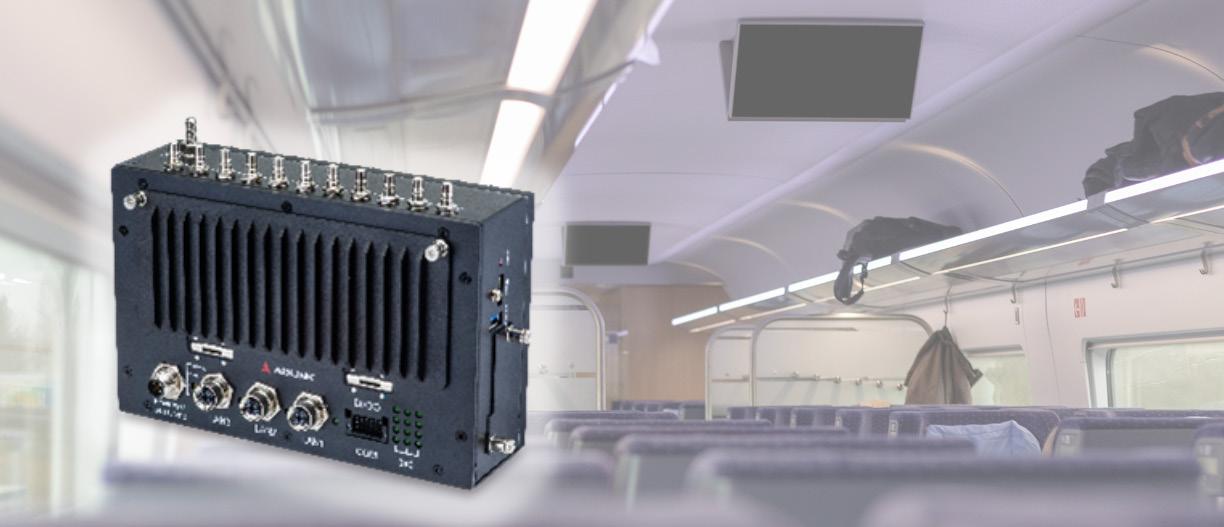
By providing real-time data on upcoming stops, estimated arrival times, service disruptions and emergency announcements, passengers can make more informed decisions and foster greater satisfaction. Moreover, PIDS can manage crowd flow and minimise congestion. Its seamless integration with various transit systems creates a cohesive transportation network that ensures travellers enjoy a convenient, reliable and transparent journey.
As a leading provider for the transportation industry, ADLINK offers cutting-edge hardware and software tailored specifically for PIDS applications. Our collaboration with AUO is a key differentiator, allowing us to integrate advanced display technologies with enhanced visibility and durability. We provide a range of panel sizes, brightness levels, glass types, coatings and housing options to meet different installation needs across diverse transit environments.

Visit Us at InnoTrans Hall 4.1 | 672
For more information, please visit ADLINK or send us an email


Rail Vision is revolutionising the railway industry with its cutting-edge safety and efficiency technologies.
Our advanced products, MainLine and ShuntingYard, offer unparalleled visibility, detection and classification capabilities, ensuring the highest level of operational safety and efficiency for rail operators worldwide.
At Rail Vision, our innovative solutions address the most pressing challenges in rail transport. Our systems provide real-time alerts and actionable insights using advanced sensor fusion, artificial intelligence and machine learning. This technology enhances train driver awareness, enabling informed decision-making
and accident prevention, alongside a user-friendly reporting tool for operational managers and C-level executives.
Our state-of-the-art detection and classification system, equipped with high-resolution sensors and AI-driven algorithms, operates 24/7. This capability ensures rail operators are alerted to potential hazards in advance, allowing for timely and effective responses even in challenging weather and low light conditions.
Rail Vision's products are designed to improve the overall operational efficiency of rail networks. By providing real-time data and predictive analytics, our
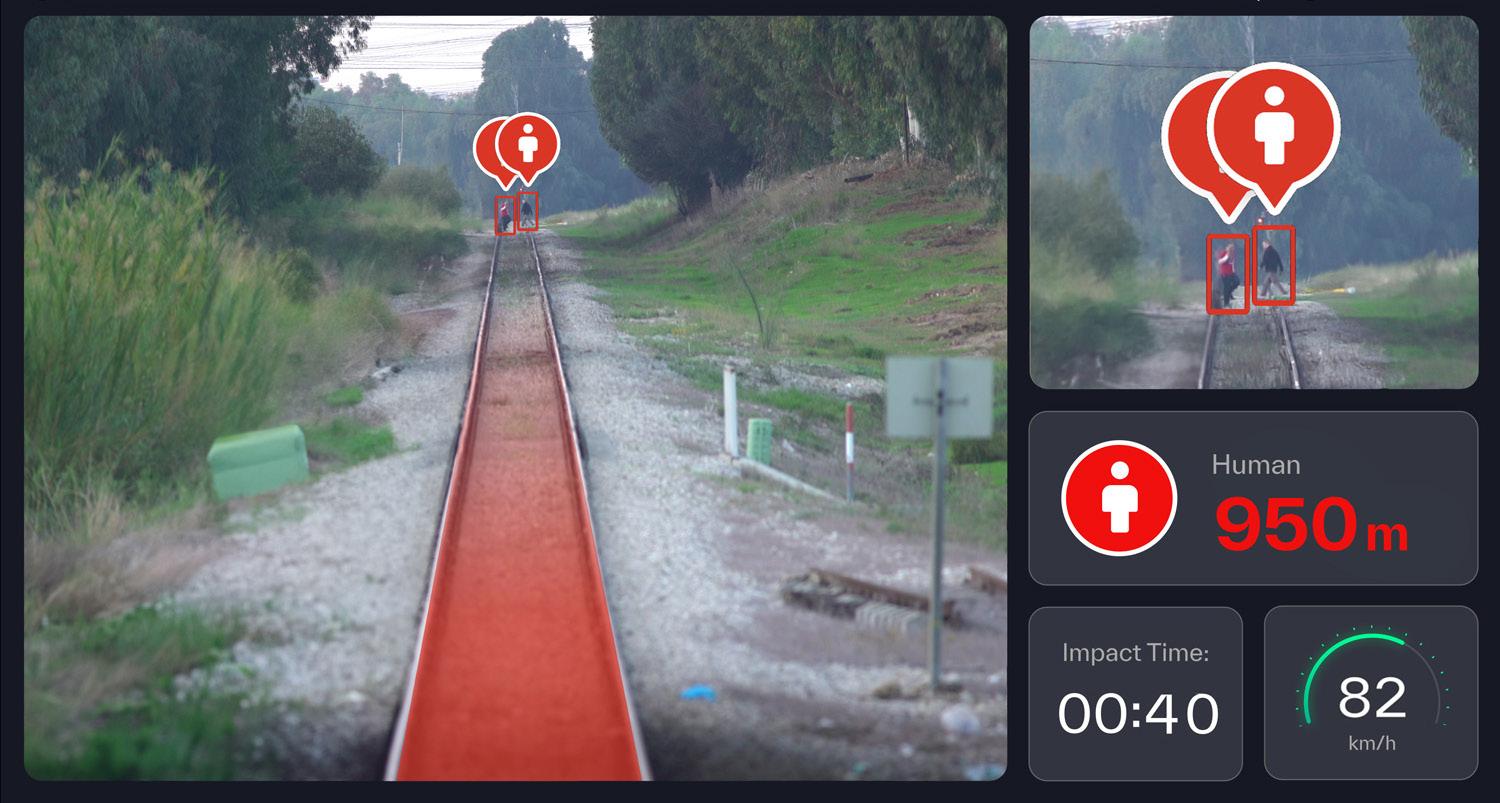

products help operators optimise train schedules, reduce downtime and improve maintenance planning, leading to significant cost savings and enhanced reliability.
Rail Vision’s primary advantage lies in our seamless integration and superior support. Our plug-and-play approach makes our products easy to install and integrate with existing infrastructure, minimising operational disruptions and keeping business continuity.
Our commitment to innovation ensures that our clients stay ahead of industry standards, providing them with cutting-edge technology that is both reliable and scalable.
In 2024, Rail Vision achieved several significant milestones:
• Successfully installed the AI-driven ShuntingYard product for a Class 1 freight rail company in the USA, enhancing operational safety and efficiency
• Received a $1 million order from a leading USbased rail and leasing services company as part of a contract valued at up to $5 million
• Completed the first-ever commercial installation of our AI-driven systems in a national railway line
• Secured regulatory approval and certification for railway operations in Europe
• Obtained a US patent for our AI-powered railway obstacle detection system
We are excited to announce our participation in the following industry events:
• AREMA Booth 1047
• InnoTrans Hub 27 Booth 770
• RSI EXPO Booth 252
We look forward to showcasing our latest technologies and connecting with industry professionals.
Rail Vision is dedicated to advancing rail technology and setting new industry standards. Our ongoing research and development efforts aim to further enhance our solutions and explore new applications for our technology. We are committed to shaping the future of rail transport and playing a key role in its evolution.
For more information on how Rail Vision's groundbreaking technology can benefit your rail operations, please visit www.railvision.io.
Join us in revolutionizing railway safety and efficiency. Discover how Rail Vision's innovative solutions can transform your rail operations.
Contact Rail Vision
Rail Vision Ltd., 15 Ha’Tidhar St., POB 2155, 4366517 Ra’anana, Israel

Phone: +972(0)9-9577706
Email: marketing@railvision.com
Website: www.railvision.com



TheImpactSentinel system is a stateof-the-art real-time warning solution designed to monitor and instantly alert users to natural hazards.
This intelligent wireless sensor system detects and informs of immediate dangers, such as landslides, avalanches and rock falls, providing crucial extra time for quick responses. Easy to install and requiring minimal maintenance, the ImpactSentinel offers an additional layer of safety for investments in preventive measures. The versatility of our system enables it to be installed across different infrastructures including railways, roads, hydro-plants and various remote locations. With over 15 years of experience, INGLAS continues to innovate in electronic monitoring systems,
ensuring the ImpactSentinel remains a trusted, robust and imperative solution for hazard barrier monitoring worldwide.
The ImpactSentinel system stands as a crucial asset for companies aiming to prevent disaster scenarios in real time. By monitoring and instantly alerting users to natural hazards, it provides essential seconds that can make the difference between safety and catastrophe. Whether it's a control centre or a train operator, the system's rapid communication ensures immediate responses to threats like landslides, avalanches and rockfalls. These critical moments are vital for safeguarding lives and infrastructure, making the ImpactSentinel an invaluable component in disaster
"The ImpactSentinel system averted a potential catastrophe,safeguarding lives & infrastructure."
In 2008, SBB commissioned a section of nets equipped with INGLAS's ImpactSentinel system to enhance safety on the Gotthard route. The system's effectiveness was dramatically demonstrated in 2012 when a large rock, measuring 150 cubic metres, breached the net. The patented pull-out mechanism of the ImpactSentinel system promptly triggered an instant alert, which was relayed to the SBB IT environment & forwarded to the control centre. Thanks to the swift response enabled by INGLAS's advanced alarm system, trains were able to stop in time, preventing a potentially fatal high-speed collision.
prevention strategies. The system’s ability to be configured and controlled remotely adds another layer of responsiveness and flexibility, further emphasising the importance of every second in averting potential disasters.
With a proven track record across Europe, Asia and North America, ImpactSentinel is trusted by numerous organisations. Notably, we have a strong 16-year partnership with SBB railway in Switzerland. Since 2008, we have completed 24 projects together, with over 850 active sensors currently across the SBB network.
The ImpactSentinel system provides continuous 24/7 monitoring and can be customised to meet the specific needs of our clients. It offers a variety of installation options and requires minimal maintenance, making it an optimal choice for use in extreme environments.
With over 15 years of expertise and ongoing innovations, INGLAS's ImpactSentinel system stands at the forefront of real-time alarming and monitoring solutions. Committed to delivering the highest quality products and services, INGLAS has earned global trust for its elite electronic monitoring systems for hazard barriers.
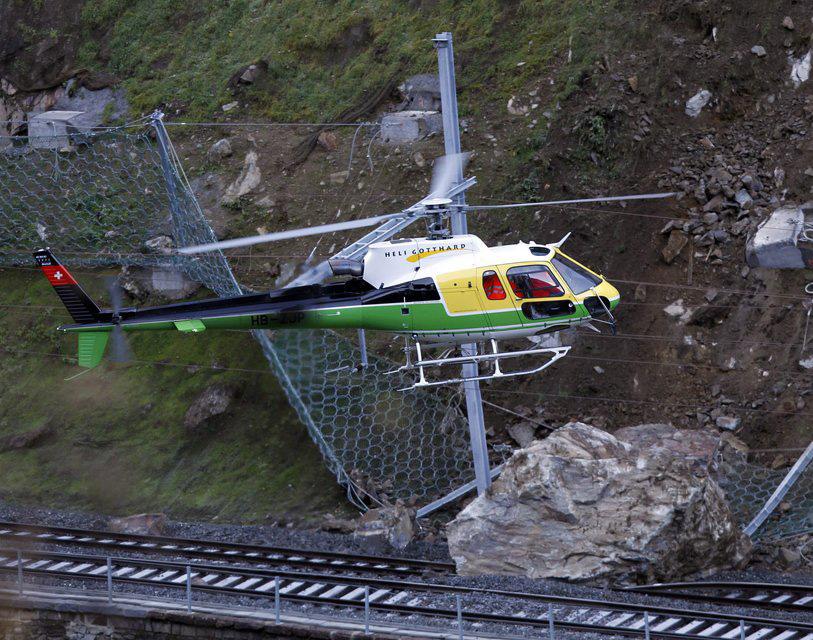
Discover how ImpactSentinel can elevate your safety measures by visiting www.inglas.org or contacting us directly for more information.
Visit us at InnoTrans 2024 Hall 6.1 | Booth 137
Click or scan the QR code for the InnoTrans Map





Senceive wireless remote monitoring technology helps you protect people and infrastructure.
Install robust, precise wireless sensors on track, structures and earthworks to monitor long-term movement such as changes in track geometry, as well as sudden events such as landslides and embankment failures. Low-maintenance, ultra-long-life sensing technology provides automated near real-time alerts of movement, while integrated cameras show the cause of movement without visiting the site.
A range of precise triaxial tilt sensors provide continuous data on track geometry parameters including cross-level, twist, lateral shift and settlement. Complementary sensors provide data on track temperature, strain, displacement and geotechnical parameters such as groundwater conditions and subsurface ground movement.
Instruments are remarkably quick and simple to install without specialist training. They are rugged, designed specifically to withstand harsh railway conditions and they can last up to 15 years with minimal maintenance. Gateway base stations, with a variety of remote data transmission methods, forward data from your site to your cellphone or computer. These can be solar-
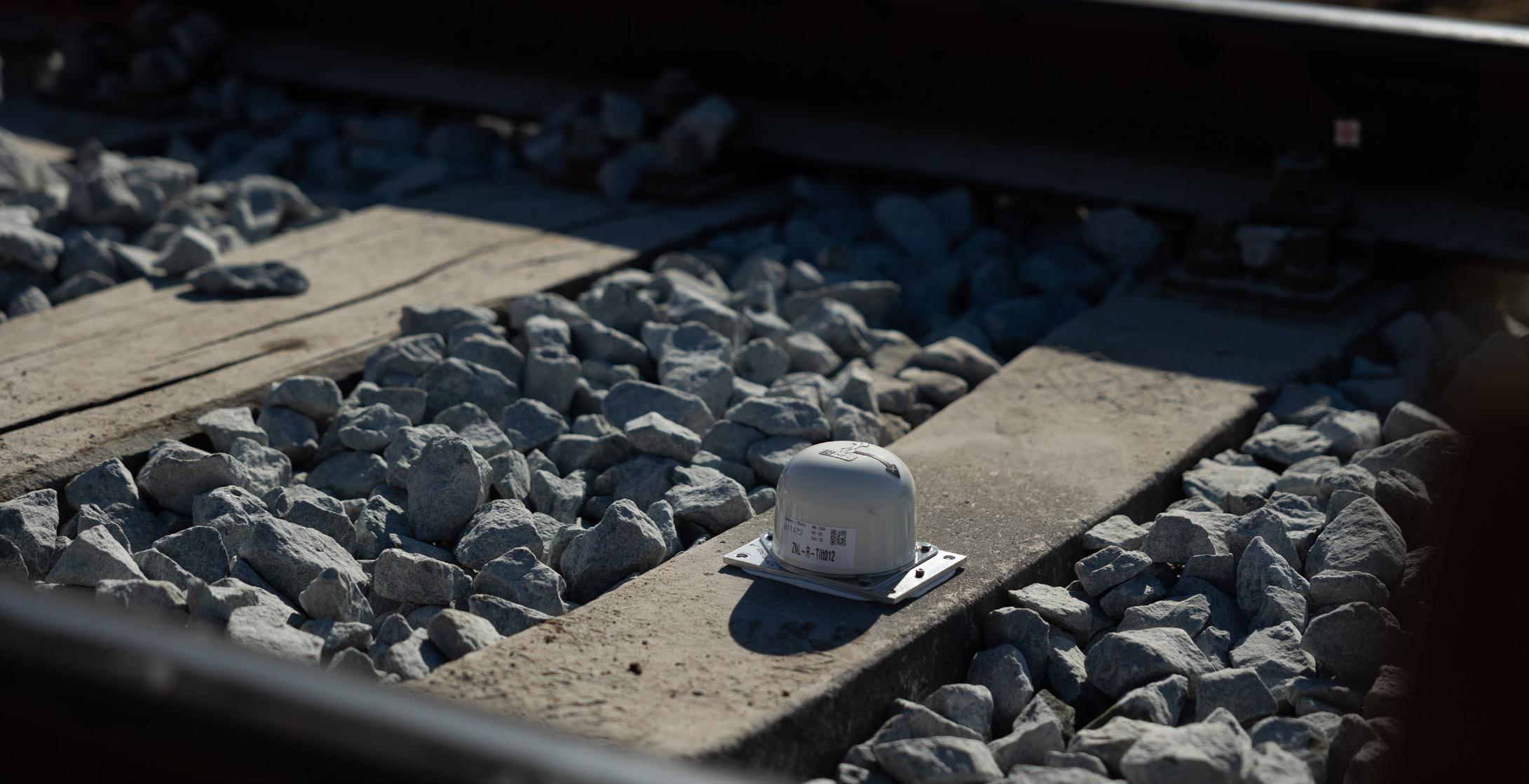
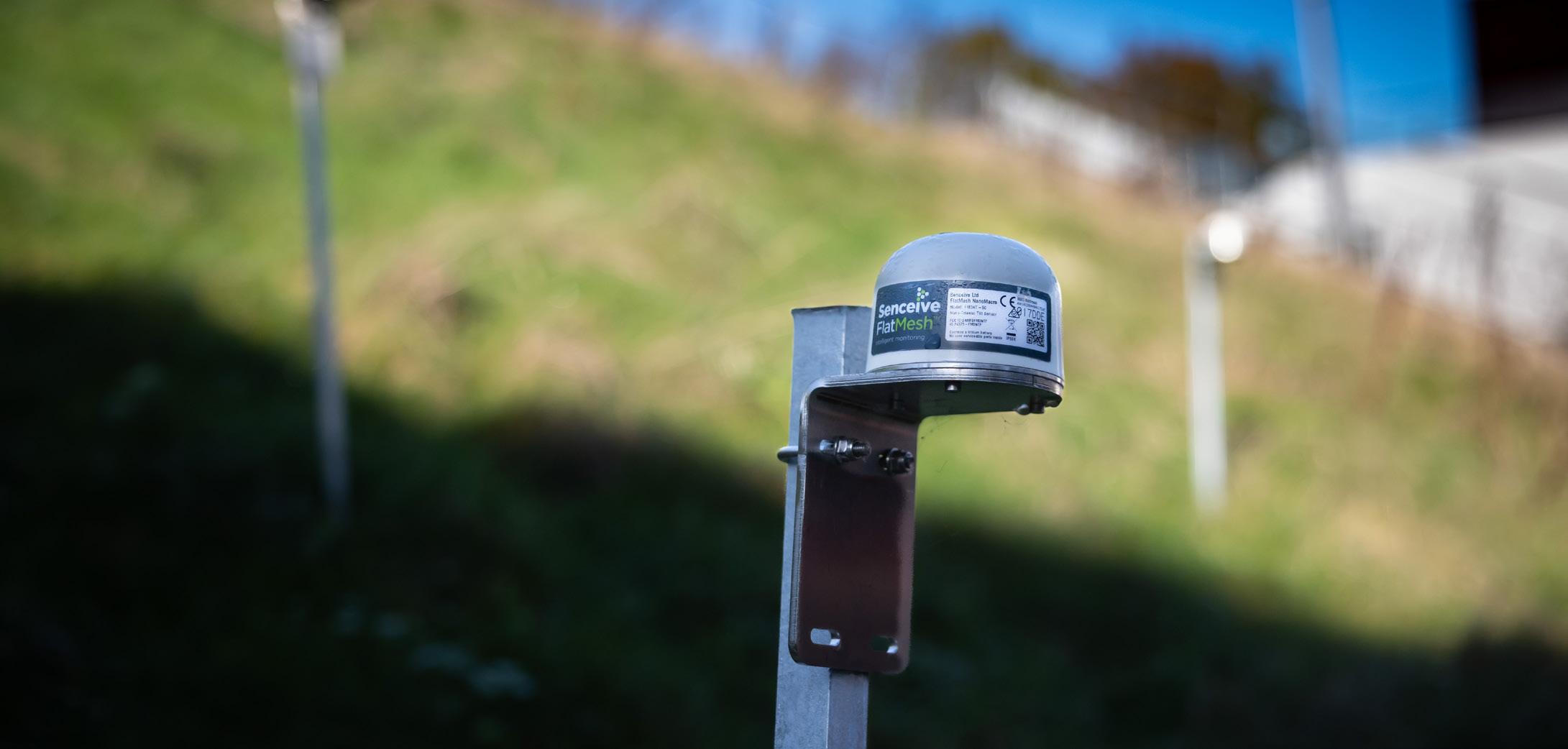
powered, so the system can operate without fixed power or comms infrastructure. Remote users benefit from online datasets typically updated within minutes, along with automated alerts if pre-set thresholds are breached, with increased data granularity based upon the severity of the breach.
Changing weather conditions have increased the risk of railway slope failures in many parts of the world. Our award-winning InfraGuard™ responsive monitoring solution provides early warning of slope failure and can be used anywhere that slope stability is an issue, including cuttings, embankments and earthworks and structures prone to flood damage.
This intelligent system combines smart tilt sensors which transmit multi-level alerts and trigger cameras to send images in the event of sudden ground movement. Use the Digital Interface Node to monitor weather conditions at remote sites with near continuous updates on rainfall, windspeed and temperature.
Remote monitoring technology puts critical data at your fingertips providing asset visualisation without mobilisation. It provides near real-time alerts when pre-set thresholds are breached, which means you can be confident that if there are potentially dangerous or
disruptive events on the network, you will be the first to know. That’s why more than 40,000 Senceive sensors are in use on railways around the world today.
Come and talk to the team about the latest innovations including including rockfall monitoring solutions, and sat comms connectivity for remote sites beyond the range of the cellular network. Discover the Digital Interface Node and the growing range of third-party environmental, structural and geotechnical sensors that can be connected. Get an update on software developments including Senceive.io which provide unprecedented options for data storage, export and visualisation.
Senceive will be sharing Stand 275 in Hall 22 with Previan group partners RailMetrics and Eddyfi



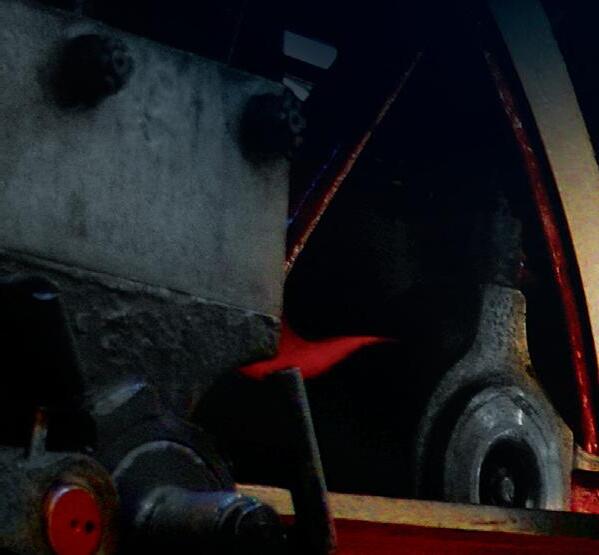





















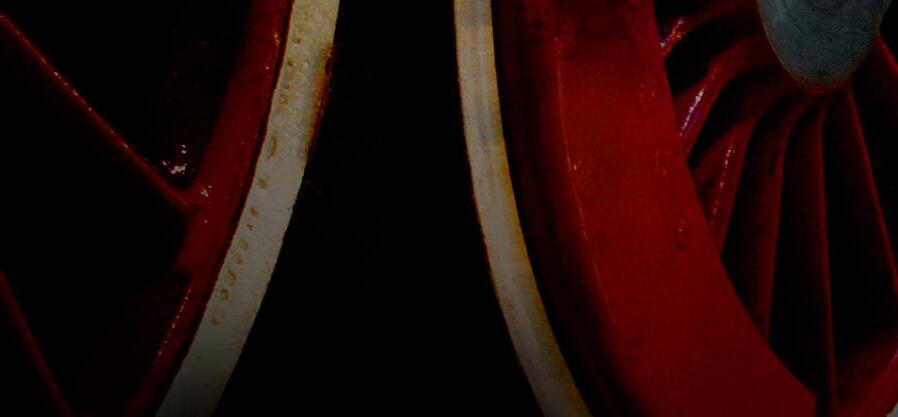



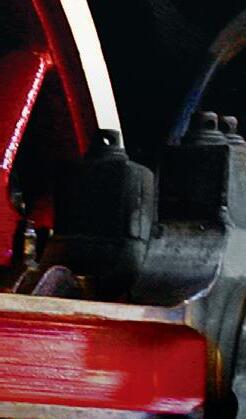
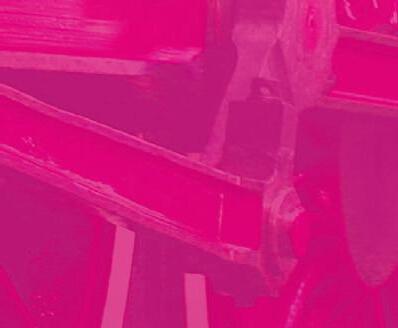

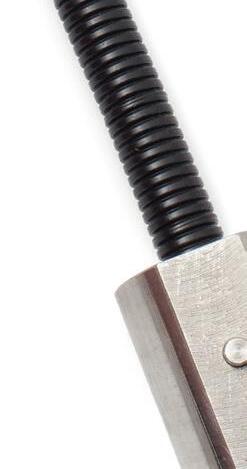


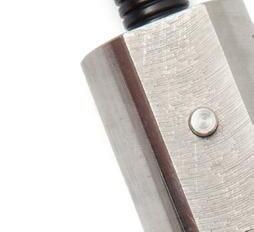













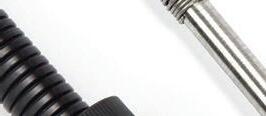

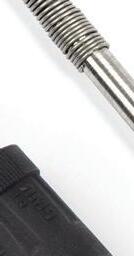



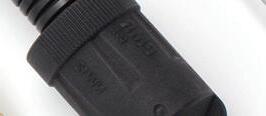




































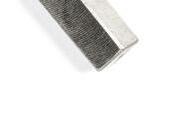

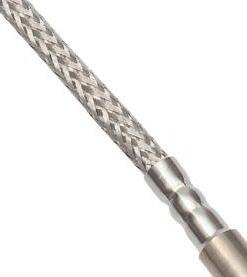
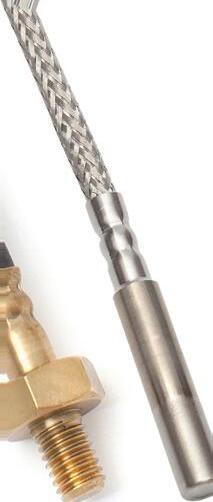


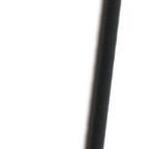














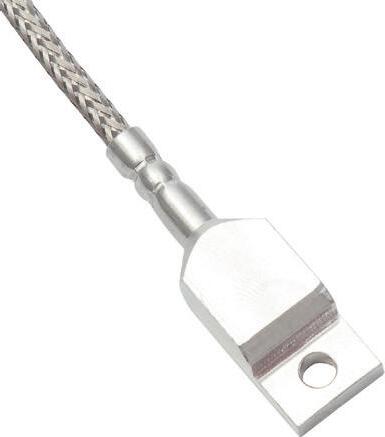
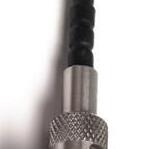
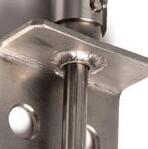

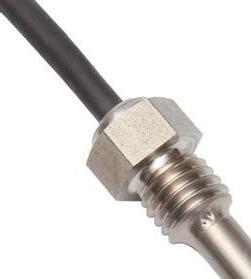





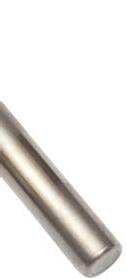

























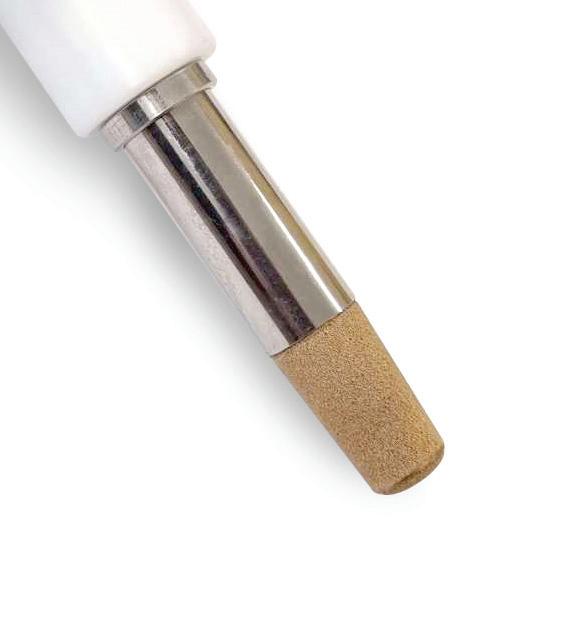



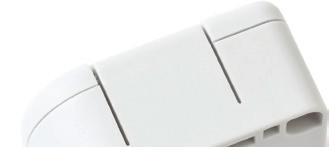
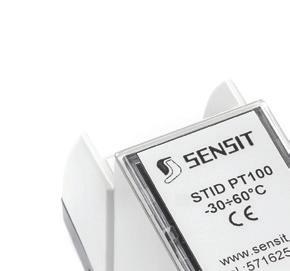





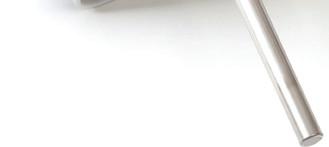



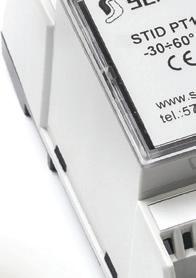


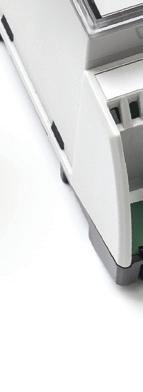



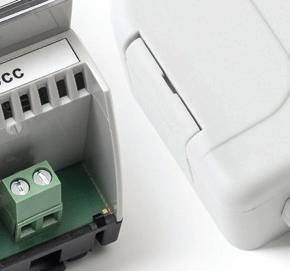






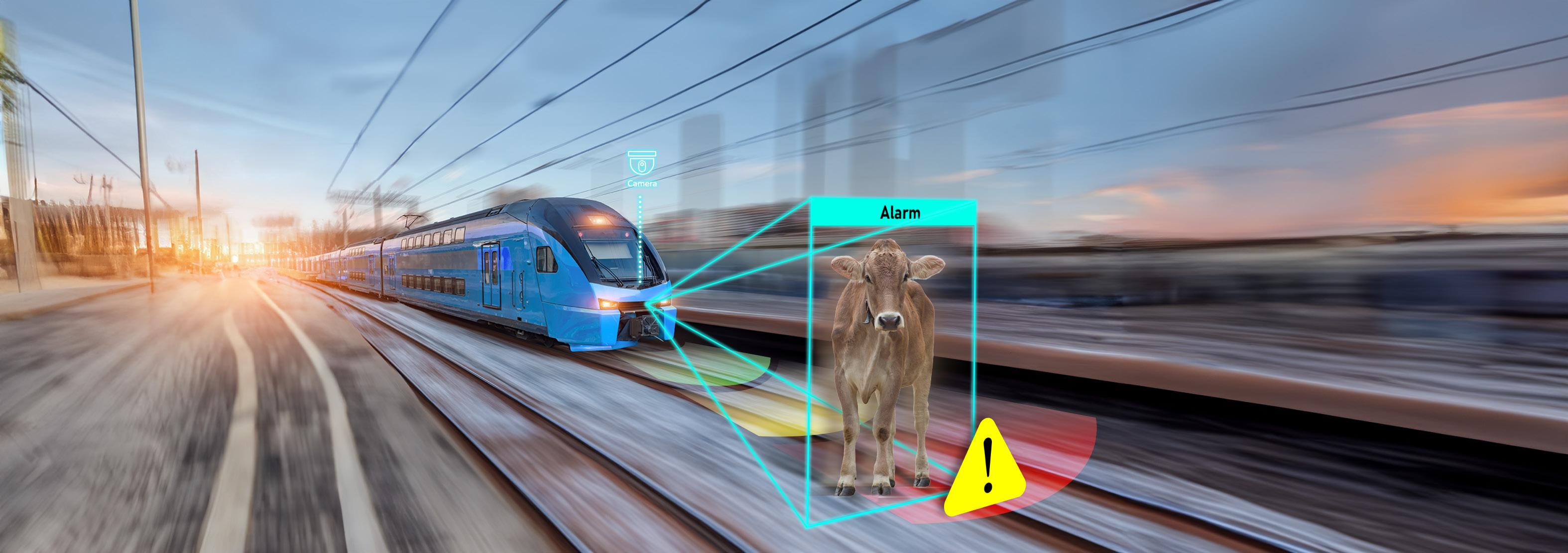
AI has become an essential component of automated vehicle technologies. NEXCOM offers high-performance railway computers with built-in NVIDIA® Jetson AGX™ Orin SOM, enabling robust AI processing and inference capabilities for AI-aided transportation applications such as railway safety assurance.
In addition, featuring a modular expansion design, NEXCOM equips railway computers with an extensive array of interfaces to adapt to different scenarios. These computers can be rapidly customized for applications: passenger Wi-Fi with Wi-Fi 6 and 5G technology, surveillance systems with PoE support, and 10GbE network backbones. All the solutions will be demoed in NEXCOM booth in InnoTrans 2024.
ATC 3750-IP7-WI6CR
• NVIDIA® Jetson AGX Orin™

• 6-port GbE PoE+ for IP CAM/LiDAR sensors optional 1-port 10GbE
• IP67 rated, rugged, and compact
• Intel® 12/13th Gen Core™ processor 5G/Wi-Fi, PoE, 10GbE, daughter board expansion support
• Designed with DDR5, excellent memory bandwidth lower latency nROK 7270


• NVIDIA® Jetson AGX Orin™
• IP67 rated, rugged, and compact ATC 3750-IP7-8M

• 8-port MIPI/GMSL2 & 2.5GbE (X-coded) for MIPI CAM/ IP CAM/LiDAR sensors
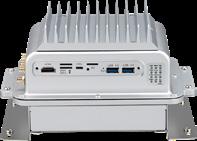
• NVIDIA® Jetson Orin™ NX
• 4-port GbE PoE+ for IP CAM/LiDAR sensors IP67 rated, rugged, and compact ATC 3540-IP7-AI4CR

• Intel® 12/13th Gen Core™ processor
• 5G/Wi-Fi, PoE, 10GbE, daughter board expansion support
• Wide voltage input 24~110VDC (w/ isolation)
• Designed with DDR5, excellent memory bandwidth lower latency nROK 7271
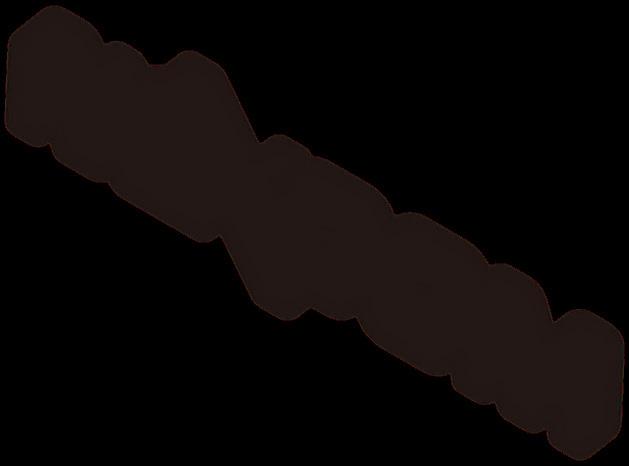


with SuperCap (Master)

with SuperCap (Slave)
24V@8A max (200W, 1 x master + 3 x

ATC 3750-IP7-8M
Introducing the ATC 3750-IP7-8M, the rugged AI powerhouse designed to revolutionise automated vehicle technologies.
Equipped with the high-performance NVIDIA® Jetson AGX™ Orin SOM, this cutting-edge device delivers an impressive 200/275 TOPS workload on AI processing and inference. With its IP67 rating, compact size and 9~36VDC/24VDC rail with IGN control, the ATC 3750-IP7-8M is the perfect in-vehicle/rail companion. It features 8 MIPI/GMSL2 for seamless access to MIPI CAM sensors, along with a variety of rich peripheral ports including GbE/2.5GbE, USB3.2, isolation CANBus, RS232, console, DI/DO, OTG and HDMI. Whether it's ADAS in transportation/construction, ANPR, AMR, machine learning or railway safety assurance, the ATC 3750-IP78M has got you covered.
MIPI comes into play by providing a high-speed, lowlatency connection for advanced driver-assistance systems (ADAS). This is achieved by enabling communication between various sensors, including high-resolution cameras, LiDAR and radar, and the processing unit. Besides, 5G and Wi-Fi options enable over-the-air collaboration with cloud systems for AI model retraining.

What truly sets these AI-powered computers apart is their ability to thrive in even the harshest environments. Thanks to its fanless design and robust thermal solutions, the ATC 3750-IP7-8M can sustain intensive workloads in harsh, rugged environments. This IP67-rated compact computer is designed to withstand shock, vibration, dust and temperature extremes from -25°C to 70°C. Plus, it's certified by CE/ FCC Class A, UKCA, E-mark and EN50155/EN45545-2 for your peace of mind.
For edge AI platforms that use Jetson modules, NEXCOM offers NEXCOM Accelerator Linux (NAL). NAL is an optimised Ubuntu 20.04 LTS derived from the Jetpack SDK. Programmers can access supported 5G, Wi-Fi, GNSS, IMU, CAN bus, MCU, I/O interfaces and other peripherals through in-house design utility and APIs. This allows developers to use physical signals from peripherals and sensors as data sources for AI inference engines, with minimal knowledge required for hardware installation and configuration.
With the NVIDIA JetPack 6.0 upgrade, it also features new Jetson Platform Services, which add foundational and AI analytics services, generative AI capabilities, and multiple building blocks such as the Video Storage Toolkit (VST) and NVIDIA DeepStream software development kit. This simplifies solution development for developers by eliminating the need for repetitive development on NVIDIA Jetson, empowering them
to quickly assemble full-featured edge AI systems and manage edge AI applications. Through REST APIs, developers can easily access a variety of microservices, enabling the construction of unified cloud-to-edge vision AI applications. This functionality delivers the seamless replication of cloud-developed microservices and trained AI models to edge devices using IoT gateway and OTA.
NEXCOM's hardware and software specifications are meticulously engineered to overcome the challenges encountered in real-world applications. For instance: Surround View System and Anti-Collision System for Mining Vehicles provides a comprehensive panoramic view and issues collision warnings to prevent accidents. Agriculture AMRs are equipped with advanced capabilities for crop recognition and RTK precise positioning, enhancing agricultural efficiency. In conclusion, upgrade your AI journey with the ATC 3750-IP7-8M and experience unparalleled performance, durability and versatility. Don't miss out on this gamechanging device.

ATC 3750-IP7- 8M
• NVIDIA® Jetson AGX Orin™
• 8-port MIPI/GMSL2 & 2.5GbE (X-coded) for MIPI CAM/ IP CAM/LiDAR sensors
• IP67 rated, rugged and compact
•9~36VDC & 24V rail combined

ATC 3750-IP7-WI8MR
• NVIDIA® Jetson AGX Orin™
• 8-port MIPI/GMSL2 & 2.5GbE (X-coded) for MIPI CAM/ IP CAM/LiDAR sensors
• IP67 rated, rugged and compact
• 24~110VDC w/ isolation
VTK-SCAP is a specialised UPS (uninterrupted power system) designed for in-vehicle and railway computers, providing up to six minutes of backup power in case of power loss. It utilises a supercapacitor design, offering a 10-year lifespan and up to 500,000 battery cycles. Compliant with the E-Mark and EN 50155 standard, it can be operated in extreme temperatures ranging from -35°C to 80°C, helping ensure uninterrupted operation of critical systems. This reduces downtime and maintenance costs.
VTK-SCAP is expandable, allowing connection with up to three expansion units, extending the backup time to six minutes for a 60W system at 25°C. Additionally, included system status monitoring utility enables service personnel to easily check UPS health, charge/ discharge status, capacity and other information simultaneously, providing users with the most realtime system status and facilitating management purposes. It supports over-voltage and over-current protection mechanisms, which automatically limit the system charge when the input voltage goes above 56V, ensuring there will be no safety issues caused by excessive instantaneous voltage.
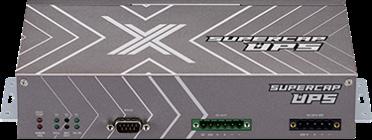
VTK-SCAP
• Provides up to 6 minutes of backup power for a 60W system
• Utilises supercapacitor for a 10-year lifespan and 500,000 battery cycles
• Operates in extreme temperatures ranging from -35°C to 80°C
• Expandable to extend backup time
• UPS status monitoring utility
• E-Mark and EN 50155 certified


After an illustrious career working for CSX’s GIS team, Erik Henderson was headhunted by Esri to take on its newly created position of Director Rail Industry Solutions. We spoke to him about his transition from railroader to railroad vendor, career highlights so far and his plans at Esri…
Railway-News: When and why did you take on this role at ESRI?
Erik Henderson: After a long career in the railroad, I went to work for a start-up LIDAR company out of Australia, trying to bring their technology here to the US. At that point I really wanted to get back to my GIS roots, and someone from the Industry Solutions Team here at ESRI reached out to me, as they were looking for a rail expert to come join their team for the first time.
I wanted to stay connected to the industry, working to help railroaders understand the value of GIS, so it was the perfect fit. I’ve now been here over a year.
RN: Why do you think they approached you?
EH: I’ve been using their products my whole career –essentially, I’ve been an Esri customer for over 25 years! Plus, I have a history in the industry. It's a small one in the US, there are six major railroads and then Amtrak is our one passenger line, so all the railroads have to work very closely together.
For example, when positive train control was created about 15 years ago, it required all of our GIS departments to work together to build a joint

Erik Henderson, Director of Rail Industry Solutions,Esri
database. That really transformed North American rail, and it transformed our relationships because we had to meet up, agree on a product, process and project, which took years of collaboration to develop. So along the way, I created incredible relationships with the other GIS managers and all the other railroads.
RN: As an industry veteran, what have been your career highlights to date?
EH: It comes back to positive train control. When I started at CSX in 2006, I was an analyst. I made maps and that was the extent of GIS.
Then, in 2008, a railroad incident in California triggered positive train control to be signed into law. This required all trains in North America to have an onboard database so they understood exactly what was on the tracks in front and behind them, and locomotives had
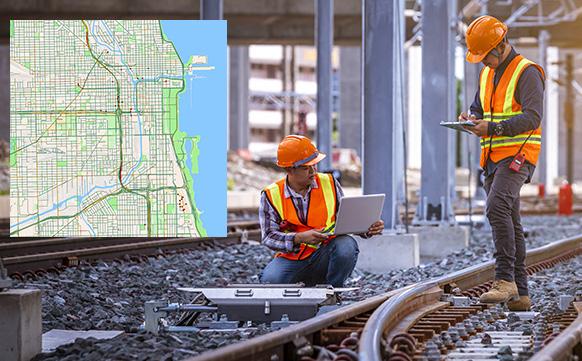
to be intelligent enough to know whether they had the authority to move on that track.
That required an incredibly accurate base model database of the assets and infrastructure along the rails. So, we went from this small, mapping department to a federally mandated data management team. When I was hired, there were only half a dozen employees. At our peak, we had a team of over 110.
In the process of developing that database we were able to purchase LIDAR to start mapping our network and buy GPS devices and drones so that our field workers could maintain that data. Some people called them tools, others called them toys. We were the envy of the railroad, because we had this exciting tech, and it was great.
That requirement to make GIS the system of record really transformed the need and necessity for our department, and facilitated a great investment in GIS technology. In return, the railroad got an extremely accurate map of all its assets network-wide, which offered many benefits, especially in terms of managing inspection and maintenance.
RN: What do you think your experience enables you to bring to Esri?
EH: I see my role as making sure the railroaders get as much out of our software as the utilities, government agencies and commercial industry customers. My job is to think as a railroader so that our products reflect their needs.
I’ve had a flood of product teams, account managers and marketing folks here reaching out and wanting to use my knowledge to help them understand their rail customers’ needs. It’s great to have my experience called upon and put to good use.
RN: So now you've settled in, what are your plans? Are there particular projects that you're working on?
EH: One of the railroads’ challenges is the vastness of their networks. If you're a water department, you might serve a town or city: you could get in a car and drive to your entire network that same day. But the main railroads cover half of the country. At CSX, for example, there might be a construction project in Nashville, but you’re based in Jacksonville.

This technology is needed in order to constantly scan these long distances and has provided incredible amounts of data. The term big data is thrown around a lot, and rail is certainly not lacking big data. We have thousands of trains collecting data all day, every day. We have all of those switches and signals and localised sensors collecting data. The industry literally creates terabytes daily.
I'm hoping to help Esri understand how we can start to analyse this in ways that benefit the railroads. We have decades worth of information around broken rails for example. Let's use GIS as a predictive analytical tool to say when we think the next rail break might happen.
Using historical data like the rail weight, installation date, weather conditions, tonnage of railcars that have gone over it and whether it’s had any repairs, we can work out when it's likely to break. This knowledge can help railroads to better know where to focus their maintenance or replacement work when they’re dealing with over 20,000 miles of track.
We’re now looking to develop predictive analytics products that enable them to make the most out of this information, and so I’m currently working with colleagues to explain what to look for.
Unless you work in the industry you probably couldn’t pick out a railroad switch or gauge, so I’m explaining
what these things look like, their characteristics and variances, so they can write tools to extract those assets out and analyse them against standards.
RN: What are you most excited about working on at ESRI?
EH: It’s using advanced technology like drones and LIDAR, but also being able to add value to the stockpile of data railroads have. Together we can make better use of this.
I also want to build more of a sense of community with the railroad industry. I want Esri to engage with them more closely, but also connect companies, both nationally and internationally, in order to share challenges, knowledge and solutions. Many of our problems are similar whether we’re in Europe or the US, so I hope to bring our community closer together.
For more information visit our website www.esri.com or click here to contact one of the team.
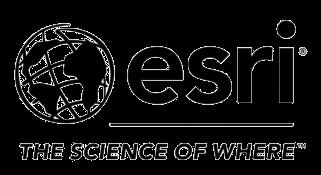
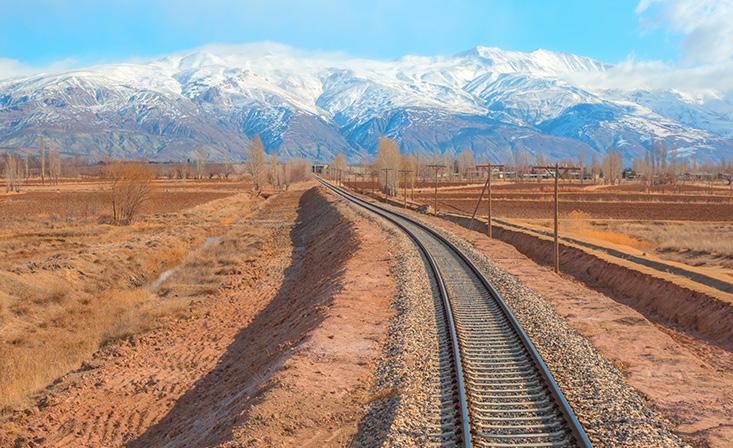

Network Rail Region Utilises CableGuardian® Technology for Enhanced Insight and Monitoring of Its Signalling Power System
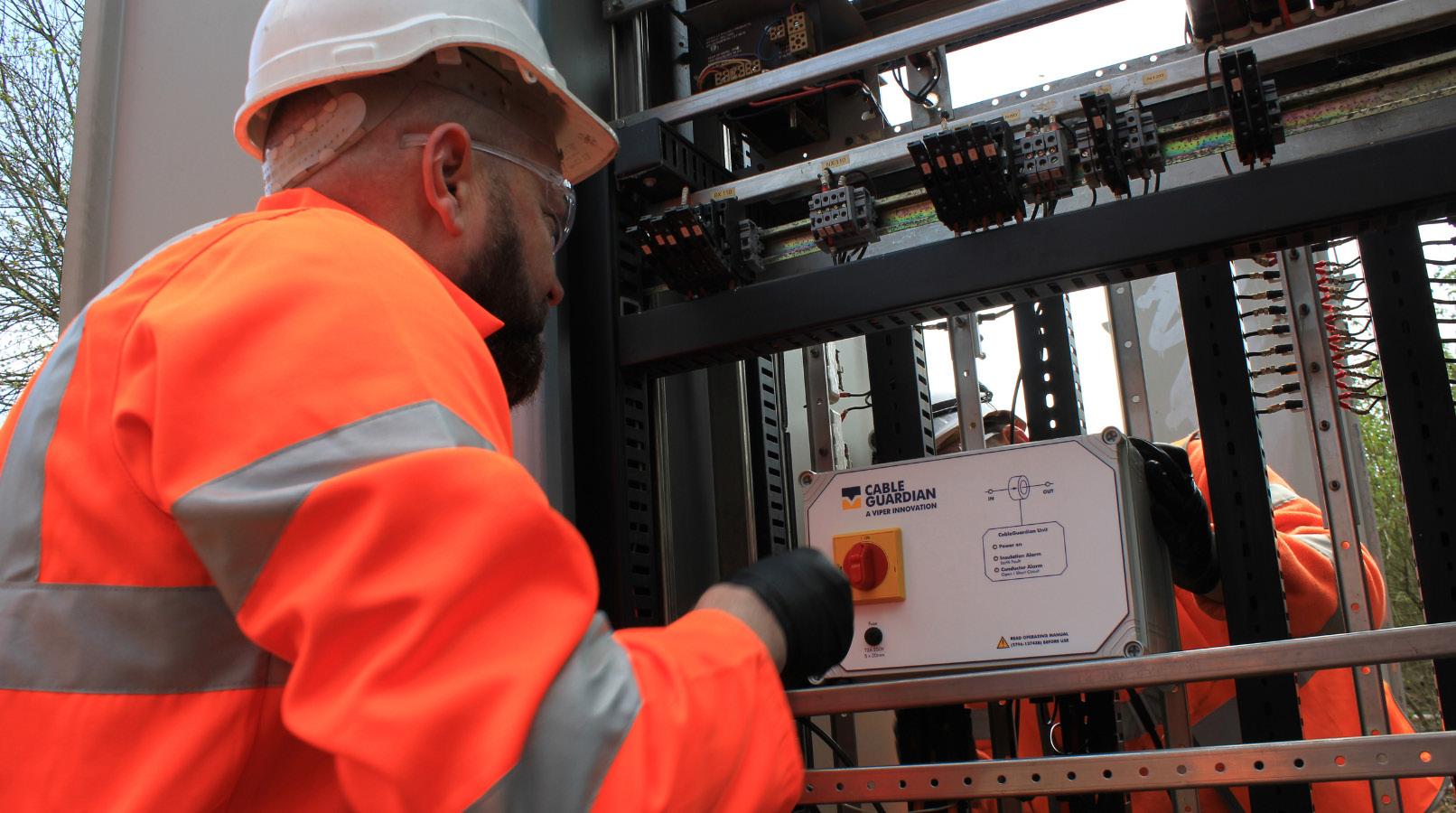
Rail technology supplier Viper
Innovations collaborated with Network Rail Wales and Western Region (Yatton) to use the award-winning CableGuardian by Viper Innovations to optimise signalling power supplies asset management with precise insulation resistance monitoring.
Technology Upgrade
Network Rail Wales & Western region undertook a
project to deploy CableGuardian on the signalling power system (SPS), which had continually recorded low insulation resistance (IR) values within the intelligent infrastructure system (II). The signalling power system was an ageing asset monitored by a single insulation monitoring device (IMD) in a Tier 3 configuration, providing a single insulation resistance value within the intelligent infrastructure System (II).
The SPS asset comprised two feeders totalling approximately 13km in length and a relay room close to the principal supply point (PSP). All contribute their individual IR values to the total network IR
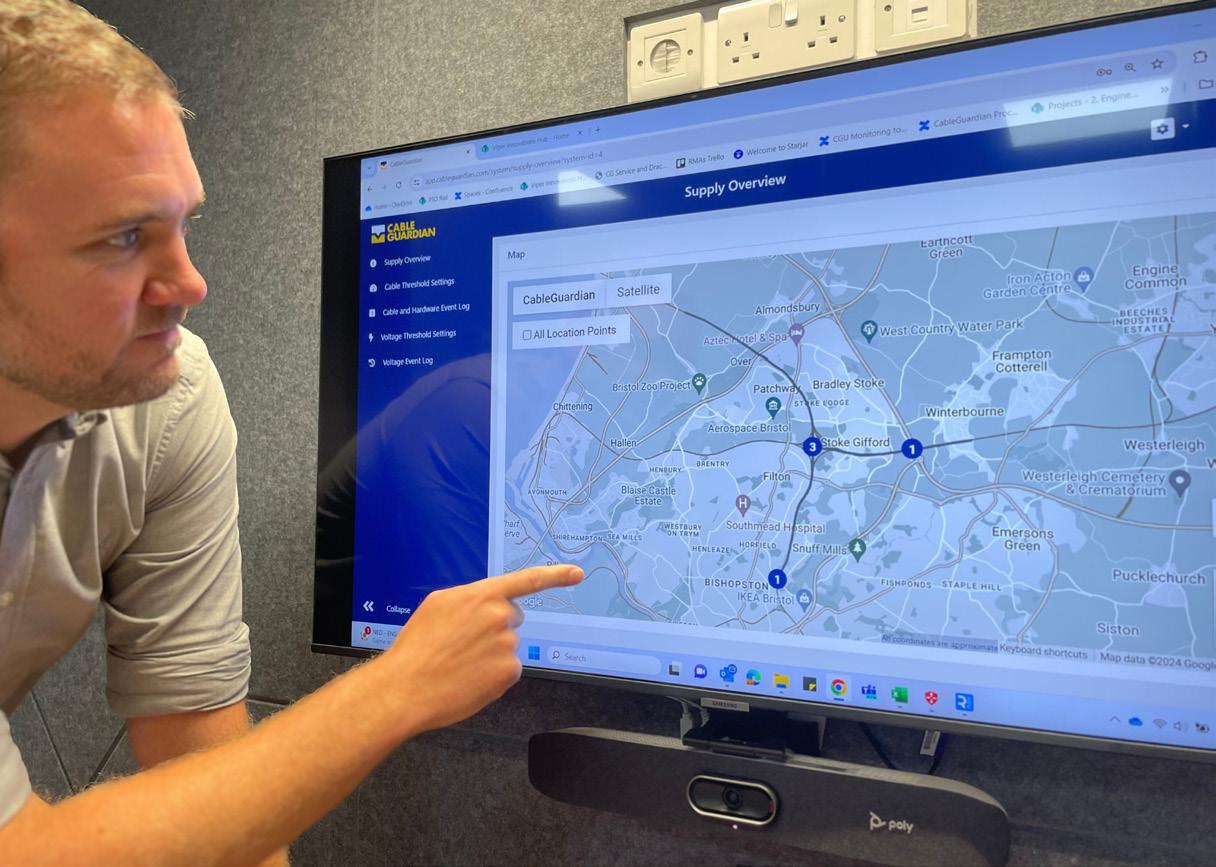
value reported within II. Because of this, the causes of the low network insulation resistance values were not immediately evident. The traditional method of identifying the cause(s) and location(s) for the low network insulation resistance is to disconnect and test each cable section.
However, Network Rail Wales and Western region (Yatton) decided to install CableGuardian in a Tier 2 configuration, with an individual CableGuardian unit monitoring each feeder. This would give Network Rail insight into their asset, which was unavailable until then.
By installing CableGuardian, Network Rail’s E&P engineers could see the individual insulation resistance measurements taken by the CableGuardian hardware, better understand their asset and decide how to address the issue.
From the data captured by CableGuardian, Network Rail could quickly review the status of its assets from its office rather than having to have ‘boots on ballast’ to test the cables and obtain this information.
• The data from the CableGuardian portal showed one feeder to be 2.75km long with an IR measurement of >500kΩ
• The second feeder to be 10.3km long with an IR measurement of >500kΩ
• The 20m cable to the relay room had an IR measurement of 50kΩ
The CableGuardian portal uses colour coding to identify which sub-network section is below the alarm levels along with symbols to indicate the sub-network section with the lowest IR as well as the sub-network section with the lowest normalised IR, a unique feature of CableGuardian indicating the lowest IR/km.
To measure insulation resistance, CableGuardian considers all the switchgear and ancillary equipment associated with the SPS, not just the feeder cables. The data within the CableGuardian portal indicated that the issue lay within the relay room rather than the feeders, removing the need to obtain possession, putting ‘boots on ballast’, and testing the feeder cables only to find that the issue lay elsewhere.
CableGuardian provided Network Rail with an understanding of their asset that they previously had yet to have and reassured them that the insulation resistance (IR) values of the individual feeders were above the levels that would have meant that further attention was necessary. The cause of the low insulation resistance value associated with the relay room emanated from some ancillary equipment rather than cables, and the appropriate steps were taken to address this and bring the SPS out of the low IR alarm status.
Now that CableGuardian had been installed in a Tier 2 configuration on the SPS, this provided the Network Rail engineers with a technological alternative to the 5-yearly manual cable testing requirement NR/L2/ SIGELP/50000.
CableGuardian by Viper Innovations is providing Network Rail with greater insight and understanding of its assets. It also empowers the rail industry to move from the uncertainty of periodic testing to a real-time condition-based approach.
Click here to find out more about CableGuardian by Viper Innovations.
www.viperinnovations.com

ELIMINATE ELECTRIC SHOCK (SIN119)
SPS FAILURE REDUCTION
INCREASED PERFORMANCE
INCREASED EFFICIENCY, 80% MAINTENANCE REDUCTION
SMARTER CAPEX INVESTMENT
REDUCTION OF BOOTS ON BALLAST


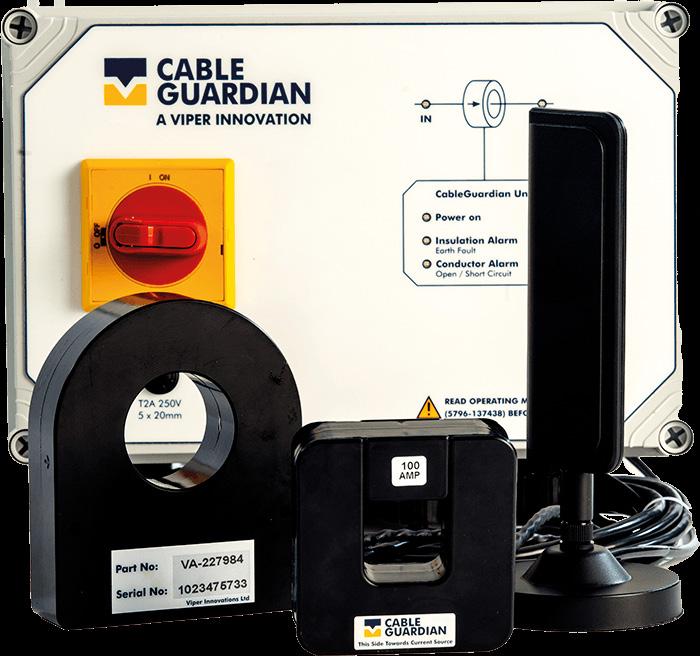


Reliable, flexible axle counting solution with EULYNX interface.

Benefits
Standardised interoperability with higher-ranking systems
Simple, flexible integration in existing systems
Reduction of lifecycle costs
Highest safety and security standards
Successful implementation in practice

Traditional centralised railway systems frequently struggle with scalability, which makes any upgrades complex and costly, often causing significant downtime that affects the entire network. Modern wayside object controllers (WOCs) with EULYNX interface help to overcome these issues and present a wide array of benefits for the operator.
In modern railway signalling architectures with WOCs, the interlocking can be placed in a central location or even the cloud, while the control of various objects, including track sections or points remains locally. WOCs control field elements by acting as a central link between the field element and the interlocking. The shift to a decentralised architecture made possible by WOCs creates greater efficiency and allows for easier scalability, presenting the operator with increased
In signalling technology, WOCs control and monitor systems installed on track and serve as the essential intermediaries between field elements and the interlocking systems. Field elements can be objects such as track sections, point machines or any generic IO used within the signalling system. By managing and passing on essential data and commands from the interlocking system, WOCs are able to effectively control the field elements and provide status updates, as well as collect and transmit diagnostic data. In the example of a turnout, a WOC is responsible for the continuous monitoring and controlling of one or multiple associated point machines. It receives positioning instructions from the interlocking and activates the electrical supply to the motor. Additionally, the WOC evaluates the position switch of the point machine.

There are various key requirements that WOCs must be able to fulfil, such as upholding the highest standards in terms of safety and security, providing a wide range of connectivity options and a common user experience, as well as a high degree of modularity. Moreover, thanks to WOCs with standardised interfaces such as EULYNX, the different life-cycles of the signalling components and field elements are effectively decoupled which further reduces costs in case of upgrades to the system. By adhering to EULYNX standards, object controllers ensure compatibility and interoperability between railway systems from different manufacturers. For WOCs to function, they must be able to connect

to a network, in order to communicate with both the interlocking system and a centralised data management system. This network connection, via a standardised interface enables real-time data transmission and control of field elements.
The EULYNX architecture comprises the following interfaces, which are used for standardised data exchange between wayside objects and interlocking:
• SCI (Standard Communication Interface): This interface handles the transmission of commands and messages. Safety-relevant information such as the status of track sections (free or occupied) and reset commands are communicated through the RaSTA (Rail Safe Transport Application) protocol.
• SDI (Standard Diagnostic Interface): This interface is dedicated to diagnostic data. Using an OPC-UA server, it provides detailed diagnostic information about the wayside objects and components. This allows for real-time monitoring and analysis, helping to quickly identify and resolve issues.
• SMI (Standard Maintenance Interface): The SMI enables maintenance tasks to be executed. Including configuration updates, software and
patches and ensures that maintenance activities can be performed efficiently and securely.
• SSI (Standard Security Interface): This interface focuses on security-related tasks. It supports certificate, key, and authentication management as well as security logging by being connected to a security service platform.
Modern signalling architectures incorporating WOCs with a EULYNX interface represent a significant advancement over traditional railway systems. By adhering to the EULYNX standard, these systems achieve high levels of safety, security and interoperability. In conclusion, the utilisation of modern WOCs allows railways to future proof their signalling systems by ensuring compatibility with new technological advancements.
For more information visit our website or contact us.



In2021, a new body – ‘a single guiding mind’ – was announced with fanfare as part of a reform of Britain’s railways. When, one year later, the establishment of the body, Great British Railways (GBR), was put on hold, the irony was not lost.
Delays – along with strikes, a lack of reliability and poor standards of service – are regarded as common features by rail passengers on Britain’s rail network (the oldest in the world) and something they are resigned to. The Government’s rail factsheet shows that, in 2022-23, the percentage of punctual trains stood at just 67 percent.
As the headlines around GBR (now in transition phase) and its merits continue, the core challenges faced by train operators of ageing infrastructure, falling fare revenue, overcrowded trains and short-term financial windows remain. So how do we get rail back on track?
One important contributor to these challenges will be the advancement of the sector’s digital transition. As in other sectors, the benefits to be gained from making use of modern technology and what it has to offer are significant: increased volume of trains, better reliability and improved safety.
But, while examples of successful digitalisation in rail, in the UK and globally, are growing, full digitalisation is some way off.
The benefits to be gained from adopting digital solutions, the blockers and the steps needed to speed up the pace of the transition were comprehensively detailed in a report last year from the Rail Industry Association (RIA) – the UK rail supplier body.
In its Data and Digital Technologies in Rail paper it called the early 2020s a “critical crossroads” for the UK rail industry, citing wide societal and behavioural changes, including those imparted by COVID19, the proposed formation of Great British Railways and political shifts.
The report, which is very much worth reading in full, provides a well-considered view of why quicker adoption of digital is needed in rail, what the current blockers are and how to overcome them.
“While working on our Railway Innovation Strategy last year,” the group writes, “it became clear that many innovations rely on the availability of good quality data, people who understand how to utilise this data,and organisations that enable the use of data and digital technologies.”
Its recommendations include: more collaboration and sharing of best practice across the industry, clear leadership of the digital transition and a cross-industry drive to ensure employees are armed with the right skills for the digital world.
It also includes case studies which showcase the benefits that digital approaches in rail project delivery, operations and maintenance are already generating. These include the Transpennine Route Upgrade where
“While working on our Railway Innovation Strategy last year,it became clear that many innovations rely on the availability of good quality data,people who understand how to utilise this data,and organisations that enable the use of data and digital technologies.”

Bentley’s iTwin platform was selected as a user-friendly solution to connect the volumes of data being used and procured on the programme and make it accessible to the entire team.
Use of the platform, the programme has reported, improved information accessibility by 40 percent, saving more than 20,000 hours and an estimated £1 million in the first six months of implementation. The platform has supported better engineering decisions and delivery of safer, more reliable and more sustainable infrastructure.
HS2’s digital twin, which is being developed using Cohesive DataConnect is also referenced in the report with the “high level organisation[al] commitment” to data on the programme commended.
In partnership with HS2 Ltd, we have established what is known as its ‘Visualisation Hub’, (often shortened to VisHub) – a secure platform which connects the vast reams of complex and disparate datasets, such as GIS, BIM, CAD models, asset, safety, carbon and project controls data, being created and procured on the programme.
HS2’s VisHub, and the data intelligence and analytic capability it provides, is supporting enhanced communication and understanding among the HS2 teams and its stakeholders. It is central to processes such as design reviews and progressive assurance, as well as to engaging with stakeholders about planned activities.
Users report finding trusted information in seconds, in searches that would previously have taken hours manually.
The VisHub is the first stage in HS2’s vision to build a ‘digital twin’ of the railway – a virtual replica of the physical railway and how it functions as a system of interconnected systems.
So where do individual rail organisations get started as they attempt to modernise their approaches and unlock the benefits of today’s technologies?
Key areas to consider and questions to ask are these:
1. What insights do I need in order to deliver my objectives, e.g. a reliable, good quality service? What datasets do I need to integrate to get these insights?
2. Can I be confident my data can be trusted?
3. How do I make it easy for people in my business to find all the trusted data they need to support their decision making?
Consider the changes in organisation, behaviour and processes required to derive the full value from investments in digitalising your business. The transition needs to be worked through as an organisational change, not simply an investment in some new technology.
Building the case for a ‘big bang’ digital transformation programme is difficult and risky. Instead, think about initial projects you might want to introduce as ‘experiments’ to provide you with evidence of the impacts that you can achieve.
Grappling with these sorts of questions, probing the possibilities and understanding what your organisation stands to gain from a digital approach is key.
These are exciting times in our sector, with so many ideas coming down the tracks. Let’s seize the initiative and make the railway’s digital transition a resounding success.
To find out how Cohesive can support your implementation of new technologies as well as the ‘people’ and change aspects of digital transformation, please contact andy.stephens@cohesivegroup.com



In an era where the global rail industry faces the pressing need for enhanced service reliability, reduced operational and maintenance costs and improved safety, Transmission Dynamics has stepped in to redefine the status quo.
This UK-based, multi-award-winning company, renowned for its expertise in bespoke sensor development and Industrial Internet of Things (IIoT) solutions, has developed a range of proprietary technologies that revolutionise railway asset and infrastructure monitoring through advanced trainborne sensor technology. Their aptly named Trains with Brains® solutions offer continuous monitoring and reporting capabilities that mitigate numerous industry challenges.
At the heart of Transmission Dynamics’ innovations lies PANDAS-V®, a groundbreaking system combining advanced IIoT sensor technology with a unique design. This system features a roof-mounted camera synchronised with a pantograph-mounted wireless accelerometer, detecting changes in overhead line conditions during routine operation. With real-time onboard processing, PANDAS-V® utilises advanced AI protocols to take critical measurements and capture 10-second video clips of potential issues, pinpointing and instantly reporting them to relevant stakeholders.
PANDAS-V® has proven effective in preventing serious issues and reducing maintenance costs for
infrastructure maintainers globally. Michael Dobbs, Principal Engineer at Network Rail, praises PANDAS-V® for its critical role in identifying problematic locations, stating, “The PANDAS-V® system could have prevented more than £5.9m worth of costs over the last 5 years on the Class 350 trains alone.”
Since the system’s release in 2021, the combined fleet of PANDAS-V® cameras has automatically deployed 7 million reports with practically zero no-fault finds, making an unparalleled contribution to the improvement of the OLE infrastructure. Case study highlights include:
• De-wirement Prevention: PANDAS-V® preempted a potential de-wirement caused by the fast deterioration of tension in a cross strainer wire, generating alerts hours before the issue could escalate.
• Contact Wire Fatigue Detection: PANDAS-V® identified a contact wire fatigue failure, registering regular alerts and highlighting the need for proactive maintenance to prevent a severe incident.
• Fault Detection: PANDAS-V® detected repeatable impacts at a specific location, causing chipping of the carbon strip of the pantograph. The client stated, “Subtle faults like this one are very difficult to find.Without PANDAS-V® it would be like trying to find a needle in a haystack.”
• Catenary and Insulator Damage Prevention: Significant damage was prevented when PANDAS-V® reported this impact and Oliver Corfield, Senior Asset Engineer, noted, “Without this alert,the missing cross contact wouldn’t have been reported,potentially leading to a costly de-wirement.”
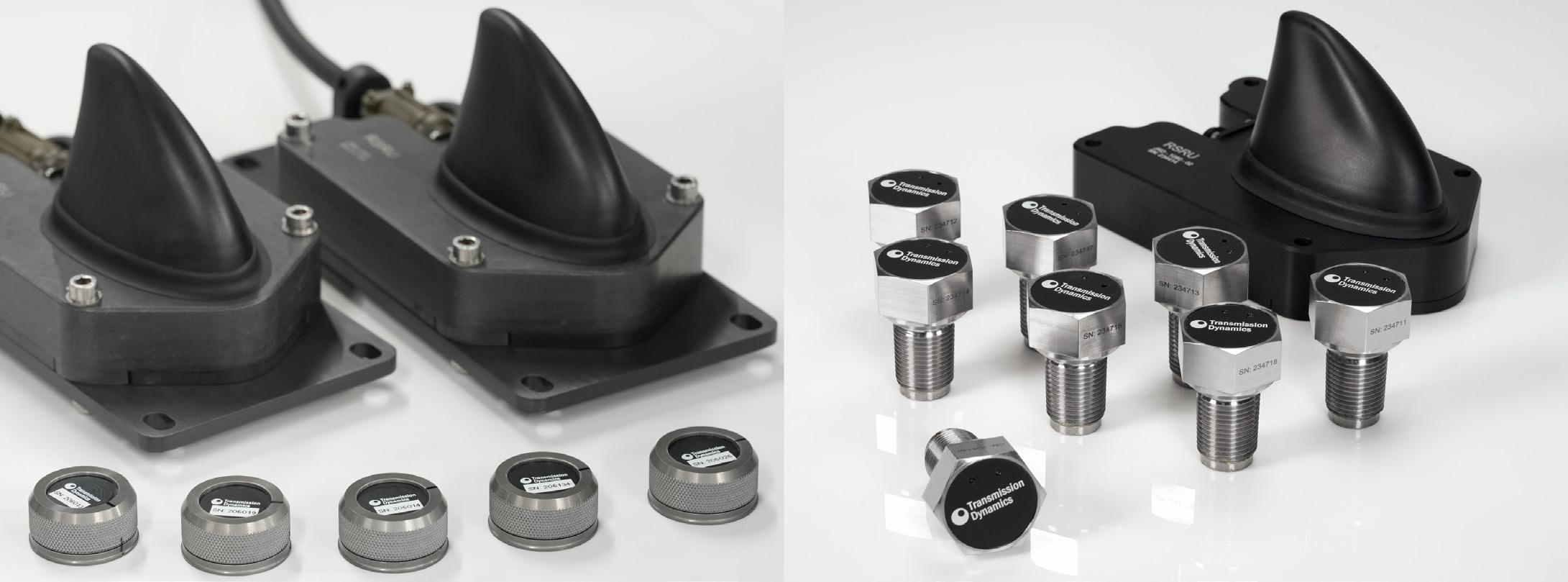
SmartBugs® are another testament to Transmission Dynamics’ innovation. These compact, wireless monitoring systems offer rapid deployment for various critical functions, including wheel flat detection, wheel rolling contact fatigue detection, axle box temperature monitoring, and track quality monitoring. Equipped with edge processing capabilities, SmartBugs® provide actionable insights based on temperature and vibration data, enhancing operational efficiency and asset management.
SmartBugs®' ease of installation and reliability make them invaluable for comprehensive asset monitoring.
A client noted, “Early detection of issues will see a move to more proactive,intelligent preventative maintenance rather than reactive measures.” Key case studies:
• Compressor Monitoring: One of the UK’s largest railway franchises uses SmartBugs® for compressor monitoring. They detected an abnormal rise in operating temperature and duty cycle, indicating a valve leak. Prompt alerts led to timely repairs, restoring performance.
• Rolling Contact Fatigue Detection: SmartBugs® regularly detect early rolling contact fatigue, allowing for proactive, intelligent preventative tyre turning instead of relying on mileage-based maintenance, significantly extending wheelset life.
• Health and Usage Monitoring: The system autonomously monitors and reports on the operating run-times of various assets, such as diesel engines, air compressors and traction motors.
The Smart Oil Plug® replaces traditional oil filler or drain plugs on railway vehicles to monitor temperature, vibration and ferromagnetic oil debris. This wireless, sensor-based solution offers a holistic view of gearbox health, providing early detection of potential issues like bearing failure and suspension defects. Detection examples include:
• Wheel Flat Detection: The Smart Oil Plug® uses the repeatable pattern of acceleration data to identify wheel flats. One client reported that after receiving an alert, the train was taken out of service immediately, and upon examination, flats were reported as 55mm long.
• Gear Quality Monitoring: The system revealed vibration levels exceeding the fleet average, prompting client inspection and subsequent repair, averting potential failures and premature drivetrain failure.
• Shaft Issues: This technology detects amplitude modulation to indicate potential shaft issues, enabling the scheduling of proactive maintenance.
Transmission Dynamics’ Trains with Brains® solutions have demonstrated their transformative potential across the global rail industry. From preventing catastrophic failures to optimising maintenance schedules, these cutting-edge innovations have provided tangible benefits in service reliability, operational efficiency and safety.
To find out more about Transmission Dynamics visit www.transmissiondynamics.com
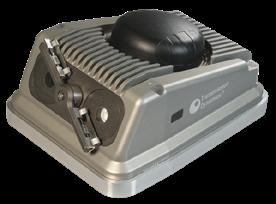

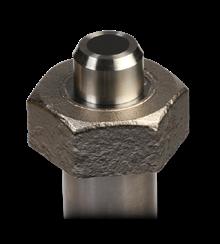



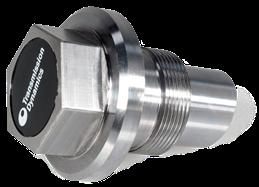

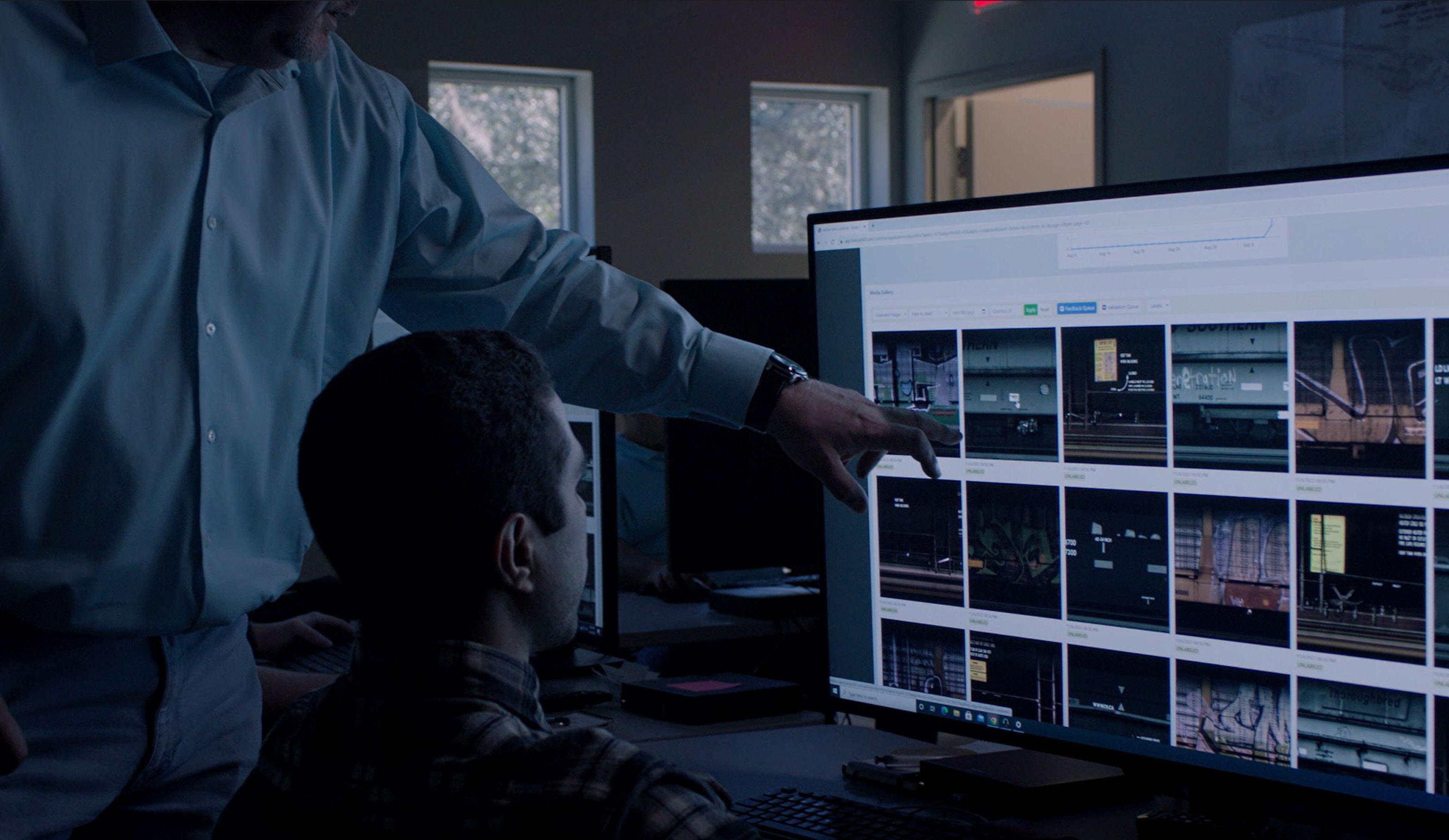
Our patented Railcar Inspection Portal (RIP®) has been a cornerstone of safety and efficiency for Class 1 freight and passenger railroads for well over a decade.
Operating at track-speeds (up to 125mph), the RIP® acquires high-resolution images in a combined 360-degree view of each railcar. They are instantly available for review by system operators, including qualified railcar inspectors through our CENTRACO® UX. Just as quickly, an impressive collection of over 50 advanced artificial intelligence machine learning (AI/ML) models work to automatically detect critical
anomalies and mechanical defects and help to call attention to problem areas – ultimately helping prevent catastrophic situations.
CENTRACO®, the RIP's intuitive user experience, provides an easy and thorough way to review every railcar in the consist, quickly and efficiently highlighting what's important. Advanced inspection capabilities within the interface enable users of the system to assess close-up views of the railcar's parts and offer perspectives that can only otherwise be achieved by crawling under the railcar which can lead to dangerous situations for the inspector doing the work.
The RIP® has revolutionised how railroads maintain safety standards while improving operational efficiency by providing advanced remote visualization capabilities combined with automated analysis using state-of-theart artificial intelligence.
Now, we're excited to announce the launch of the RIP® Subscription Service. Initially available in the US, it is a groundbreaking offering that extends the value of this powerful technology beyond the tracks themselves.
The RIP® Subscription Service leverages the existing infrastructure of our RIP® systems already deployed on North American Class 1 customer railroads. This innovative Software-as-a-Service (SaaS) offering goes well beyond simply utilising the hardware – it unlocks the wealth of safety and mechanical condition data it generates and provides it to consumers who have never before been able to access this data.
This data is invaluable to a wide range of stakeholders in the rail industry. Railcar owners and operators can gain real-time insights into the health of their fleets, allowing for proactive maintenance and reduced downtime. Shippers can track the condition of their cargo and condition of their fleet throughout its journey, ensuring safe and timely delivery. Railcar manufacturers can identify potential design flaws or recurring issues through in-field data, improving future models.
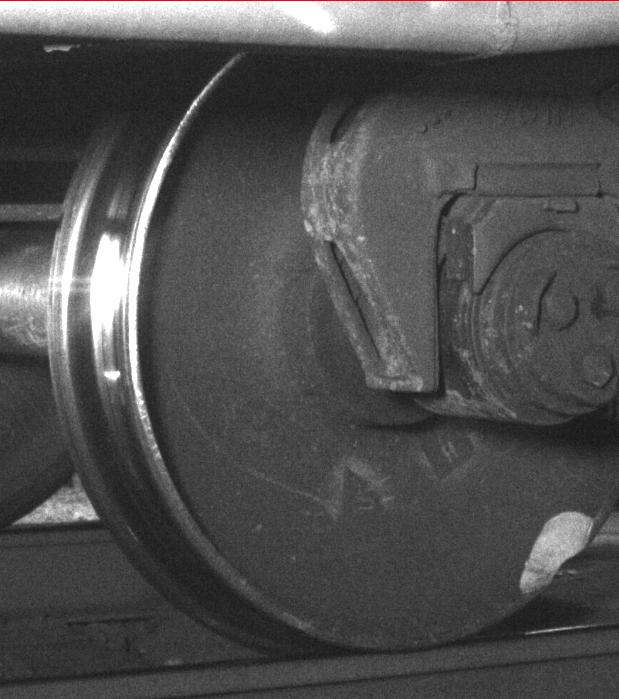
The RIP® Subscription Service offers a flexible and costeffective solution for these entities. By subscribing, they gain access to the critical data generated by the RIP® system without the significant upfront investment in the hardware itself. The affordable subscription offering is ‘software only’. There's no need to purchase, install or maintain additional equipment.
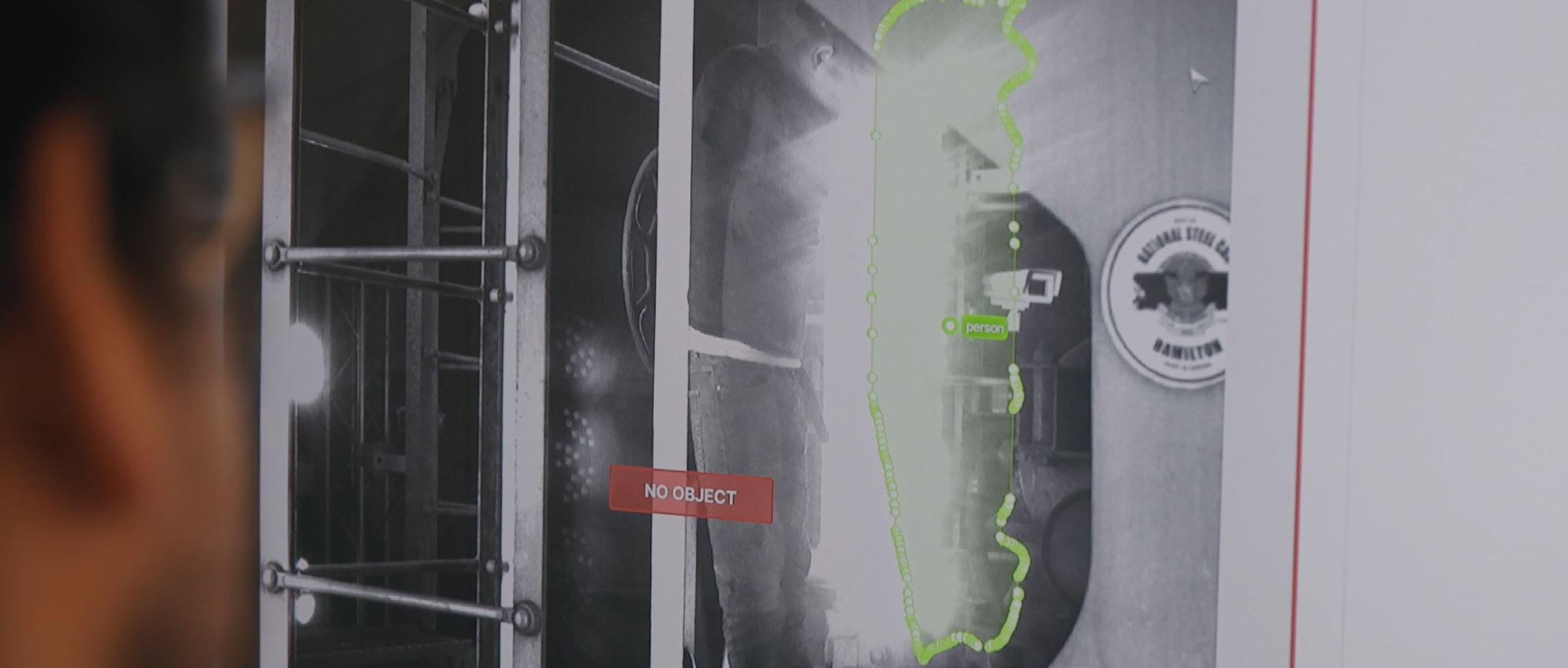

Although affordable, this powerful subscription model offers:
• Scalability: Scale data access to meet specific needs, from a single car to an entire fleet
• Real-time visibility: Gain immediate insights into car conditions, facilitating faster decision-making
• Reduced costs: Address needed repairs early, before problem(s) become more extensive and expensive to remediate
The RIP® Subscription Service fosters a more collaborative environment within the rail industry. By sharing vital data across the ecosystem, stakeholders can all work together to:
• Enhance overall rail safety by proactively addressing potential issues before they escalate
• Optimise rail operations through data-driven maintenance and repair strategies
• Improve equipment lifespans by identifying and addressing wear and tear early on
The launch of the RIP® Subscription Service marks a significant step forward in leveraging the power of data to transform rail safety and efficiency. By extending the reach of our RIP® technology, we are empowering a much broader and more significant range of industry players to work collaboratively to make informed decisions, ultimately building a safer, more efficient rail network for everyone involved – Class 1s, shippers, OEMs, governmental entities and more.
www.duostechnologies.com

Watch our video to find out more!




Train subsystems have a lot to tell you – it’s all there in the test data you’re producing, writes Bagali Siddaram, Director of Mass Transit at Astronics.
The rail industry is becoming ever more digitalised, including our specialist area of test, repair and support. This is becoming increasingly software-intensive, as onboard systems as well as trackside and wayside equipment continue to become ‘smarter’.
By ‘instrumenting up’ a train, which involves fitting a wide variety of sensors to these advanced electronics, these subsystems are providing operators with a rich source of information on the health of their equipment.
Today transport operators have data from their repair facilities and processes in droves, but not everyone is making the most of this information goldmine.
The data’s there for the taking, it’s just a matter of extracting and making sense of it, and if used correctly, can provide some significant financial and operational benefits.
For example, analysing your data can help you to understand whether fleet-wide maintenance is necessary, as well as better predict when such activities will need to take place.
This is made possible through the use of mature artificial intelligence (AI) and machine learning (ML) technologies, which may be simpler – and cheaper – to implement than you might think.
There are two main pathways you can take. The first analyses the large sets of data you’ve already produced and gathered from testing your subsystems. By doing so, it teaches an AI or ML algorithm how to uncover trends, spot anomalies and predict component lifecycles. Plus, as it’s continuously fed more information, it becomes ever more accurate.
The second route needs a little more effort. This involves segregating the data based on the subsystem, before ‘feeding’ it to the algorithm.
Implementing predictive maintenance doesn’t have to require a large pay-out; the majority of what you need may already be in place and readily available.
Managing this data doesn’t involve investing in a new enterprise resource planning (ERP) or database maintenance system, for example; a predictive maintenance tool can easily be integrated into an existing system.
In terms of the AI and ML technology, there’s no need to develop your own algorithms. Many of these are available on the market for low or no cost (freeware), meaning no additional software fees.
Finally, there’s no need to invest in new skills or specialists. This concept enables you to use members of your existing software team to model and implement these solutions.
As you can see, accurate predictive maintenance is possible at no extra cost – it’s simply a case of using what’s freely available to gather and analyse the data you already produce in a meaningful way.
To make the implementation of predictive maintenance
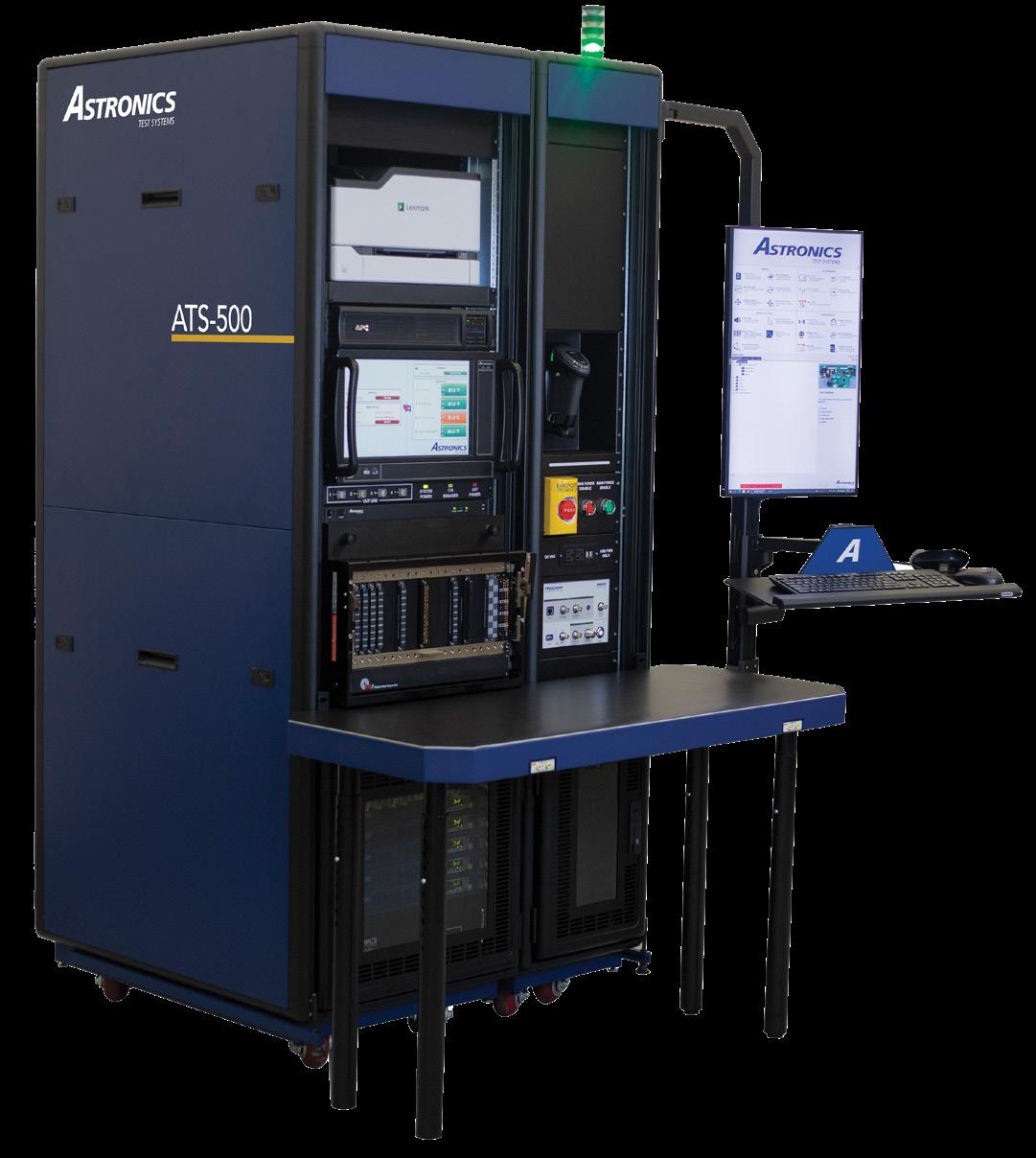
easier, it’s worth looking to centralise your data if you haven’t already done so.
Subsystems will often have their own tools to ‘read’ the raw data, which may lead to transport authorities using a myriad of tools from different manufacturers to understand the information they produce.
The best approach for managing this is to integrate all the third-party tools into a single system that can convert all the data into the same readable format. By doing so, you can store and access all your data in one place and one format, irrespective of what each subsystem puts out. It also creates a centralised database that can be used to feed the algorithm the information it requires to develop predictions.
Without doing this, your predictive system would need to be trained to read data in a variety of different formats, which is an unnecessary and avoidable investment of your time and resources.
If you’re interested in implementing predictive maintenance, we recommend starting small and then expanding.
Start with a pilot scheme on one subsystem and use
your chosen AI or ML algorithm to analyse its data and then check the results. This step could take some time, as the algorithm will need to learn about your data and how to analyse it. Once this predictive system has been implemented and proven, you can then extend it out to all subsystems with confidence.
From a service and maintenance perspective, Astronics believes predictive maintenance is a big part of the digital transformation of the rail industry. We plan to continue being ahead of the curve when it comes to offering our customers the most advanced and comprehensive solutions.
As a consolidated test solution provider for the rail industry, we’re unique as we touch every on-train component before it’s certified and rolled out. And our BTE is designed to test every component that comes back. This means we’re able to capture data from both healthy and faulty units, enabling us to understand the time to – and class of – failure. Developing on from this, we’re now proactively working on using AI and
ML algorithms to provide customers with a predictive maintenance solution that fully utilises existing resources.
Our test solutions are already gathering the raw data necessary to support predictive maintenance; this is simply the next step in providing our customers with the information they need to ensure they make the most of their equipment and manpower.
Our consolidated approach also means that all test results captured are gathered into one database, removing the need to task your teams with centralising your subsystem test data into a single new database.
To find out more about how Astronics can support your organisation, please visit our website or email us.





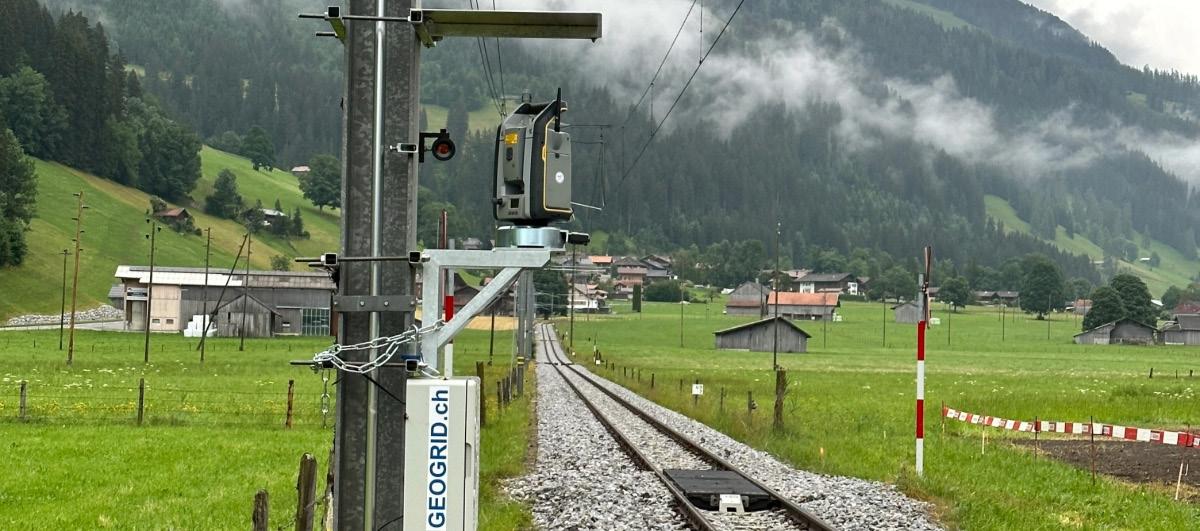
In the dynamic world of rail infrastructure, ensuring the safety, efficiency and longevity of assets is not just a necessity – it's an imperative.
With the rail industry facing increasing demands for reliability and safety, the technology used to monitor and maintain these critical assets has never been more important. Enter Trimble® 4D Control™ (T4D) for Rail (T4D Rail) software, a comprehensive solution designed to transform how rail operators approach monitoring and maintenance tasks.
Rail infrastructure is inherently subject to a variety
of stressors, from environmental impacts to the sheer weight and speed of trains passing over it daily. These factors can lead to track deformations, shifts, and other issues that, if not detected and addressed promptly, could result in operational disruptions or, worse, accidents. While effective to a degree, traditional monitoring methods often fail to provide the real-time, precise data needed to preemptively manage these risks. This is where T4D Rail comes into play, offering an innovative solution that combines advanced sensing technology with real-time data analytics for either short-term or long-term monitoring.
T4D Rail is engineered to provide continuous, automated monitoring of rail infrastructure. Utilising total stations and sensors from different providers, the system offers unprecedented accuracy in detecting minute movements and potential issues along the tracks.
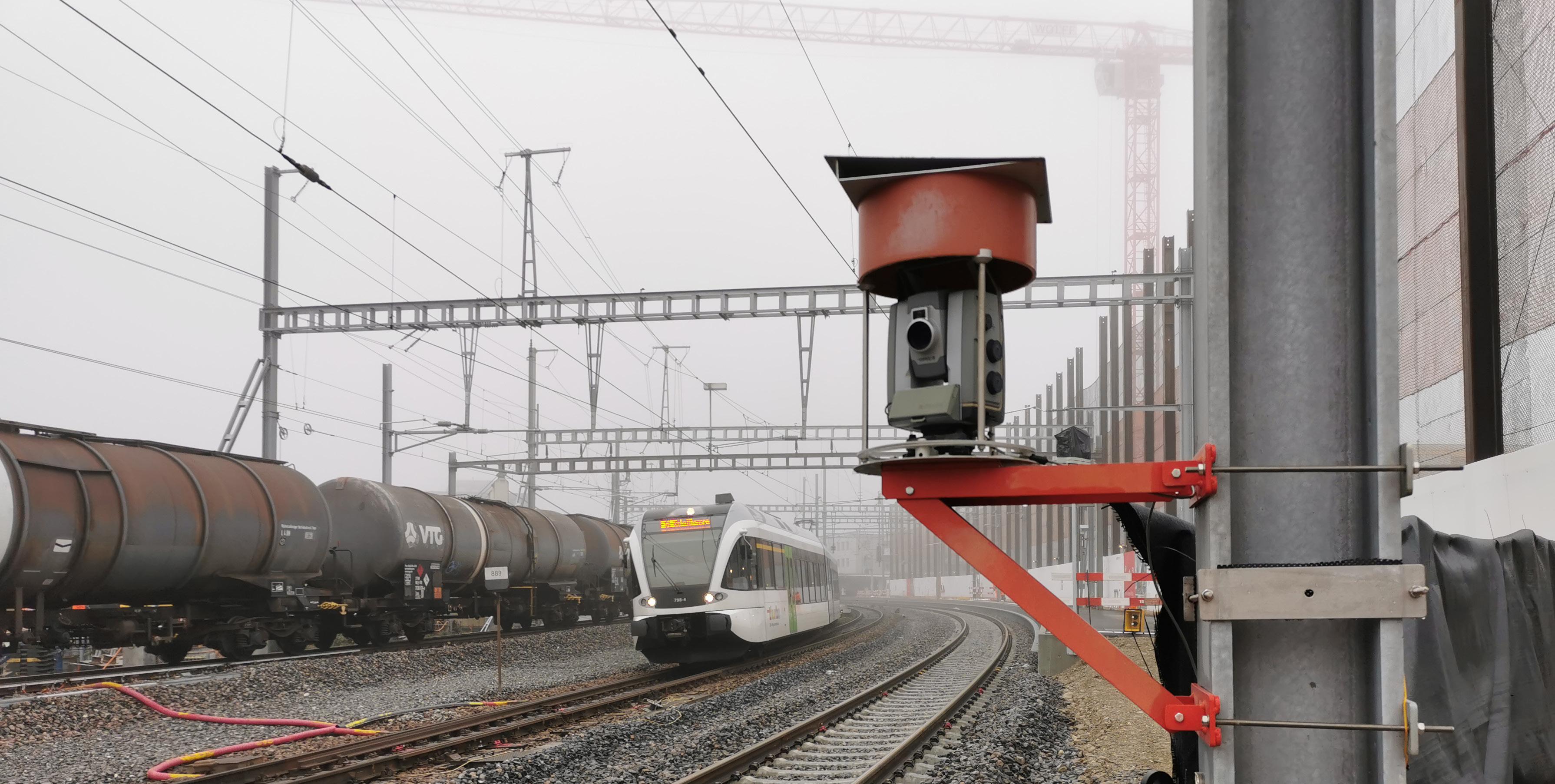
the background © Wild Ingenieure AG
This real-time data is then processed through Trimble's advanced software, providing operators with actionable insights and alerts to potential problems. The system is capable of identifying current issues, allowing for proactive maintenance and infrastructure management.
With a user-friendly interface and reporting capabilities, rail operators can easily access detailed reports and analytics, making it simpler to understand the state of their infrastructure and make informed decisions. The system's flexibility allows it to be customised to fit the specific needs and challenges of any rail network, whether it's a high-speed urban line or a remote freight route over treacherous terrain.
The efficacy of T4D Rail is best illustrated through its real-world applications. Wild Ingenieure AG, a Swiss engineering firm, utilised the system to overcome significant rail monitoring challenges in a mountainous region. The precise data collected by T4D Rail enabled the firm to identify and address critical track movements caused by natural land shifts, ensuring the safety of the rail line and avoiding potential service interruptions.
Similarly, GEOGRID AG, another engineering firm, leveraged T4D Rail to automate track monitoring for a major rail infrastructure project. The system's ability to provide continuous, accurate data eliminated the need for manual measurements, significantly reducing labour costs and improving the overall efficiency of the monitoring process.
Here are a few key points about the implementation and operation of T4D Rail that often come up:
• How does T4D Rail integrate with existing rail systems? T4D Rail is designed to be highly adaptable and capable of integrating seamlessly with existing rail infrastructure and software systems.
• Is specialised training required to operate T4D Rail? While the system is user-friendly, Trimble provides comprehensive training and support to ensure operators can maximise the platform's capabilities.
• What other solutions for track surveying are compatible for later track monitoring projects? While often used for the as-built survey for automated monitoring projects, a Trimble GEDO system and Trimble Access Track Gauge Survey app are also adaptable for semi -automated (campaign or manual) rail monitoring tasks as well. Rail coordinates are directly measured and used for rail monitoring calculations, which makes these tools versatile and a good investment.
As the rail industry continues to evolve, the need for innovative, reliable monitoring solutions like T4D Rail has never been clearer. By providing rail operators with the tools they need to proactively manage their infrastructure, Trimble is helping to not only enhance the safety and efficiency of rail networks but also helping pave the way for the future of rail transportation.
Click here to visit our website and find out more about Trimble.

How 6G Mobile Networks Will Revolutionise the Rail Industry

With 5G now fully rolled out, we’re already looking forward to the advent of 6G.
Starting in 2030 and slowly rolling out into different markets, 6G will digitally interconnect people and objects in ways we couldn’t imagine even three years ago.
What are the opportunities for the rail industry? A glimpse into the future.
You might have read about 5G being much more than a faster 4G. And that’s true. 5G offers three distinct advantages over 4G:
• Ultra-high data rate, great for the transmission of high-resolution images and video
• Low latency, indispensable for autonomous transportation
• Quality of service (QoS), the ability to ‘prioritise’ data: e.g. safety data from the train is more
important than Netflix movies for passengers
• That already opens up a realm of possibilities for the rail industry right now. But from 2030 onwards…
6G will be fundamentally different. it will enable virtual networks driven by the user’s needs. In other words: wherever there are multiple devices, a network will be created independently of technology. 6G will allow devices to seamlessly switch between technologies to whatever connection is available – 6G, Wi-Fi, Bluetooth, satellite – to satisfy the user’s needs.
Thanks to the use of virtual networks, 6G offers a much stronger connection. If one connection technology is down or unavailable – e.g. wireless internet connection in remote areas – alternatives can be used.
6G networks also allow symmetrical up and downlinks, that is, with equal download and upload speeds. Today, every network – even 5G – is still asymmetrical. It makes sense in a world where only humans connect to the internet: they consume more data than they produce. For Internet of Things applications (e.g. cameras on board a train), that’s no longer valid, however.
6G’s stronger connection opens the path to more real-time information, like video feeds from multiple cameras. But video is only the beginning. With 6G, even real-time holography is possible.
6G will provide a much safer travel experience: AIcameras can monitor the carriages for passenger aggression, for example. That way, security personnel can intervene quickly.
But 6G will also vastly improve the safety and scope of self-driving trains. Complete autonomy is not possible as of now, because network quality can’t be guaranteed everywhere. And an autonomous train that is not connected is not safe. 6G’s sophisticated QoS will always prioritise safety data.
Modern trains contain several kilometres of wiring. That’s expensive and also adds to the weight of the train. From 2040 onwards, with 6G, we can do without a lot of that wiring: every data connection will be wireless. That’s cheaper and lighter, but also allows for more frequent refurbishments.
6G is still in full research and development. Starting in 2030 and rolling out in the decades afterwards, possibilities will have expanded beyond what we can image at the moment. But it’s already a promising, robust concept that will fundamentally change our technology. And that's why we're already monitoring the standardisation of 6G and performing research projects around it.
For more information contact Televic GSP
www.televic.com/televicgsp
+32 51 30 30 45 televicgsp@televic.com

Televic GSP is dedicated to provide innovative and reliable:
› Passenger Information Systems
› Bogie Control & Safety Systems
› Services & Lifecycle support

With over 40 years of experience in the rail industry, and 60,000+ vehicles worldwide, we understand that quality solutions need to be adaptable. That’s why our flexible, modular systems adapt to any train’s unique needs. Not the other way around.
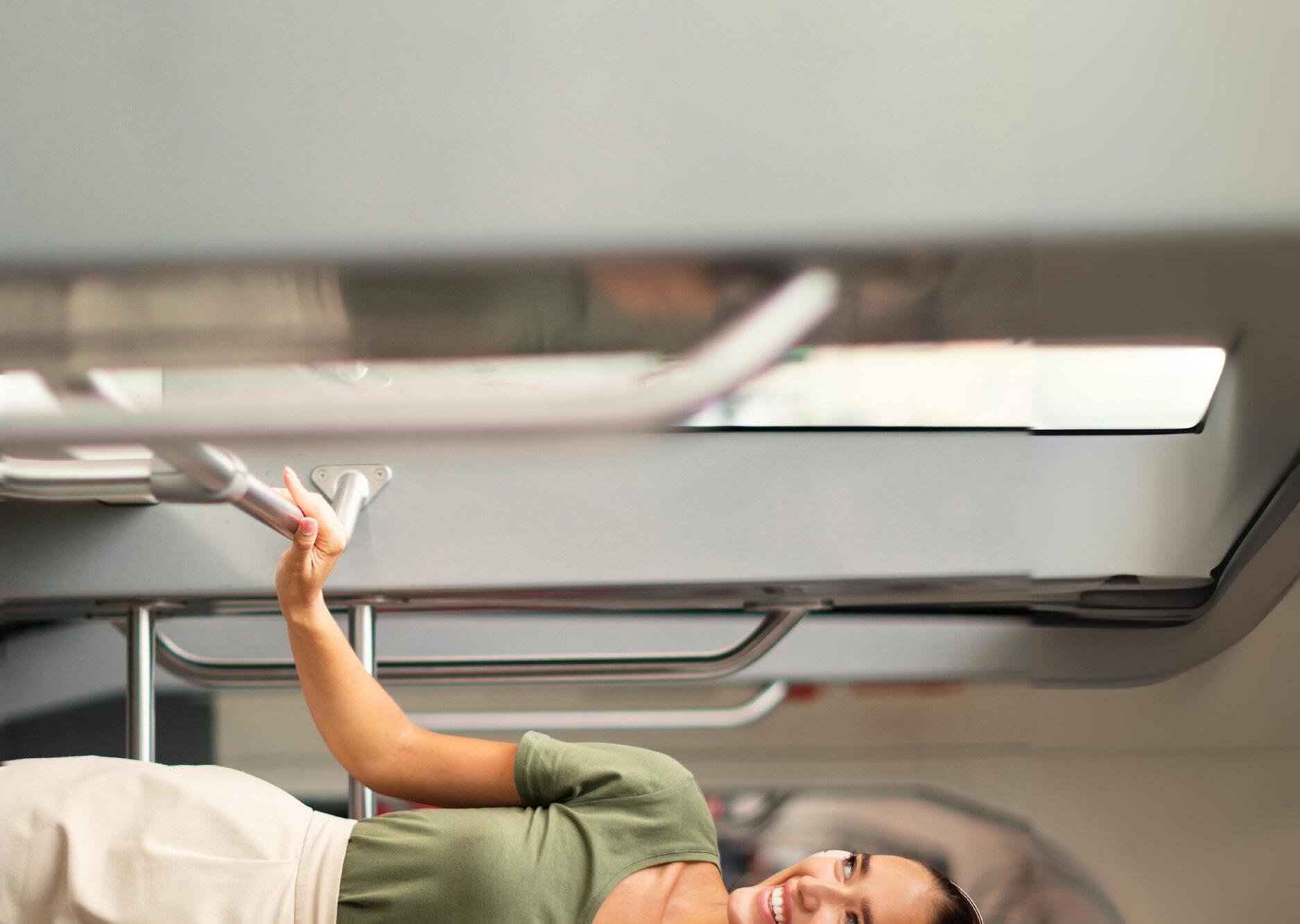
› Book a personal appointment now: www.televic.com/televicgsp

› Come by Hall 2.1, stand 505 and join us at our Belgian Beer Night!


You arrive at a busy train station. You know where you’re going, but you don’t know exactly where you need to go to get there. You immediately look for some sort of sign to point you in the right direction.
A crisp, bright Daktronics display catches your attention and shares the information you need. You go in the right direction, find the right platform and are on your way to your destination.
This scenario plays out every day in the lives of commuters and tourists. A quick guided tour from the entrance of the station to the concourse, navigating multiple platforms and finding the door to the correct train or bus. Clear, full-colour electric signage helps guide the way and get people where they need to go by showing time of day, train information, arrival and departure times, and updated information as the day goes on.
The passenger experience is very different than it once was, well before digital technology was available in the station. Today, these signs can change as information changes about the availability and departing times of trains and buses. And with it, passengers are aware of these changes as they move about the station and get to where they need to go.
These full-colour LED displays create a welcoming, even entertaining, environment. The text size can be changed and adjusted to best fit the display and its location to maximise communication with patrons. Branded images and additional weather, timing and current data can be shared with people as they move
along their way from the entrance to the concourse to the platform.
Behind all of this technology and communication, Daktronics has been developing and innovating over the years. From flip technology to single-colour to full-colour LED technology – and now tighter pixel spacing between those LEDs for better resolution and image clarity – the development of the best-possible solution for public transport applications continues. This includes the control system on the back end to ensure those images appear correctly and legibly for passengers.
With seamless access to news, weather data and multiple video feeds, the possibilities for information shown on these displays is exponential. From digital displays to control rooms and all the locations patrons see, Daktronics provides everything a transit station could need for keeping its passengers informed and getting to their destination in an easy, stress-free way.
Visit Daktronics at InnoTrans Hall 2.1, Stand 850
Find out more at www.daktronics.com
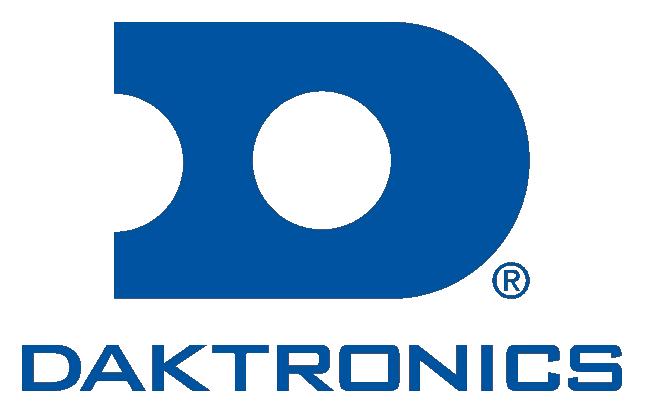
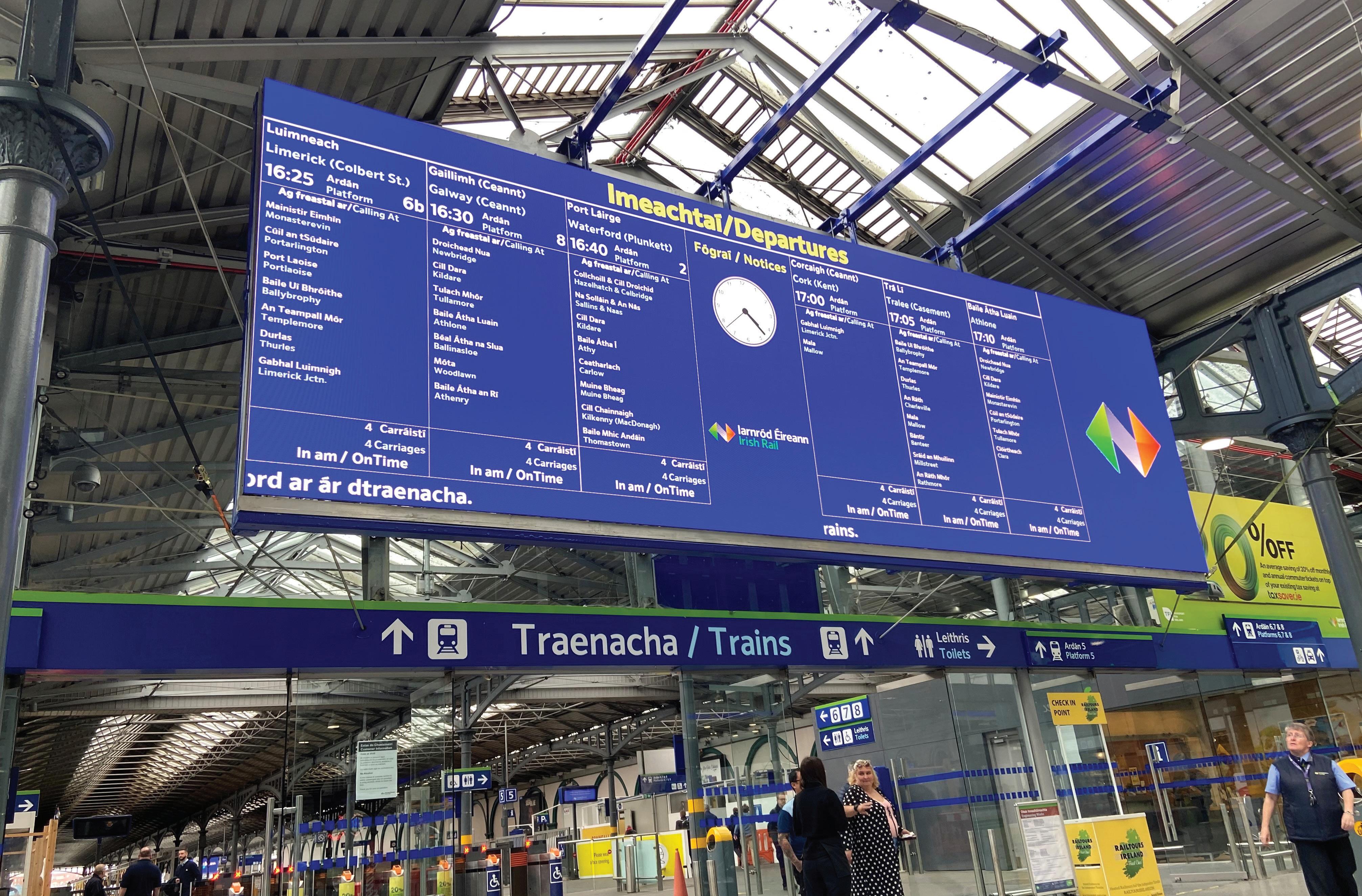
YOU’VE GOT PLACES TO BE WE’LL GET THERE
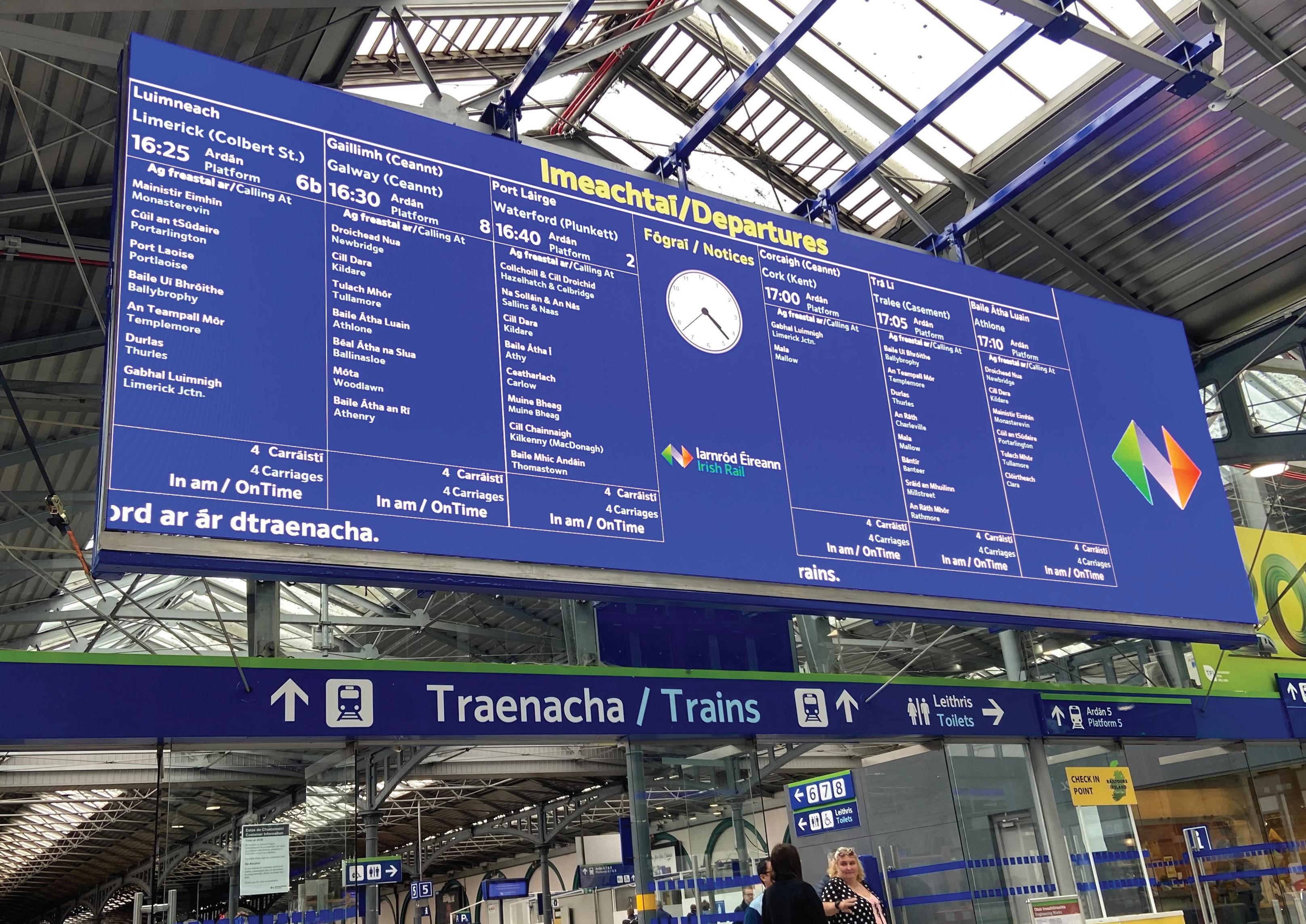






Johann Richert, Head of Project Management at CN-Consult, discusses how you can upgrade your customer experience by modernising passenger information systems.
Passenger information systems (PIS) are one of the key services that influence the travel experience.
Journey information with real-time adaptation to the current operational situation, clear and unambiguous announcements tailored to requirements and increased security through video surveillance in vehicles and stations are just some of the components of a modern PIS that provide passengers with a more positive travel experience.
One survey, undertaken by the German Aerospace Center (DLR), found that over two thirds (69%) of rail travellers were dependent on passenger information, and that demand increased hand in hand with digitalisation.
With this in mind, comprehensive dissemination of realtime information is no longer optional for rail transport companies.
A modern PIS adds value by introducing new technologies without additional personnel, and by automating actions so that the correct information
is always distributed, especially in exceptional circumstances.
With today's technologies it’s possible to create intelligent solutions for critical emergency situations, so that passengers are informed as required, while enabling the operator to concentrate on the critical actions.
In addition, a railway company is perceived by its users as innovative if its rolling stock is equipped with stateof-the-art passenger information. Many operators are already integrating various additional functions to the classic passenger information offering, such as train capacity indicators, passenger guidance, wayfinding and advertising content etc.
Another aspect often overlooked is that information can be prepared and transmitted in different ways. The PIS is the dynamic component of the railway and therefore is the visual face for the passenger. Real-time passenger information increases user-friendliness of the entire business and is ultimately a decisive factor in attracting more travellers to the railways.
Design is also a major component of the PIS that makes rail travel more enjoyable. Additionally, a good PIS will also increase staff motivation through its optimal workflow efficiency on the operator's side.
Nowadays, we’ve become accustomed to regularly updating our devices due to technological advances. With the speed of change, modernisation touches all aspects of our lives, including transport. The needs of train operators and customers change over time; they therefore need to take the same approach to renewing their technology. Rail vehicles are modernised halfway through their service life, usually around the 15-year mark, and PIS updates are a part of this process.
However, with increasing customer demands and progressive developments in this sector, these upgrades can be quite complex.
Upgrading to a PIS with new software and hardware components is a very difficult undertaking, especially during ongoing operations, as this often results in time constraints that need to be considered. With this

in mind, a modern PIS must also be easily expandable, so that it can be more simply adapted to future developments when vehicle modernisation occurs.
Experience shows that the risks often lie not in the general feasibility of the task, but rather the available resources, and communication between all the relevant stakeholders.
Furthermore, the time and effort involved is very project-specific. Not all rail operators will require the same upgrade path, as each will have their own experience with PIS and therefore be at varying levels of development. As a result, they each have a different set of requirements and potential contributions to make to a refurbishment project.
Professional planning is therefore key to the success of any given project.
CN-Consult has many years of experience in the PIS refurbishment sector and takes operational requirements into account when planning and implementing such projects.
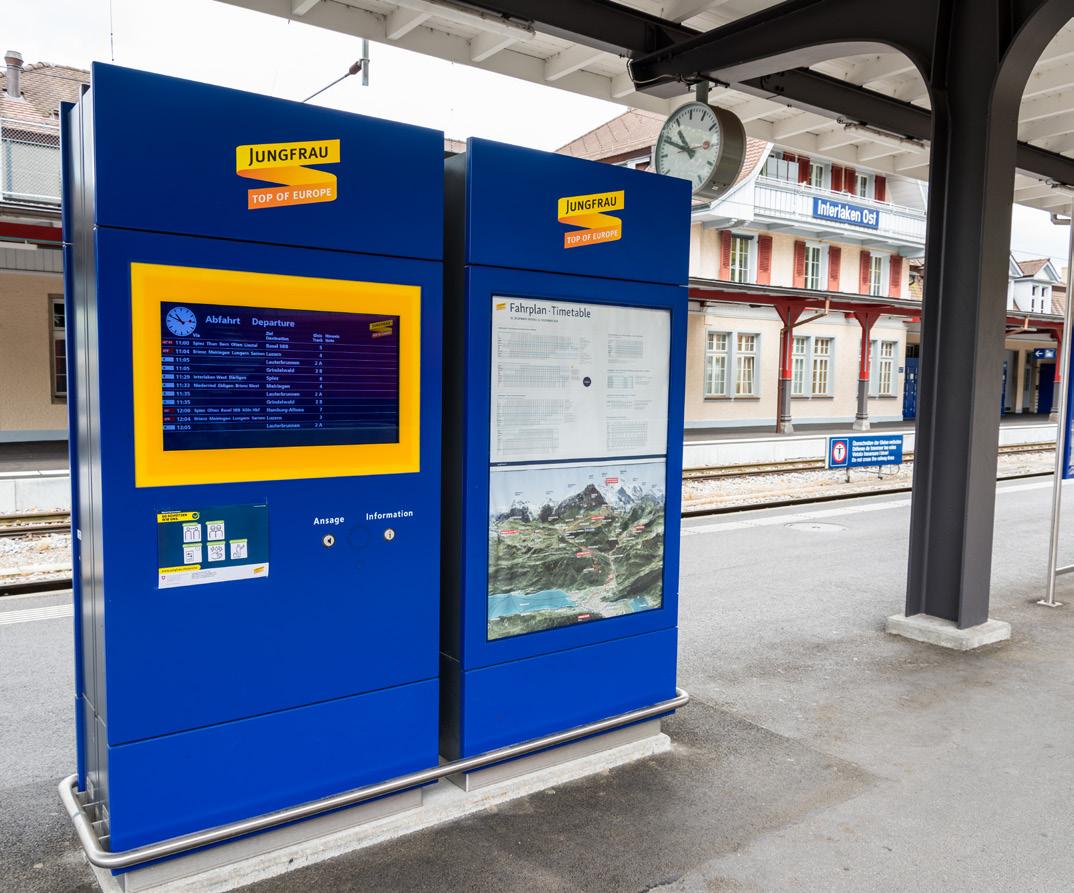
There are many options on how to display passenger information, each one individually tailored to the customer’s needs
Our first step is always to perform an on-site analysis, so that the offer and all surrounding components and potential risks can be considered before work begins.
The use of existing components ensures sustainability and helps to make refurbishment projects more efficient, and few companies have our experience of integrating existing components with new elements/ technology.
CN-Consult is also one of the few suppliers of complete systems, offering the entire passenger information portfolio of hardware and software, landside and onboard.
These services are complemented by the integration of existing subsystems and the custom development of interfaces, hardware and software to meet each clients’ specific needs.
Modern passenger information depends on communication and at the heart of this is the communication language between the vehicles and the landside system.
With our Mobile Passenger Information Interface (MPI), we’ve developed a communication protocol that, in addition to all the requirements of real-time passenger information (timetable updates, forecast
data, connections etc.), can also exchange a variety of additional information.
This includes, but isn’t limited to, status information from the hardware components, communication options between the driver and the control centre, live announcements from the control centre and data transfer from peripheral systems such as passenger counting data or energy consumption data.
The increasing necessity to exchange more data was a key factor in the development of the MPI. We decided from the beginning to deliberately disclose our interface and make it accessible to everyone to advance the railway market in this respect.
CN-Consult’s MPI is freely accessible to everyone and is constantly being improved upon, with all users informed of updates so that the interface sets new standards in its field.
In past projects, we’ve even found competitors abandon their own interfaces in order to benefit from the functionality, efficiency and integration options of our free MPI.
Modernisation projects are a discipline in their own right, especially in the case of the PIS sector, with detailed requirements that demand specialist knowledge.
As an experienced provider of PIS, both for new fleets and especially existing ones, we can draw on a wealth of experience in refitting systems and are here to support you when it comes to enhancing your customer experience with modern passenger information.
www.cn-consult.eu
For more information, please visit www.cn-consult.eu or email us at sales@cn-consult.eu.

Running Dynamics (EN 14363)
ASC accelerometers and IMUs record train drive dynamics and thus make it possible to assess derailment safety and other parameters. Furthermore, our ASC AiSys® smart sensor systems can even detect material weaknesses at an early stage.

Bogie Stability (EN 13749)
Train bogies are subject to heavy loads. ASC’s OS series capacitive accelerometers are ideal for bogie stability testing because they can easily withstand heat, cold, humidity, and dust (IP68).
Driving Comfort Test (EN 12299)
Our accelerometers will win you over with their low frequency and measuring ranges. They are therefore ideal for ride comfort measurements, where the smallest of linear accelerations and low-frequency vibrations have to be recorded.

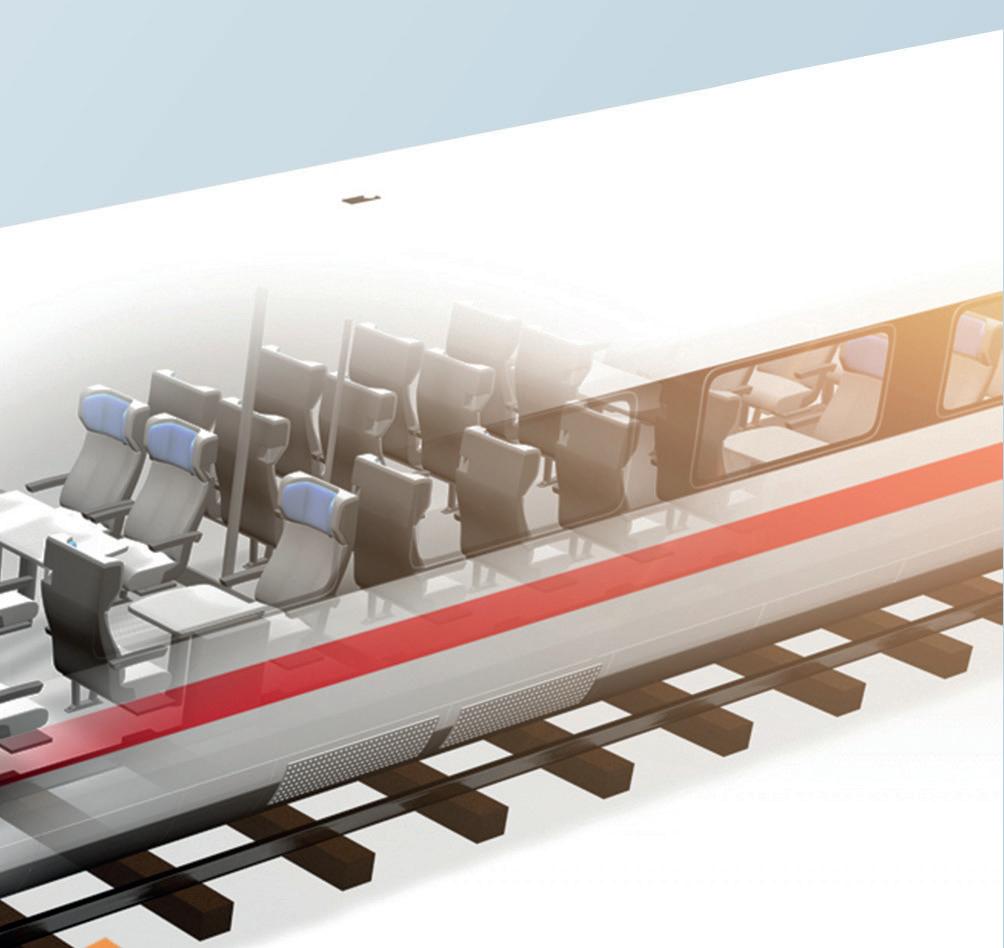

ANALOG • DIGITAL •
Record Track Geometry (EN 13848)
ASC’s piezoelectric accelerometers detect the vertical acceleration on trains. Uniaxial gyroscopes also measure the track geometry in the bends. This way, errors in the longitudinal height of the track superstructure can be detected quickly.

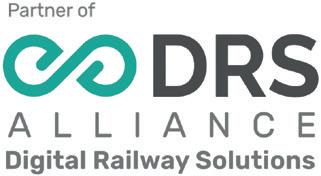
For maximum safety and comfort in rail transport
High-precision measurement of smallest vibrations in vehicles and infrastructure is a basic requirement for safe, comfortable rail transport. Inertial sensors therefore play a key role in the design and localization of trains, as well as systems for monitoring tracks and bridges. Many manufacturers have long relied on accelerometers, gyroscopes and inertial measurement units from ASC for these tasks.
Based on this know-how, smart sensors from ASC enable new solutions for real-time monitoring, early detection of future material weaknesses as well as efficient and predictive maintenance applications. With ASC, customers don’t just get a sensor, but an individual comprehensive solution for its use.

Gyroscopes
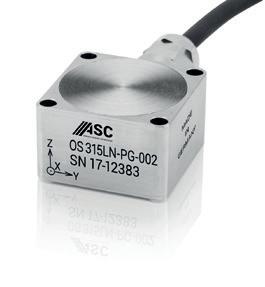


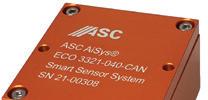
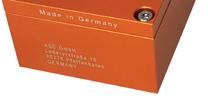

ASC’s RAIL sensor series provides highprecision, robust yet flexible inertial sensor technologies. The tailored solutions support railway customers in improving the safety, capacity and overall productivity of their rolling stock.
“Through the rigorous testing and documentation of our RAIL sensor series’performance,we’re making it significantly easier for railway operators to configure and implement individual inertial sensor solutions on their rolling stock,” says Renate Bay, CEO at ASC Sensors. “They can now rely on a proven set of stable precision sensors ready for installation,which meet the required norms and significantly reduce individual documentation requirements on the part of the operator.”
Pre-qualified accelerometers of type ASC RAIL-x152LN
are already being used by European and global rail operators. In June 2024, the sensor series was expanded with an additional accelerometer type ASC RAIL-x151LN, featuring a more compact housing to be able to fit into smaller spaces. The same smaller housing was used for the new gyroscopes of type ASC RAIL-27x1. For all three models, comprehensive evaluations by an independent testing lab resulted in clear outcomes for ASC’s reliable, accurate RAIL series.
The following tests have been performed according to railway standard EN 50155:2021 to confirm climatic resistance and dynamic-mechanical robustness:
• Low temperature storage test – test A
• Low temperature start-up test – test A (OT6)
• Dry heat test – test B (OT6)
• Damp heat, cyclic – test Db
• Insulation tests (before and after damp heat, cyclic)
• Vibration, broad-band random – long time test Fh (category 3: axle-mounted)
• Vibration, broad-band random – functional test Fh (category 3: axle-mounted)
• Shock testing – test Ea (category 3: axle-mounted)
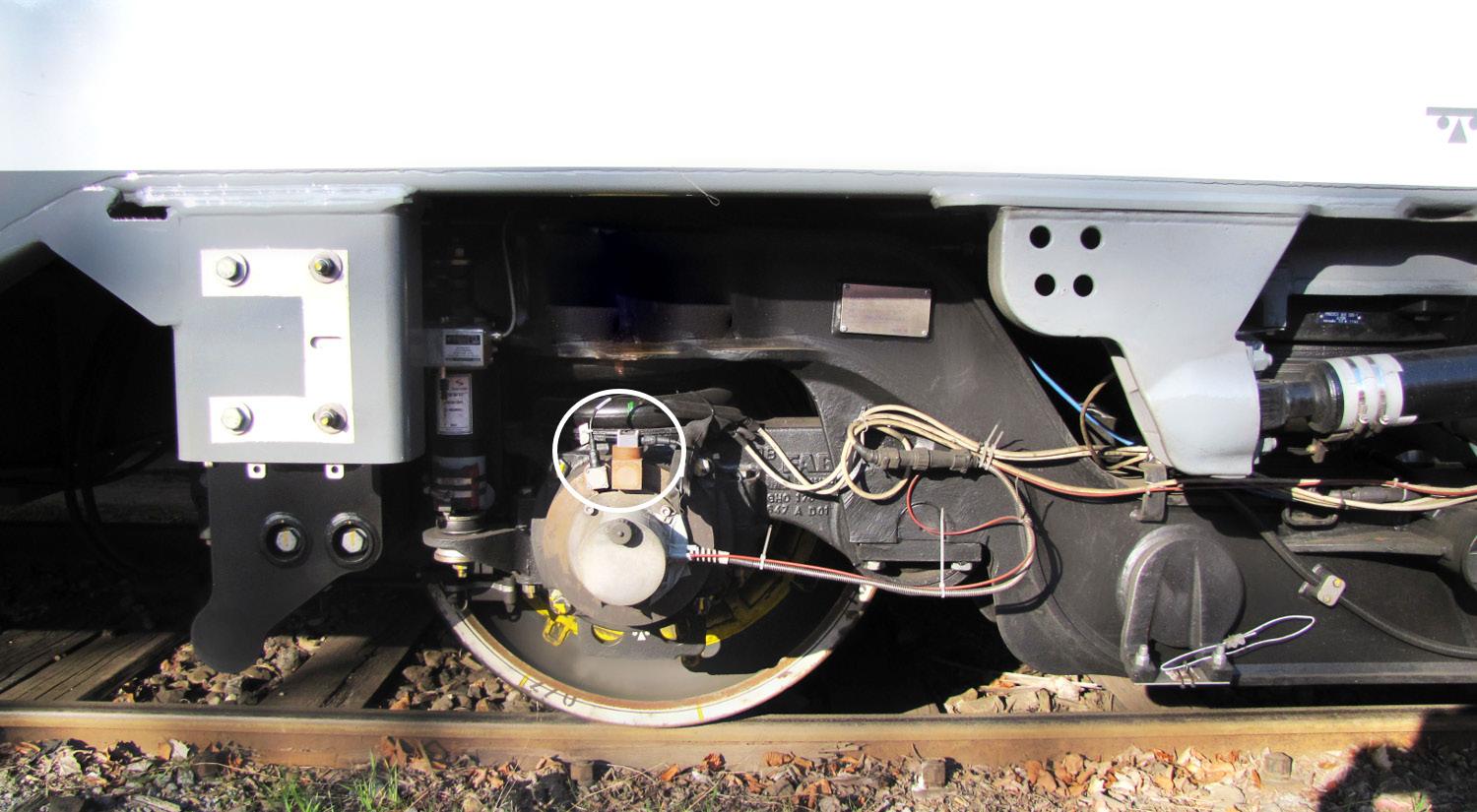
Further, interference emission and interference immunity tests were conducted according to standard EN 50121-3-2:2016+A1:2019, confirming electromagnetic compatibility:
• Conducted continuous disturbance at battery port
• Radiated disturbance, electrical field
• Immunity radiated electromagnetic fields
• Conducted immunity, injected currents
• EFT / Burst
• Electrostatic discharge test / ESD
In addition, all components of the ASC RAIL series were confirmed to meet the latest fire protection standards including EN 45545 for electronic equipment on rolling stock. This includes a robust, non-flammable, laserwelded stainless-steel housing featuring protection class IP68 as well as rail-certified cables and cable glands. Together with the proven in-built technologies this leads to a reliable sensor ecosystem capable of withstanding the hardest shocks, vibrations, temperatures and other adverse conditions typically encountered in rail applications. This ensures optimal performance and stable long-term operation of the sensor solutions even under the harshest conditions.
The standard accelerometers ASC RAIL-x152LN are available in uniaxial, biaxial and triaxial configuration. The newly developed, even more compact housing option is used for uniaxial and biaxial accelerometers ASC RAIL-x151LN, to fit them into narrower spaces.
Both accelerometer models are based on proven MEMS technology and capacitive operating principle. This technology enables the measurement of static (DC) and constant accelerations, which can be used to calculate the velocity and displacement of moving objects. Depending on the design of the spring-mass-damping system, however, it is also capable of detecting dynamic (AC) accelerations of amplitudes from ±2g up to ±400g and within a maximum frequency response range of up to 1kHz (±5 %). The integrated electronic circuits enable differential analog voltage output (±4V FSO) and outstanding noise performance from 7 to 400μg/√Hz.
The ASC RAIL-27x1 gyroscopes are based on established MEMS vibrating ring sensor elements. The design of

the micro-mechanical silicon structures makes these gyroscopes extremely insensitive to external impacts and vibrations. Their integrated electronic circuitry enables a single-ended, analog voltage output (0.66 to 2.64V FSO). These uniaxial, biaxial or triaxial gyroscopes are available in four measurement ranges (75°/s to 900°/s), featuring a bias stability of 12°/hr and an angular random walk of 0.2°/√hr.
ASC has further started configuring special editions of this same series of dedicated RAIL sensor applications. By combining accelerometer and gyroscope sensor elements, an integrated sensor system featuring up to three degrees of freedom with individually adjustable measurement ranges can be achieved. Considering all possible variations, this leads to the most flexible precision sensor toolbox for railway operators. This comprehensive solution is available to accurately capture, evaluate and manage all relevant factors required by individual customers, in a small, highly robust inertial sensor box.
“In essence,rail operators can now mix and match from ASC’s ready RAIL series components in building customised sensor solutions to meet their unique needs,” concludes Markus Nowack, Application Engineer at ASC Sensors. “Choosing from a proven set of inertial sensors meeting applicable national and international standards will significantly facilitate these tailormade solutions,saving time and budget while strengthening safety and economic outcomes.”
www.asc-sensors.de

The Eco Logic Platform: Pioneering Sustainable IT Solutions
Green IT is becoming increasingly crucial as every part of the value chain must adapt to support sustainability goals, including IT applications. IT solutions need to be carbon-efficient and adaptable to future regulations to meet these challenges effectively.
The Eco Logic Platform is a groundbreaking solution designed to address these sustainability challenges. It is built using one of the most energyefficient programming languages, and allows for the measurement of energy consumption for each software functionality in CO2 equivalents. The Eco Logic
Platform is ideal for modernising legacy systems and creating maintainable, energy-friendly software.
Eco Logic Platform – Rail Cargo ERP Modules
• Train Requests – registration, planning, executing, follow up, reporting and invoicing the request from a customer to run a train
• Offering – register the RFQ, assigning a logistical plan, adding additional services, calculating costs and creating the offer
• Contracts – contains the agreements and pricing of the orders
• Orders – contain all data about the transport, including consignment note; automatically validated against contracts and apply correct
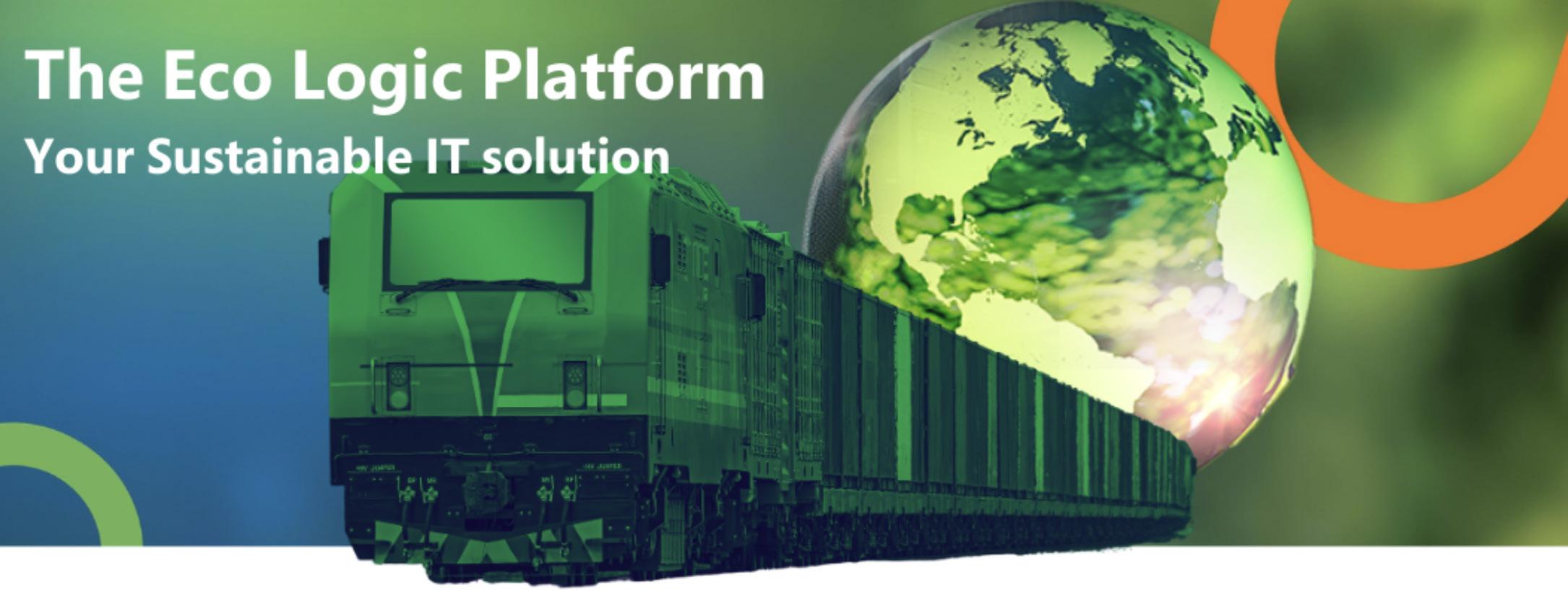
commitments; invoiced after execution
• Planning – order, train, shunting and activities planning, including validations
• Execution – running the trains including all relevant documentation; validations for safety, ensures real-time visibility and precise management of approved orders
• Wagon defect handling – registration, handling reporting and used in the execution of the transports
• Financials – calculation of revenue, creation of invoices, credit notes; mapping of supplier invoices
• Administration – manages user access, permissions and system configurations securely
• Master data - maintains essential data for seamless operation and consistency
• Reporting – dashboards, overviews and exports of data
• Mobile – handling of production activities via mobile applications directly connected to the main system
The fully integrated nature of the modules ensures that data flows seamlessly across the platform, providing real-time visibility and control over all aspects of rail cargo operations. This integration eliminates the need for custom integrations, reducing costs and implementation time. The Eco Logic Platform supports companies in fully replacing their ERP, updating parts of it or implementing an ERP system for the first time.
Rail Cargo Planning Based on DELMIA Quintiq from Dassault Systèmes
Rail Cargo Planning (RCP) is an advanced planning and optimisation solution designed specifically for the rail cargo industry. RCP integrates all planning horizons –long-term, short-term and day-of-operation – along with rolling stock and the workforce. The system features an intuitive user interface with drag-anddrop functionality and numerous decision-support tools to help planners create feasible and efficient plans. By enhancing planning efficiency, reducing costs, improving quality and increasing revenue, RCP helps cargo operators maintain a competitive edge
in a challenging market and lastly improve on the sustainability goals.
Key Features:
• Fleet planning: supports planning of trains, locomotives and rail cars across all time horizons
• Workforce management: creates and maintains shifts for drivers and ground staff, considering business rules and skill checks
• Labour rule compliance: automatically checks and issues warnings for labour rule violations
Planning optimisation: RCP allows planners to see the consequences of decisions or disruptions, resulting in higher utilisation of locomotives and railcars/wagons. It provides a clear overview of paths, optimising timetable costs and improving planning by considering all constraints.
Reduced costs: Enhanced information in the planning process leads to improvements measured by key performance indicators (KPIs). This includes reduced overtime costs, penalties for delayed shipments, and increased efficiency. The empty wagon repositioning optimiser reduces empty mileage and improves wagon turnaround.
Quality improvement: RCP offers stronger insights into the actual process, leading to more feasible planning with fewer last-minute disruptions.
Higher revenue: RCP identifies opportunities to include more wagons in a train, increasing revenue. The realtime traffic interface guarantees estimated time of arrival (ETA) to customers, enabling premium services and charging extra costs for loading delays to the responsible party.
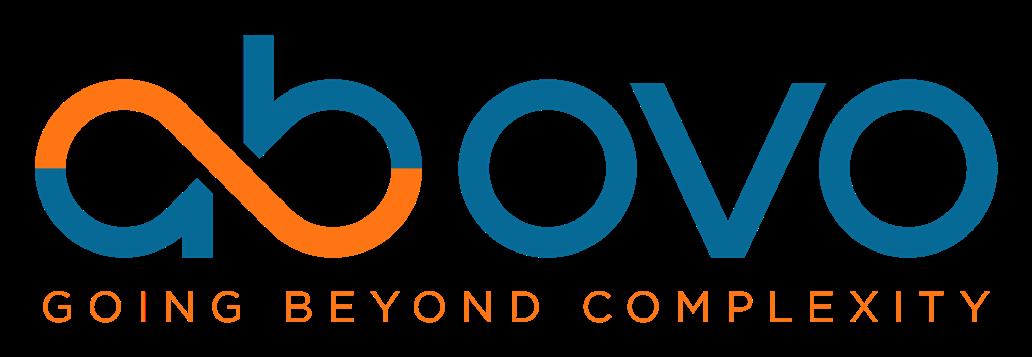
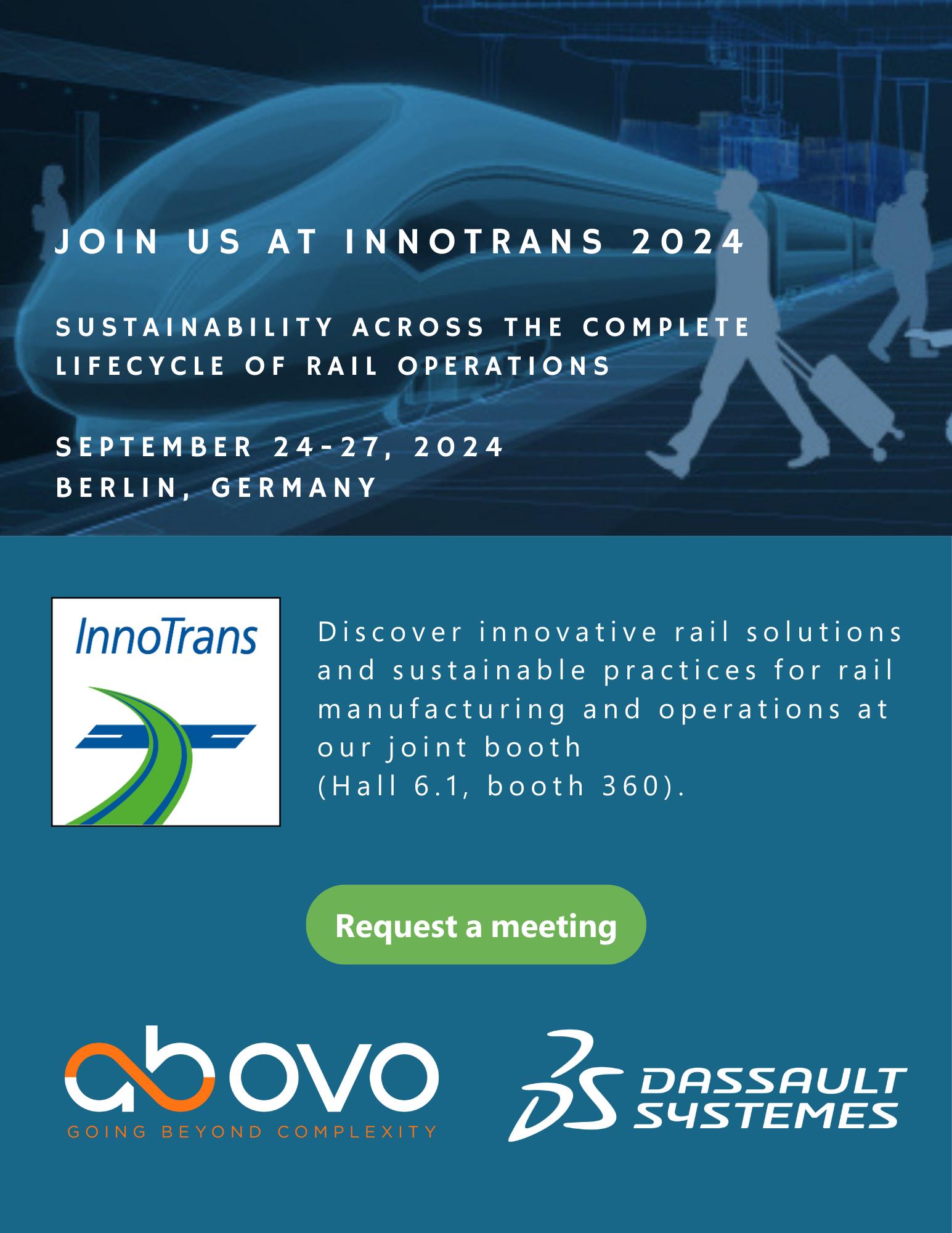

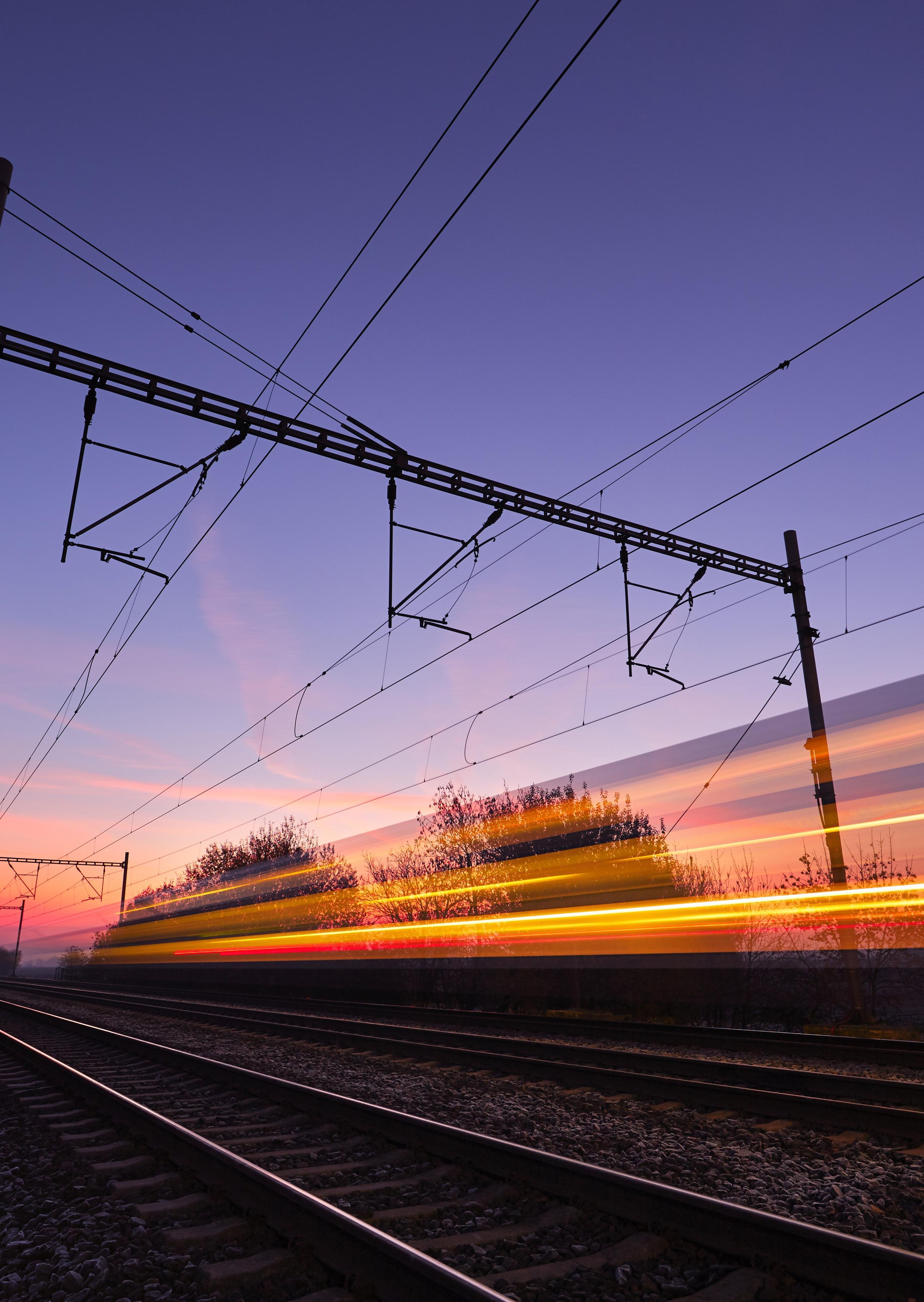
Buildings & Structure
Complete Composite Systems (CCS) p.176
Electrification
Morsdorfer Rail p.179
Worksite Protection
ZÖLLNER Signal GmbH p.182
Maintenance & Equipment
Laser Precision Solutions (LPS) p.185
Goldschmidt p.188
Pandrol p.189
Voltage Protection
WITT Solutions p.190
Works Vehicles & Machines
ROBEL p.191
Holmatro p.194
Harsco Rail p.197
Track Monitoring
Bender UK p. 200

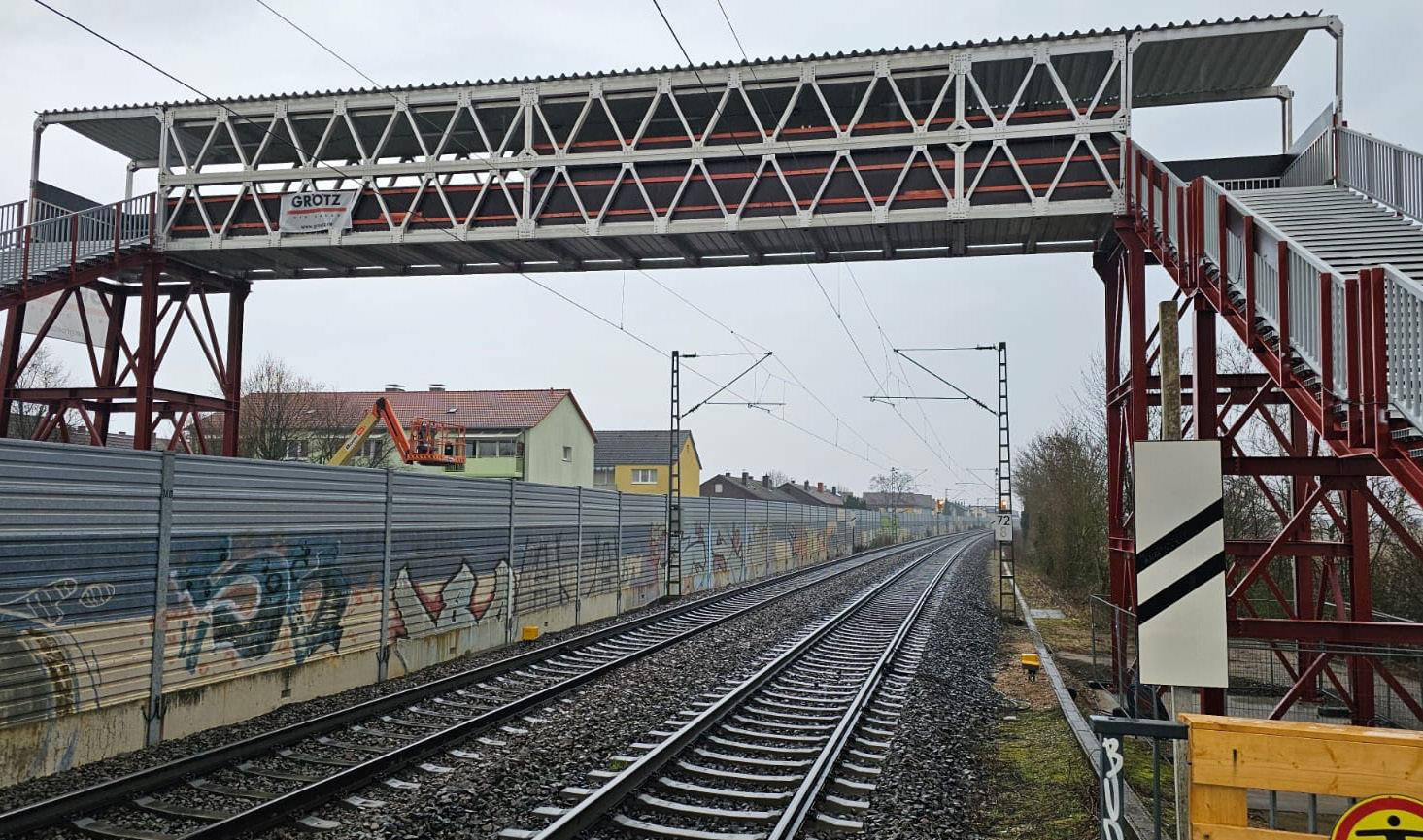
Traditionally-made bridges can be expensive and challenging to repair along a railway route over the years, which is why composite bridges — constructed from sustainable glass fibre reinforced polyester (GRP) — are proving popular as a durable and maintenance-free option.
Every railway line is dependent upon the reliability of its infrastructure, and older bridges made from steel, stone or concrete require costly repairs and maintenance over time to ensure their safety. But
Complete Composite Systems (CCS) has a modern solution in the form of composite bridges.
In association with our German partners BGL Ingenieurbau GmbH, CCS produces and instals composite bridges made from glass fibre reinforced polyester (GRP) for strong load-bearing performance and high corrosion resistance. As well as being extremely robust and durable, these bridges require no maintenance or repair during their long life.
As pioneers in the field of GRP bridge construction, our expertise and range of services extends from design and planning to manufacture in our own production

facility, followed by professional installation on site by our specialist assembly team of experienced installers.
Additional services such as foundation work, renovation of existing foundations and any substructures that may still be used, as well as associated earth and paving work, can be carried out by us. From the railings and the walkways to the load-bearing substructures, we simply do it all.
Due to their excellent properties, GRP applications have proven themselves thousands of times over in bridge construction. Our bridge over the B106 in Schwerin, built in 2003, remains the oldest GRP bridge in Germany, and is one of over 250 successful bridges we have installed to date.
We supply GRP bridges suitable for vehicles weighing up to 12 tonnes, as well as bridges for pedestrians. In addition to the GRP supporting structure, special heavy-duty GRP decks are also used for further reinforcement.
If assembly with a mobile crane is not possible, depending on the overall dimensions of the bridge, the lightweight GRP allows the possibility of carrying out the final assembly by hand. This can be very practical in poorly accessible and remote areas, such as forests or nature reserves.
In instances when old concrete abutments can no longer bear the load of a concrete, stone or steel bridge, our lightweight GRP bridges can allow — where appropriate — the old existing concrete abutments to still be used, saving costs.
As well as constructing new bridges, we also offer the renovation of usable constructions and substructures made of wood and steel. Various GRP railing variants and GRP bridge decks have proven their worth here. We have more than eight different bridge deck variants available, from normal pedestrian bridges to bridges suitable for vehicular use.


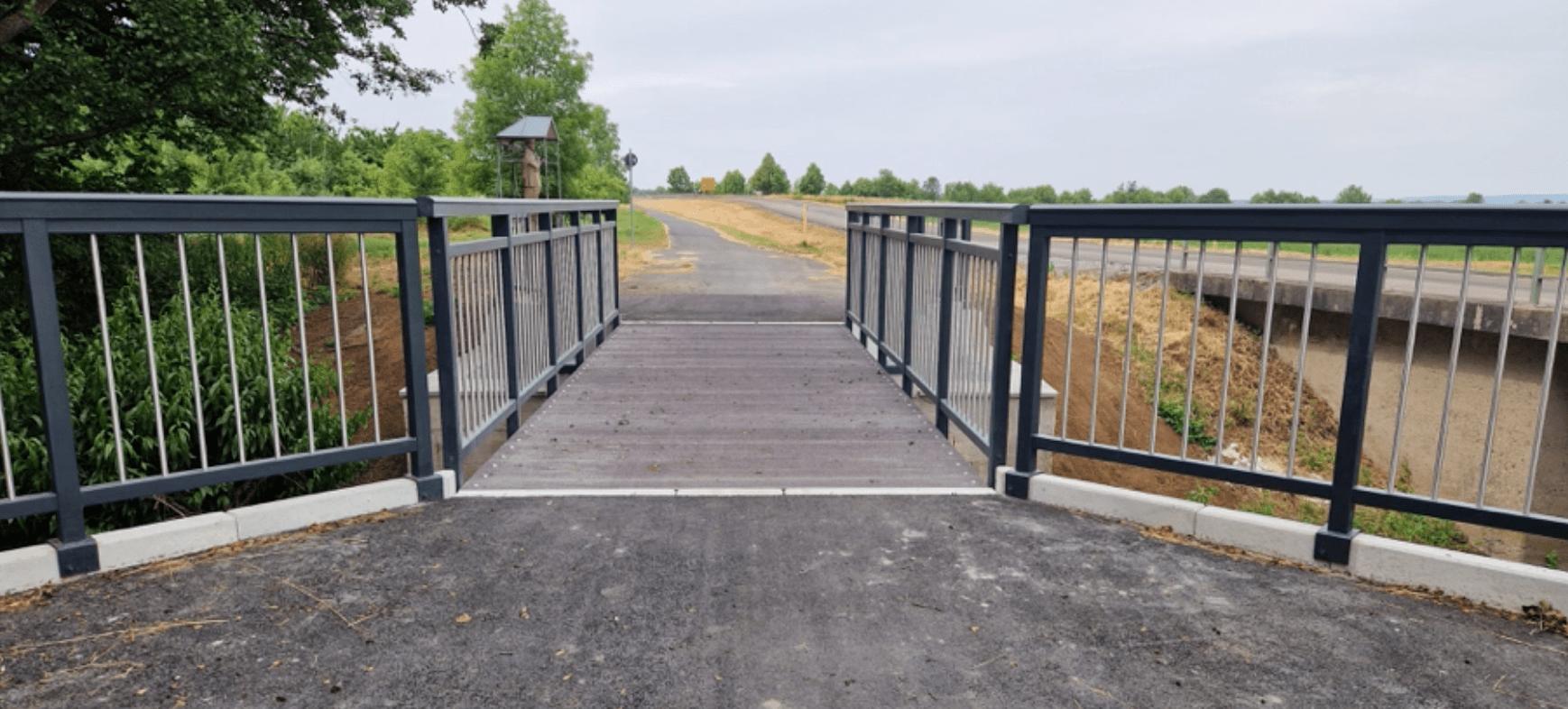
Advantages of using GRP materials to make bridges:
• Extremely robust and durable
• Strong load-bearing performance
• Dimensionally stable due to the pultrusion manufacturing process
• Free of maintenance or repair
• High corrosion resistance
• UV & weather-resistant
• Flame-retardant and self-extinguishing
• Environmentally sustainable
• Lightweight — easy to handle on site
• Quick and cost-effective assembly
• Available in any colour
GRP railway applications
We can supply:
• Brand new bridges or the renovation of existing railway bridges
• Tunnel linings, using GRP as a substitute for concrete, steel and wood with great success
• GRP gratings, open or closed
• A wide range of GRP railing systems and self-closing doors in hazardous areas
• GRP exit routes and staircases
• GRP entry and transfer platforms with matching surfaces and railings
See our composite bridges being installed in this presentation video above which includes drone footage of an assembled bridge being lifted over a river into position for final installation.
For more visit www.completecomposites.co.uk
Get in touch
Complete Composite Systems (UK partner and distributor)
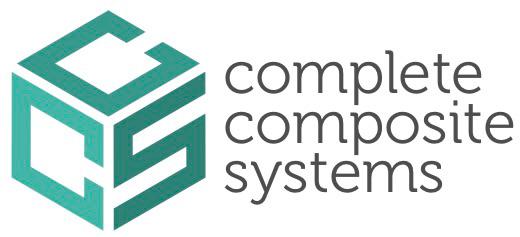
503 Broadway, Letchworth, Hertfordshire, SG6 3PT
Tel: +44 1462 379000 or +44 7860 147863
Email: info@completecomposites.co.uk
Our composite bridges are made in association with BGL Ingenieurbau GmbH





Spring Automatic Tensoning Device
Our Expertise for Railway and Tramway:
Our Expertise for Railway and Tramway:
- Railway Catenary Systems
- Railway Catenary Systems
- Tensioning
- Tensioning
- Insulation technology
- Insulation technology
- Power supply
- Power supply
- Safety equipment
- Safety equipment


Mosdorfer Rail Ltd.
Mosdorfer Rail Ltd.

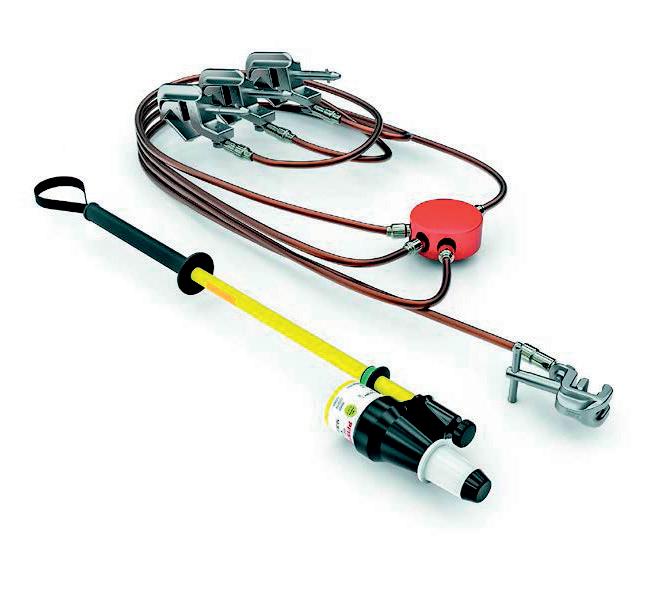

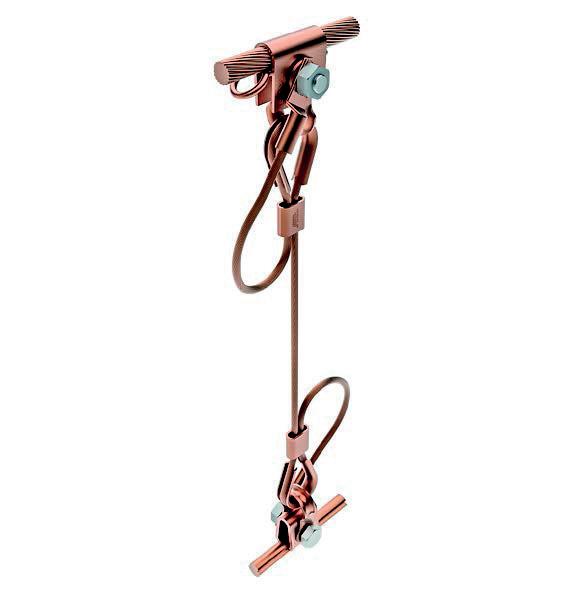
2 – 4 Orgreave Place, Orgreave
2 – 4 Orgreave Place, Orgreave
Sheffield S13 9LU, South Yorkshire, UK
Phone: +44 114 3878370
Sheffield S13 9LU, South Yorkshire, UK
Phone: +44 114 3878370
E-Mail: OrdersRailUK@mosdorfer.com
E-Mail: OrdersRailUK@mosdorfer.com


It has now been two years since Knill Gruppe completed the acquisition of PFISTERER Rail and the business is continuing to thrive under the new ownership.
Renamed as Mosdorfer Rail, the business has adjusted to the new environment and is flourishing as a key member of this family-owned organisation with over 300 years of experience within the engineering sector. The Knill Gruppe, based in Weiz, Austria, has 29 companies in 17 different countries and specialises in products and systems for the energy, communication and mobility infrastructure. The business employs over 2,300 employees worldwide, with an annual turnover of over EUR 440 million. The business ethos is to think and act in generations and not in quarterly reports, putting focus on securing the long-term future instead
of maximising results in the short-term. Knill Gruppe began in the year 1712, forging blades in the town of Weiz, Austria. Through the years the company product portfolio has changed from blades, sickles and scythes to power distribution and transmission and technology products and today the Group can be associated with ownership of established brands such as Mosdorfer, Lorünser, Damp, Elsta, Gridpulse and now Mosdorfer Rail which is the first venture of Knill Gruppe into the railway market.
Following the acquisition of the PFISTERER Rail business, the only real change is the change of ownership. All railway manufacturing locations and personnel have been retained by the Knill Gruppe, with production facilities based in Barcelona, Spain (railway catenary systems); Sheffield, UK (Tensorex C+) and Milan, Italy (research & development) continuing
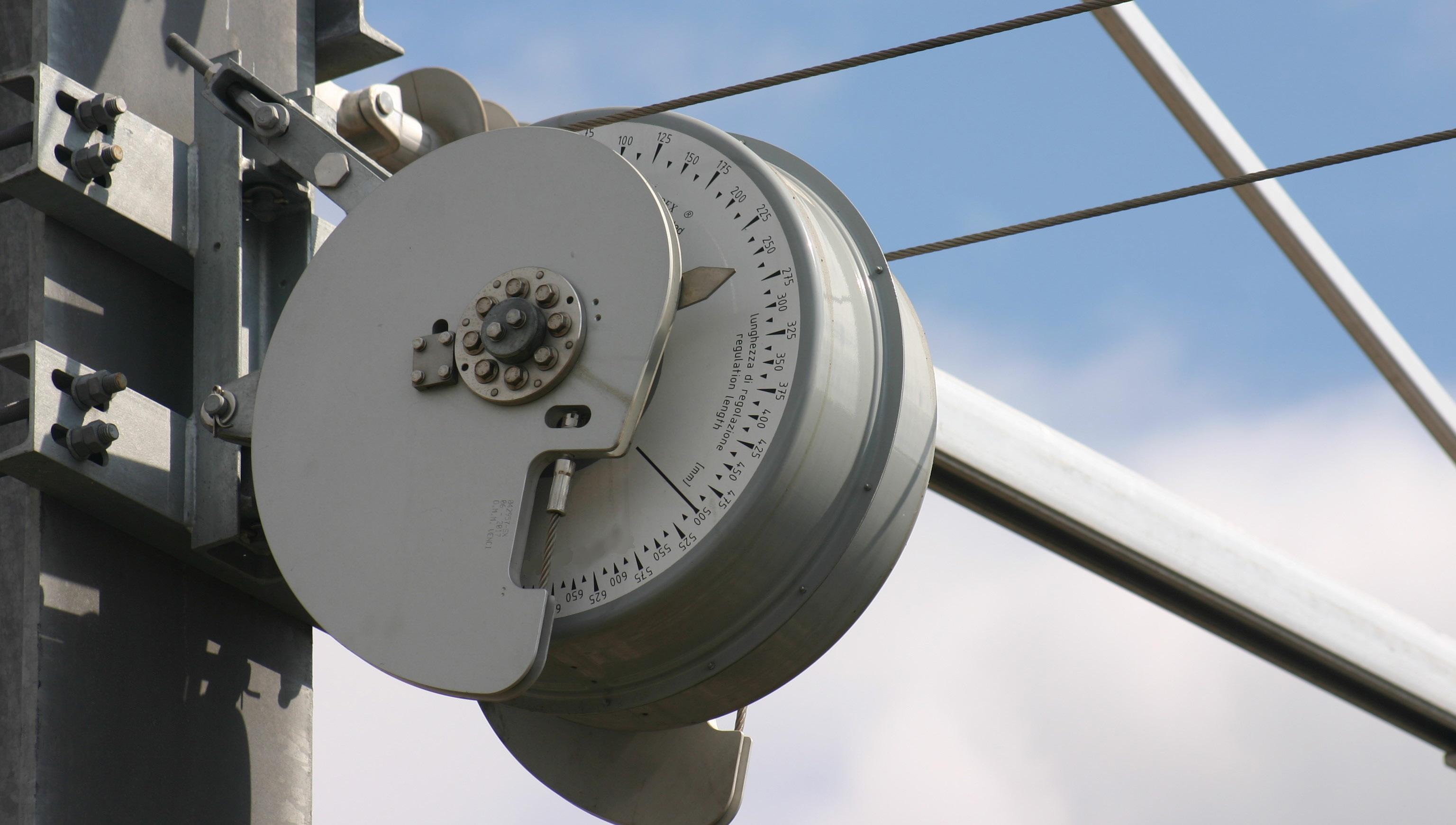
to operate with even greater focus on engineering excellence and quality. Railway products, systems and solutions previously available from PFISTERER are now part of Mosdorfer Rail portfolio and brand. However, the Mosdorfer Rail business has also been significantly strengthened by the synergies, manufacturing and engineering capability already held within Knill Gruppe. This, coupled with a business ethos centred around engineering excellence and quality, has resulted in a perfect fit!
For Mosdorfer Rail, the flagship product of the ‘Tensorex C+’ spring automatic tensioning device continues to grow from strength to strength. Produced in Sheffield, localised engineering and technical support is available to the UK market, and a new certified training course is available with Level 2 qualification. An inspection and repair service is also available, and handling and storage training and solutions can also be offered. To date, more than 35,000 units have been supplied worldwide since the original development of the C+ product and the business has some interesting developments soon to be launched into the market. Mosdorfer Rail is launching some significant enhancements to its tensioning range with a Tensorex spring automatic tensioning device with up to 25 percent more compensation capability. This will have significant benefits for areas with long tension length distances, and/or for markets with extremely high temperature deltas.
However, it is important to explain that Mosdorfer Rail does not only manufacture and supply Tensorex C+. As a long established international railway
systems solutions provider it has supplied over 10,000 kilometres of railway catenary systems to many clients and projects constructed all over the world. A complete range of cantilever assemblies, catenary clamps and fittings are available within the standard Mosdorfer Rail product portfolio. In 2023, Mosdorfer Rail saw the award and delivery of some prestigious global projects to which we have been proud to support and supply our products and solutions. Such projects include Tren Maya in Mexico, Bandirma-BursaYenisehir-Osmaneli HST and Mersin-Adana-Gaziantep in Turkey as well as Tanzania Lot 5 in Africa. For these listed projects, Mosdorfer Rail will be supplying more than 100,000 cantilever sets and 200,000 railway composite insulators, as well as other overhead line fittings, tensioning systems and safety equipment. All part of the Mosdorfer Rail portfolio. Looking to the future, Mosdorfer Rail has some very interesting product developments ongoing. Guided by the expertise of Product Portfolio Manager, Sean Corcoran, new developments and improvements in the range of railway composite insulators are the focus. Based in the Mosdorfer Rail facility in Sheffield, UK, Sean and his team of designers are supporting many global markets with their solutions, making Mosdorfer Rail one of the world’s leading suppliers of these products. In the world of railway electrification, Mosdorfer Rail has the expertise and portfolio to be a single-source supplier for railway catenary systems and solutions. www.mosdorfer.com
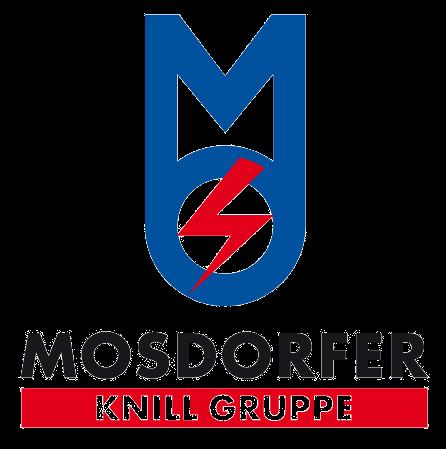

Making sure all people working on and near the tracks are safe is what drives us at ZÖLLNER.
Not only do we develop fail-safe solutions to make sure everyone can be warned of an approaching train, we also strive to make those solutions as flexible as possible in order to accommodate different needs and situations. Different track layouts might require different ways to activate the warning system and different kinds of works will call for a variety of warning devices. While safety is the most important factor, we do understand that it is important to our customers to have warning systems that allow for a safe working environment while at the same time delivering an economical solution for each project.
For recurring works such as maintenance or patrolling we have therefore developed permanent warning systems. This means that the train detectors are permanently installed. The associated junction boxes and transmitters are also permanently installed in a track side cabinet. The train detectors are always
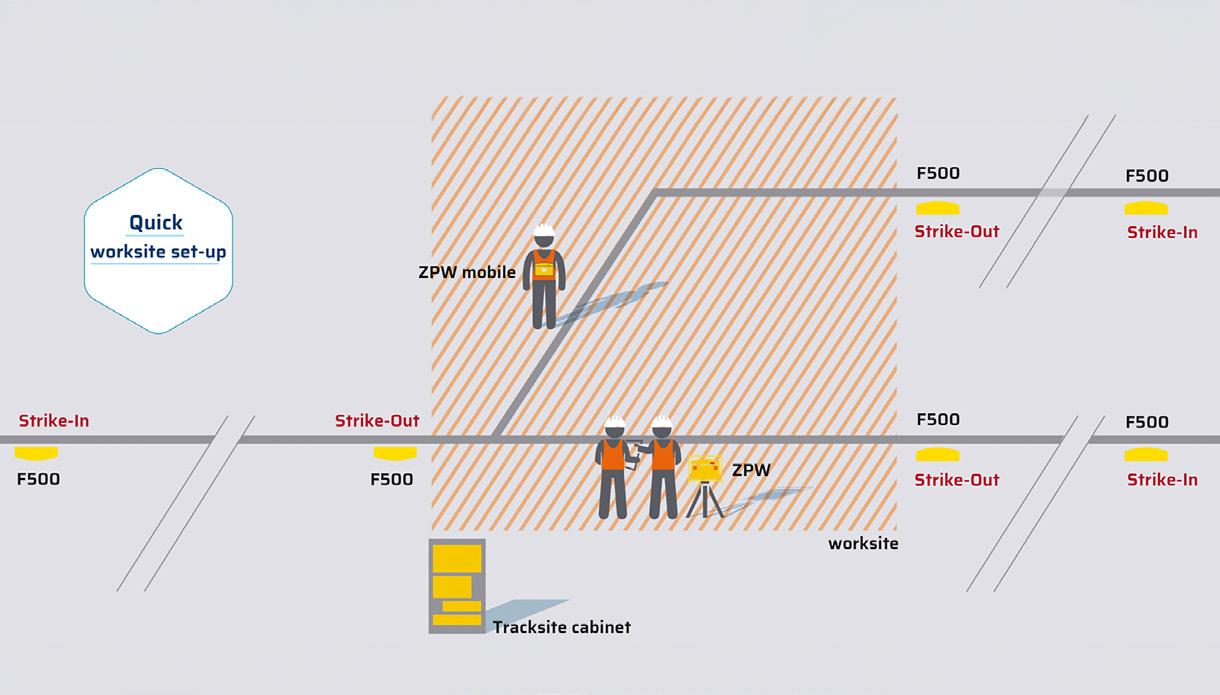
operational and thus monitored. As a result, there is no need to carry out planning and to enter the danger zone for the installation of a full warning system which saves staff and time, making this solution an economically viable option for areas which require regular track access. When the warning system is needed, the team simply brings along the warning devices and links them to the permanently operational system. Since different warning devices can be logged into the existing configuration, the system can be perfectly tailored for the type of work, team size, etc. This permanent installation therefore also offers the flexibility guaranteed by ZÖLLNER’s modular design.
Permanent installations of automatic track warning systems (ATWS) use train counting systems to activate and cancel warnings for the workforce. When the wheel sensor F500 detects a train movement, the information is transmitted via the radio transmitter ZFS to the control unit which then counts one train into the system. The control unit activates a warning which is delivered via all connected warning devices.
Semi-automatic variants (SATWS) are widely in use for junctions. In this variant the warning is cancelled manually by the operator. Alternatively, the warning can be cancelled via a wheel sensor that serves as a strikeout point making the system fully automatic.
For complex junctions or sites that include sections where trains might stop, reverse, split or merge, a system using axle counters is a powerful solution. The ZÖLLNER system counts axles moving in both directions
and only cancels a warning when the number of axles counted in and out is zero and the section is therefore guaranteed to be safe.
Due to the complexity of reversing, splitting or merging trains within a worksite, Network Rail has issued new requirements for permanent automatic warning systems (ATWS) in the UK, prompting the development of the ZÖLLNER system using axle counters. Our solution is suitable for both upgrading existing SATWS installations and for completely new installations. Existing SATWS installations can be upgraded easily as a lot of components including the cabinet can be reused for the axle-counting fully automatic ATWS.
Beneficially, our solution can be used for both retrofit and completely new installations. Should you already have one of ZÖLLNER’s safety solutions installed, we can simply modify the set up with minimal disturbance. Our design team can configure your specific site and install our axle counting solution into the cabinet, utilising existing equipment merged with new. As users are already familiar with ZÖLLNER equipment this reduces any disruption and major change to the working environment. Alternatively, we can design and plan new installations, with thorough training and support to ensure you fully understand the system and added benefits for your team.


“We design your safety solutions.” – A slogan we do not take lightly. At ZÖLLNER, our vision is not only to contribute to safety in rail transport worldwide but to ensure that every single person working on and around the track goes home safely. That is why we are proud to be the leading international provider and partner for solutions to improve safety for people in a complex, digitalised and globalised world.
We have been developing and producing solutions for railway safety for over 30 years. From track warning systems to infrastructure solutions like train speed control, remote controlled ETCS balises and the fully automatic temporary level crossing A-CROSS – our expertise covers a large variety of situations regarding railway safety which allows us to still see the bigger picture while zooming in on the details.
Through international subsidiaries and partners (e.g. in Great Britain, Poland, Spain/Portugal, France, North America, Israel and Australia) there is always a local contact person. This enables us to offer tailored advice and solutions taking into account national guidelines and regulations.
Let’s get together and see how we can help keep you and your crew safe!
www.zoellner.de
Permantently installed warning devices on Forth Bridge, Scotland, enable the essential upkeep of the iconic structure
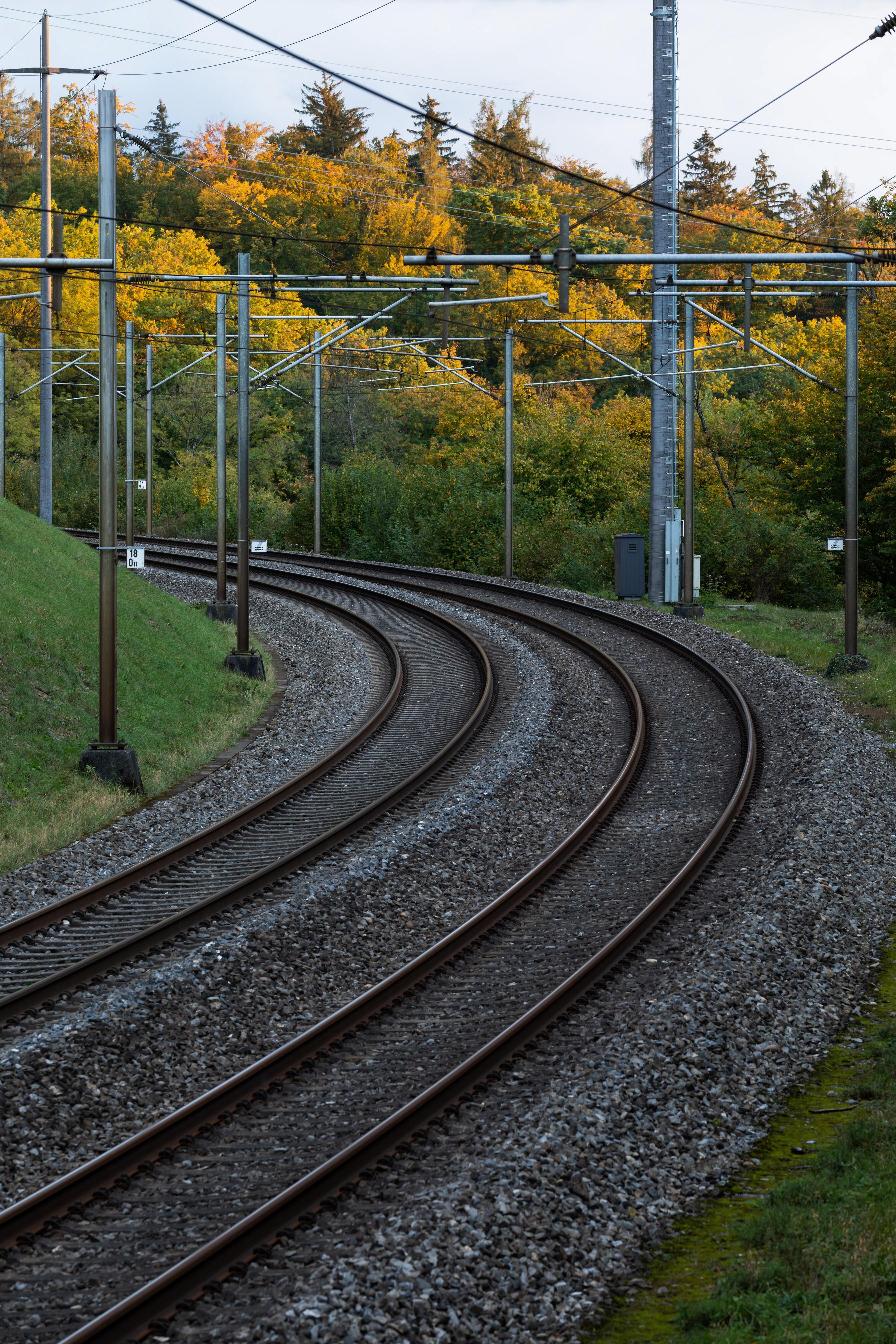
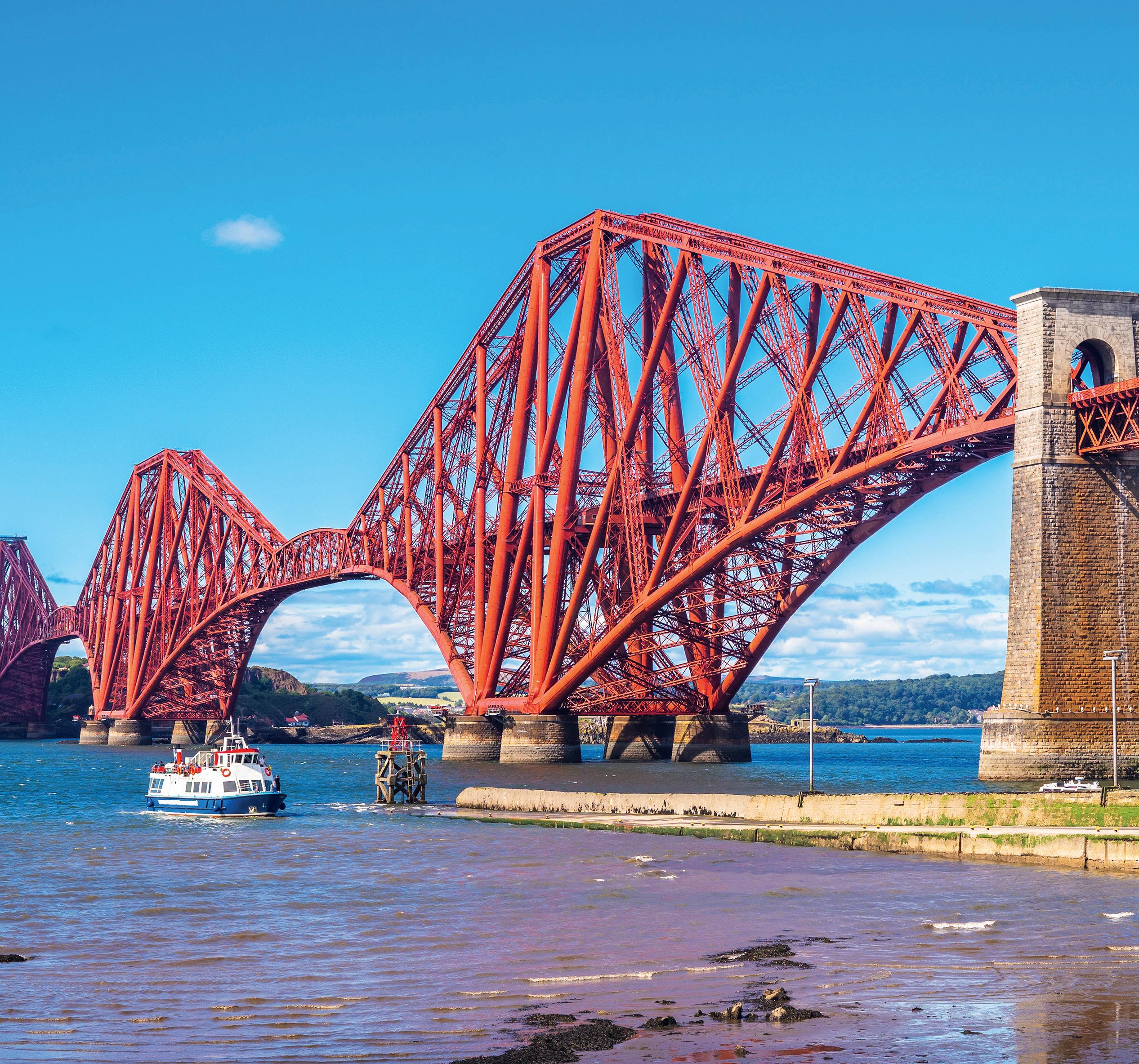



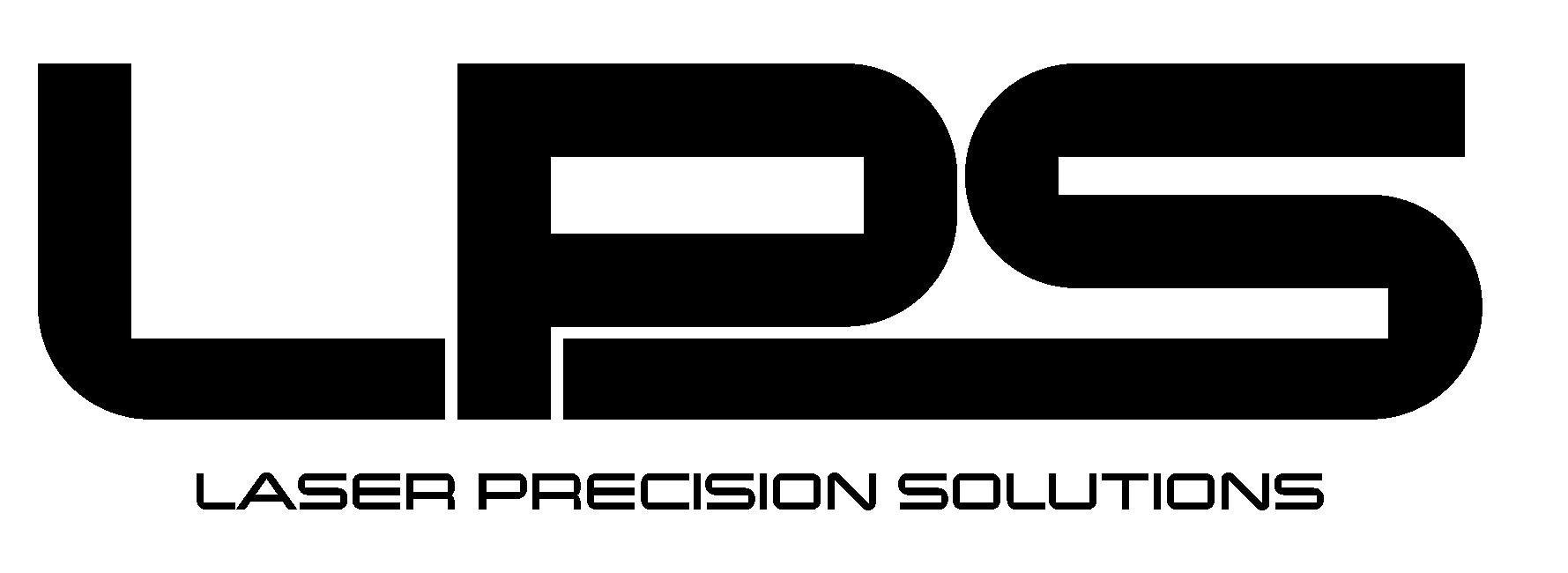
Designed with the latest laser technology, the LaserTrain Freight Model offers rail networks a non-abrasive, precise cleaning solution to stay ahead of Autumn challenges.
Slippage on the line throws a wrench into railway operations, affecting train services, impacting safety and creating lofty maintenance bills. By effectively removing stubborn contaminants from the rail, LaserTrain improves braking and stopping distances, reducing the risk of accidents and delays, and shrinking wheel-related maintenance costs.
Since 2018, LaserTrain has been reshaping railway maintenance, starting with the MTA Long Island Rail Road and spreading to top operators across New York and Boston. Recent results like a 66% drop in slip events, 70% fewer delays and 62% wheel value saved in maintenance, it’s helping to drive major improvements in rail safety and productivity.
The Freight Model LaserTrain provides an impressive operational capacity. Designed to handle up to 200,000

kilometres per year, it can significantly reduce the frequency of maintenance interventions and ensure railheads remain clean and safe. LaserTrain’s precise laser cleaning maintains optimal traction, minimises the risk of wheel flat spots and supports more reliable rail operations and lower maintenance costs.
One of the standout features of the LaserTrain Freight Model is its plug-and-play design. Engineered to fit seamlessly with Y25 bogie or R141 trucks without requiring modifications, this model guarantees compatibility with UK, EU and US loading gauges.
This pre-set design slashes engineering, build and test time, ensuring regulatory compliance from the outset and allowing for rapid deployment. Streamlined integration translates to shorter lead times and higher uptimes, enabling rail operators to maximise their operational efficiency. Standardised spare parts management cuts the risk of long maintenance downtimes.
The Freight Model is pulled by locomotives and is capable of operating with or without a separate generator. Designed for optimal performance at various speeds up to 60mph, LaserTrain ensures that cleaning operations do not significantly disrupt regular train services. High-speed capabilities allow for railhead cleaning during normal operational hours, minimising the need for dedicated maintenance windows further enhancing the efficiency of rail operations.
By removing contaminants without damaging the rails, LaserTrain improves the coefficient of friction (COF) on the railheads. This enhancement in COF levels leads to better traction, which is crucial for effective acceleration and braking, thereby reducing the risks associated with slip-slide conditions.
In addition to improving safety, the enhanced traction provided by LaserTrain also contributes to better punctuality. Trains can maintain their schedules more reliably, reducing delays and cancellations, and improving overall passenger satisfaction.
LaserTrain’s initial investment is offset by significantly lower running costs than traditional methods. With most costs fixed up front, the total cost per mile decreases as more miles are cleaned, maximising cost efficiency. Its comparable cleaning performance with far fewer units results in a substantial reduction in operating costs over time.
LPS offers a tiered system of service and support so rail networks can decide whether they need basic maintenance or a comprehensive support package.
• Autonomous control system: Automated controls ensure consistent cleaning without the need for trackside workers. Geographic Information System (GIS) data allows the system to avoid obstacles, while integrated laser shut-off prevents overcleaning.
• Precise cleaning: One laser pass removes contaminants without causing surface damage and boosts coefficient of friction (COF) for 24 hours.
• Remote monitoring: Keep an eye on the LaserTrain during shifts and use the Customer Dashboard to access performance data such as the train's live position and miles cleaned.
• Customisable cleaning speeds: Choose from maximum cleaning speeds of 20mph, 40mph and 60mph.
• Sustainable solution: High-powered lasers deliver robust performance with low energy consumption. Laser cleaning generates minimal waste and does not involve any by-products, chemicals or abrasive materials making it an environmentally responsible option.
The LaserTrain Freight Model sets a new standard in rail maintenance with its adaptable and efficient design. Offering reliable performance and flexible options, it’s the perfect choice for rail networks looking to improve safety, increase efficiency and reduce costs.
Get in touch!
Click here to contact LPS or email info@lasertribology.com to speak to one of the team.




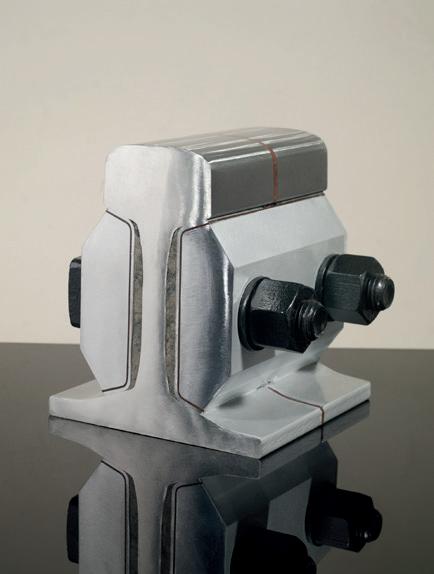

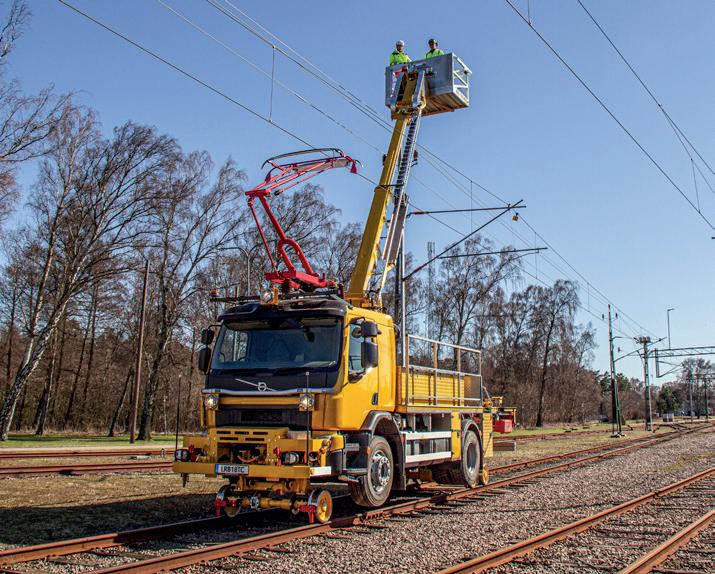
Together with you, Goldschmidt develops smart and reliable solutions – for safe, sustainable and long-lasting railways of premium quality.
Goldschmidt offers you a comprehensive range of high-quality and reliable products and services worldwide for the construction, maintenance and monitoring of your railway infrastructure. With our products and services, combined with our smart digital solutions, we are pushing for the digital future of track. We are always at your side – wherever you are. With our global presence, your Goldschmidt products and services are available locally, as is the support of your local contact.


The VLDM enables permanent monitoring of VLD 50526-02 class 1, 2, 2.2 without auxiliary voltage and informs the operator via SMS or email about switching operations or defects in the VLD.
Application: With both VLDM variants, the VLD type to be monitored (class 1, 2.1, 2.2) is set by parameterisation. The voltage or current applied is determined by means of sensors or direct connections to the VLD to be monitored. The permanent intelligent evaluation recognises whether the VLD has switched or ‘blown’.
This event is sent directly via the set signalling channel. It is also possible to configure a routine message to send a ‘life’ signal cyclically (e.g. once a month) including system and operating status.
• Continuous monitoring of the EN 50526-3 VLD-F systems (voltage breakdown fuses (SDS) or hybrid voltage limiters (HVL))
• Detection of activities and breakdowns
• Adjustable threshold values
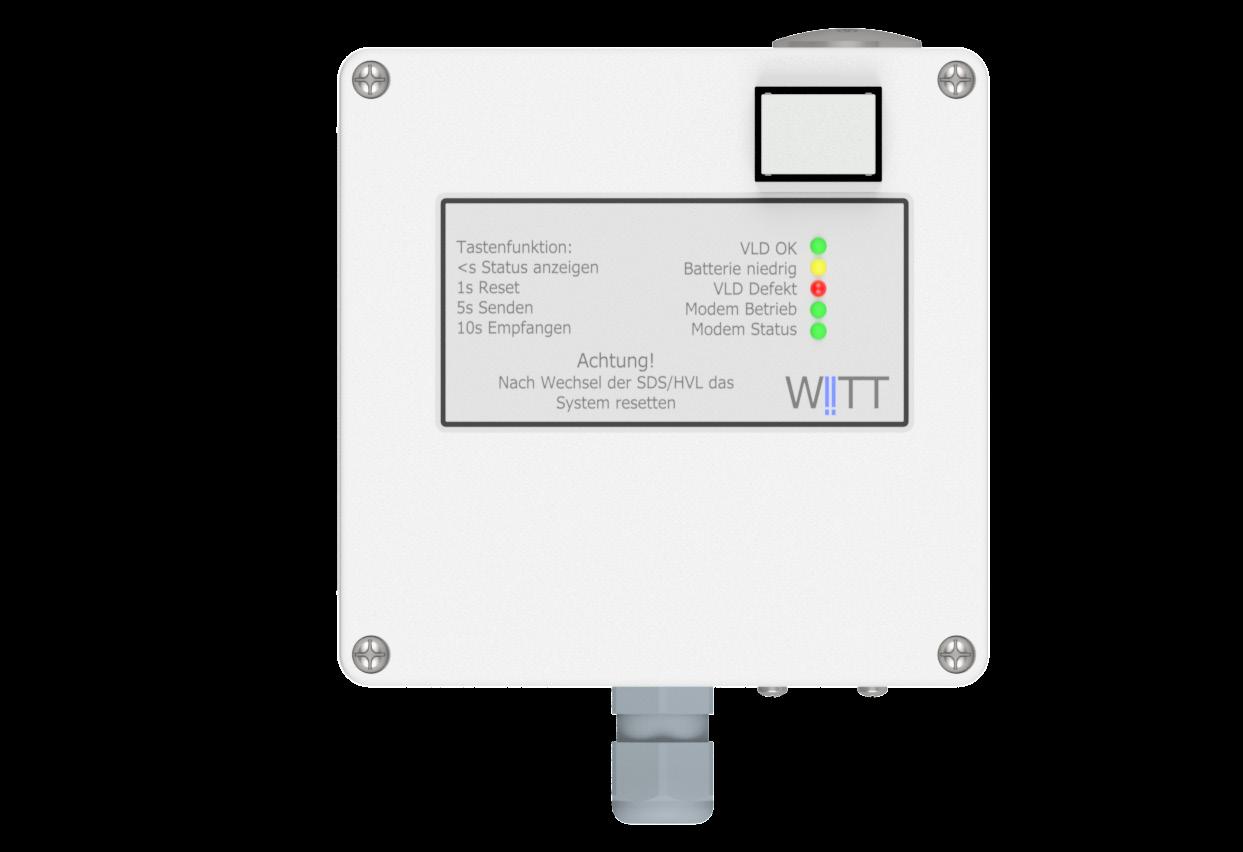
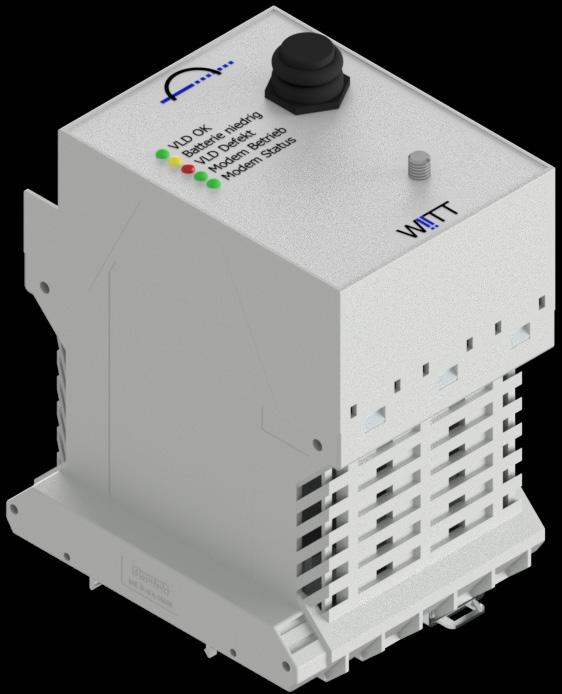
• If an event occurs, a message is sent
• Can be operated with a battery for approx. 3 years or with auxiliary voltage
• Can send messages by email or SMS
• Can use all common mobile radio frequencies
WITT offers the following variants:
• VLDM, as a stand-alone solution and IP 68
• WB-VLDM, the VLDM in a top-hat rail housing with a wide range of options and expansion possibilities
• VLDM system, the complete system consisting of a VLDM or WB-VLDM for battery operation, sensor, cable bushing and antenna
Ask us about customer and application-specific system solutions here!
WITT Solutions GmbH
www.witt-solutions.de sales@witt-solutions.de +49 (0) 33234/243-300
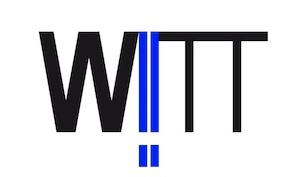

Automated Rail Exchange Systems Increase Quality and Efficiency when Replacing Long Rails
Rail loading trains (Pic 1) have been used successfully by infrastructure operators worldwide for decades.
They enable the transport of long rails directly from the factory or rail store to the construction site, including delivering the rails directly on the track, as well as the collection of old rails for further use or recycling.
Now Robel introduces new loading processes, focusing on the automation of key functions. This minimises the need for personnel while maximising transport performance, thereby increasing efficiency and occupational safety at the same time.
The ROREXS rail exchange system (Pic 2) is a combination of several wagons with modular superstructures whose core components – transport unit, manipulator and loading unit – feature a new level of automation.
• The transport unit consists of special superstructure modules with with 40-foot or 60foot container frames, which are twist-locked to standardised carrier wagons. ROBEL provides the actual working modules, while the carrier trolleys are provided by suppliers or are already available from the customer.
• The manipulator enables the rails to be loaded at the construction site, i.e. both the long rails to be delivered and the old rails to be picked up.
• The complete newly developed, remote-controlled

loading unit enables particularly gentle rail storage at the construction site and, thanks to its containerframe design with three modules, eliminates the need for special vehicles. Optionally, the system can also be designed for bidirectional operation.
Hydraulically operated row support frames are used for safe and secure storage of the long rails on the transport unit. Depending on the design, they can carry up to eight or ten rails next to each other and two to five layers on top of each other. These rails can be up to a total length of 330 metres. The rail is guided with great care during transit of curves, and the required

degrees of freedom in the longitudinal and transverse directions are guaranteed. A new feature is that the rows of supports can be rotated hydraulically. This allows access to lower layers for loading and unloading without any manual actions: the transport unit no longer needs to be accessed, a quantum leap for operator safety. The rotating process and locking are activated by radio remote control and monitored by sensors.
Rail clamping is also automated. All the usual clamping screw connections for fixing the rail are no longer required, which means that the crew no longer has to risk walking on the load or tighten the screws (Pic 3). Each clamp is only released immediately before unloading, each slot is monitored by sensors and can be individually selected on the remote control.
The rail manipulator is equipped with an independent
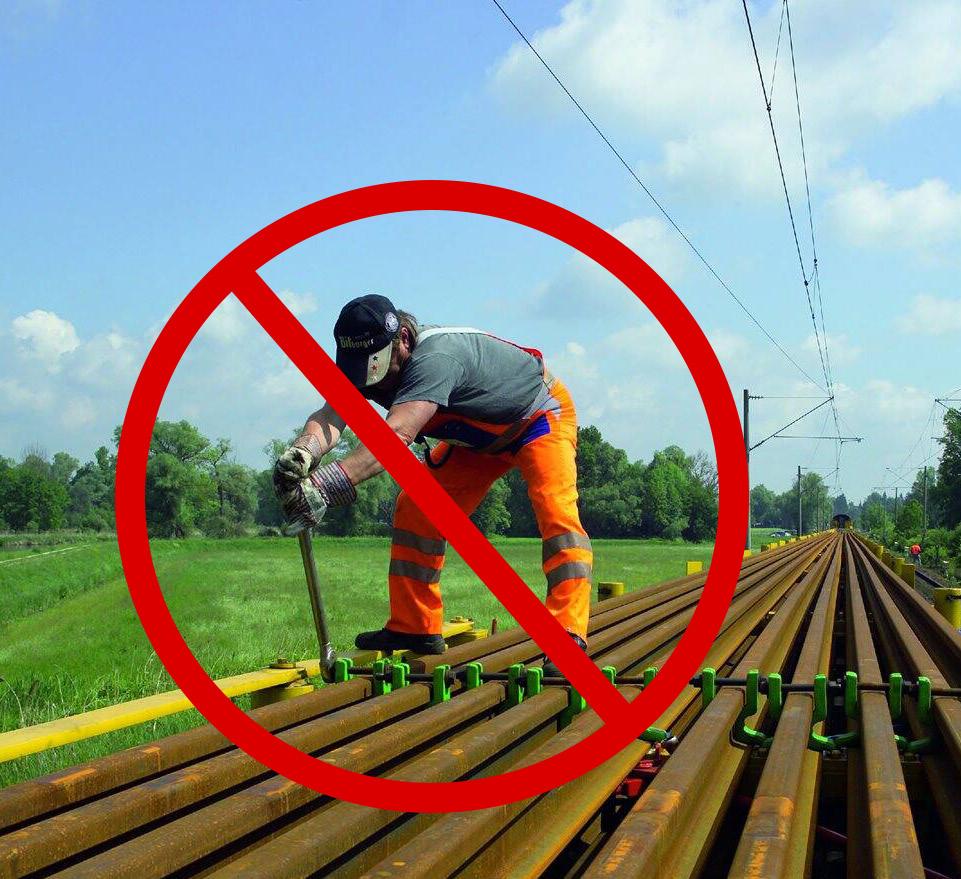
hydrostatic drive and moves on its own rails along the entire length of the train. Two hydraulic grippers at the end of freely movable arms guide the rails during the loading and unloading process. Cameras monitor the rear loading area – the operator thus controls all work processes from the cab.
The new ROREXS design does away with the usual chute wagon sets. Their task is taken over by modular frames with special superstructures on carrier wagons; a flexibly extendable loading satellite at the end of the rack replaces the inclined guide channels. (pic 2) The basic structure, mounted on three long carrier wagons, also results in a flatter inclination that ensures lower stresses on the rails. All hydraulic functions can be controlled by radio remote control. Manual intervention is not required at any point, which is why one operator is sufficient for all operations.
Compared to all previously long rail transport units, ROREXS only requires a minimum of three people to unload or pick up rail pairs at the construction site. Two operators each control the movements of a rail clamp on the manipulator and the functionality of the transport unit, while a third operator at the head of the unit on the track controls unloading and loading via the chute unit. The operator in the manipulator is responsible for the remote control of the row support blocks and clamps. The ROREXS can operate under live overhead lines, as nobody moves on the unit unprotected, i.e. outside the manipulator's cab. Unlike in the past (Pic 3), there is no longer anyone on the loading units or next to the rail loader, which is a big plus for work safety on the track.
Click here to see ROREXS in operation.
www.robel.com/en





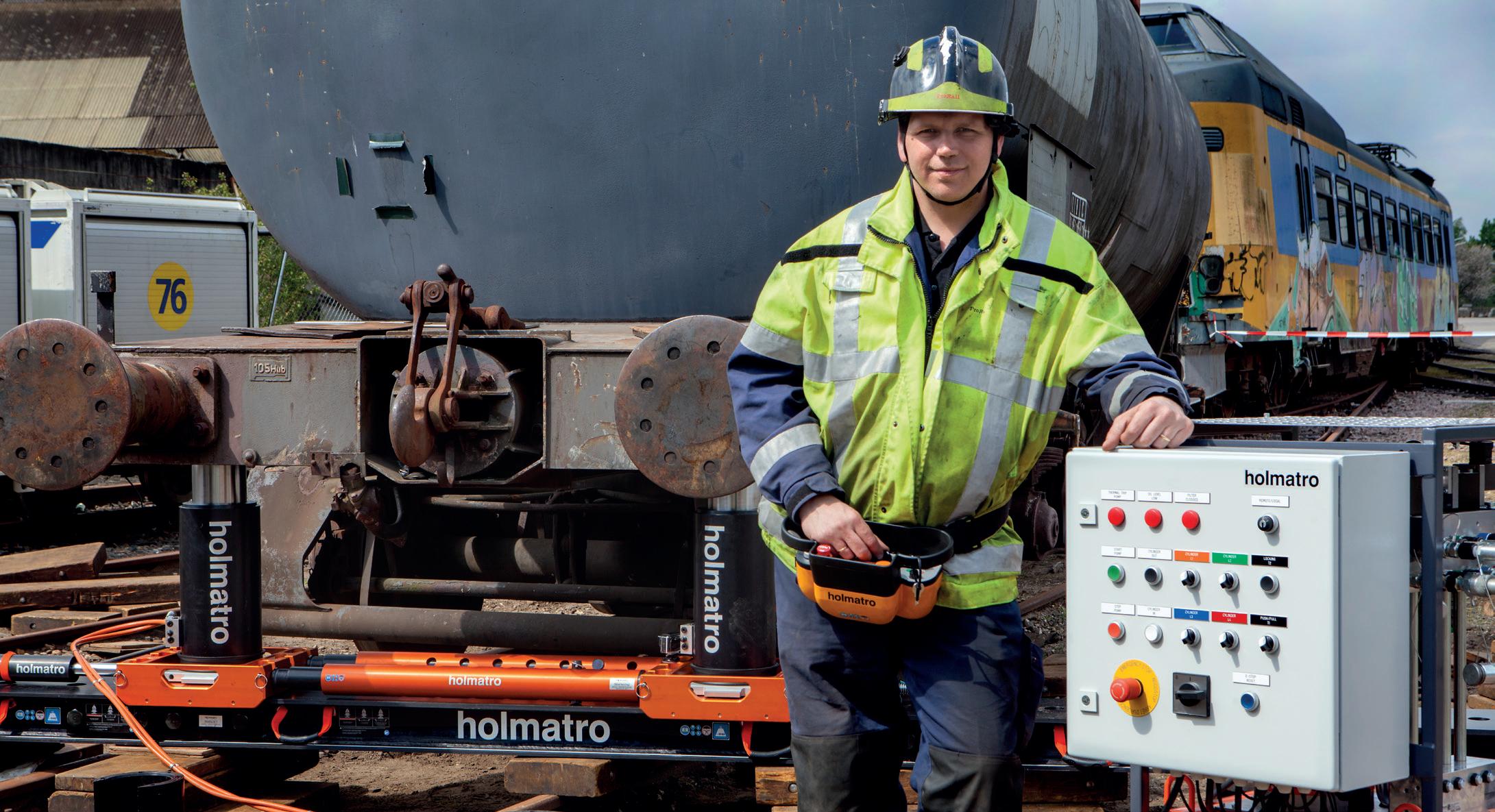
We are worth over 55+ years of experience in designing, developing & producing high-pressure hydraulic tools & systems for both the industrial and rescue market. With this experience, we challenge ourselves every day to deliver safe, reliable, durable and innovative solutions to our customers.
“We help make the world move forward”
When developing a system with these parameters, you want to make sure you understand your customer needs. So we teamed up with ProRail, the leading Dutch rail infrastructure manager, which is responsible for recovery of all derailed trains within the Netherlands.
Johan Knuivers, ProRail: “The result of our close
collaboration was astounding.We have 3 sets of Holmatro rerailing systems in use and together they are deployed 50–60 times per year.Due to the lower weight,safety features and ergonomics of the components,the system enables us to work faster and safer. This has resulted in the fact that we could do our job in 2 hours less per deployment.This time reduction and more ergonomic and safer deployment has also led to less absenteeism of our employees.”
Holmatro Telescopic Rerailing Cylinders can reach long lifting distances while maintaining a compact closed height. Holmatro operates with a maximum working pressure of 550 bar, allowing us to design compact, and lighter cylinders that maintain the same capacity. The cylinders are constructed entirely of anodized aluminium, making them significantly lighter and easier to carry around.
A key feature of OUR cylinder is the load-lowering valve, ensuring the vehicle/load can be lowered in a controlled manner without being affected by the weight of the load. Additionally, these telescopic cylinders are equipped with a hose rupture security mechanism, which ensures that the system halts immediately if a hose breaks, for any reason.
The stacking rings are used for mechanical locking of the vehicle, allowing operators to work safely underneath an elevated load.
Installation of the stacking rings is done using a fork, maintaining a safe distance from the vehicle during the process.
The rerailing beam or bridge is essential for every rerailing system.
Holmatro chooses to manufacture the beams entirely from black anodized aluminium, significantly reducing weight and optimising operational processes in the field. Furthermore, extrusion as a production method prevents warping of the metal during welding.
Using the connecting set, you can easily connect different lengths of beams to each other without the use of special or additional tools.
Traverse sleds, also known as carriages, facilitate the side movement required for rerailing the derailed vehicle and are used underneath the lifting point. Holmatro traverse sleds are equipped with a Teflon-like sliding bearing underneath, ensuring smooth sliding and reducing the risk of beam damage. Advantages of this material include reduced maintenance, lower friction and weight reduction, making the sleds easy to manage and carry.
Inside the sled, there is an additional internal sled with the same sliding bearings underneath. This internal sled compensates for the radius made by the railway vehicle when putting it back on track. It also includes an indicator, visually signalling the end of the stroke when using the internal sled. This feature alerts the operator
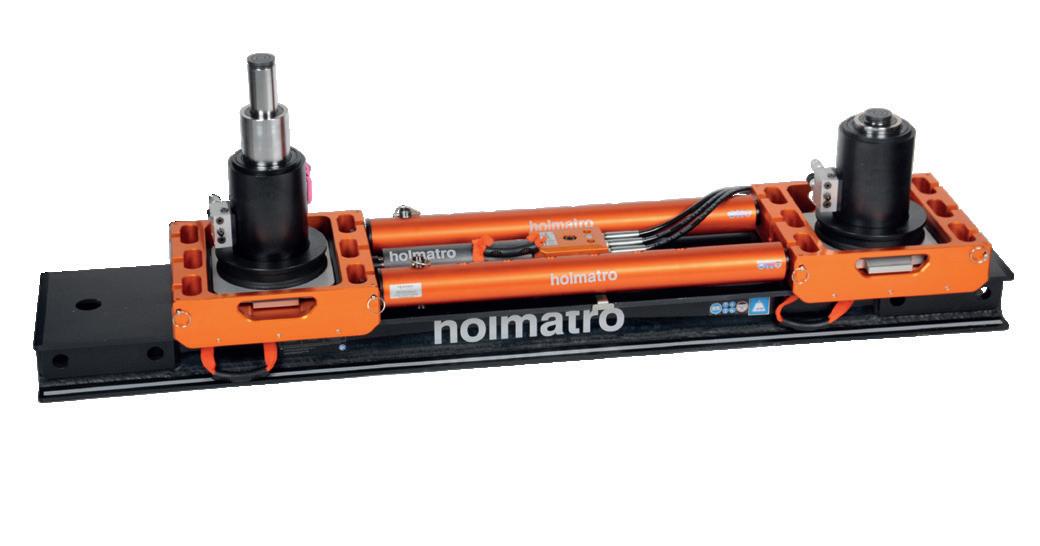
to the traverse limits, preventing instability of the railway vehicle and the equipment.
Since the traverse sleds have sliding bearings, decreasing friction, you can work with a lower capacity traverse cylinder, resulting in a lighter cylinder. With the Holmatro system, only a 12-ton traverse cylinder is required.
The mechanical locking device prevents your load from shifting, which comes in extra handy while working in a sloped position. This feature enables you to work safely and controlled in all circumstances.
The traverse struts, distance bars, are used to maintain a consistent distance between the two traversing sleds, ensuring safety & control during operations.
The Holmatro traversing struts come in different lengths to accommodate different applications and needs. Final adjustment can be done by simply removing a pin. For precise final adjustments, the operator can utilise the threaded section on the bar.
Additionally, the struts are made from aluminium, ensuring they are lightweight and easy to handle.
The traverse cylinder is used for lateral movement of the load. Our double-acting traversing cylinder carries an equal capacity for both pushing and pulling; enabling you to both push and pull the vehicle into position, usable in any position & either direction. Thanks to the sliding bearings with reduced friction underneath the Holmatro traversing sled, less force is needed, resulting in a traversing cylinder requiring only 12 tons, where other available systems require at least 17 tons.
Another unique feature of the traversing cylinder is the unlocking cylinder, which can be remotely unlocked when moving to the next stroke. This eliminates the need for an operator to go underneath a lifted load to reposition the cylinder, allowing all operations to be conducted safely and controlled from a distance.
When working in demanding circumstances and time is of the essence, you want to ensure a safe work environment above all. Recognising that the pump is the heart of your rerailing operation, it is developed and designed with safety as a top priority.
This smart powerpack solution combines the functions of a pump unit and a control table into one integrated system.
All your cylinders are powered by a robust Quattro pump, which delivers four equal flows to four independently wirelessly operated control valves. When these control valves are activated simultaneously, they ensure uniform cylinder stroke speeds during both lifting and lowering, regardless of the load. Additionally, the valves can be controlled individually to operate each cylinder separately. The pressure on each cylinder is easily monitored via user-friendly pressure gauges.
The fact that the pump is wirelessly controlled eliminates the need to bring a heavy pump unit into the field, reducing noise disturbance during the operation and your operator can maintain a safe distance from the vehicle during the rerailing operation.
The Holmatro Compact Rerailing Unit (CRU) combines our smart engineering & technology from our Rerailing systems in a compact solution ideal for smaller & lighter rail vehicles like trams and (depending on your application and needs) metros. A system with maximum performance at a minimum weight.
• Compact, lightweight and user-friendly: weight ready for use only 54kg, divisible into parts of <40kg
• Easy transportation towards the accident
• Easy to install due to its compact dimensions
• Equal, split flow pump unit available
• Remote controlled valves give you an excellent overview of the situation
• Core hose technology: press and return oil in one single hose, including patented core couplers, enabling you to switch between control valves while the pump is running.
Holmatro high-pressure hydraulic hoses for rerailing systems are available in different colours: matching colours on the outlets of either your remote-controlled pump unit or the control table & pump unit reduces the possibility of incorrect assembly and thus faulty operations.
The entire system is fitted with different types of couplers for the lifting and traversing parts, to avoid false connections.
We are proud that after all this time we are still a ‘MADE in the Netherlands’ company with inhouse research & development, engineering and production. Holmatro tools are developed, manufactured and maintained in conformity with the highest quality standards of durability, side load, mechanical distortion and overpressure.
Since the introduction of the Holmatro rerailing system we have built a proven track-record supplying to worldly known key players in the market including e.g. Irish Rail, Japanese Rail, MTR Hong Kong, Istanbul Metro, CAF, Dalian Tiefeng, SAR, RFI and many more.
We take tremendous pride in the feedback we receive from operators, confirming that our primary goals in developing these systems are effectively met while using the system.
Curious to learn more about what our systems can offer your operations?
Visit us during Innotrans Hall 23 | Stand 630 or go to holmatro.com for more information.



Harsco Rail, a global leader in rail maintenance and construction, is proud to announce our participation as an exhibitor at InnoTrans 2024, the premier international trade fair for transport technology.
Taking place from 24–27 September in Berlin, Germany, InnoTrans is the ultimate platform to showcase our latest advancements in rail treatment, surfacing, specialty machinery and technology solutions. We invite you to visit us at Hall 26 / Booth 340 to
experience our innovative offerings designed to enhance rail operations worldwide.
At InnoTrans 2024, Harsco Rail will present a curated selection of our most advanced products, providing attendees with an in-depth understanding of how our solutions can transform rail maintenance and operations.
Transit Switch Grinder: The Transit Switch Grinder is designed for precision grinding of curves, straightlines, switches and crossings. This machine ensures the removal of surface defects, extending the lifespan of critical track components and maintaining optimal track conditions. It’s offered as a module design of 10, 20 or 30 stone configurations.
Hercules Grinder: The Hercules Grinder offers robust grinding capabilities for heavy-duty rail applications. It effectively removes irregularities and restores the rail
TX16 Tamper: Increased productivity from start up to shut down – TX16 speeds up every aspect of the work day, safely. Cab deployable/stowable reference, integrated high-speed measurement, automated tamping and hybrid index combine to significantly increase overall productivity. The TX16 leverages Harsco Rail’s multi-generational product, technology and service experience – safely delivering high production and accurate track correction within a reliable and versatile tamper.
Stoneblower: Our Stoneblower machine revolutionises track maintenance by injecting stone beneath the track to correct vertical track geometry. This innovative

At InnoTrans 2024, Harsco Rail will present a curated selection of our most advanced products, focusing on rail treatment, surfacing, specialty solutions and technology, providing attendees with an in-depth understanding of how our solutions can transform rail maintenance and operations
approach provides a longer-lasting solution compared to traditional tamping methods.
Utility Track Vehicle (UTV): The UTV is a versatile machine designed for a variety of rail maintenance tasks. With its multi-functional capabilities, the UTV can handle tasks ranging from track inspection to emergency repairs, making it an essential asset for rail operators.
Callisto Track Geometry Measurement System: The Callisto system offers state-of-the-art track geometry measurement, providing accurate and real-time data on track conditions. This system enables proactive maintenance, ensuring track safety and reliability.
P811 Track Renewal Train: The P811 is an all-in-one solution that revolutionises track renewal by combining old track removal and new track laying into a single, efficient process.
New Track Construction Machines: These machines ensure the highest standards in new track construction, from sleeper laying to rail positioning. Our technology ensures precise and efficient construction, leading to durable and reliable track infrastructure.
Aftermarket Services: Harsco Rail’s aftermarket capabilities ensure that our customers receive comprehensive support and maintenance for all our products. Our dedicated team offers parts, training, and service solutions to maximise the performance and lifespan of your equipment.
Contracted Services: Our contracted services provide turnkey solutions for rail maintenance projects. From on track machine operations such as Grinders and Stoneblowers to large-scale renewal projects, Harsco Rail delivers expert service with a focus on quality and efficiency.
IRIS – Intelligent Rail Infrastructure System: IRIS is Harsco Rail’s proprietary AI system designed to enhance rail maintenance through predictive analytics and real-time monitoring. IRIS leverages big data to predict maintenance needs, optimise resource allocation and improve overall operational efficiency.
We invite you to explore these innovations and more at our InnoTrans 2024 exhibit. Our expert team will be available to answer questions and discuss how Harsco Rail’s solutions can be tailored to meet your specific needs.
Harsco Rail’s participation in InnoTrans 2024 underscores our dedication to leading the rail industry through innovation and excellence. Our comprehensive portfolio of products and services is designed to address the evolving challenges of rail maintenance, ensuring safety, efficiency, and sustainability.
Don’t miss the opportunity to discover how Harsco Rail’s cutting-edge solutions can enhance your rail operations.
Visit us at in Hall 26 / Booth 340 at InnoTrans 2024, and let’s work together to shape the future of rail transport.
For more information visit our website www.harscorail.com or click here to contact one of our team.

Bender is one of the world’s leading providers of solutions that make electrical infrastructures smart and safer.
An approved Network Rail supplier, Bender UK has worked in the industry for over two decades to ensure maximum availability, prevent downtime, maintain uptime, and ensure operational efficiency.
Bender continuous insulation monitoring and earth fault location solutions measure system status and pinpoint the location of failure and degradation, and issue warnings and alarms to improve rail safety and services for staff and passengers.
Bender’s rail capability includes monitoring signal power, points heating, rail crossings, underground networks and rolling stock, supported by predictive maintenance and software solutions.

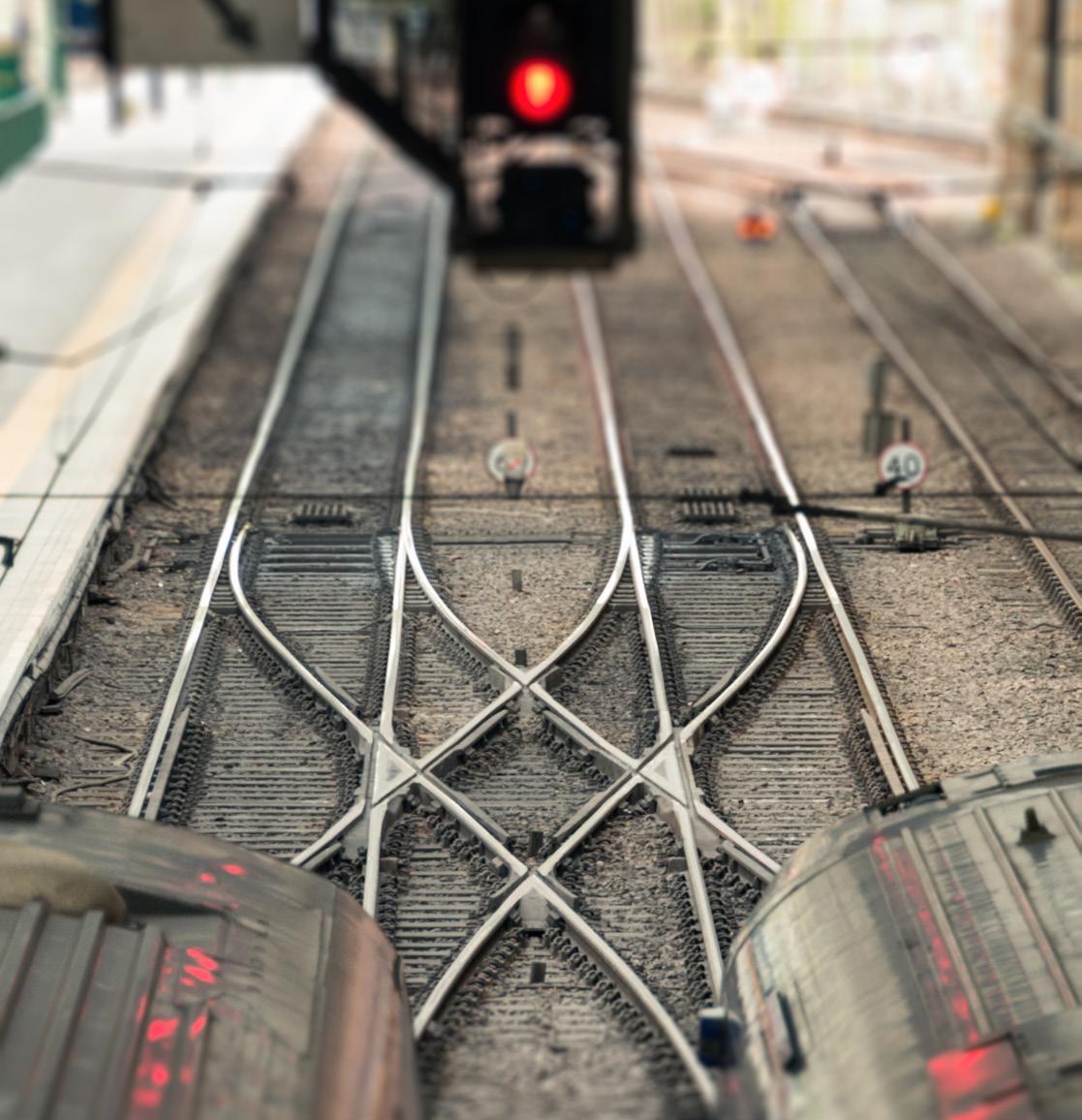
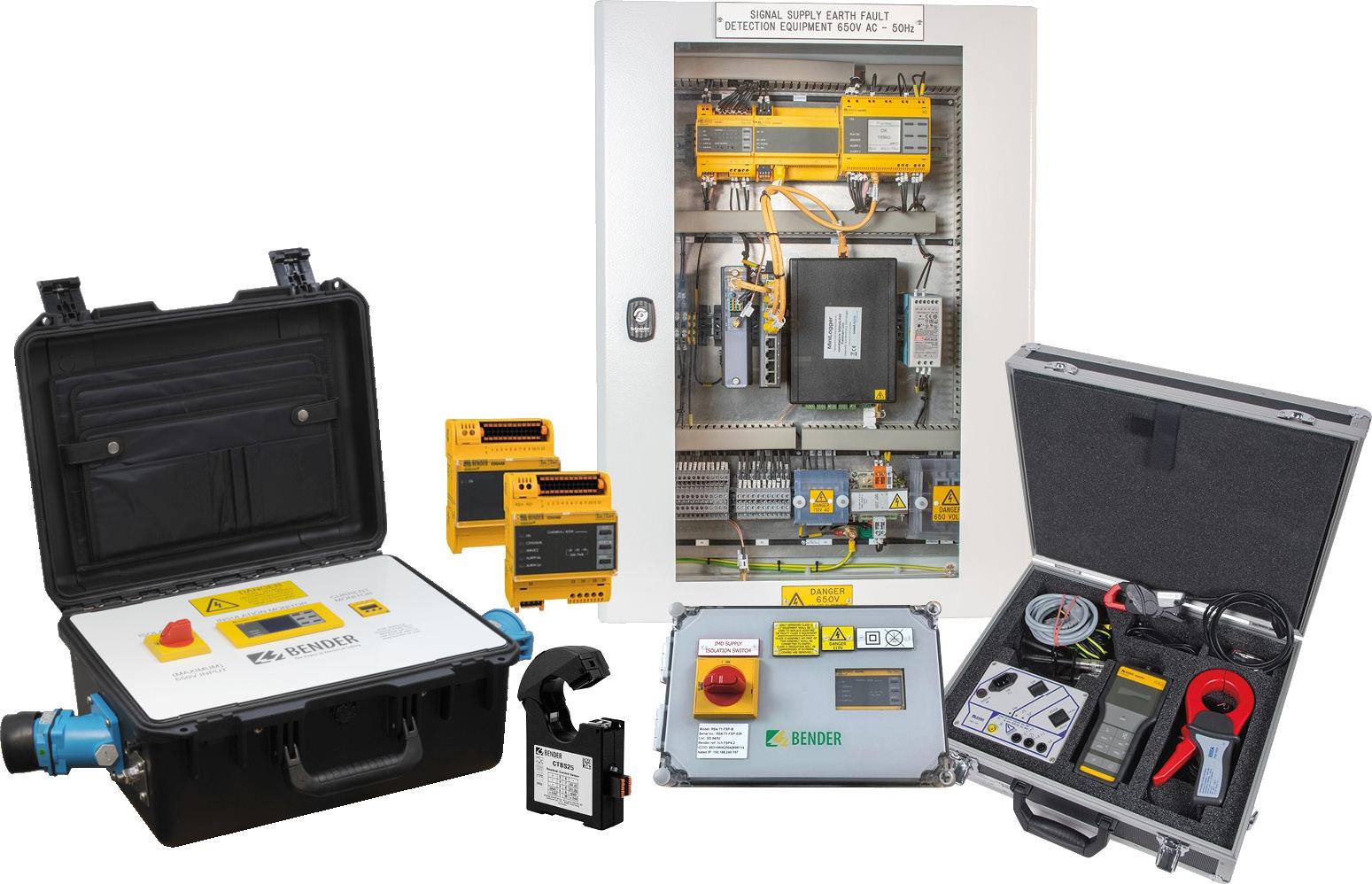

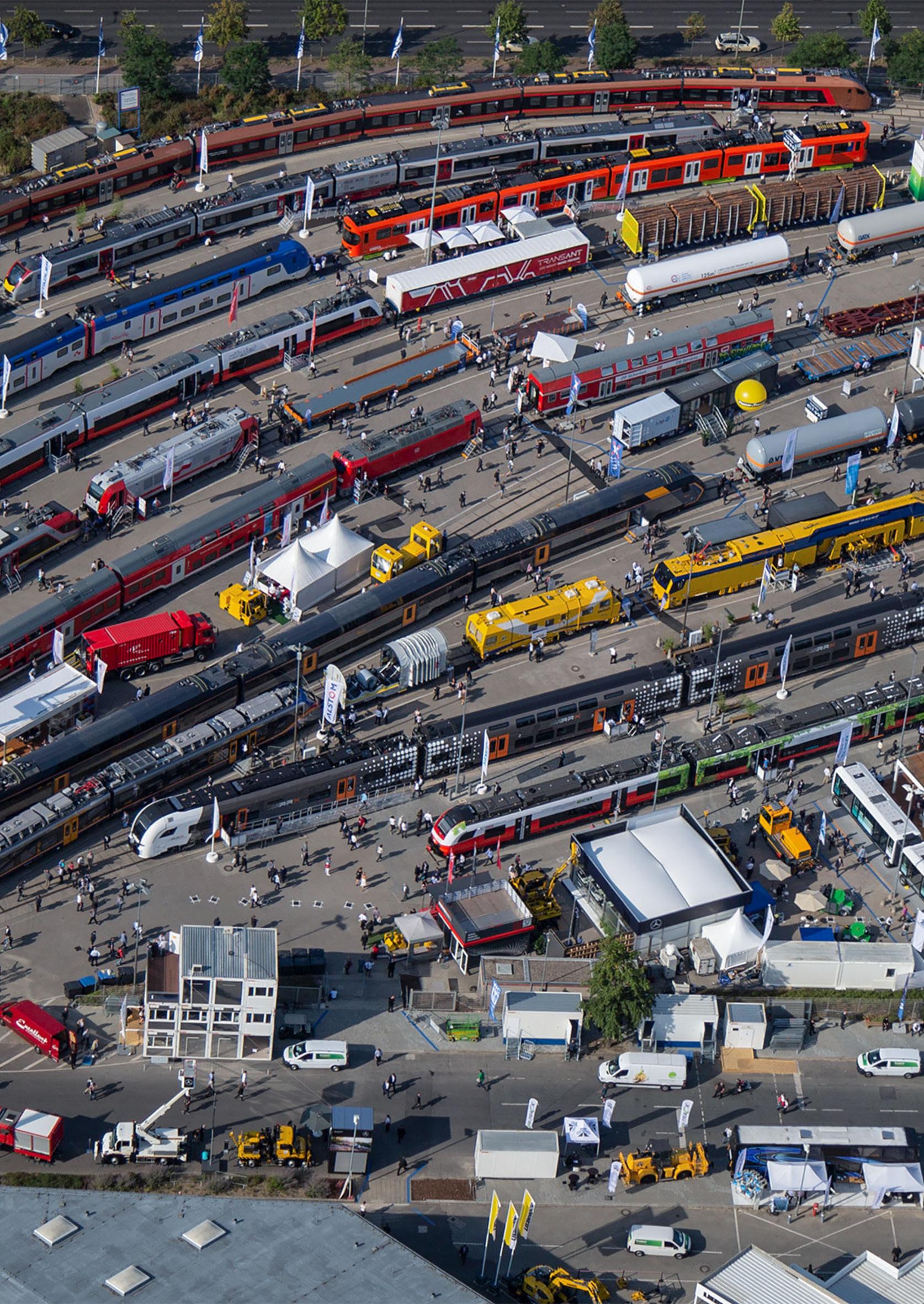
Interiors, incl. Travel Catering & Comfort Services
Hall 1.1
Franz Kiel GmbH
Testori Fabrics
Rex-Royal AG
Zoppas Industries Heating Element Technologies
Hall 3.1
MASATS S.A.
MöllerWerke GmbH
Polarteknik
Thermon Inc.
U-Lift AB
Hall 5.1
Diab Group
OWI GmbH
SAFE-T-PUNCH
SEKISUI KYDEX, LLC
Public Transport, incl. Mobility+
Hall 2.1
CN-Consult GmbH
Daktronics Ireland Co. Limited
ExPretio Technologies Inc.
Televic GSP
Hall 4.1
ADLINK Technology Inc.
Frequentis
Holmberg GmbH & Co. KG
Lantech Communications Europe GmbH
NEXCOM International Co., Ltd

Nokia Solutions and Networks Oy
Nomad Digital Limited
Tipro d. oo
Wavecom
Hall 6.1
ImpactSentinel by INGLAS GmbH & Co. KG
netwiss OG
Petrosoft.pl Technologie Informatyczne sp. z o.o.
TRIGO
VIAVI Solutions
Hall 7.1b
AUWEKO GmbH
Hall 7.1a - AI Mobility Lab
Dual Inventive B.V
Transmission Dynamics
Hall 7.1c - Mobility+
Mistral Data
CityCube, Hall A
Aon
Railway Technology
Hall 1.2
Columbus McKinnon Engineered Products
Dellner Glass Solutions Ltd
Hall 2.2
3A Composites Mobility AG
FirstClass Safety & Control
Hall 3.2
Alstom Škoda Group
Hall 4.2
Mechan Limited
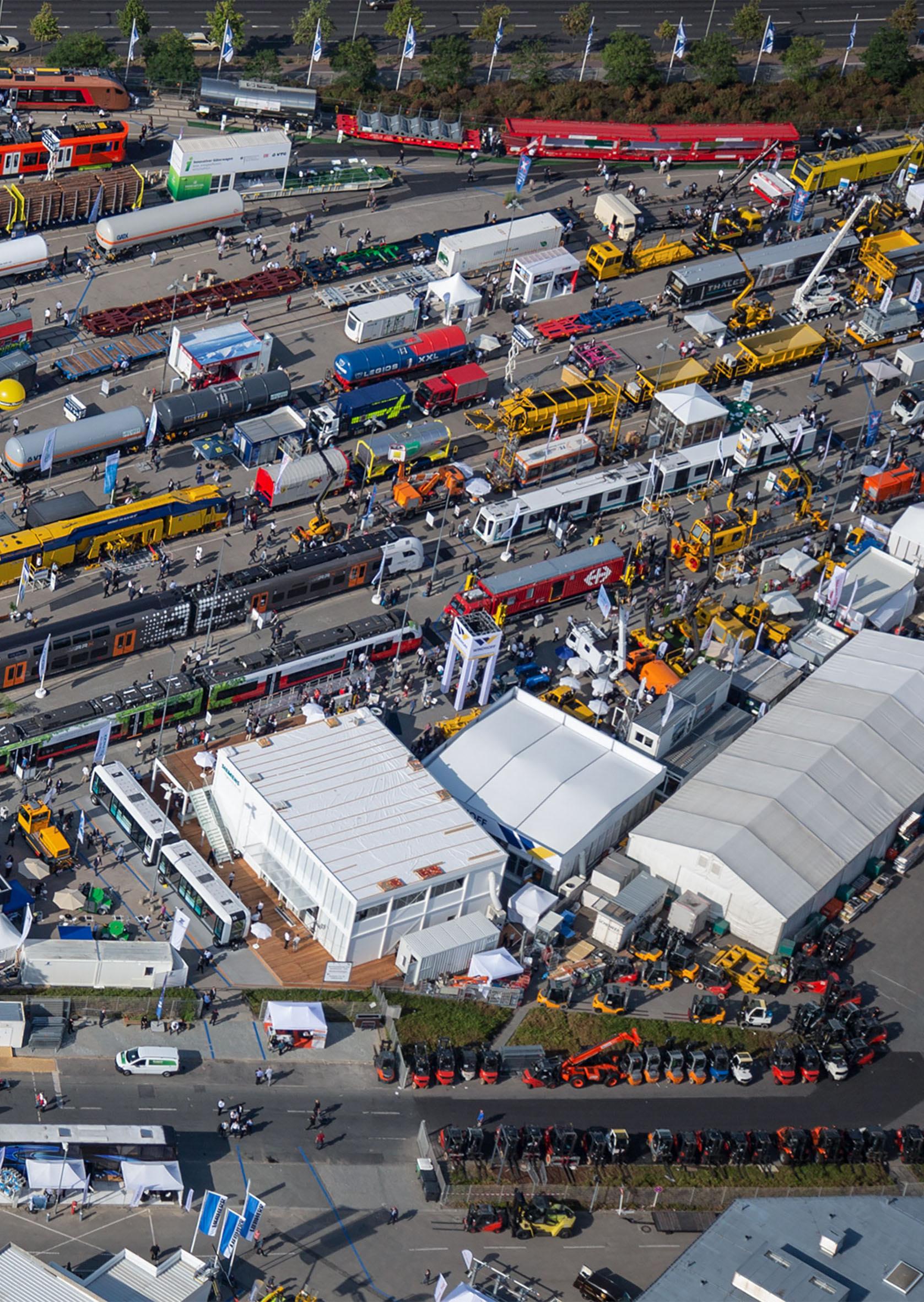
Hall 6.1
BvL Oberflächentechnik GmbH
Evident Europe GmbH
Finnblast Oy
VR FleetCare
Hall 7.2b
CE cideon engineering GmbH & Co. KG
Hall 7.2c
TÜV SÜD Rail GmbH
Hall 8.1
FreiLacke | Emil Frei GmbH & Co. KG
griwecolor GmbH
LA-CO Industries Europe SAS
Hall 8.2
J. LANFRANCO & Cie
Sika Deutschland GmbH
Hall 9
Bender GmbH & Co. KG
Hall 12
HellermannTyton GmbH
Stäubli Electrical Connectors GmbH
Hall 15.1
ROXTEC GmbH
Hall 17
Bel Fuse Inc.
intreXis AG
Premium S.A.
Hall 18
PowerRail
Hall 20
Amest s.r.o.
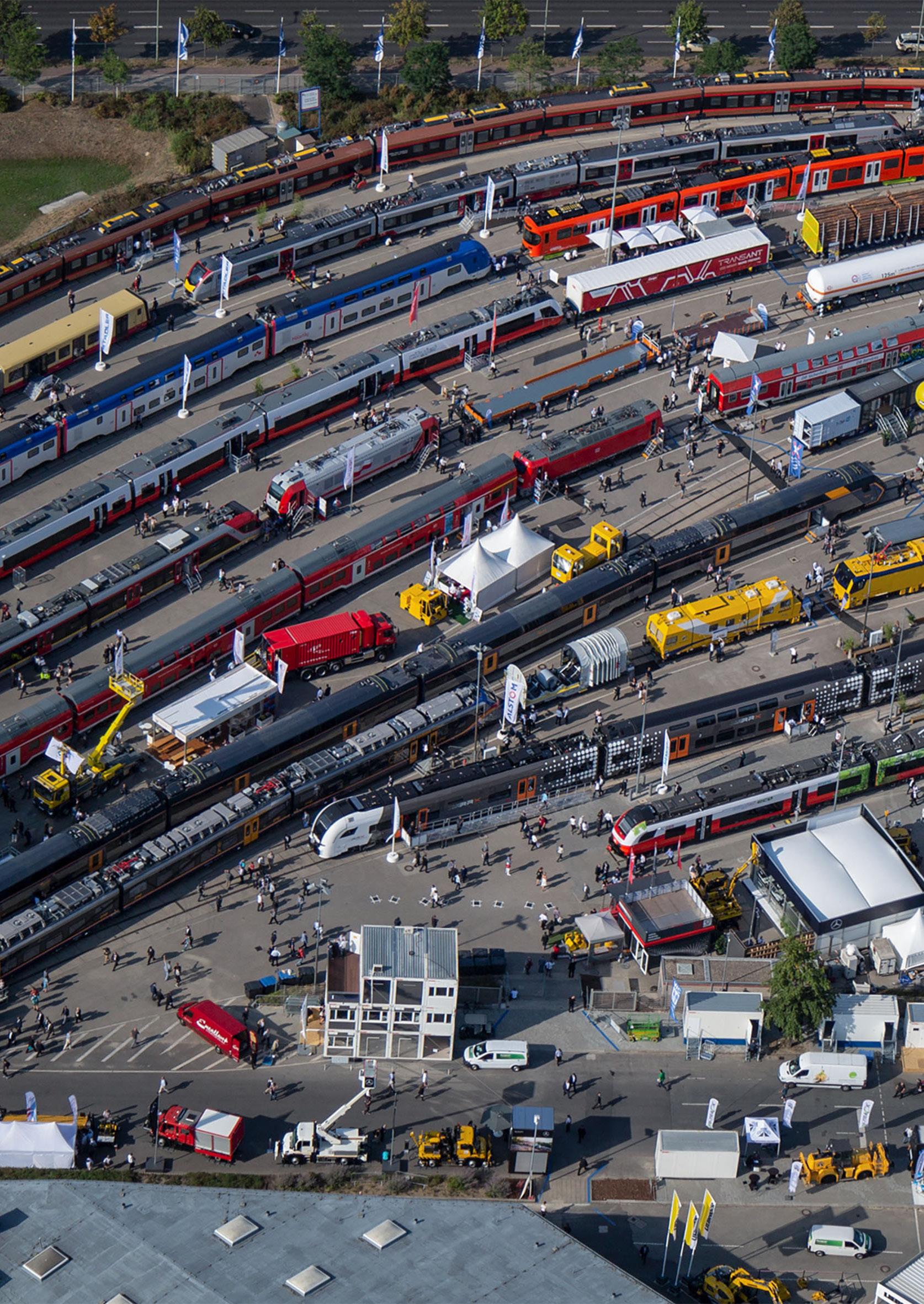
Flender GmbH
GGT GMEINDER GETRIEBETECHNIK GmbH
Texelis SASU
Wikov MGI a.s.
ZF Group
Hall 27
ASC GmbH
EAO AG
Frauscher Sensortechnik GmbH
Rail Vision
SENSIT s.r.o.
Sensonic
Siemens Mobility GmbH
Sqills Products B.V.
TSL-ESCHA GmbH
Výzkumný Ústav Železniční, a.s.
CityCube, Hall A
TÜV NORD Systems GmbH & Co. KG
CityCube, Hall B
Roediger Vacuum GmbH
WITT Solutions GmbH
Railway Infrastructure
Hall 21
Mosdorfer GmbH
Hall 22
Icomera
NILES-SIMMONS-HEGENSCHEIDT GmbH
SGS IR
SKF
Wavetrain AS
Hall 23
DSRailTech, a.s
Holmatro
MAE. Maschinen- u. Apparatebau Götzen GmbH
Hexagon | NEXTSENSE
Pandrol
Senceive
Hall 25
Goldschmidt Holding GmbH
GSF Rail Infra GmbH
Hird Rail Development Ltd
Trimble Europe B.V.
ZÖLLNER Signal GmbH
Hall 26
Harsco Rail Europe GmbH
Plasser & Theurer
ROBEL Group
Outdoor Display
Alstom
Dual Inventive B.V.
Goldschmidt Holding
Harsco Rail Europe
Plasser & Theurer
ROBEL Group
Siemens Mobility GmbH
Škoda Group

|
|
|
| O2/60 | O2/65 | T2/60 | T3/55 O/610 | O660 | T6/40 | T6/45 | T6/50 T4/29
InnoTrans Facts
When: Tuesday, 24 - Friday, 27 September 2024
Where: Messe, Berlin
The Exhibitors: With 2,771 exhibitors from 56 countries in 2022 InnoTrans is the industry’s leading international trade fair, occupying all of the Berlin exhibition grounds.
The Visitors: 137,403 visitors from 137 countries filled the 42 exhibition halls, the Outdoor Display and track area as well as the Bus Display at InnoTrans 2022.
Click here to book your ticket!
Overleaf: The official hall plan for InnoTrans 2024
Exhibition Grounds (Preliminary hall layout)
Geländeplan (Vorläufige Hallenplanung)
InnoTrans 2024
24 – 27 September · Berlin

Einganghub27 hub27Entrance









Railway Technology















lnteriors incl. Travel Catering & Comfort Services
Railway lnfrastructure
Tunnel Construction
Public Transport incl
Mobility+
AI Mobility Lab
Outdoor Display
Gleis- und Freigelände
Bus Display
InnoTrans Campus
Opening Ceremony Eröffnungsveranstaltung
lnnoTrans Convention
Speakers' Corner
Business Lounge (Marshall-Haus)
Press Center Pressezentrum
Restaurant Oktoberfest FoodCourt
Messe Berlin GmbH Messedamm 22 14 055 Berlin Germany
T + 4 9 30 3038 3131
www.innotrans.de innotrans@messe-berlin.de
Shuttlelinien
Expo Nord Expo Süd
Geländeshuttle
Eingang Süd – Halle 18
Eingang Süd – Halle 20
Eingang Süd – Eingang Ost
Eingang Ost – Gleis- und Freigelände
Jelbi hub shared mobility
Pickup & Drop-off for rental two-wheeled vehicles
Mobilitätsflächen für Miet-Zweiräder

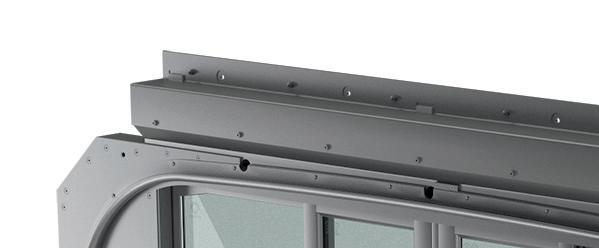


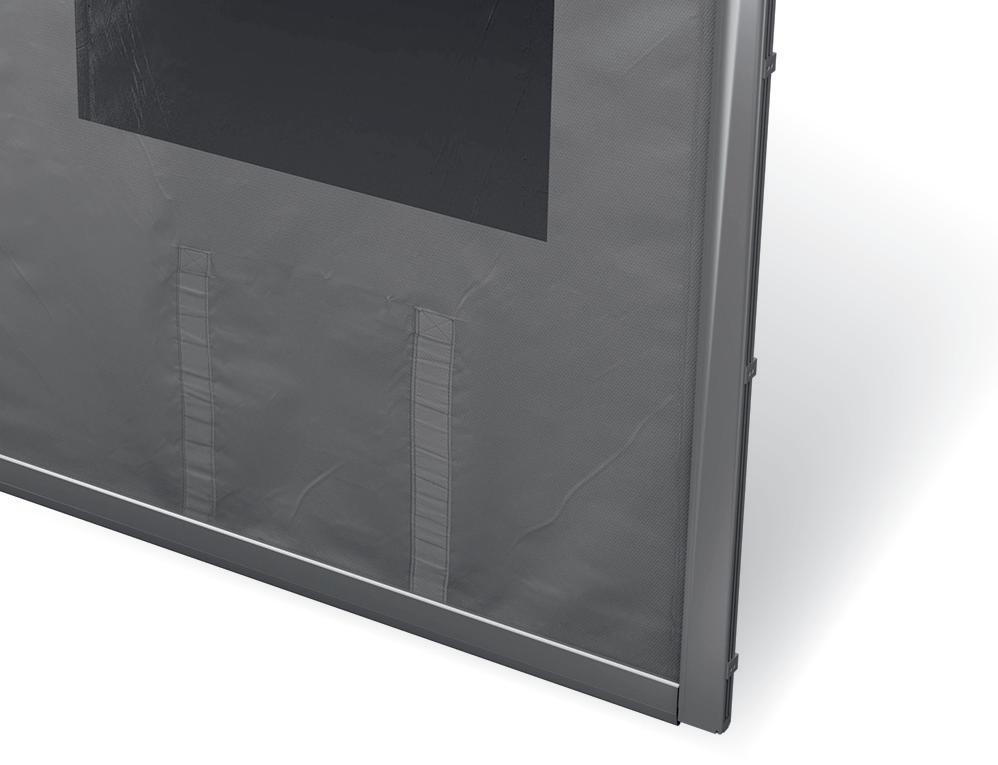


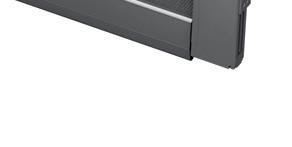


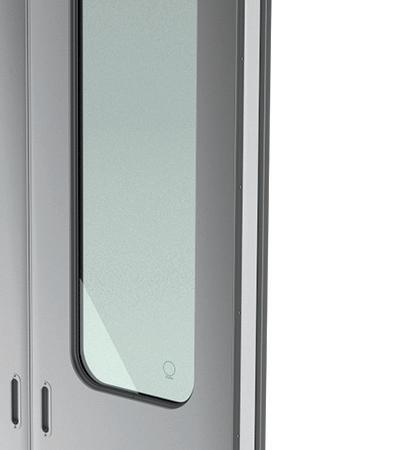


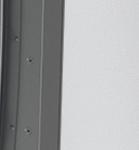


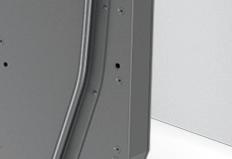








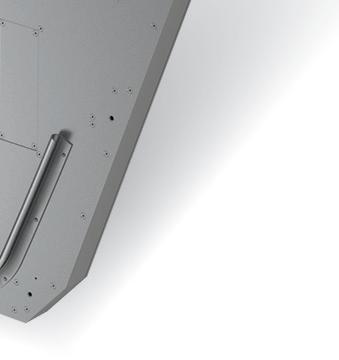

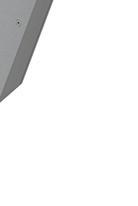

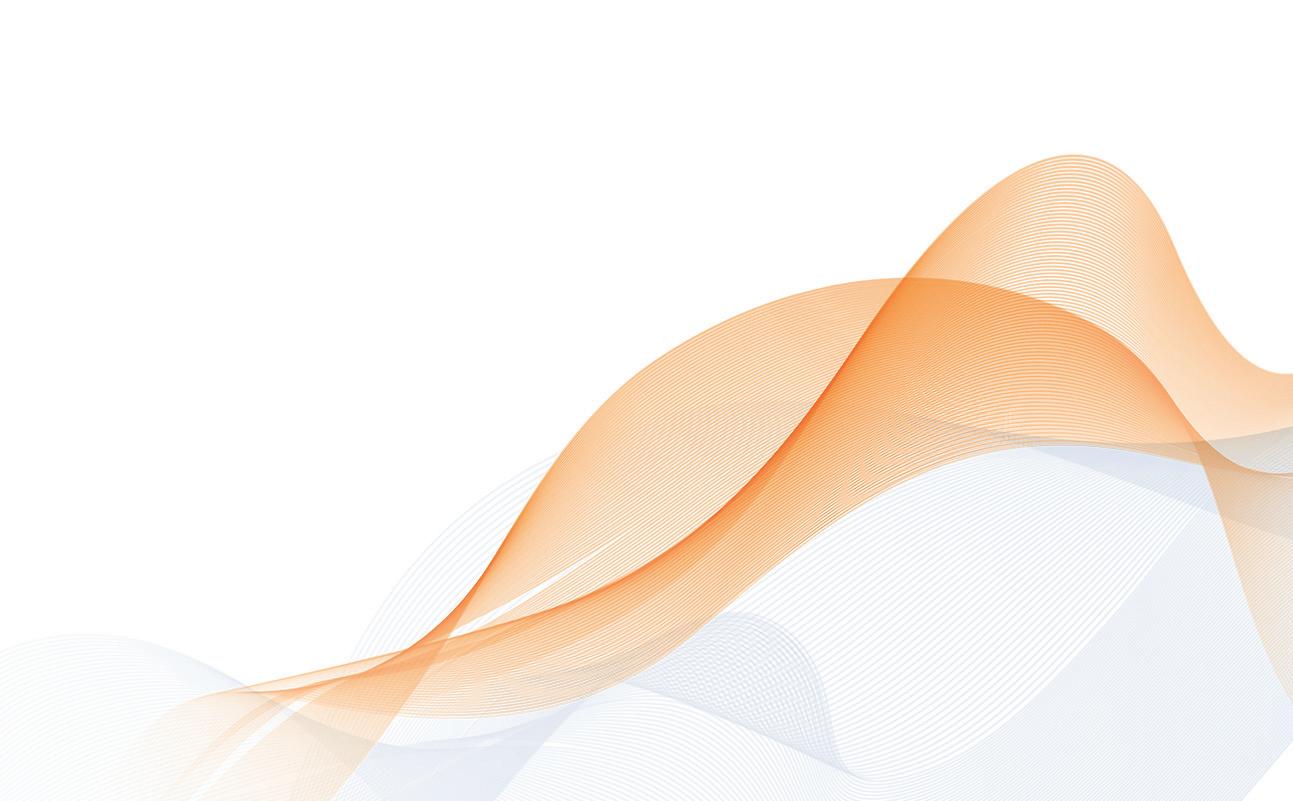





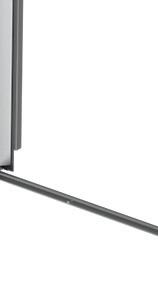

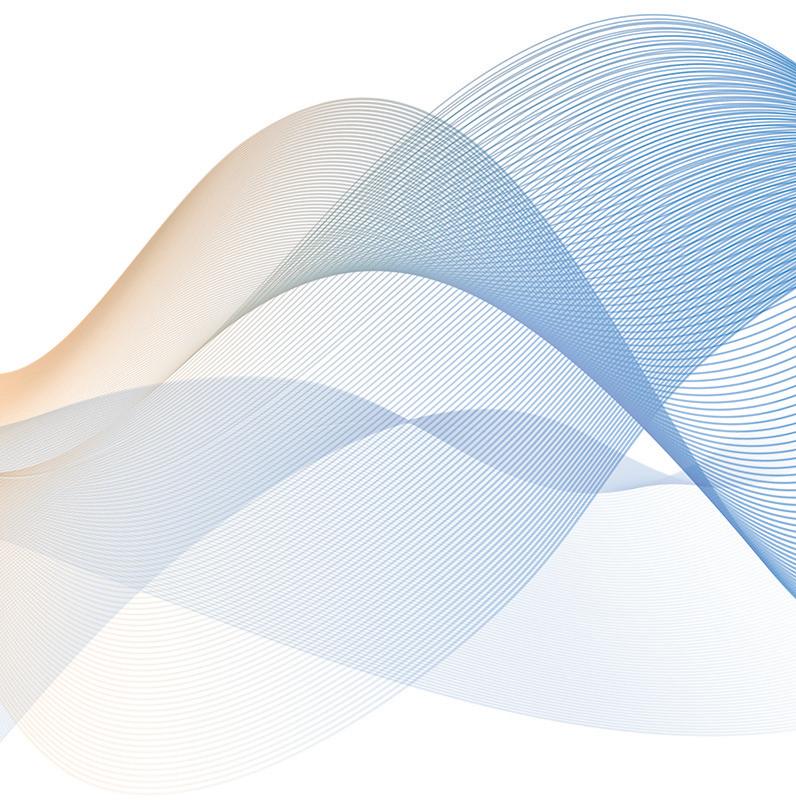
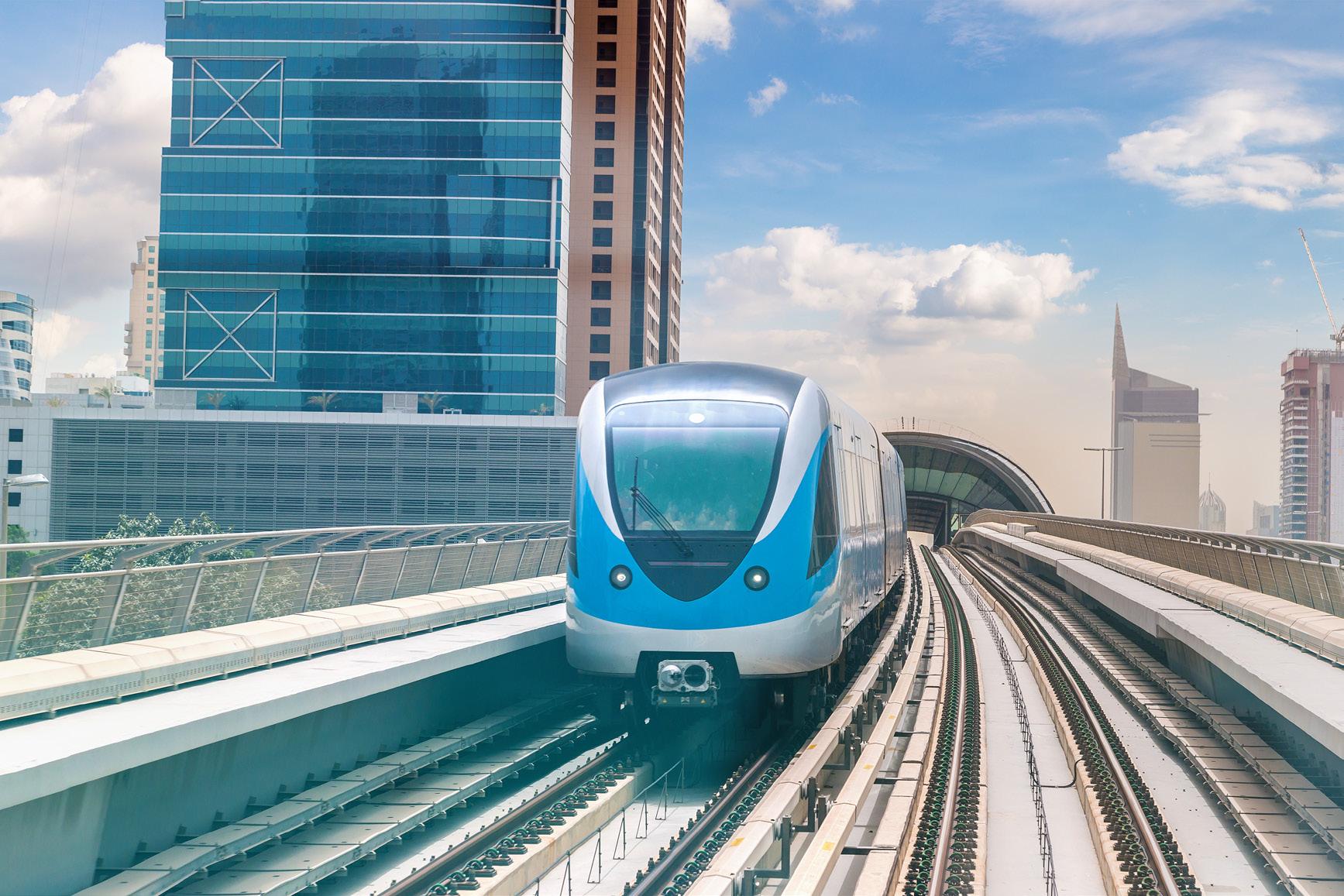

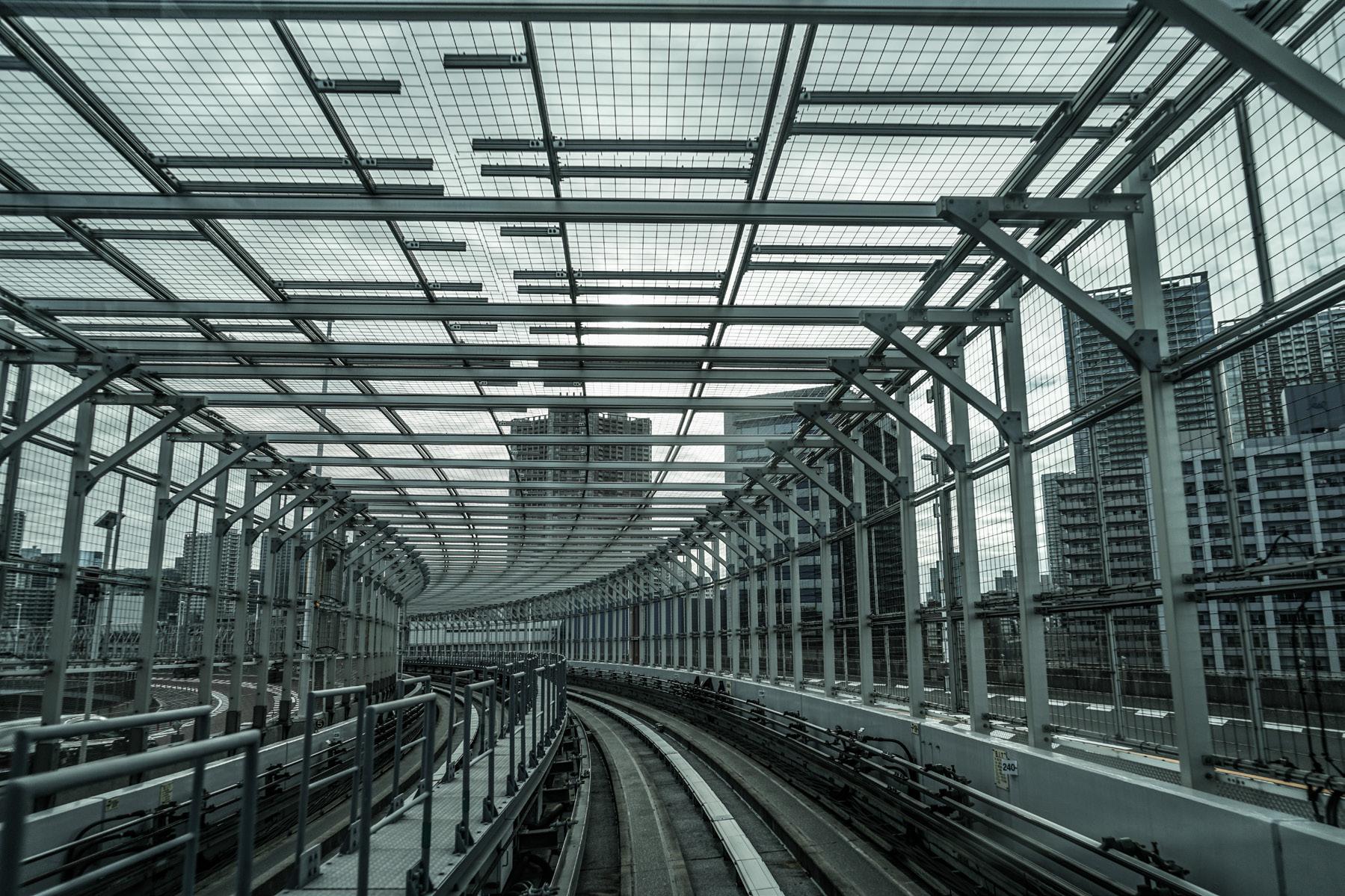





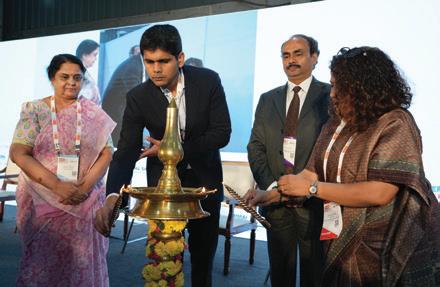
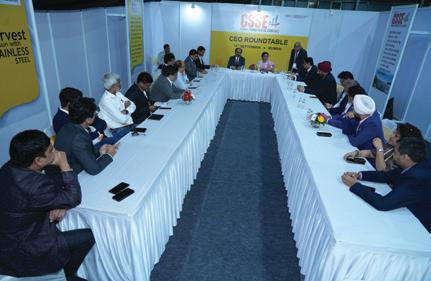
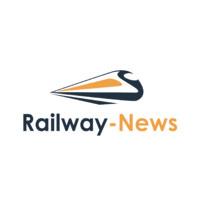
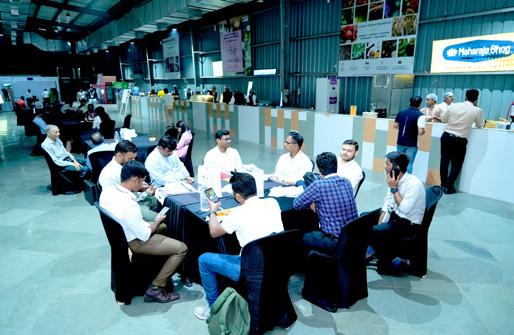
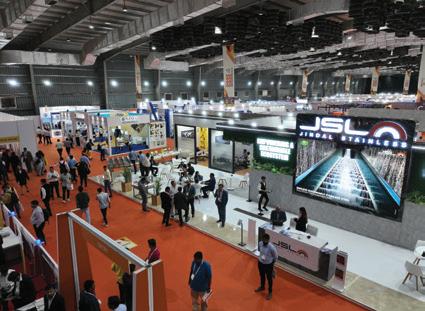

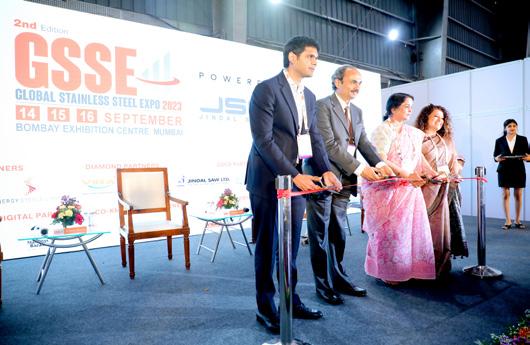
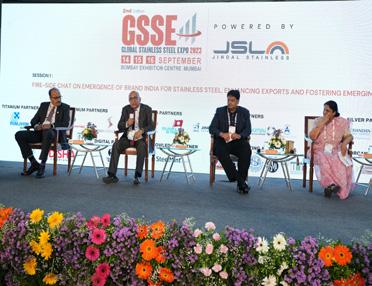
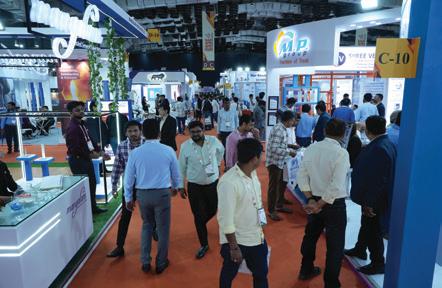






Thank you for reading Issue Three 2024 of the Railway-News magazine. Visit our website to keep up to date with the rail sector.